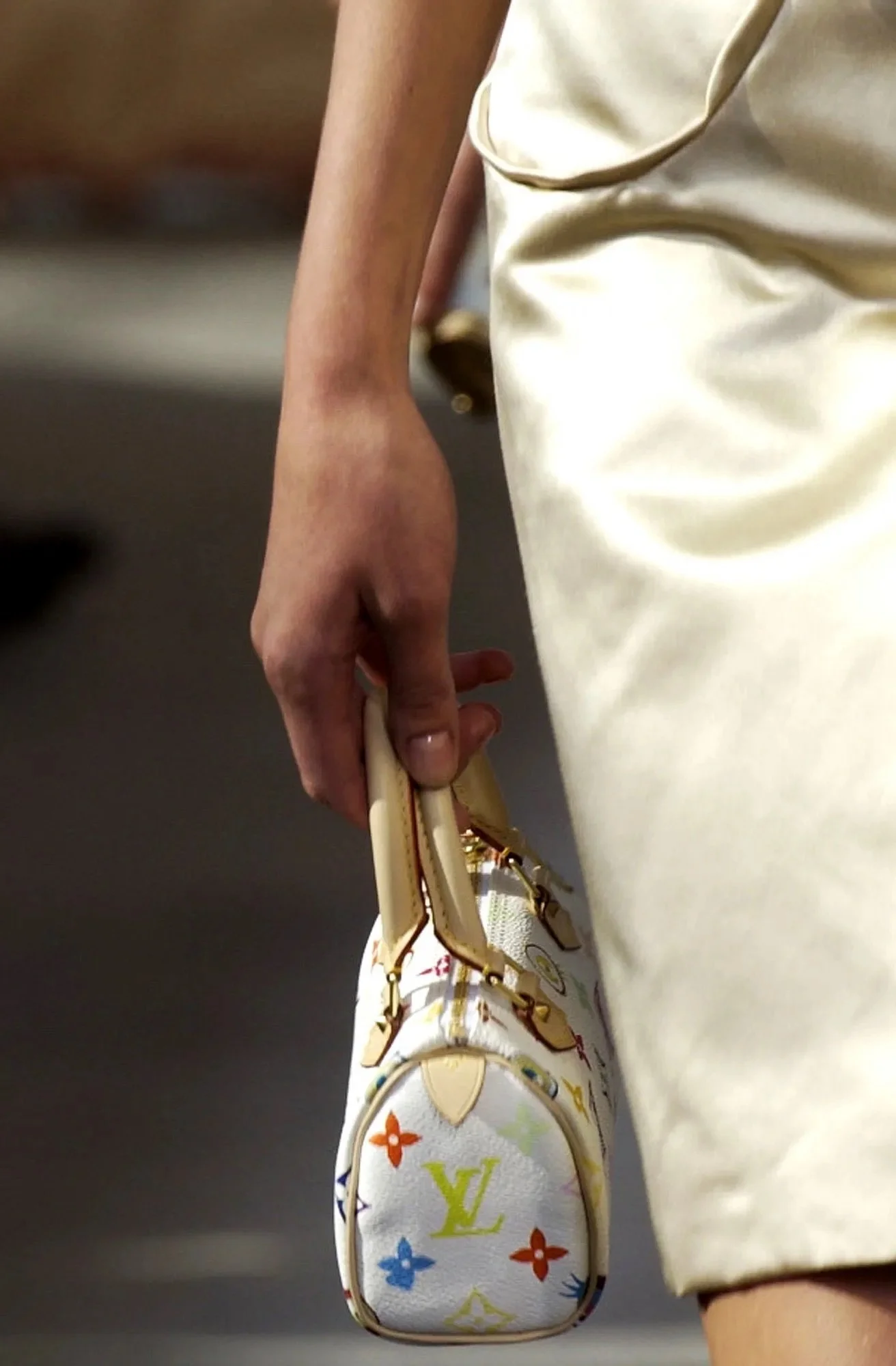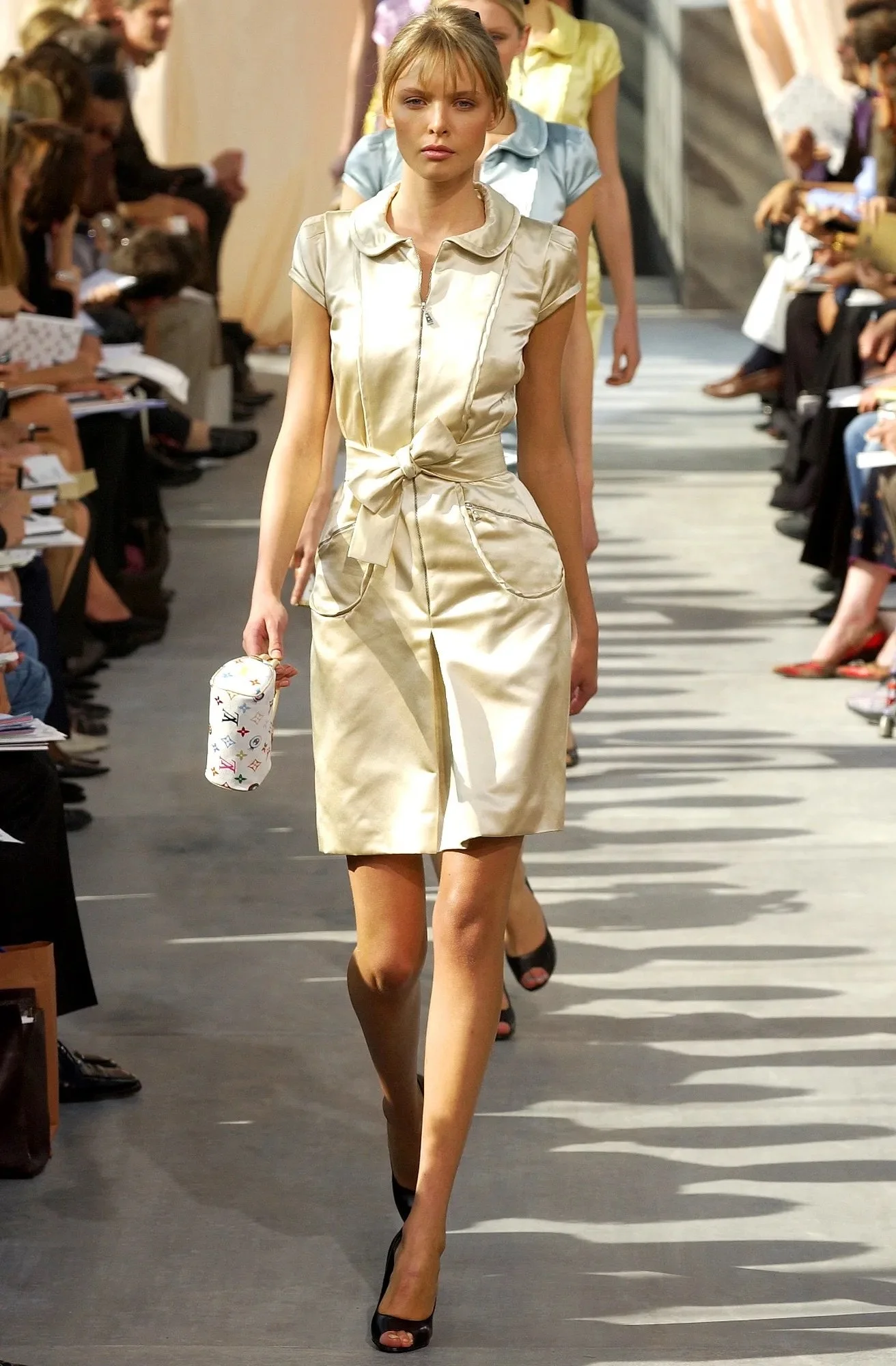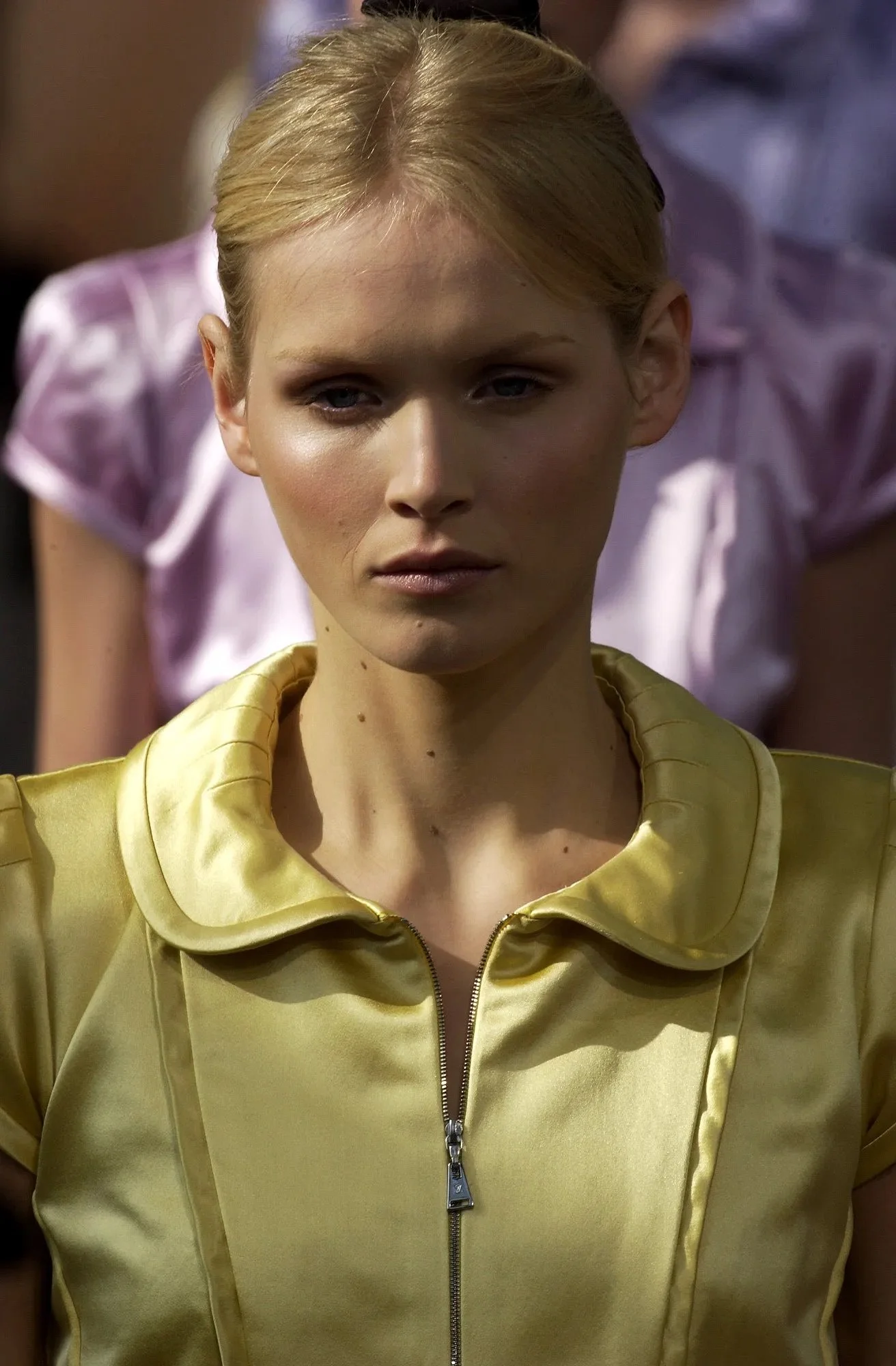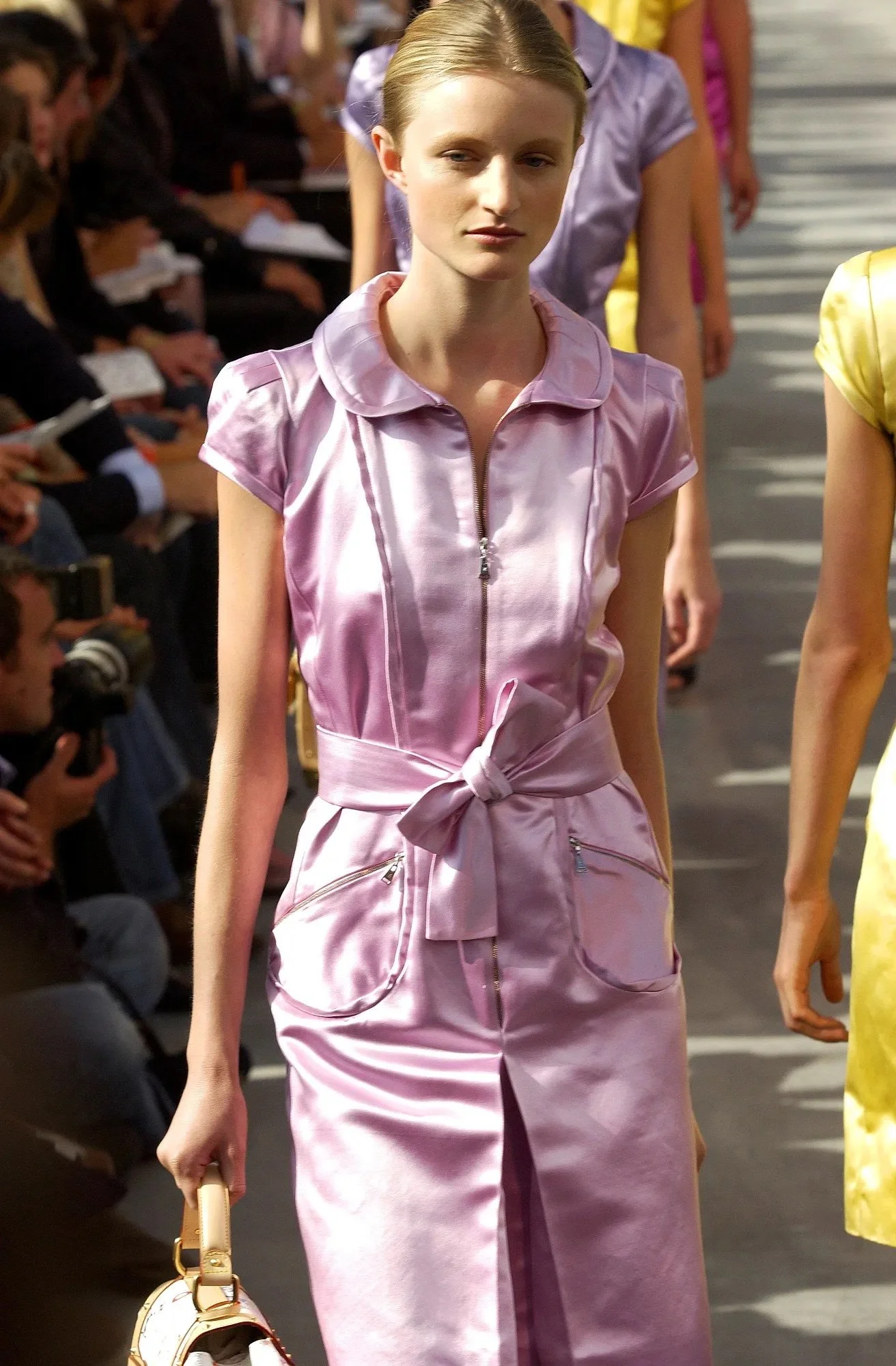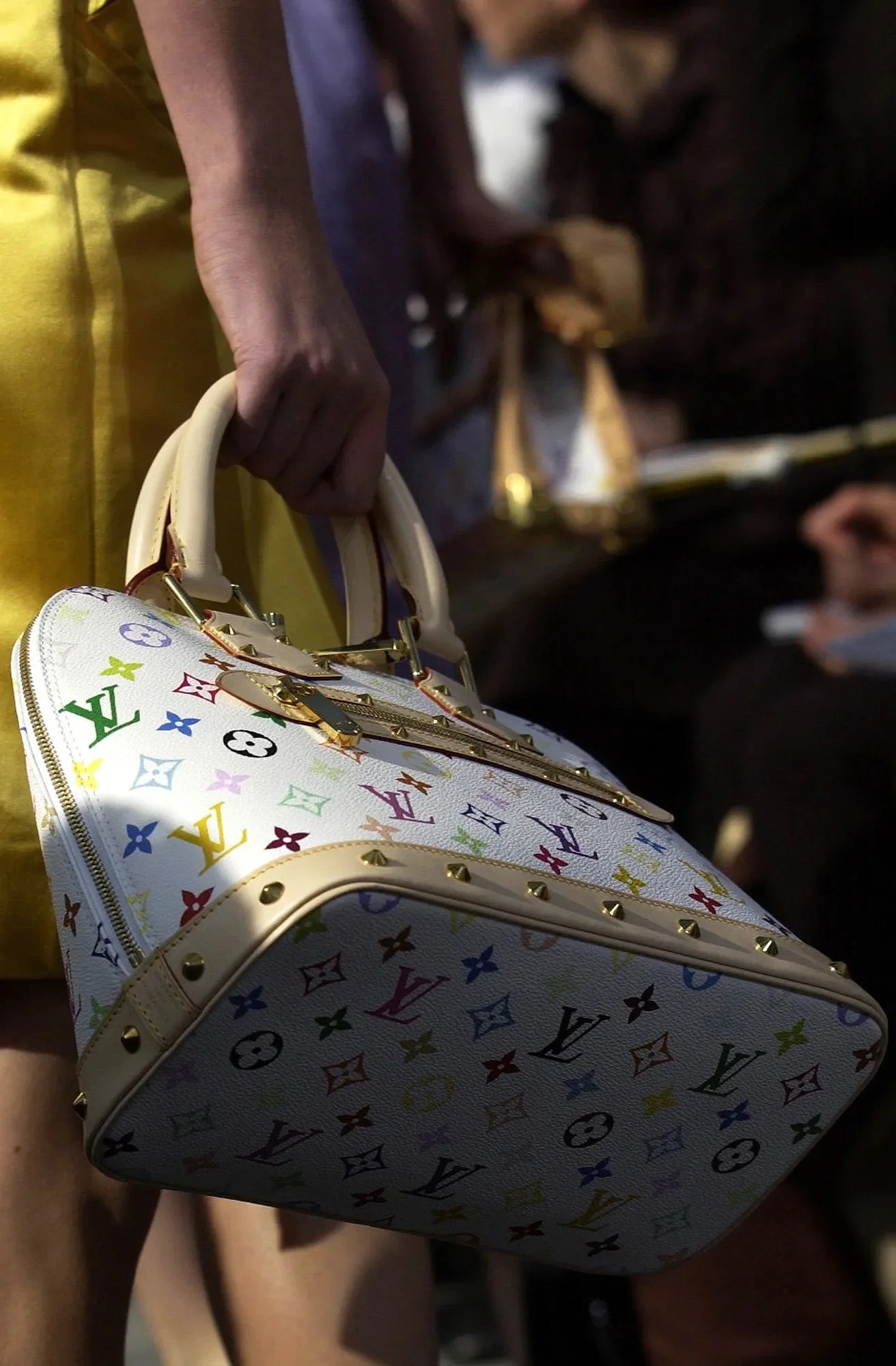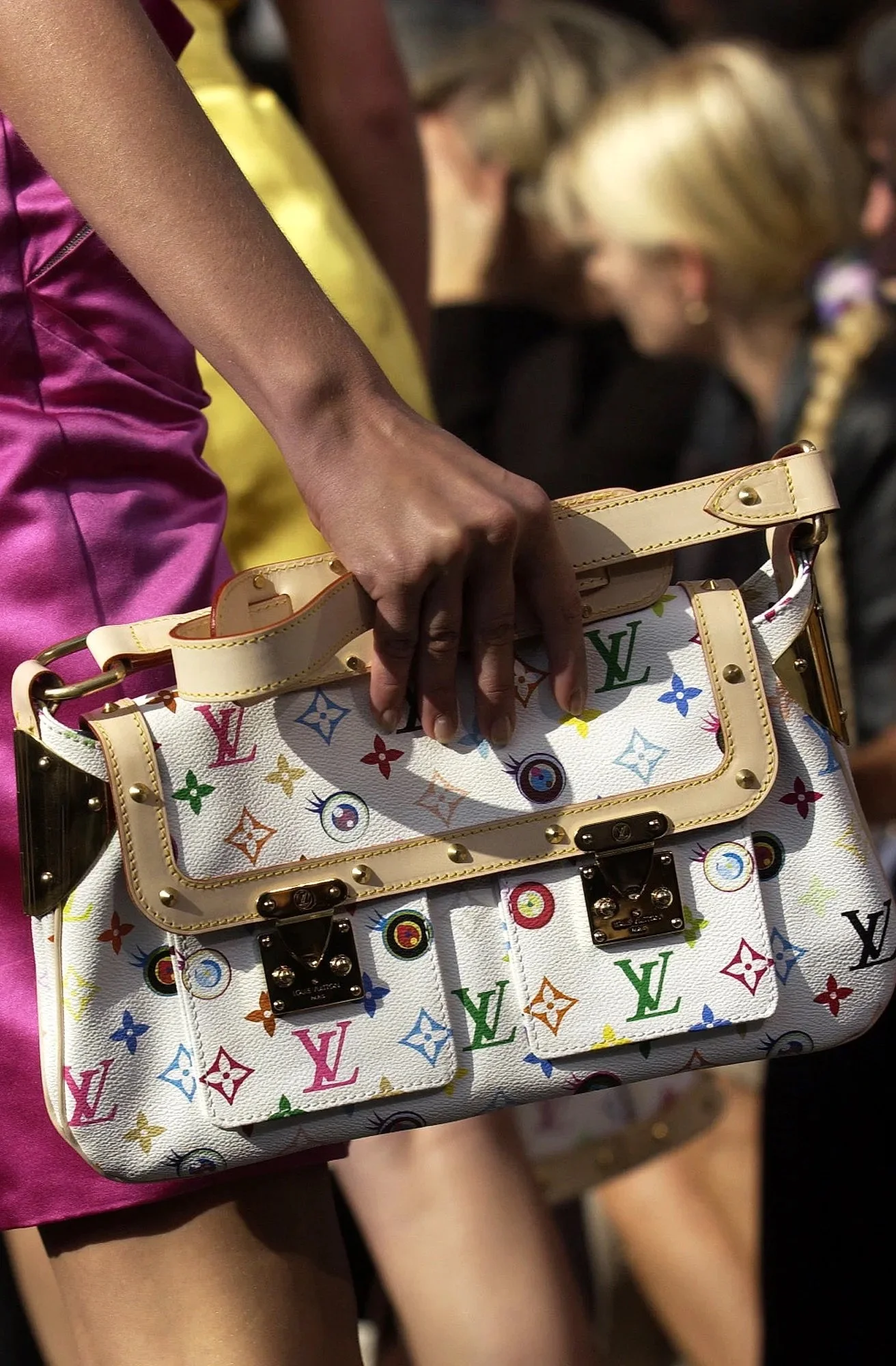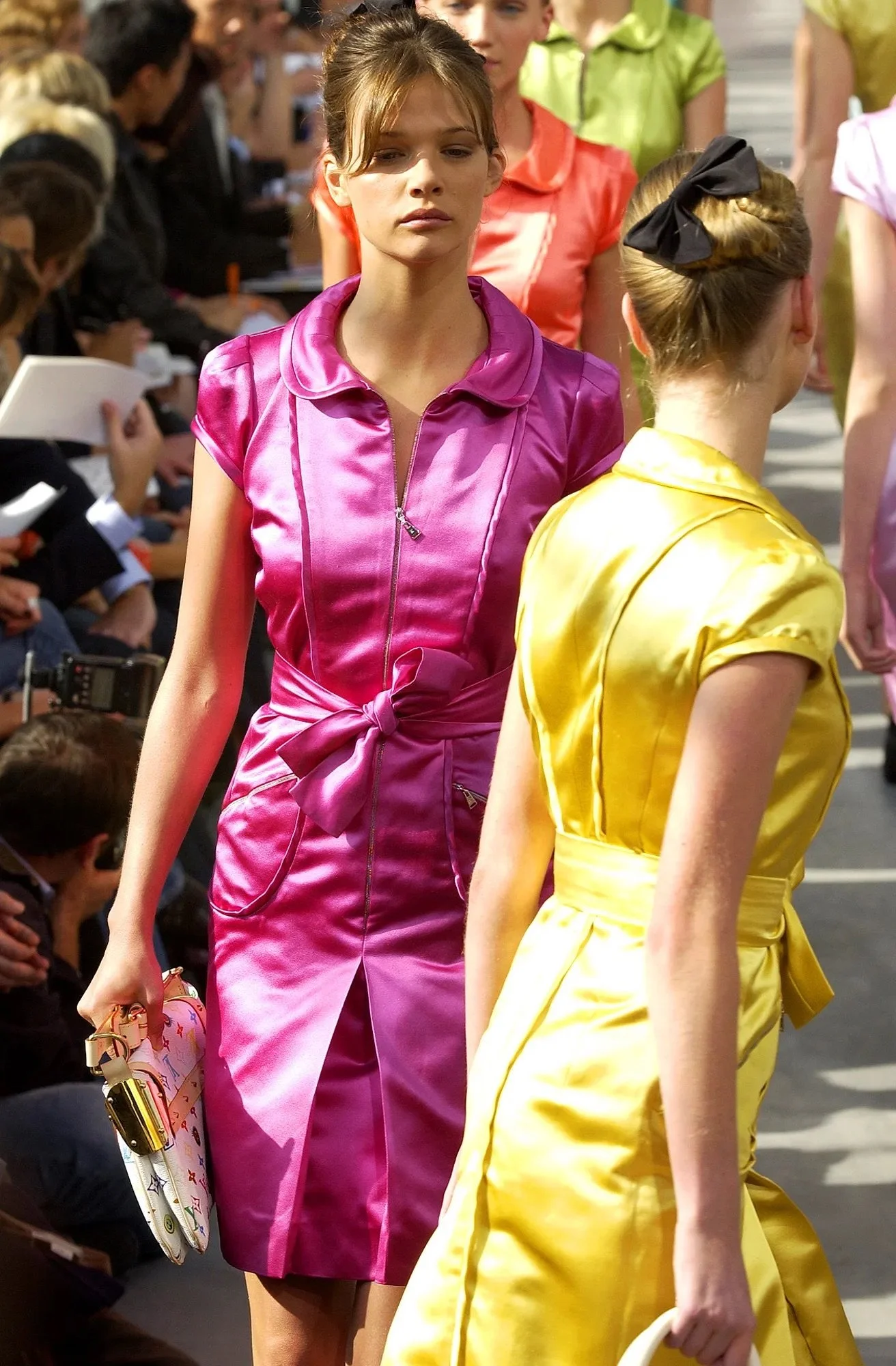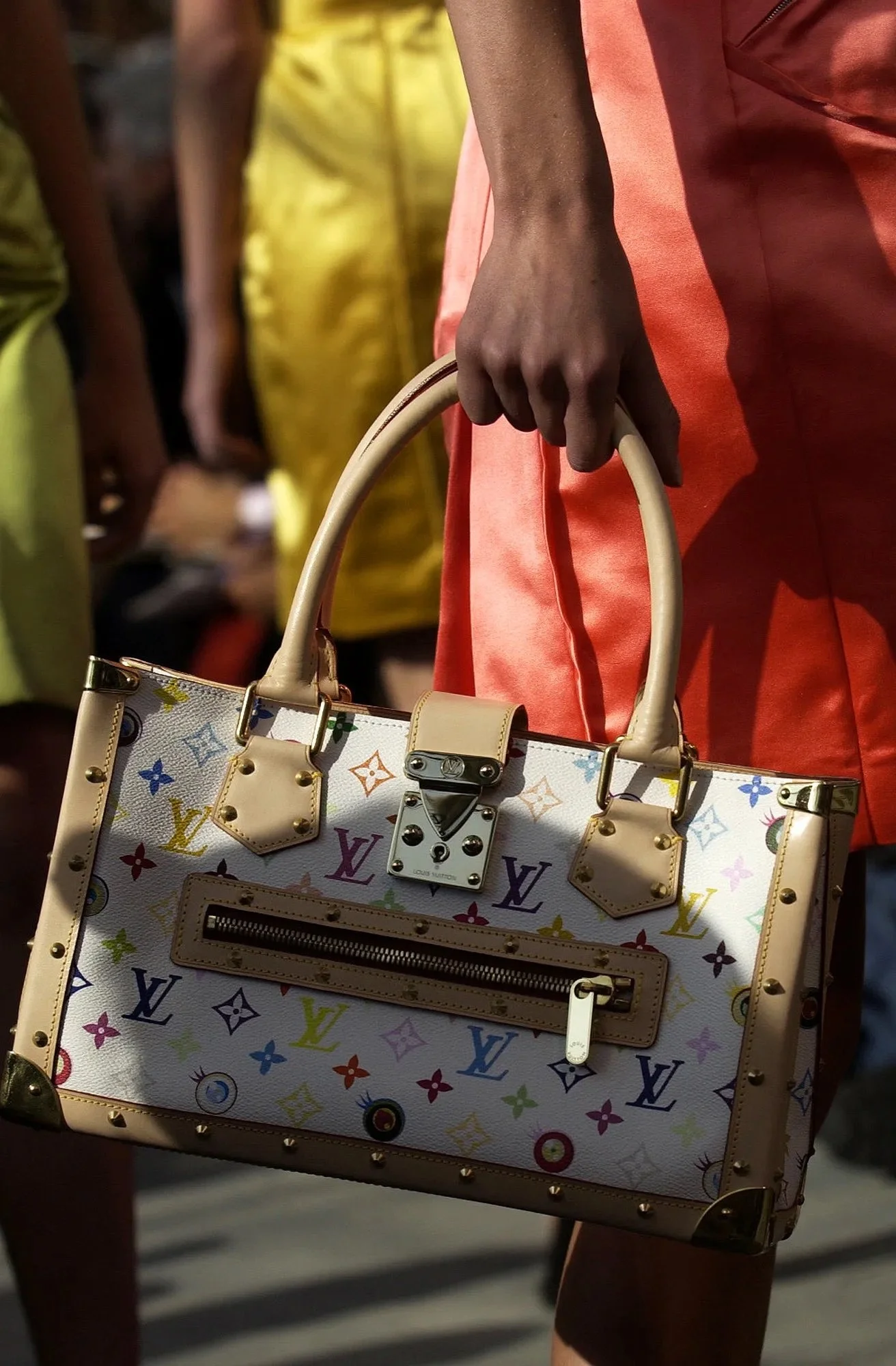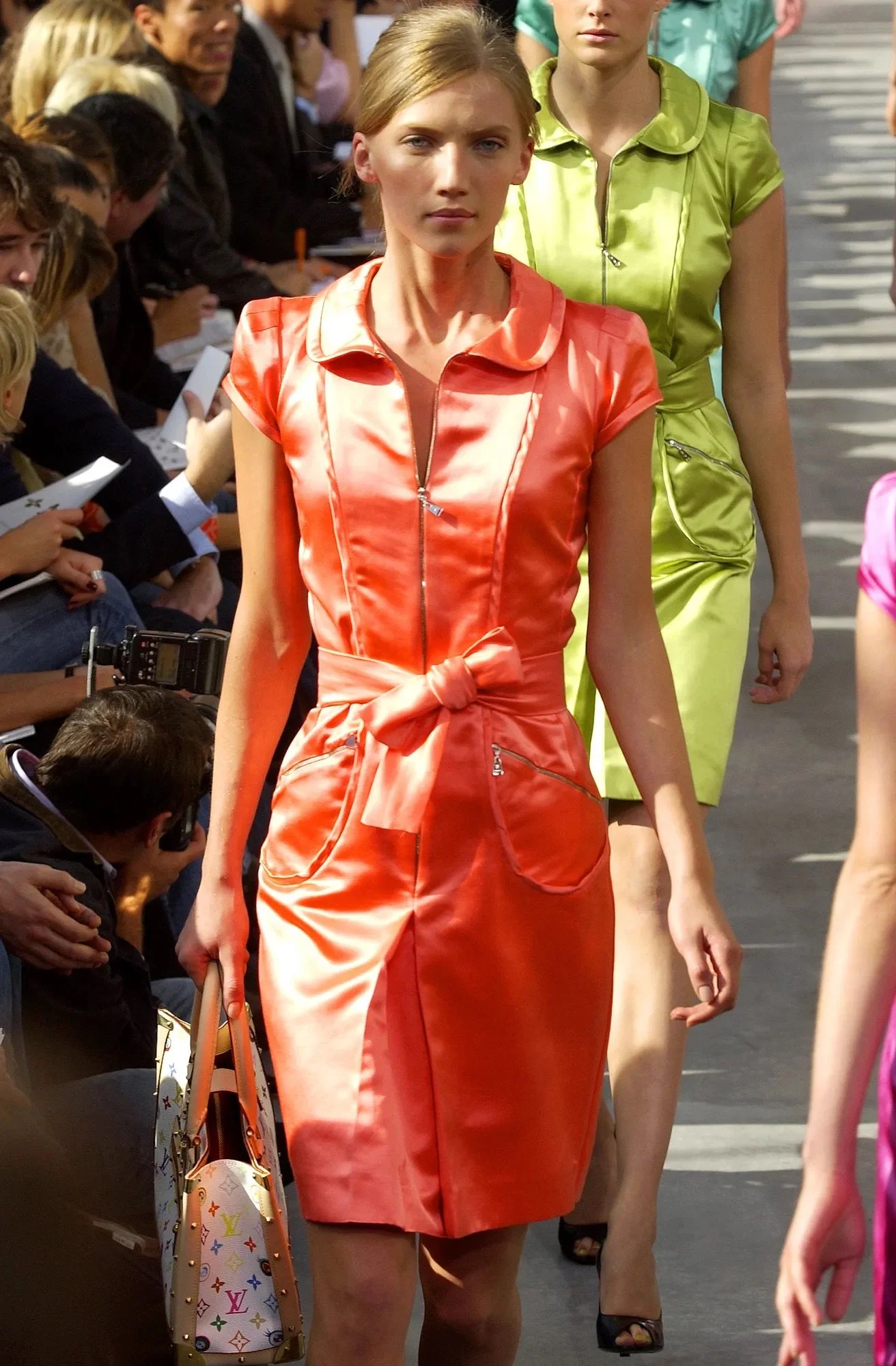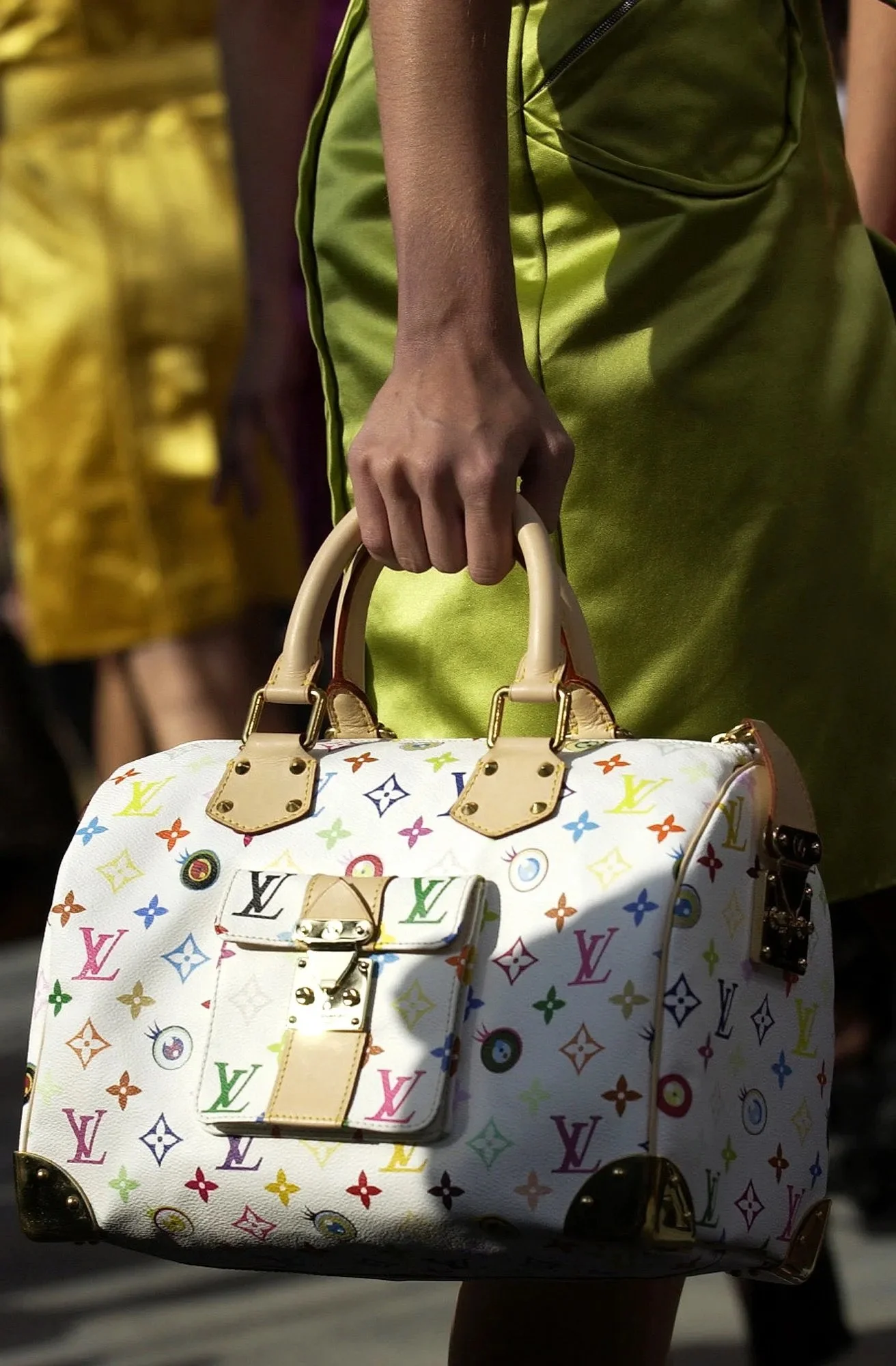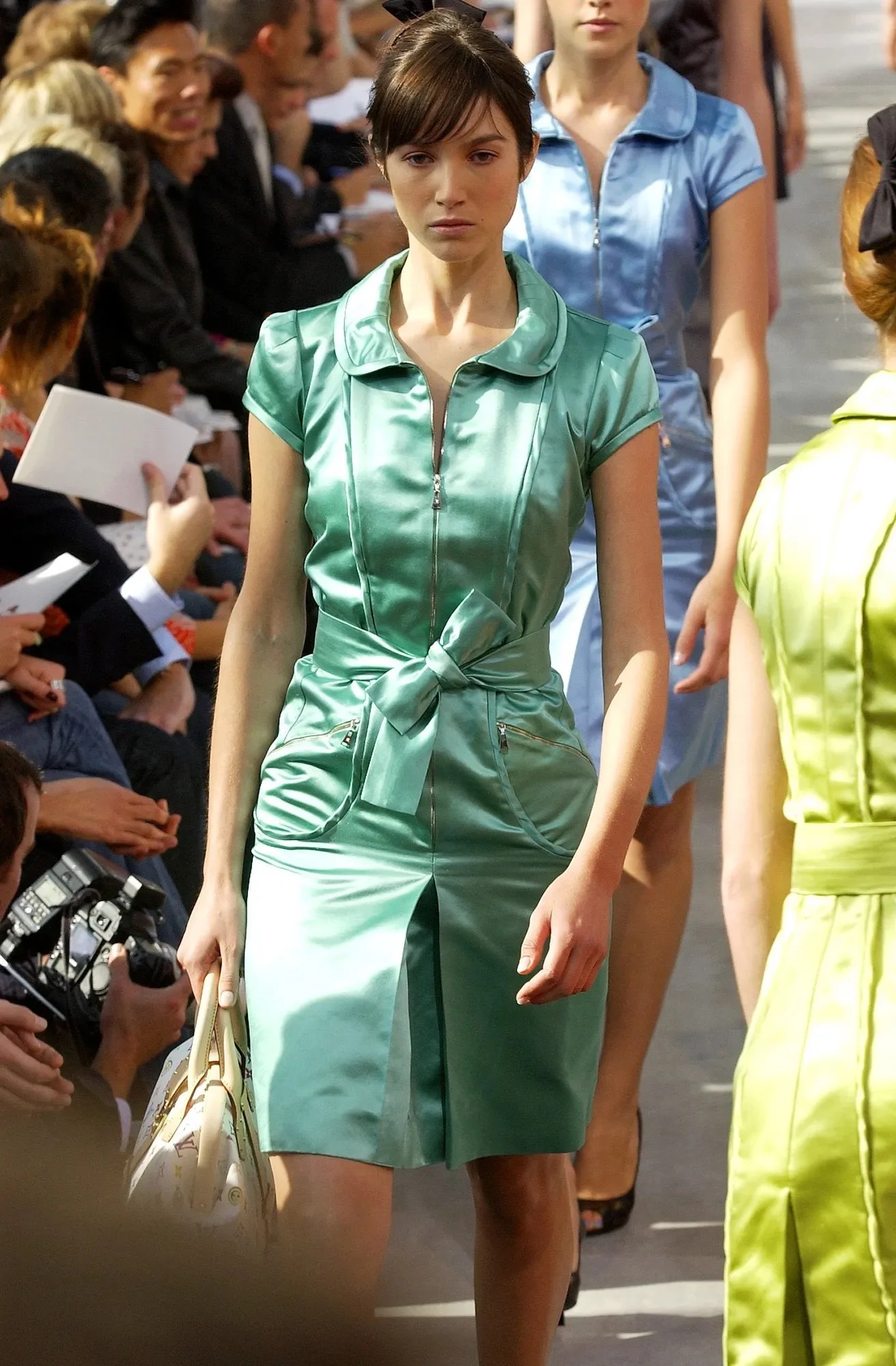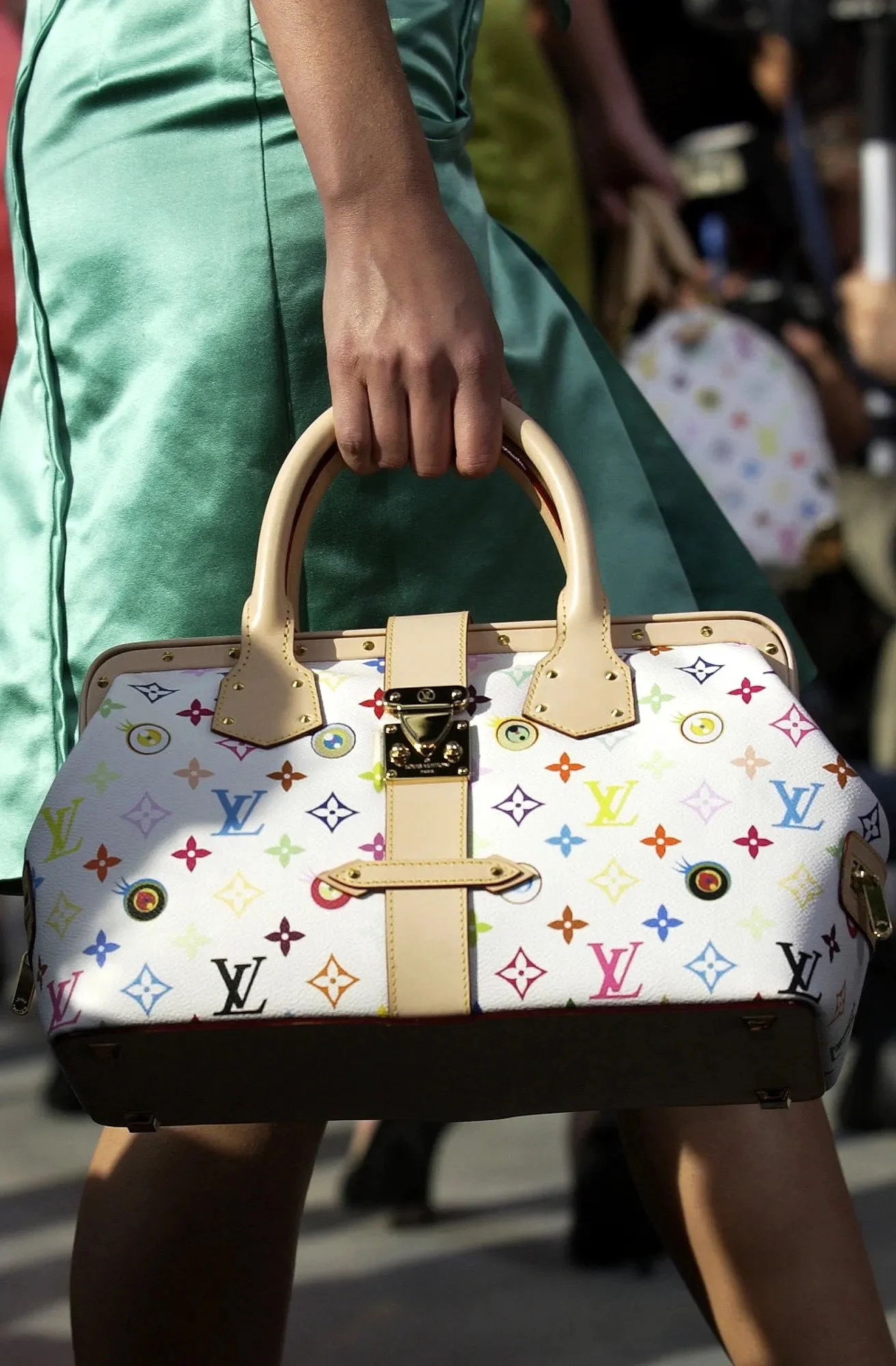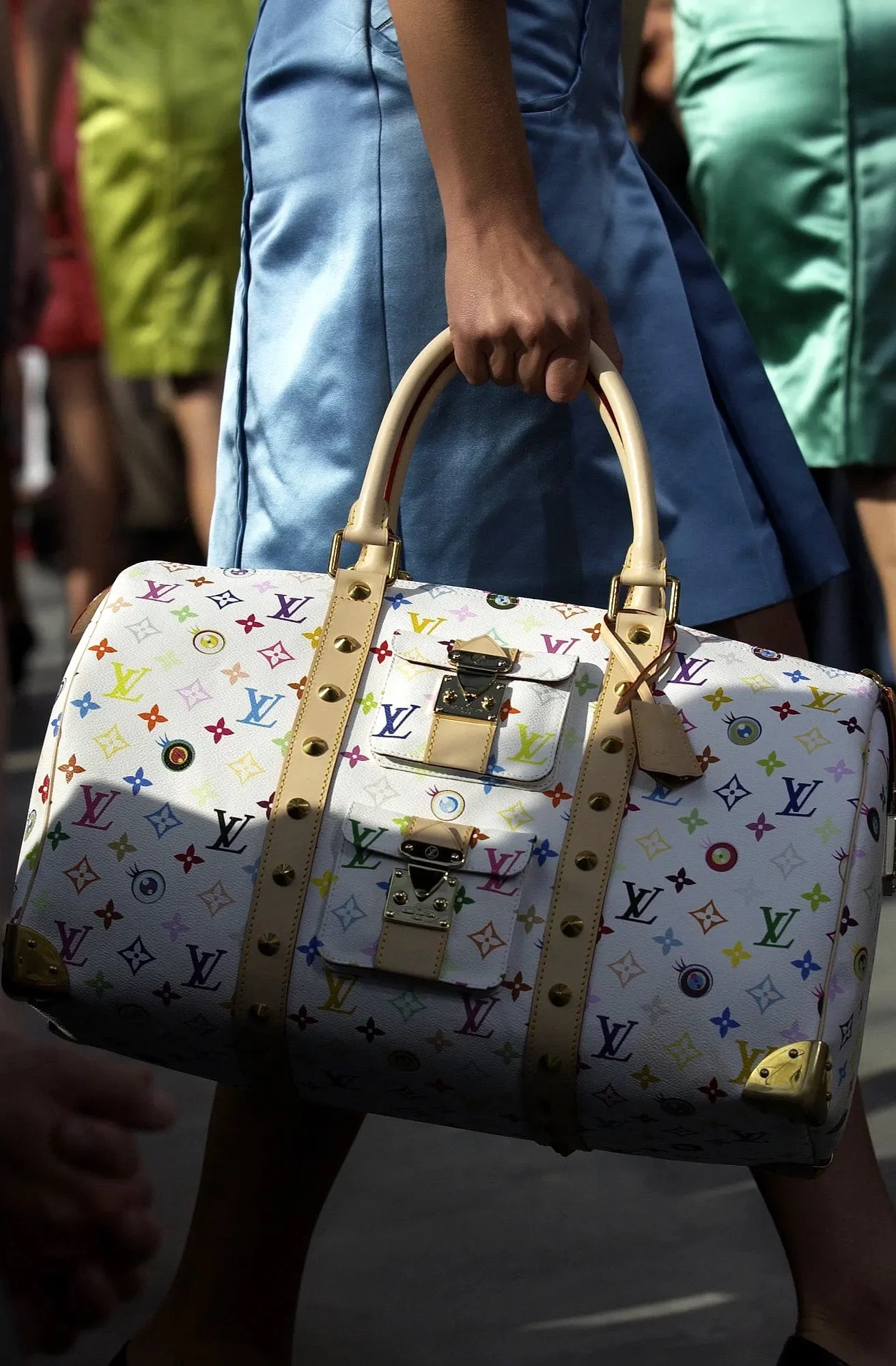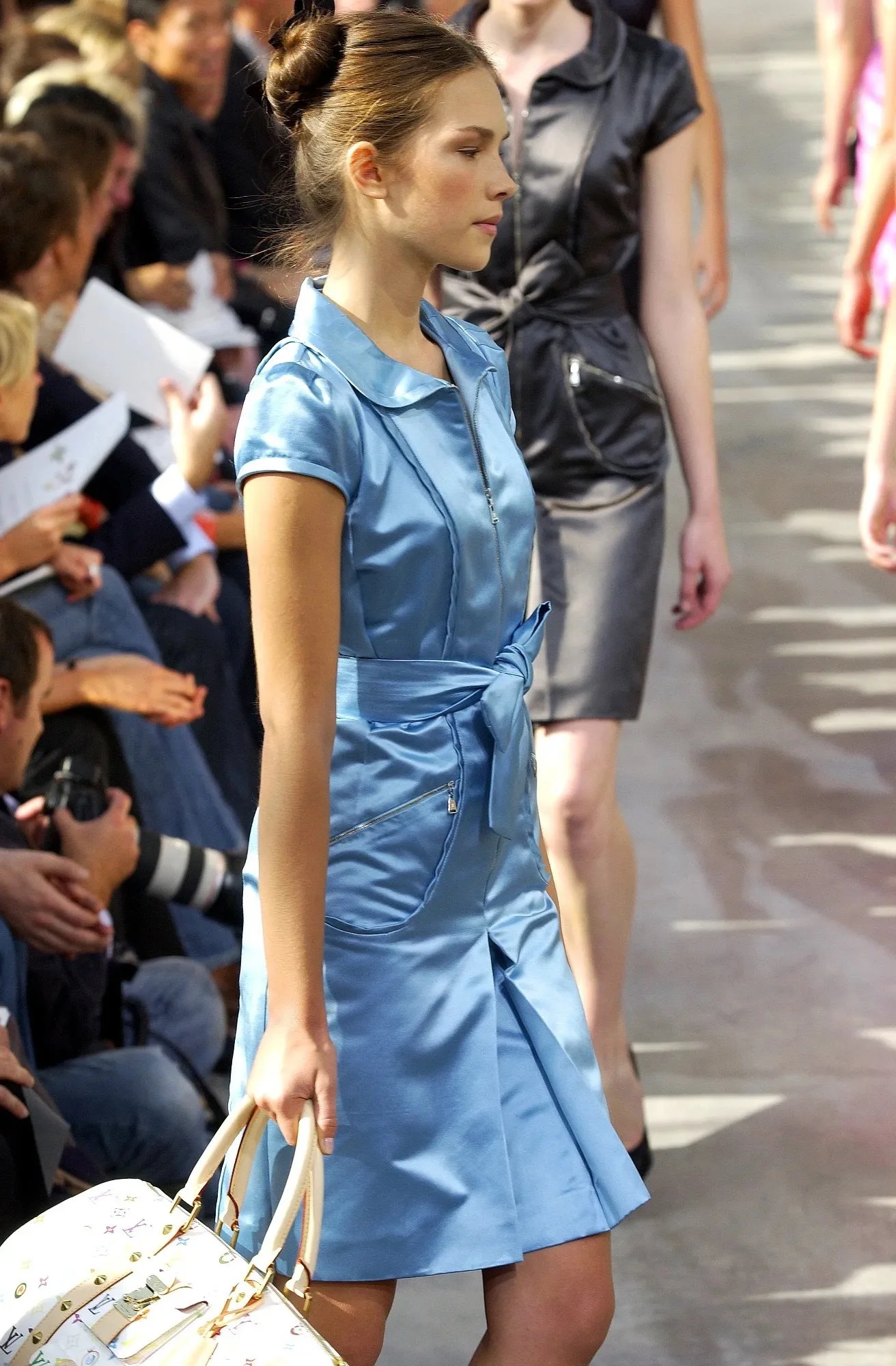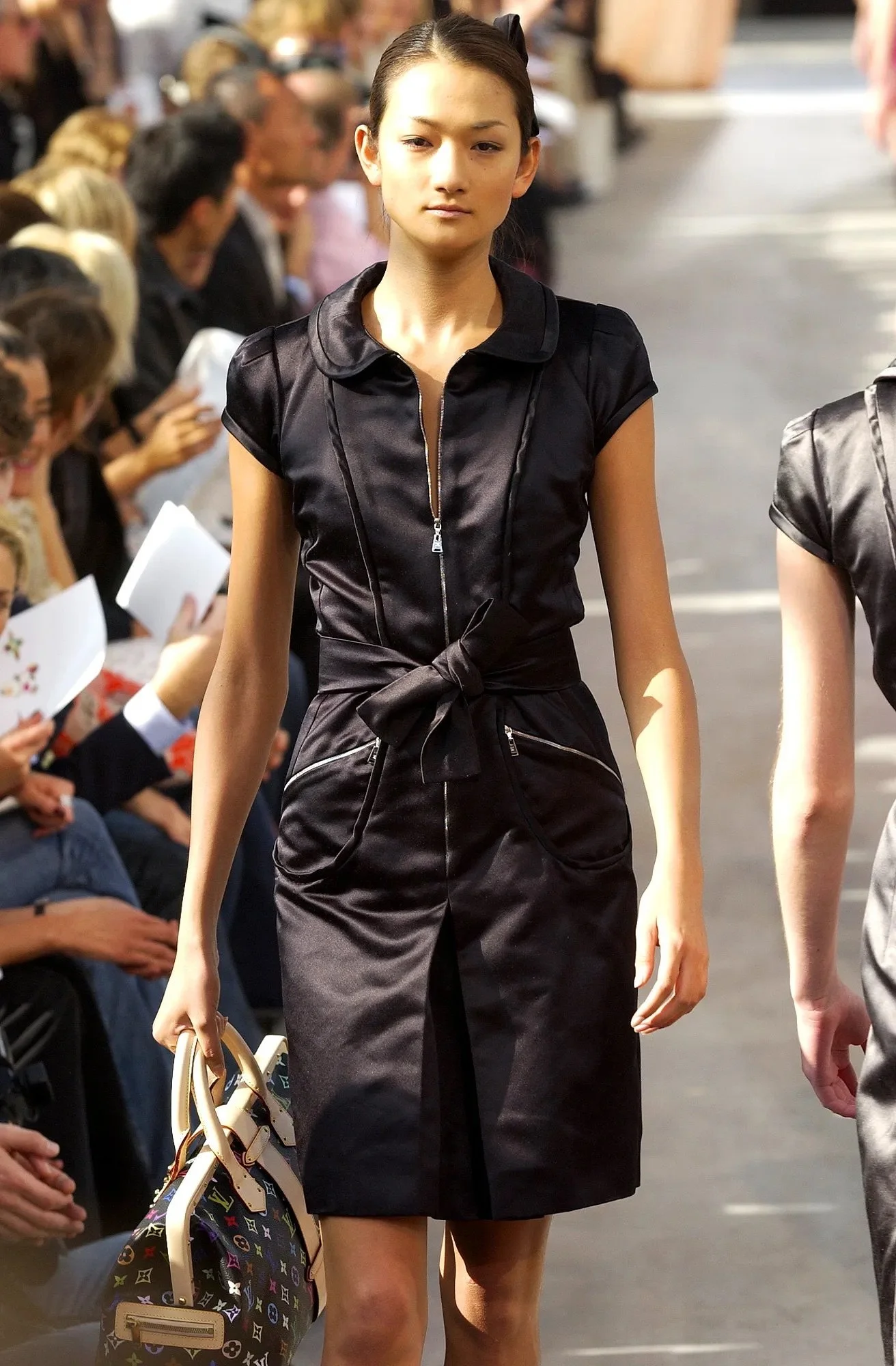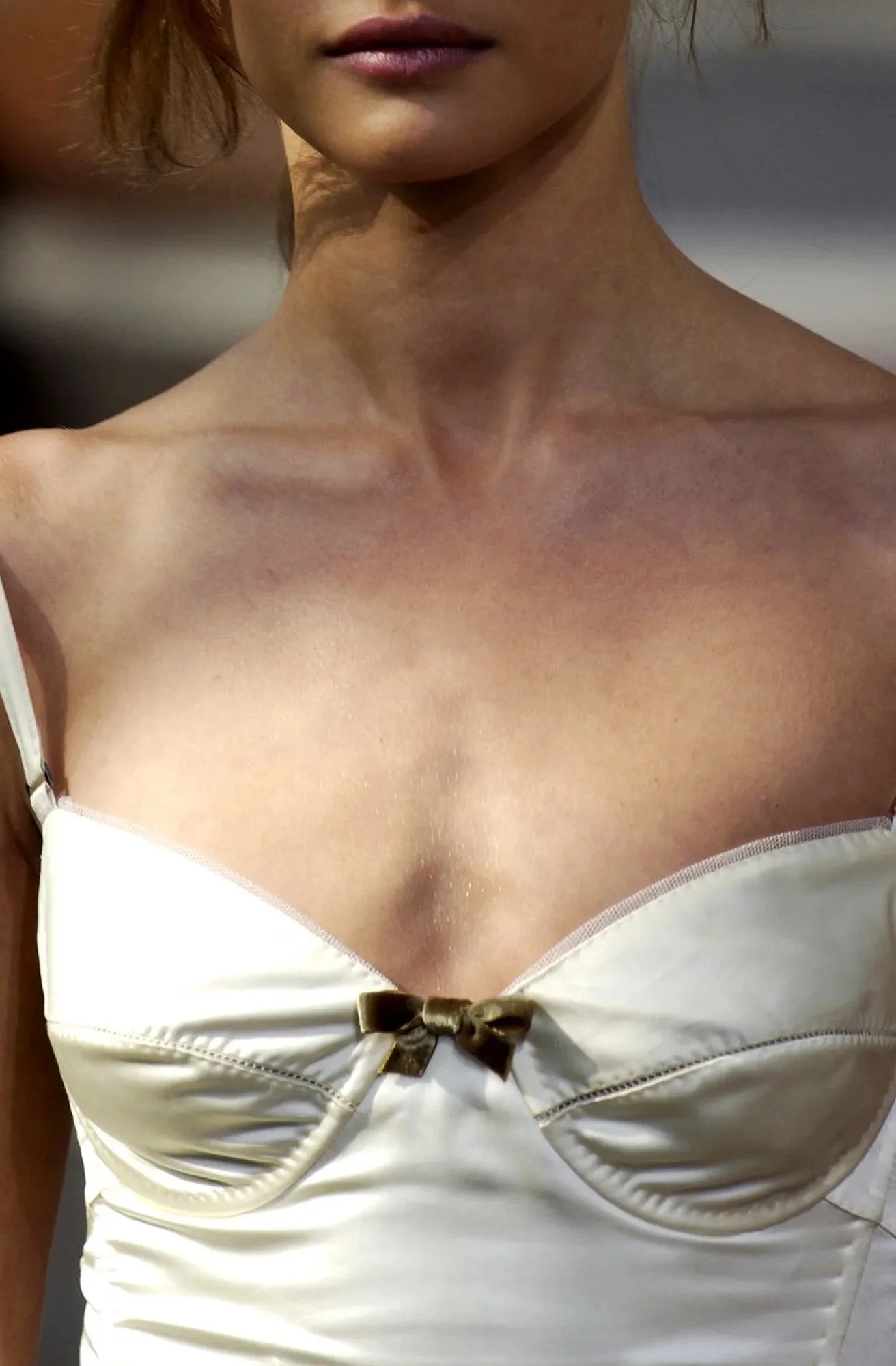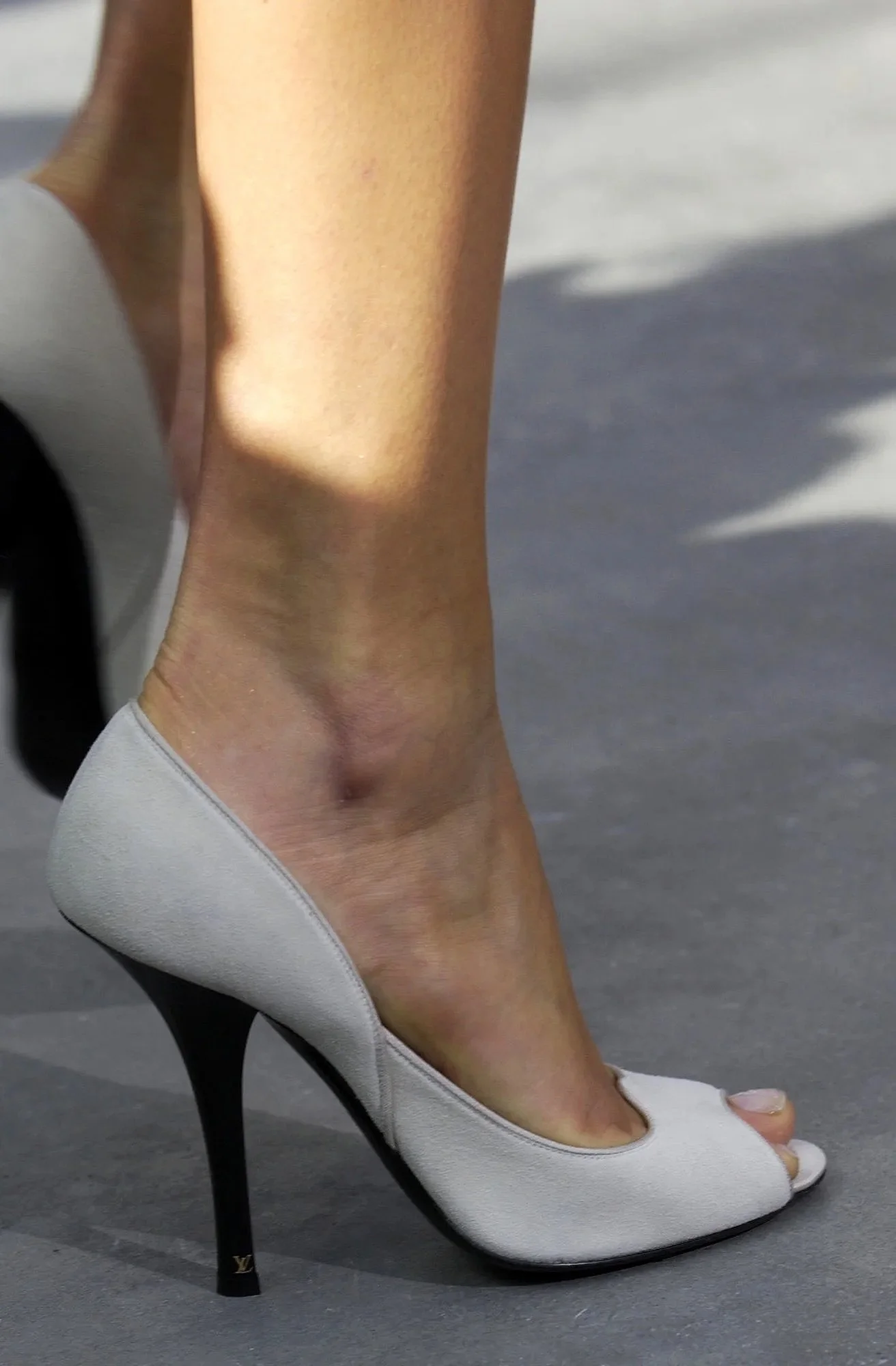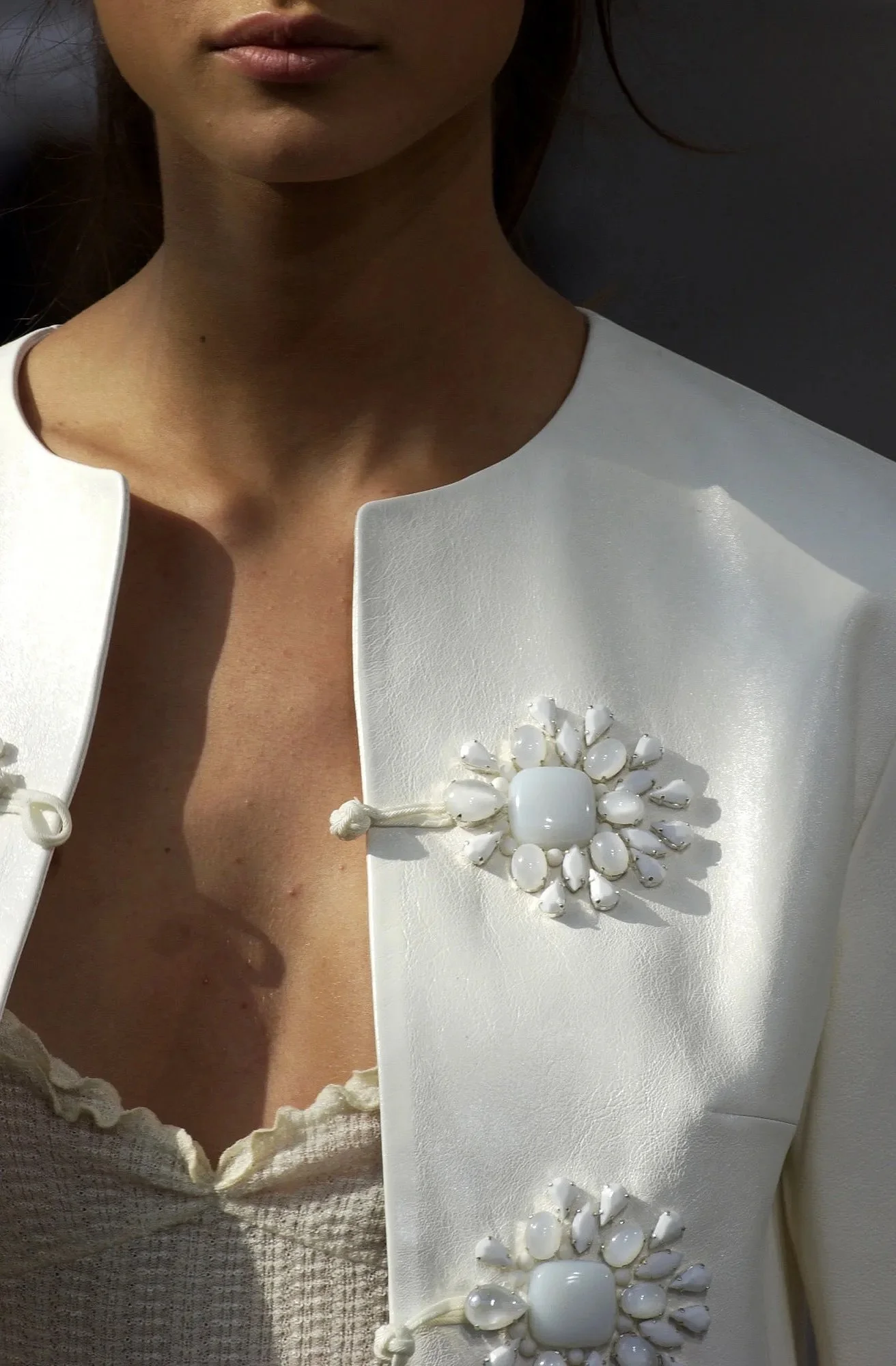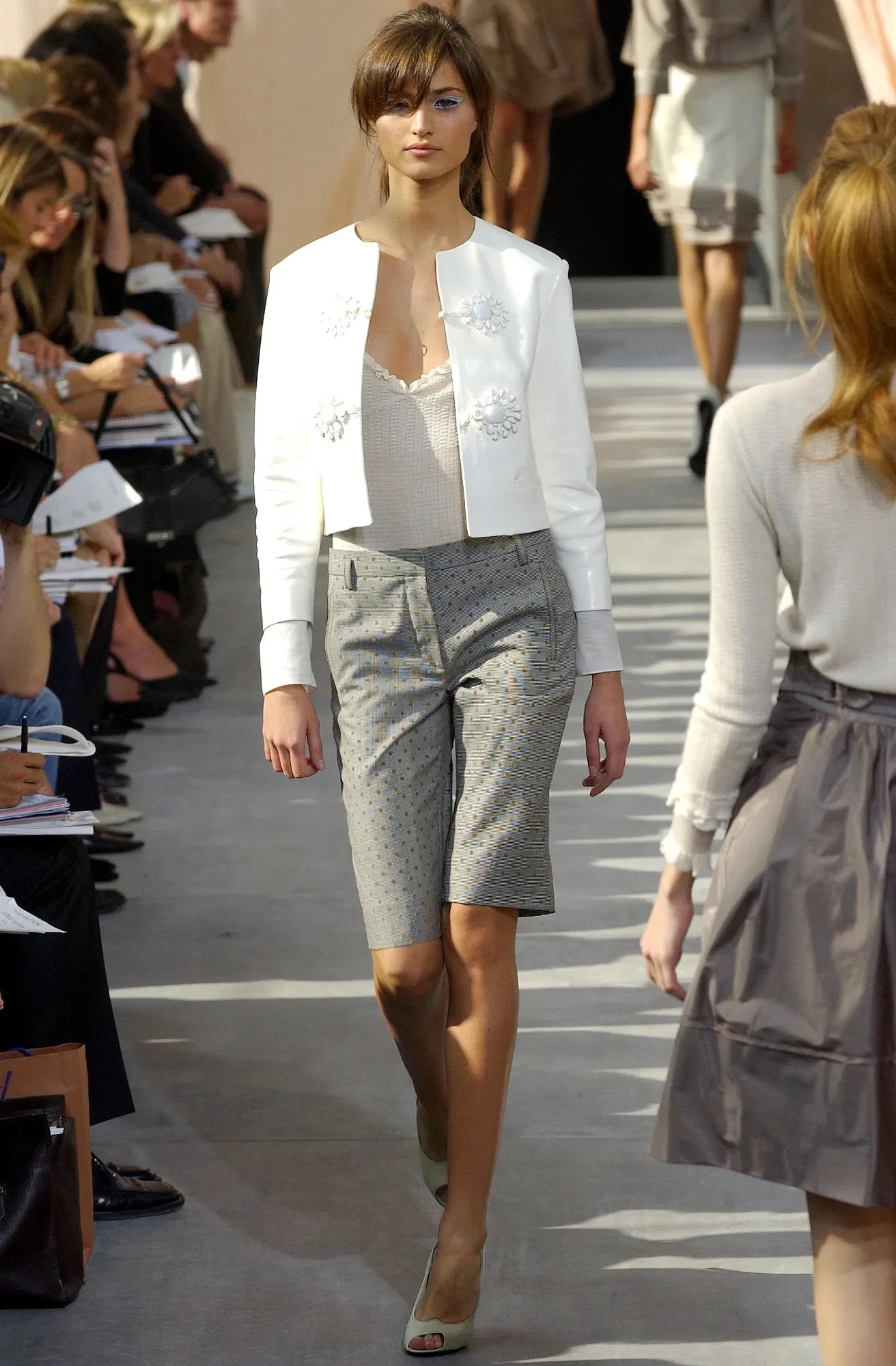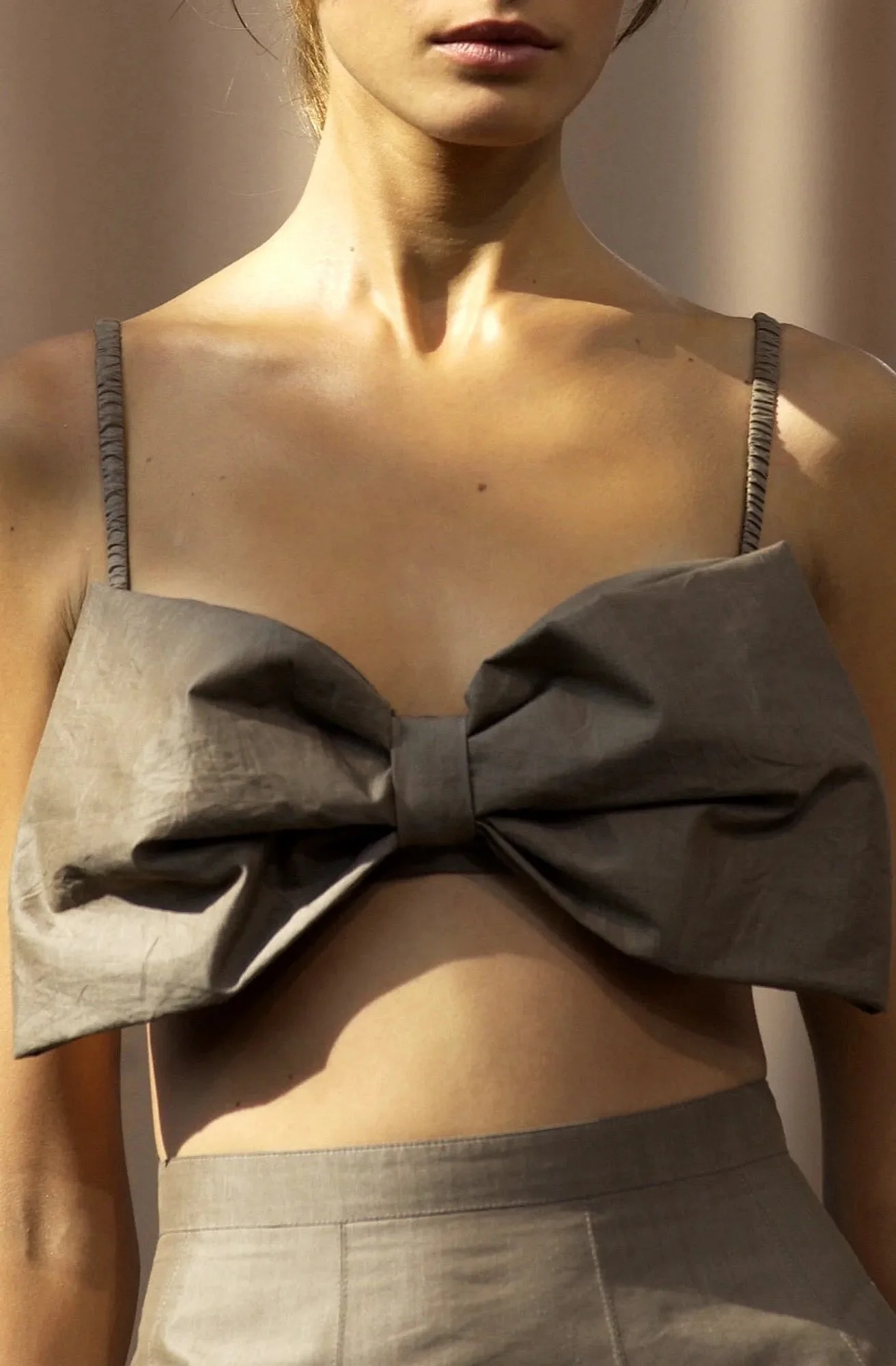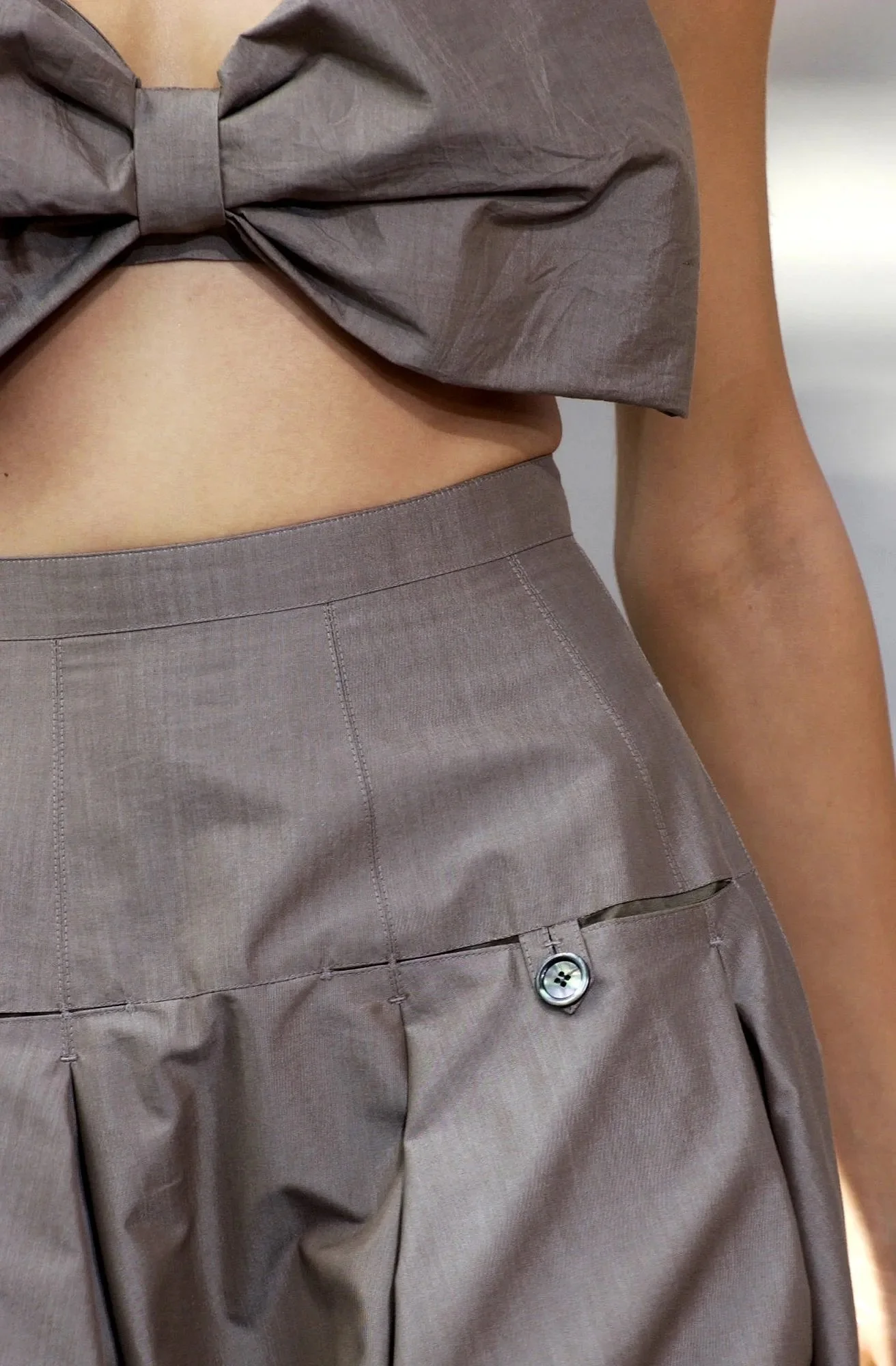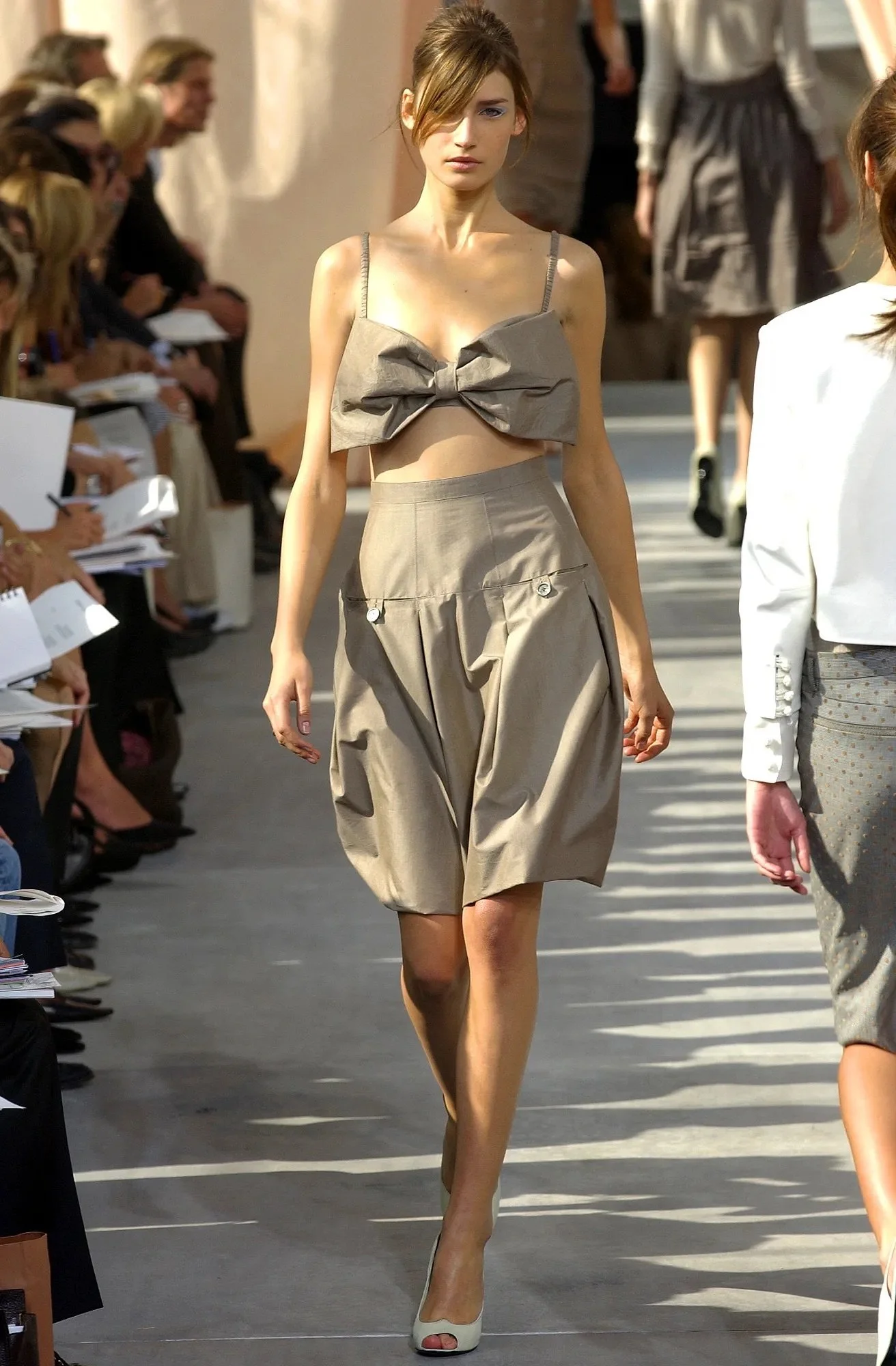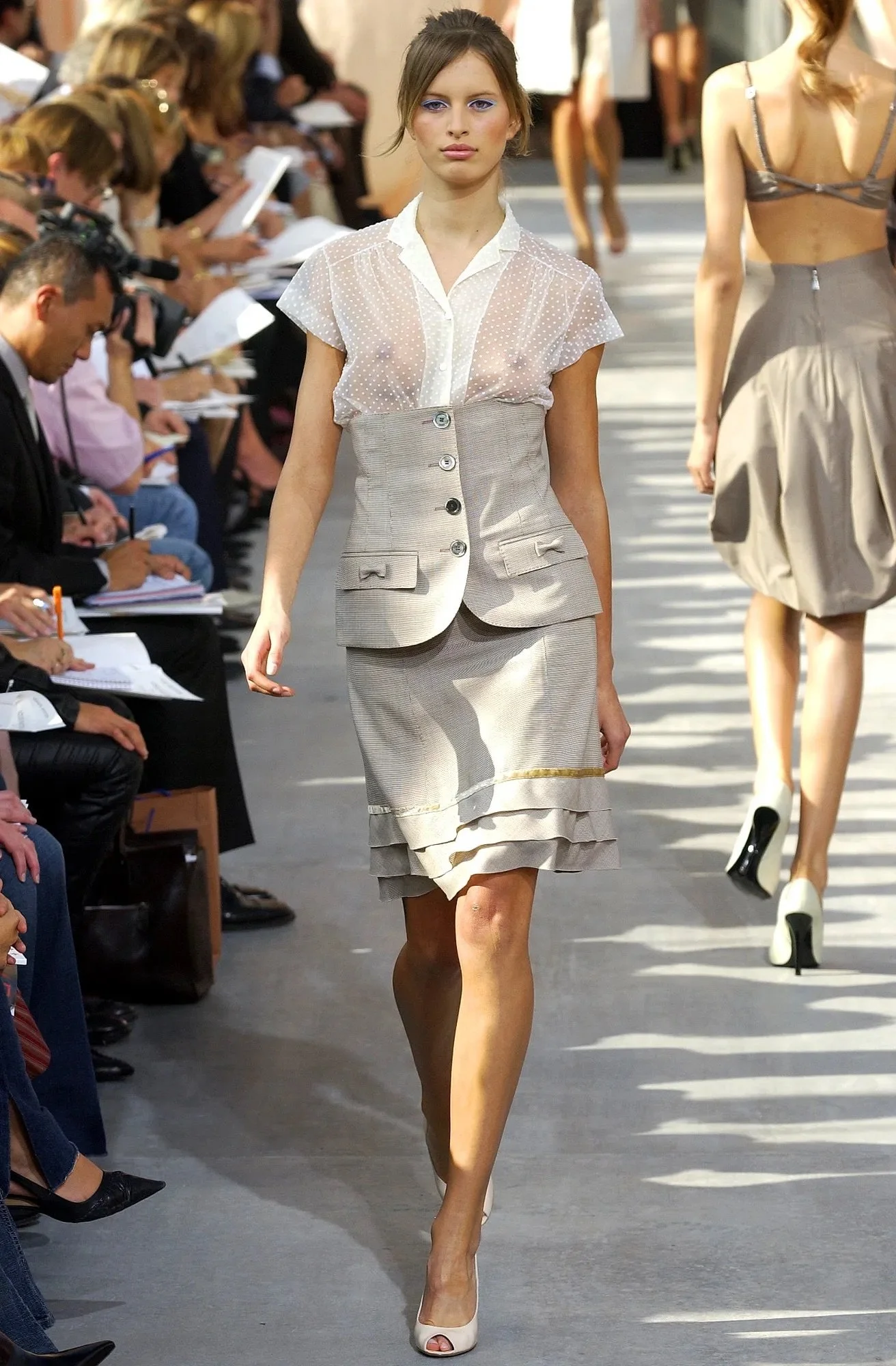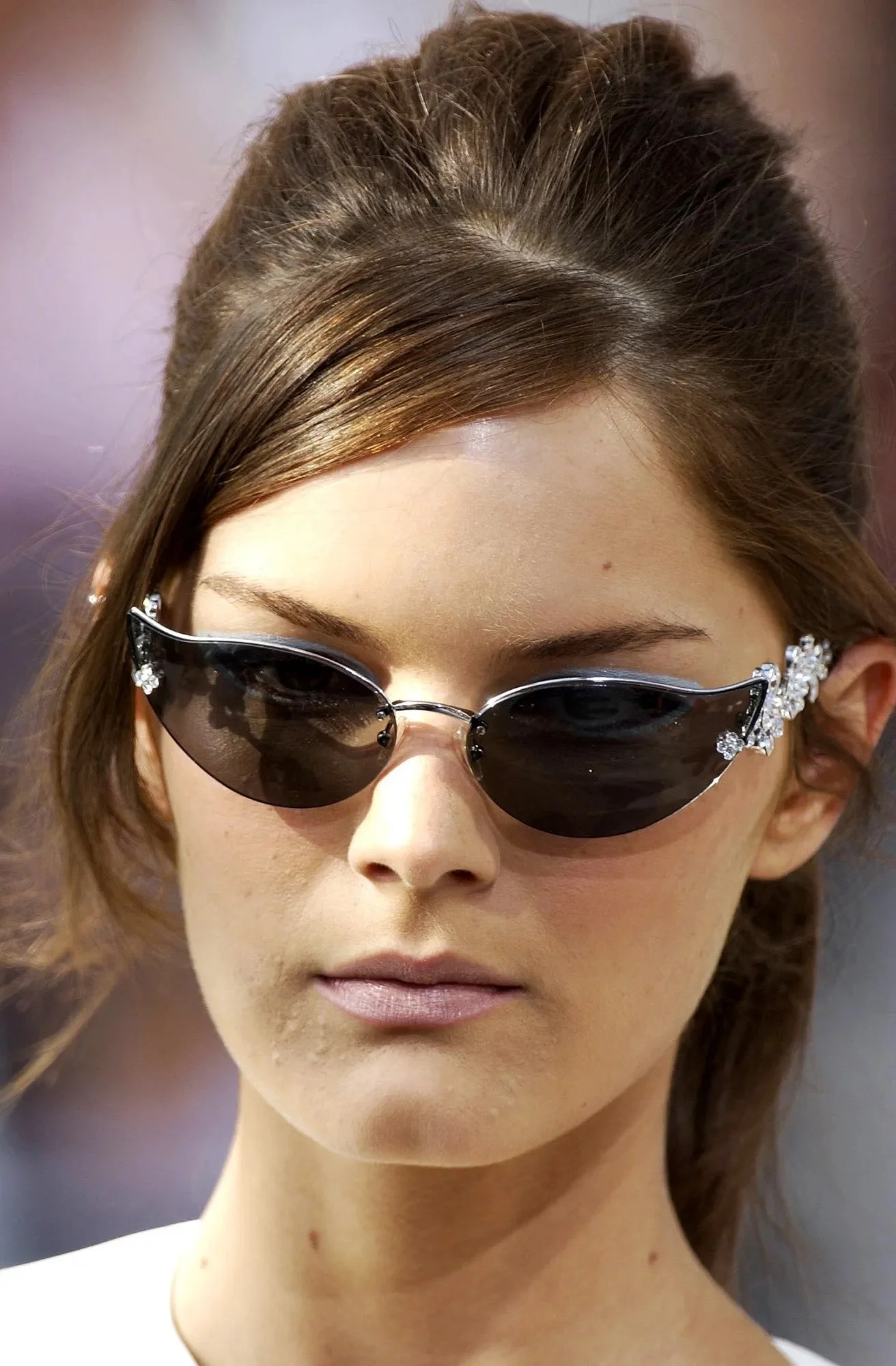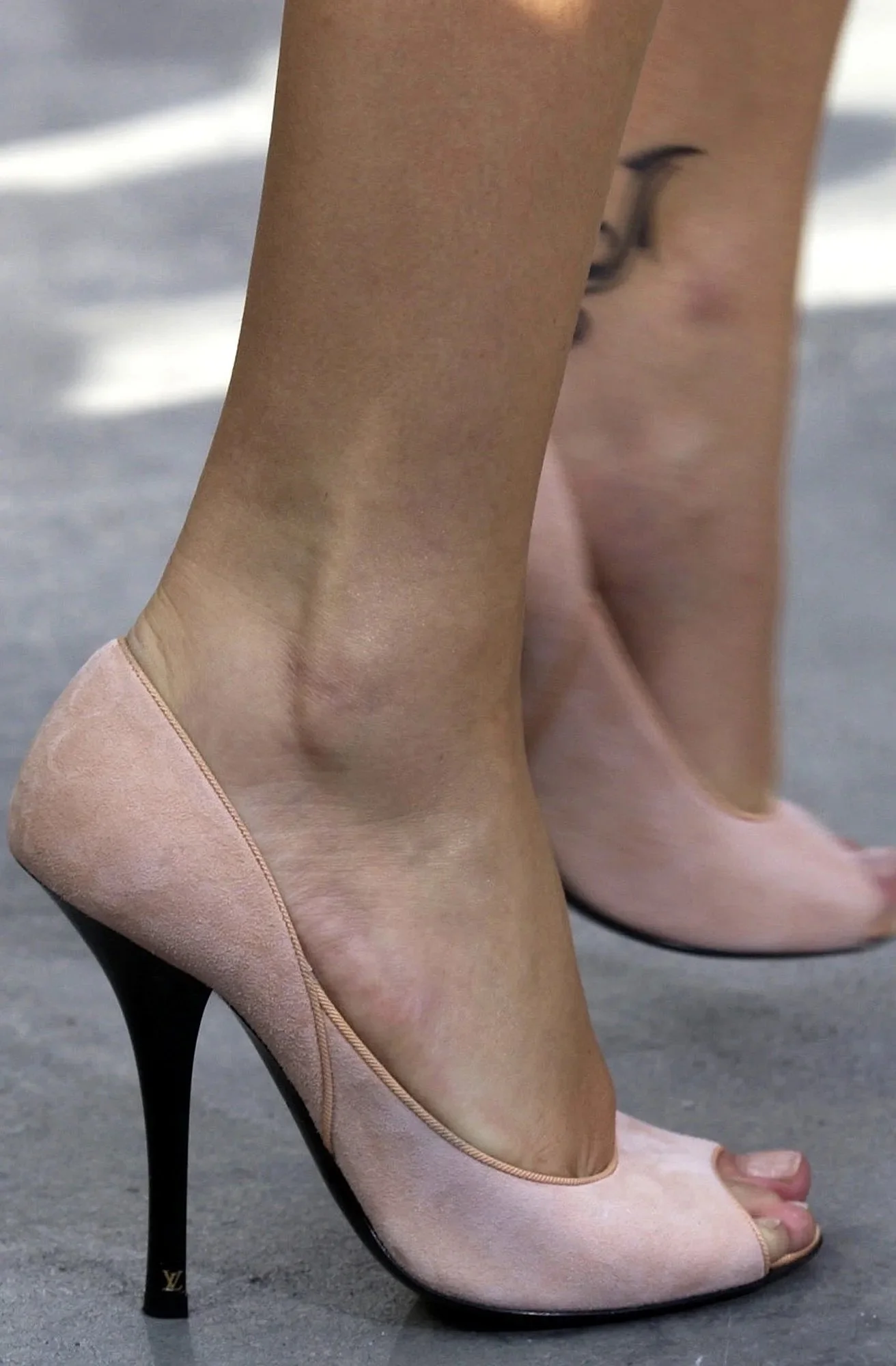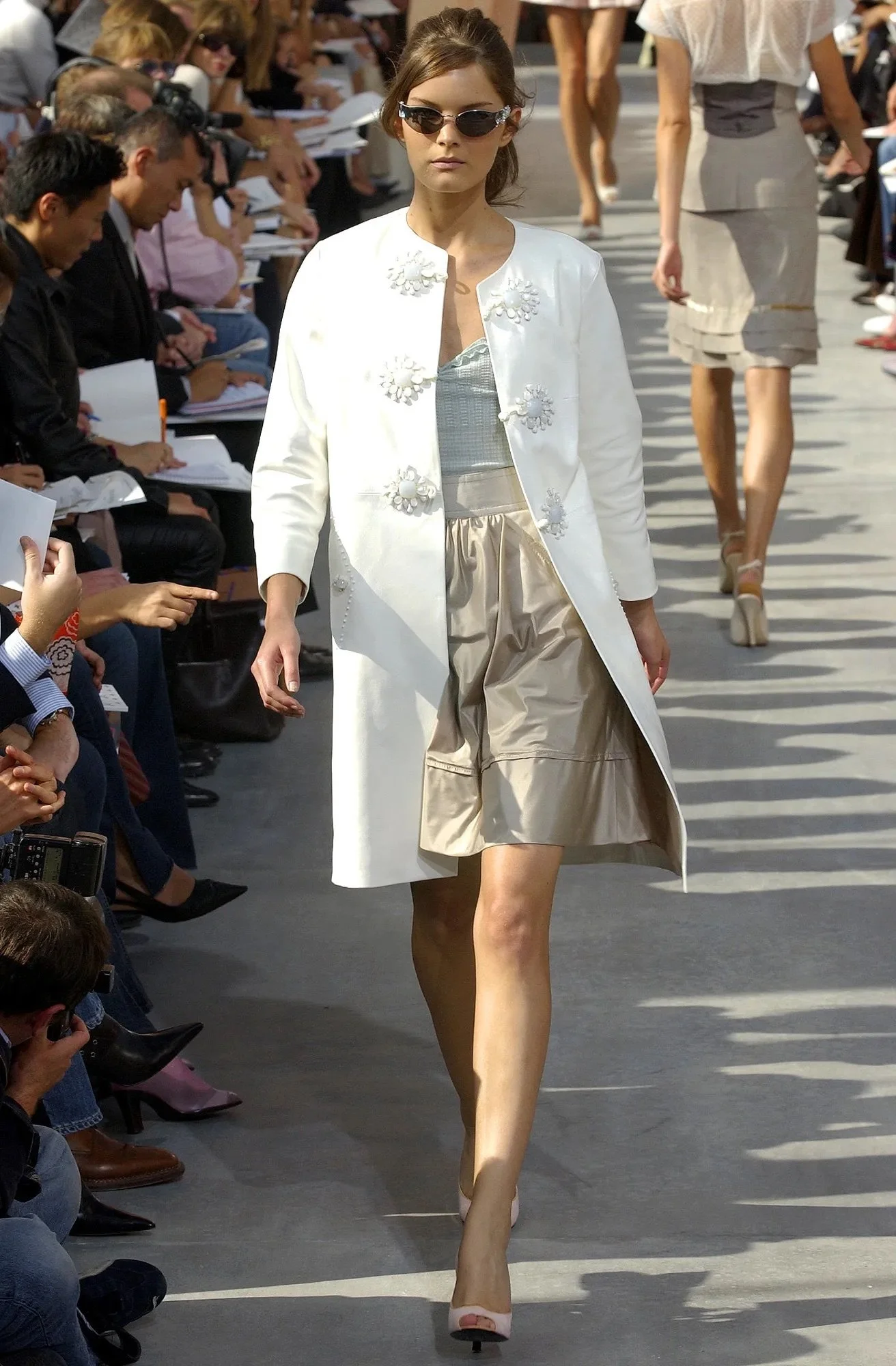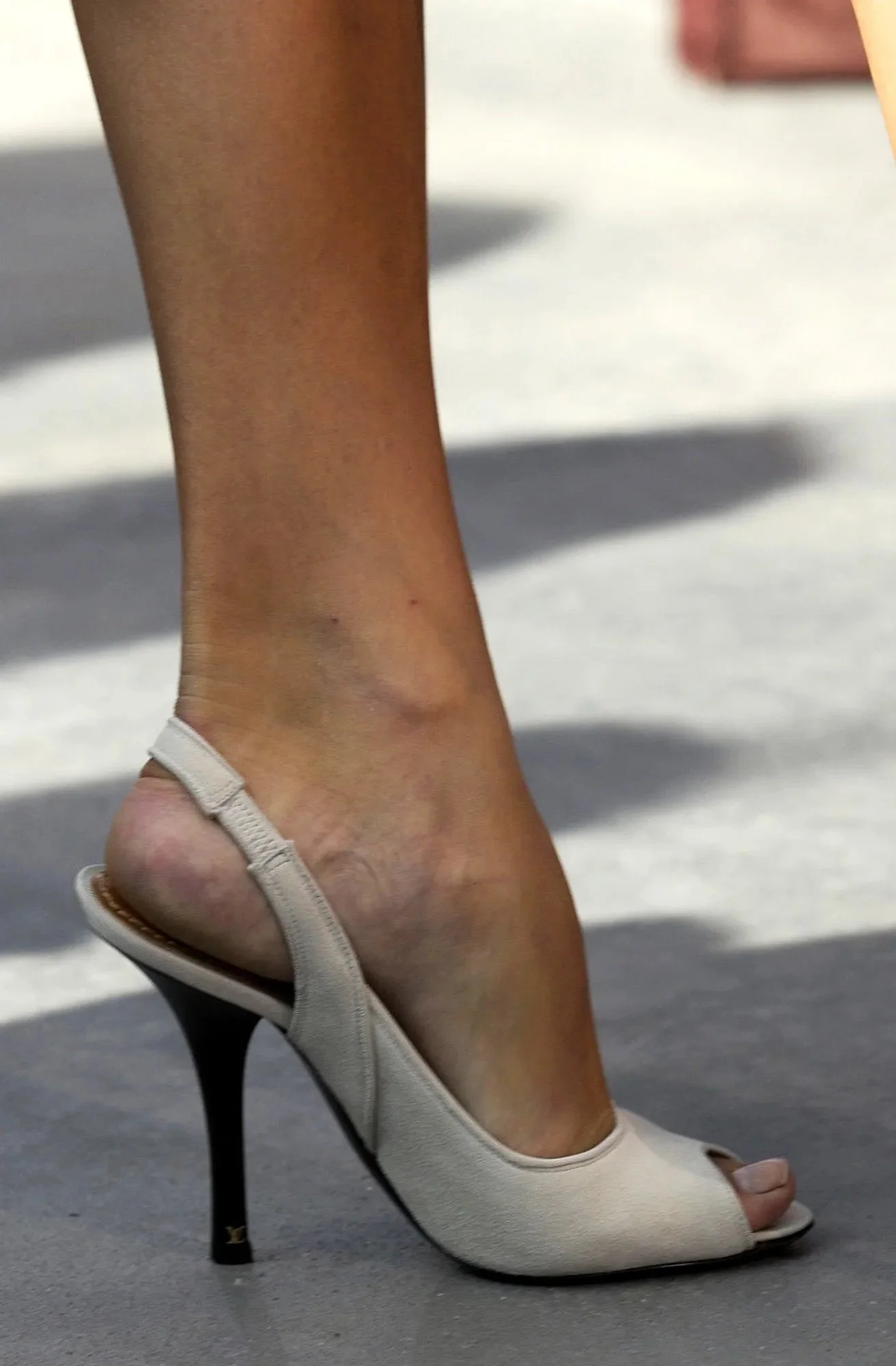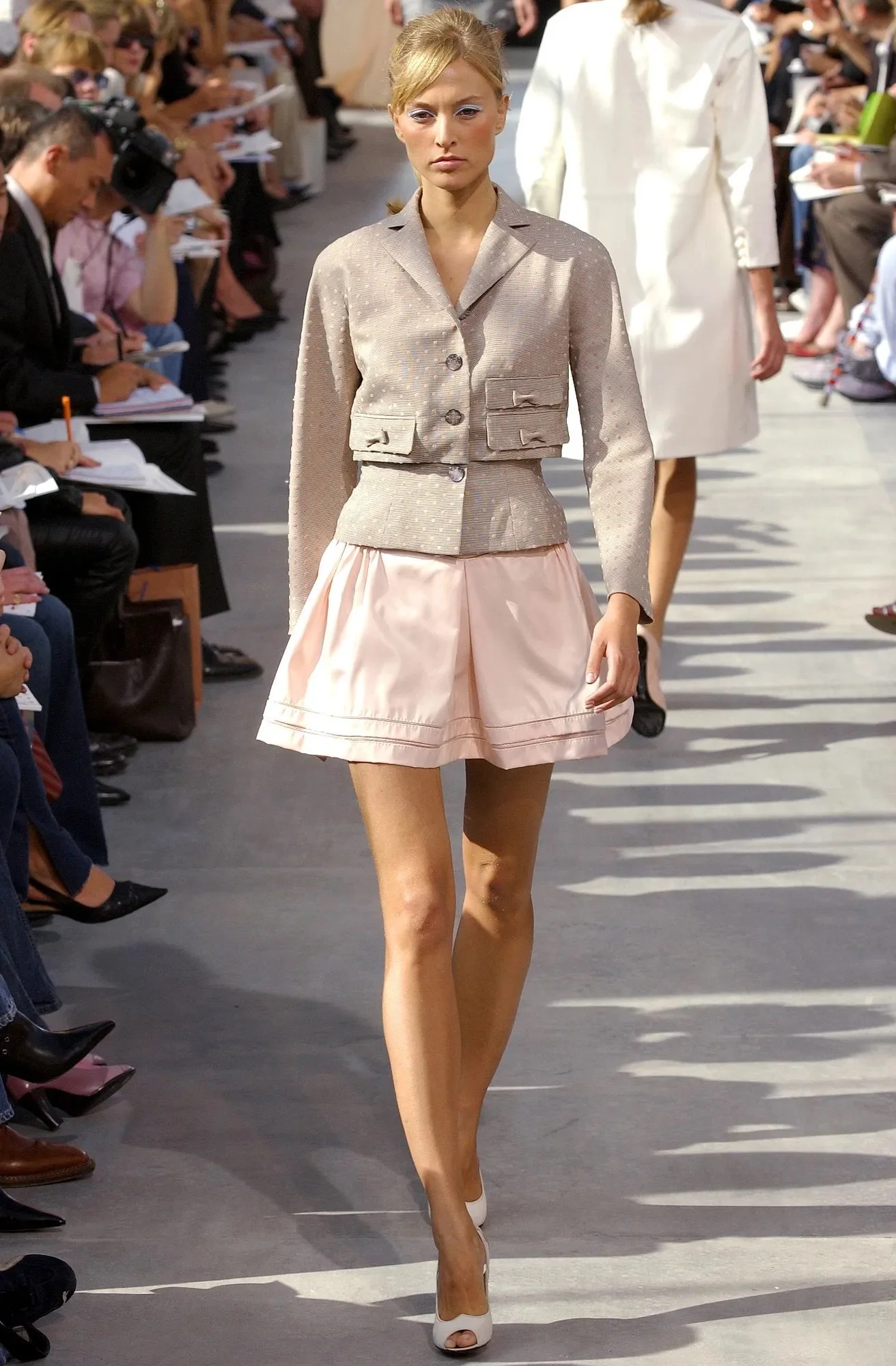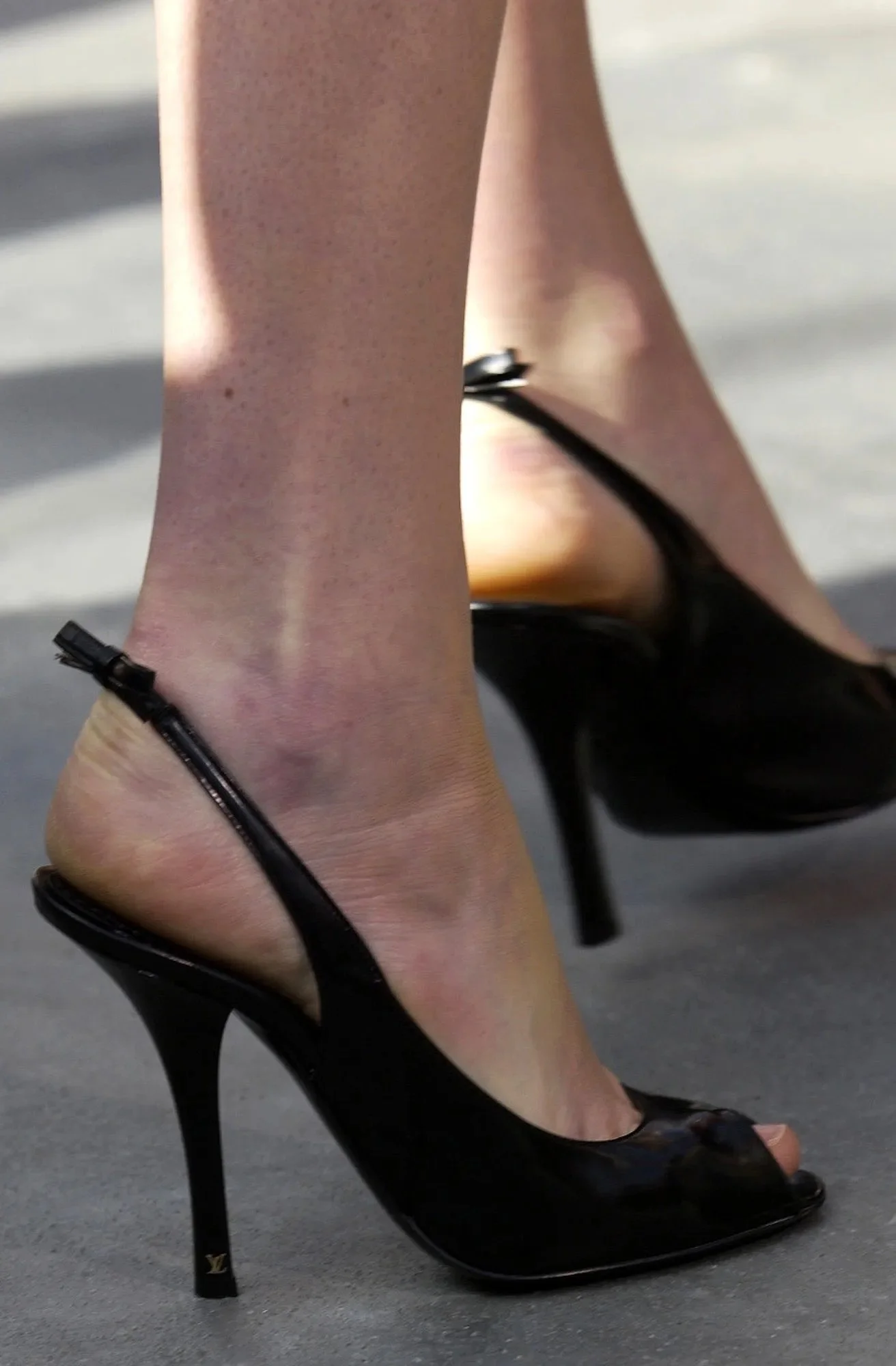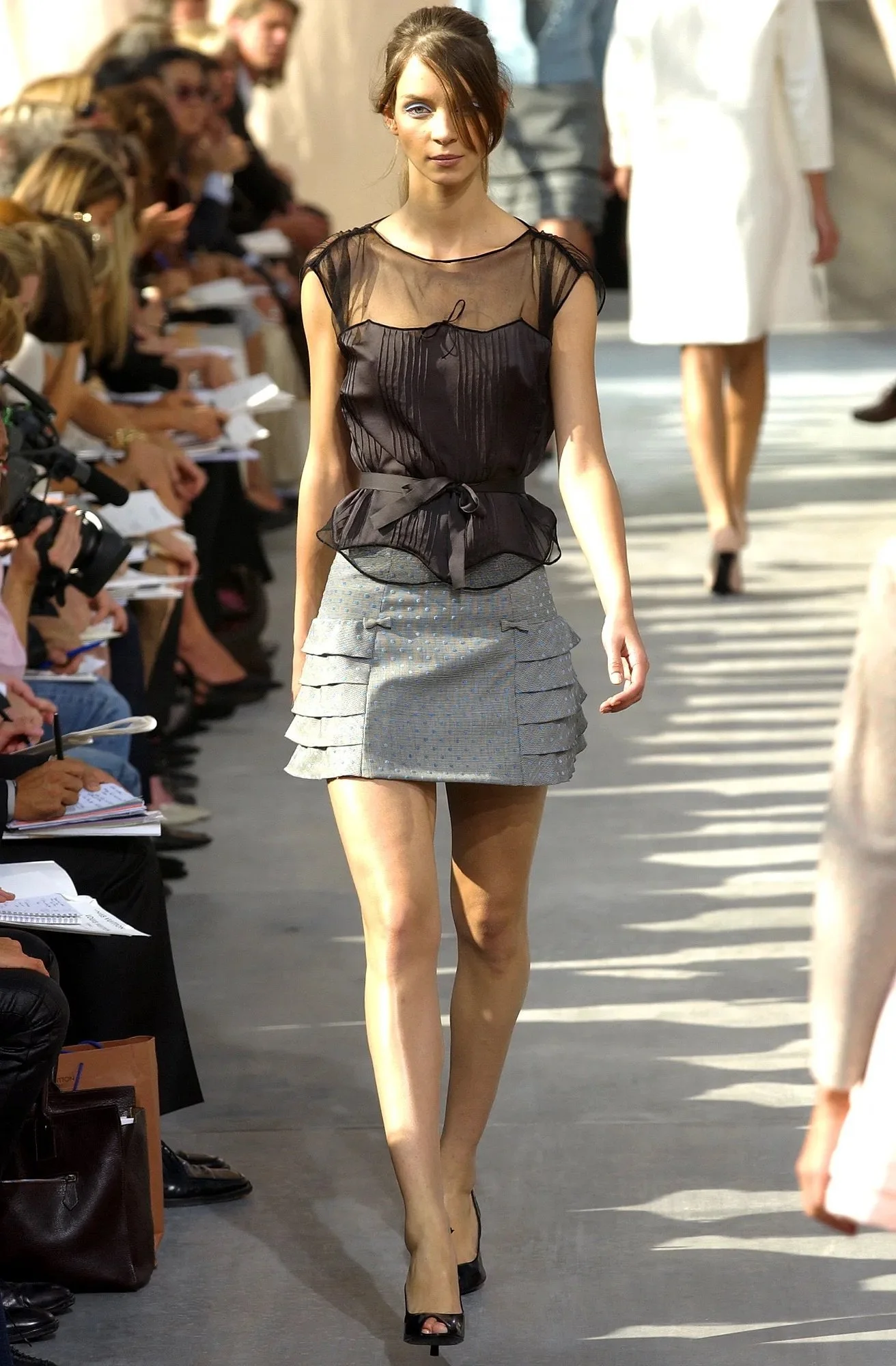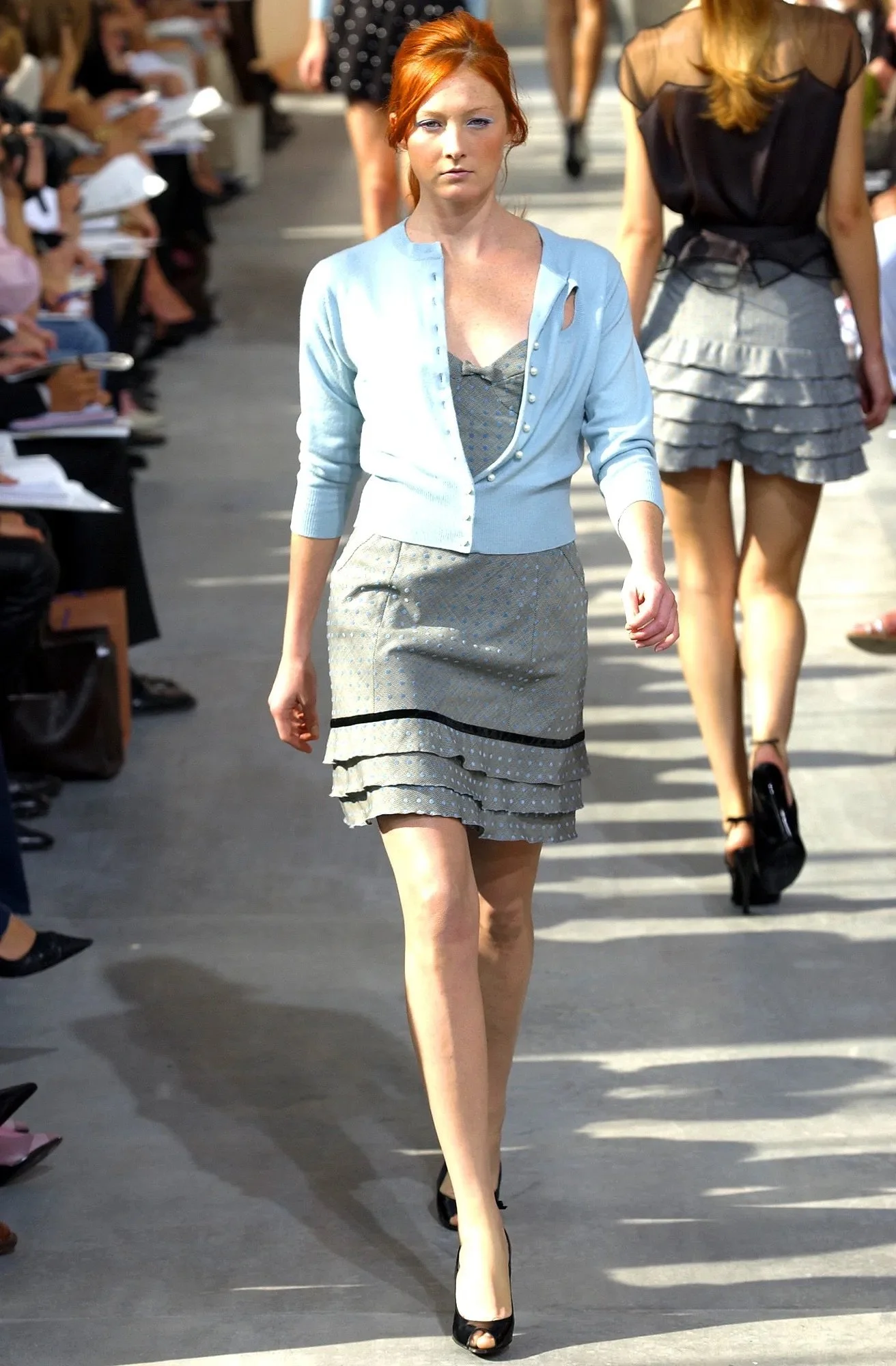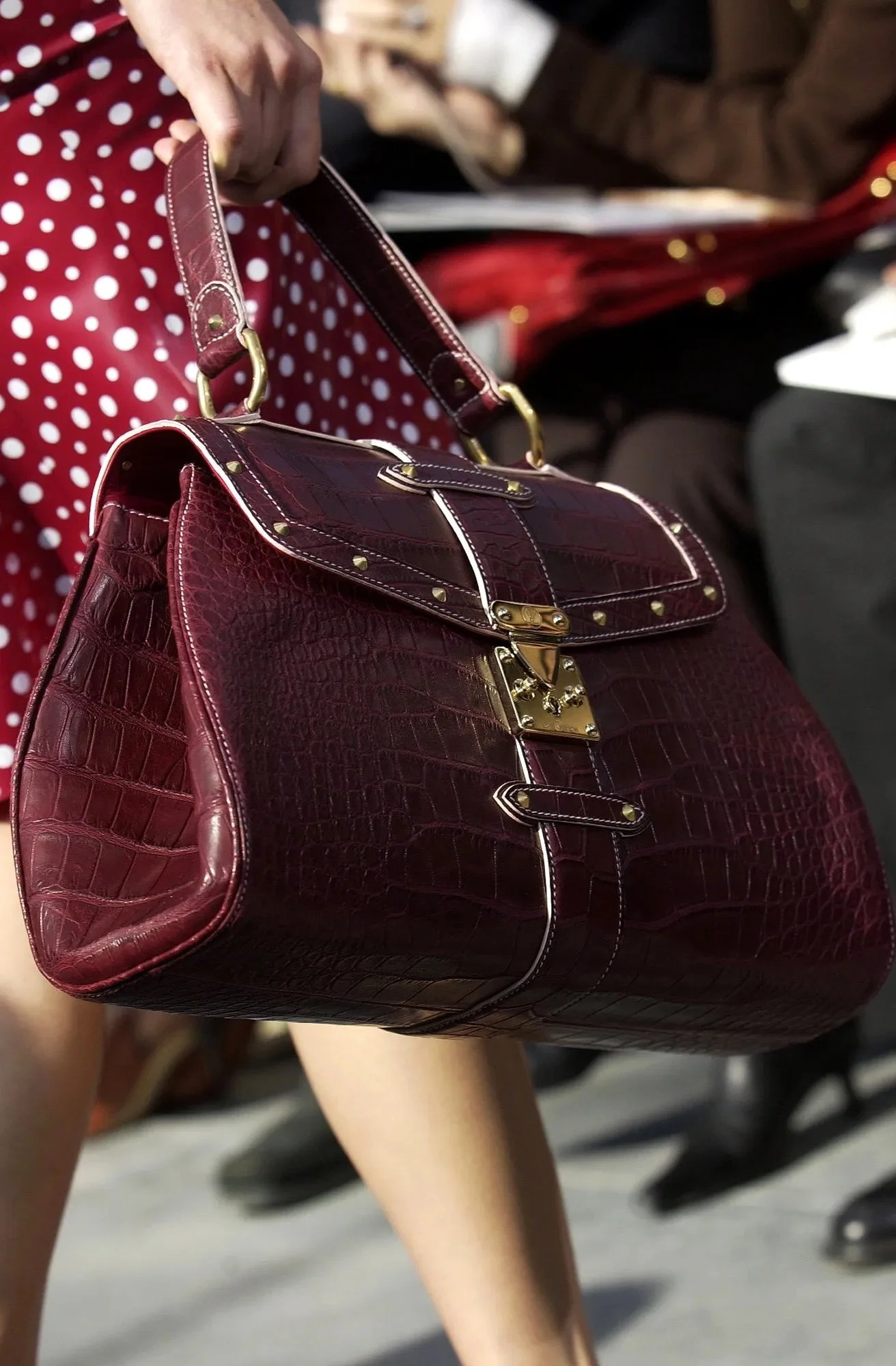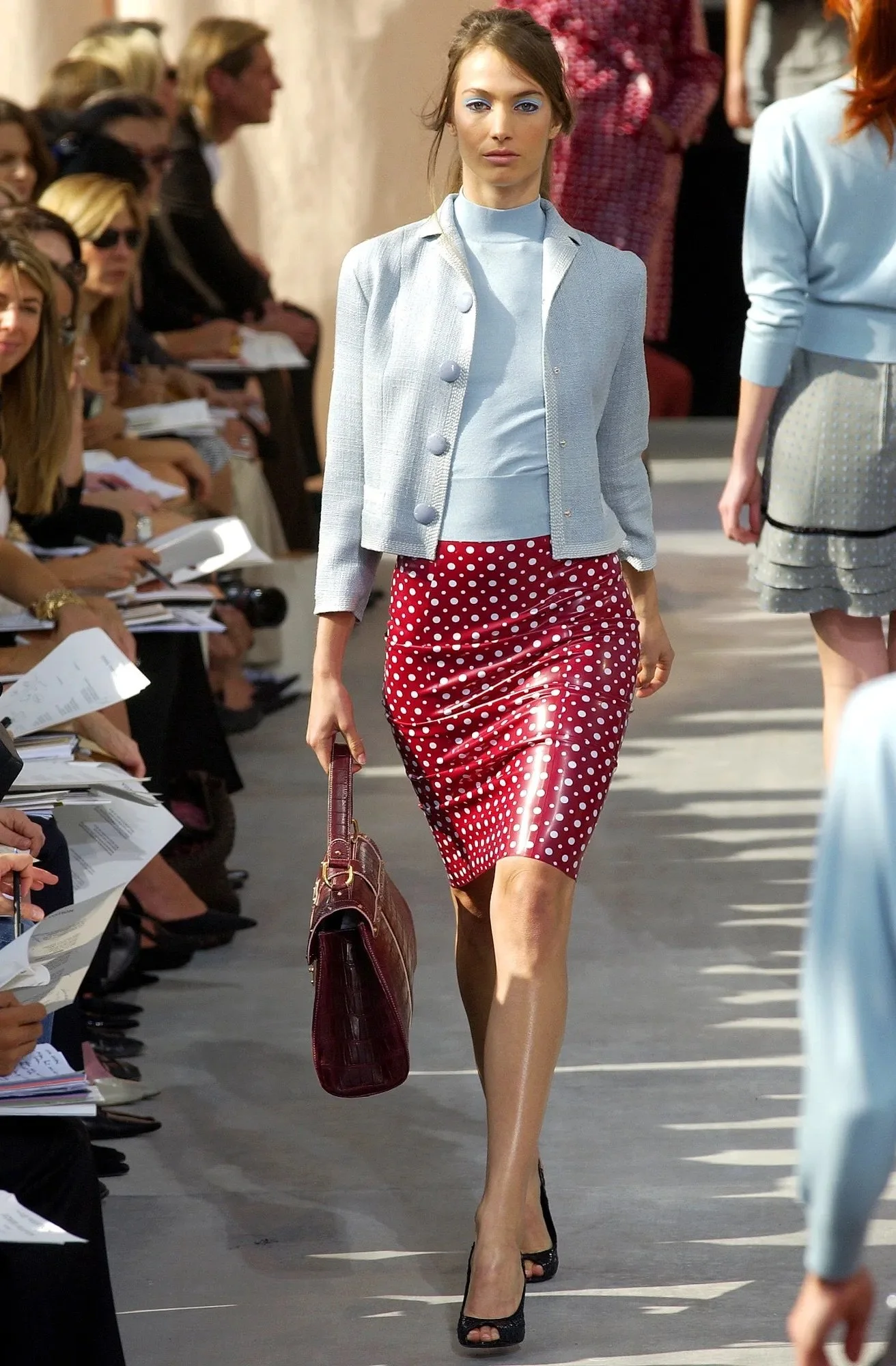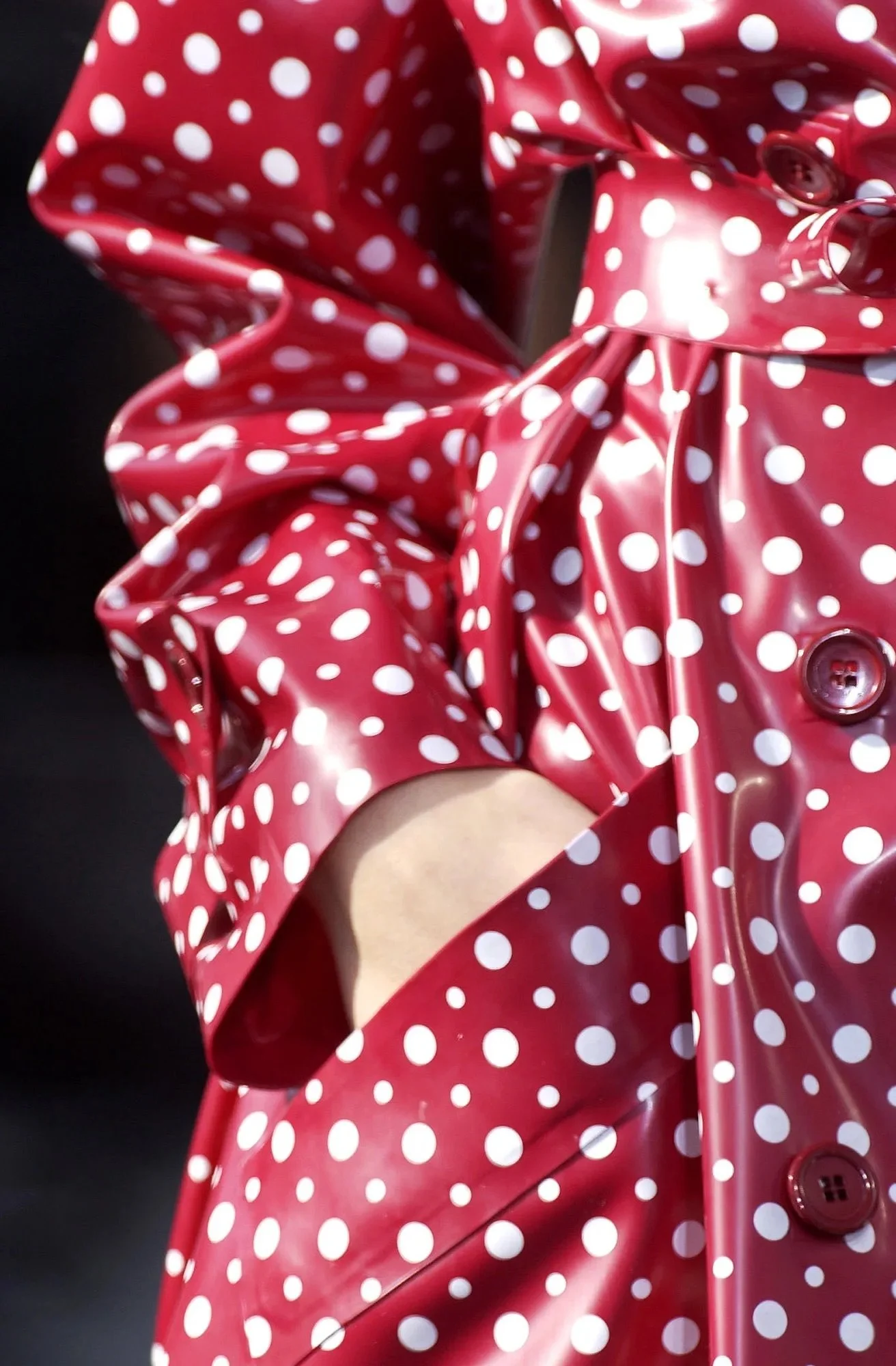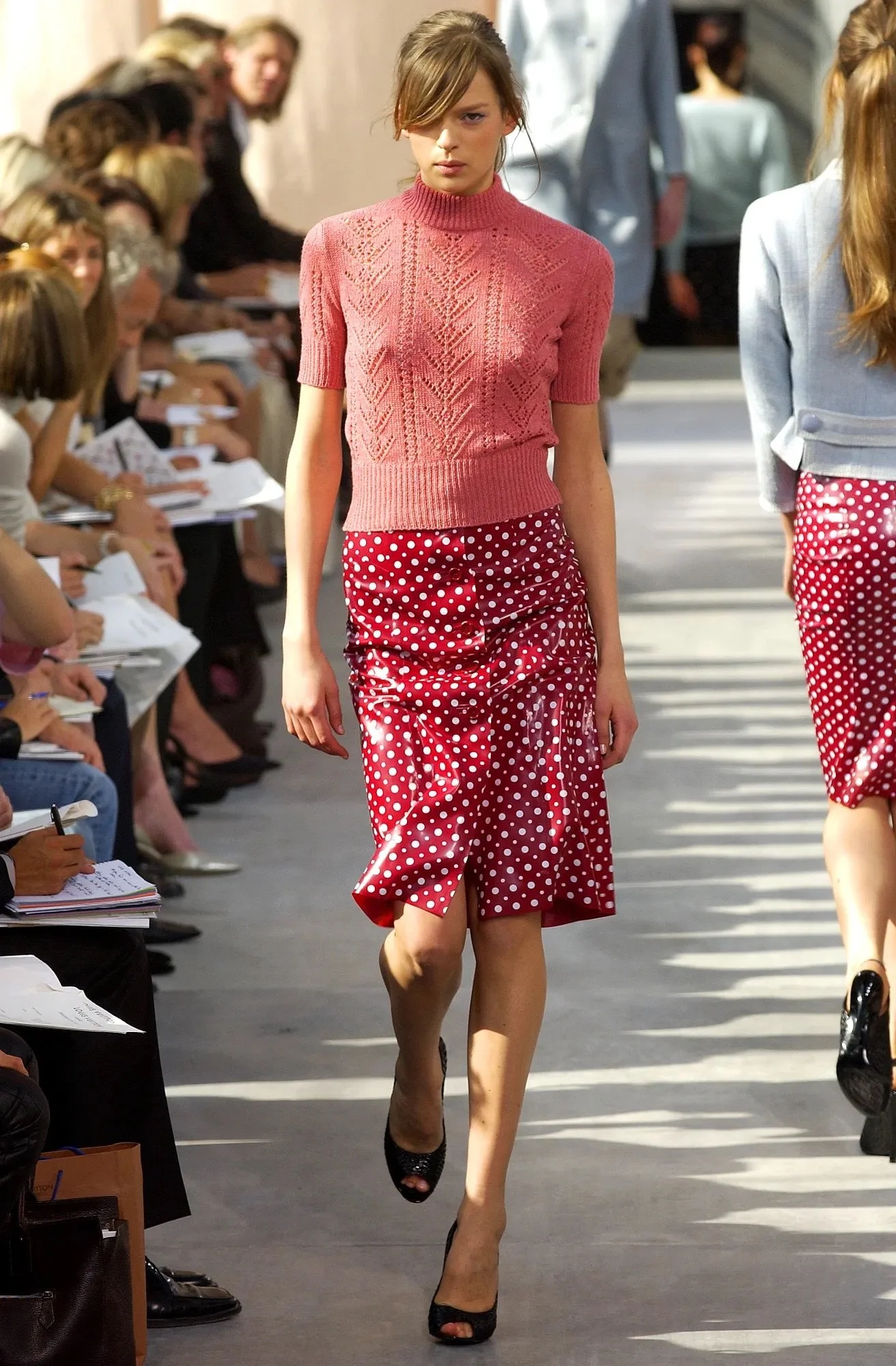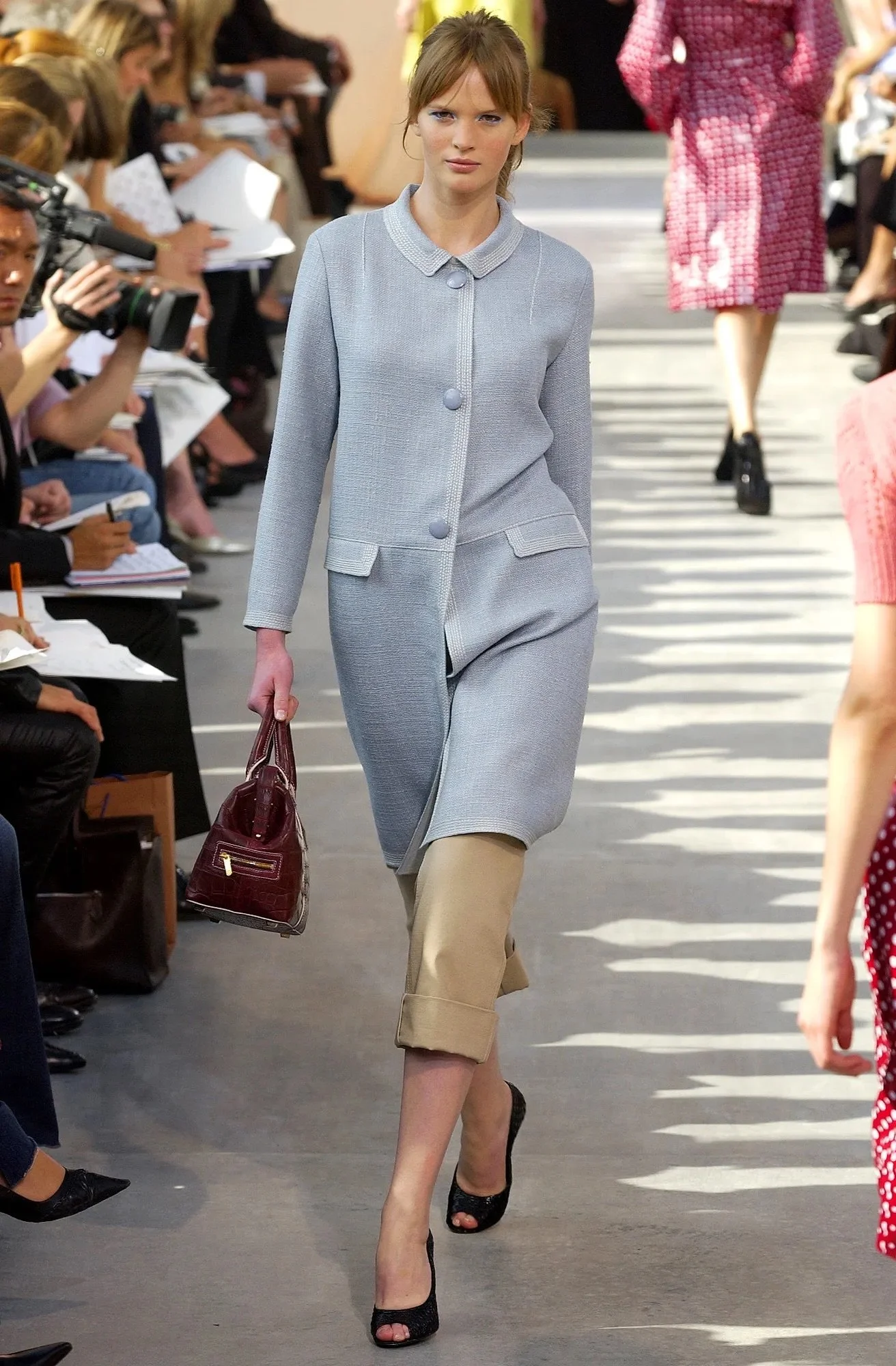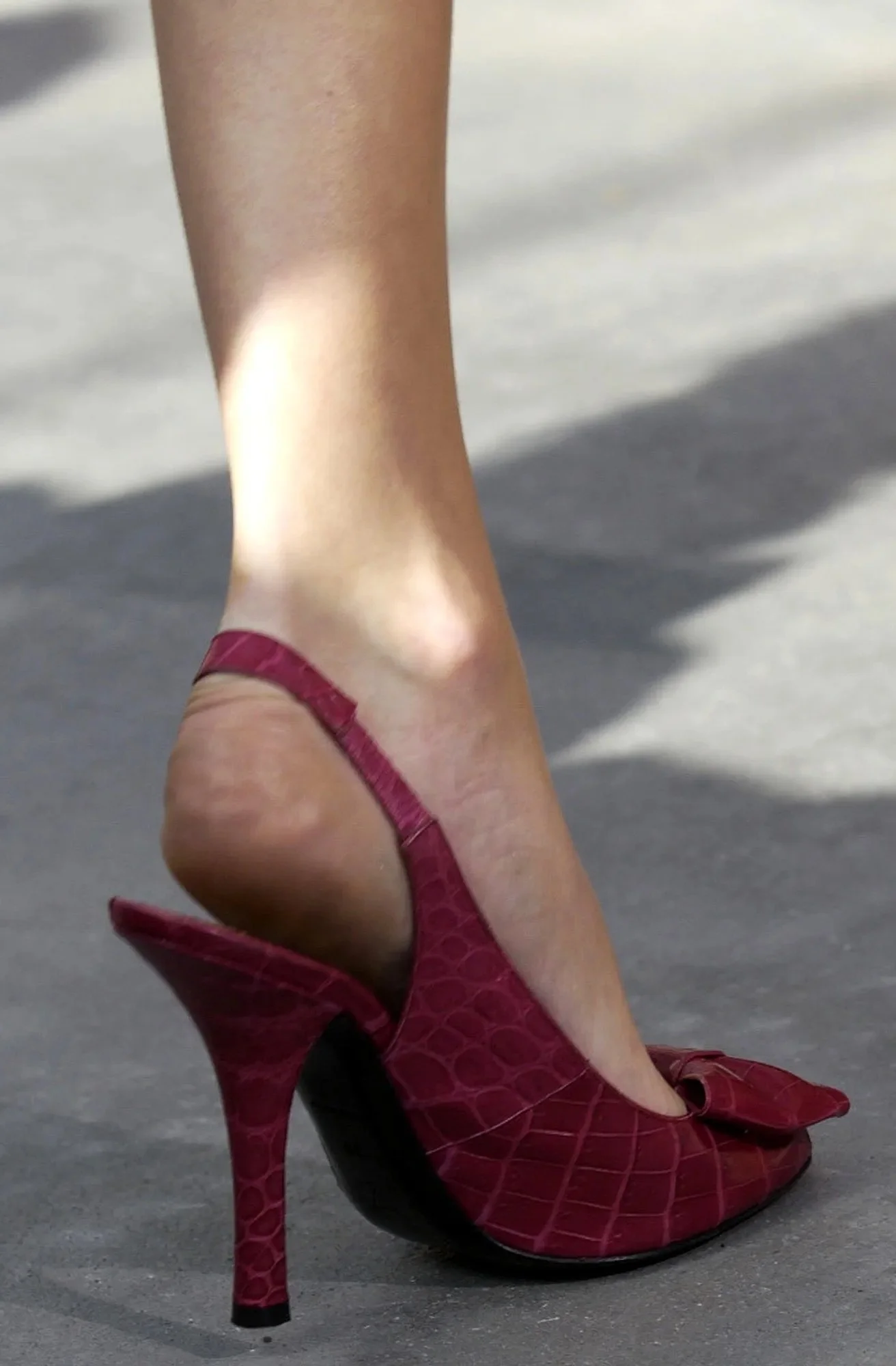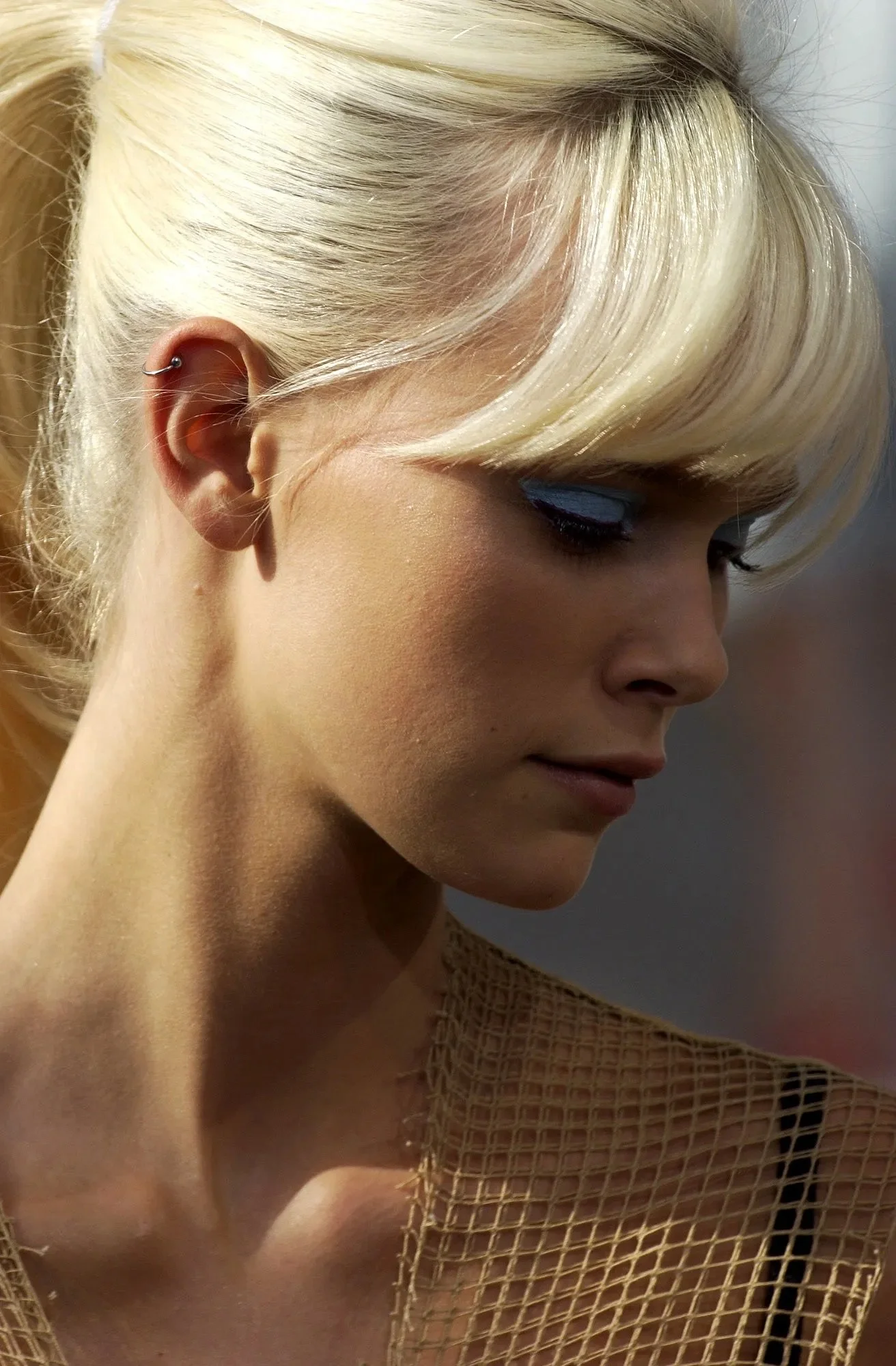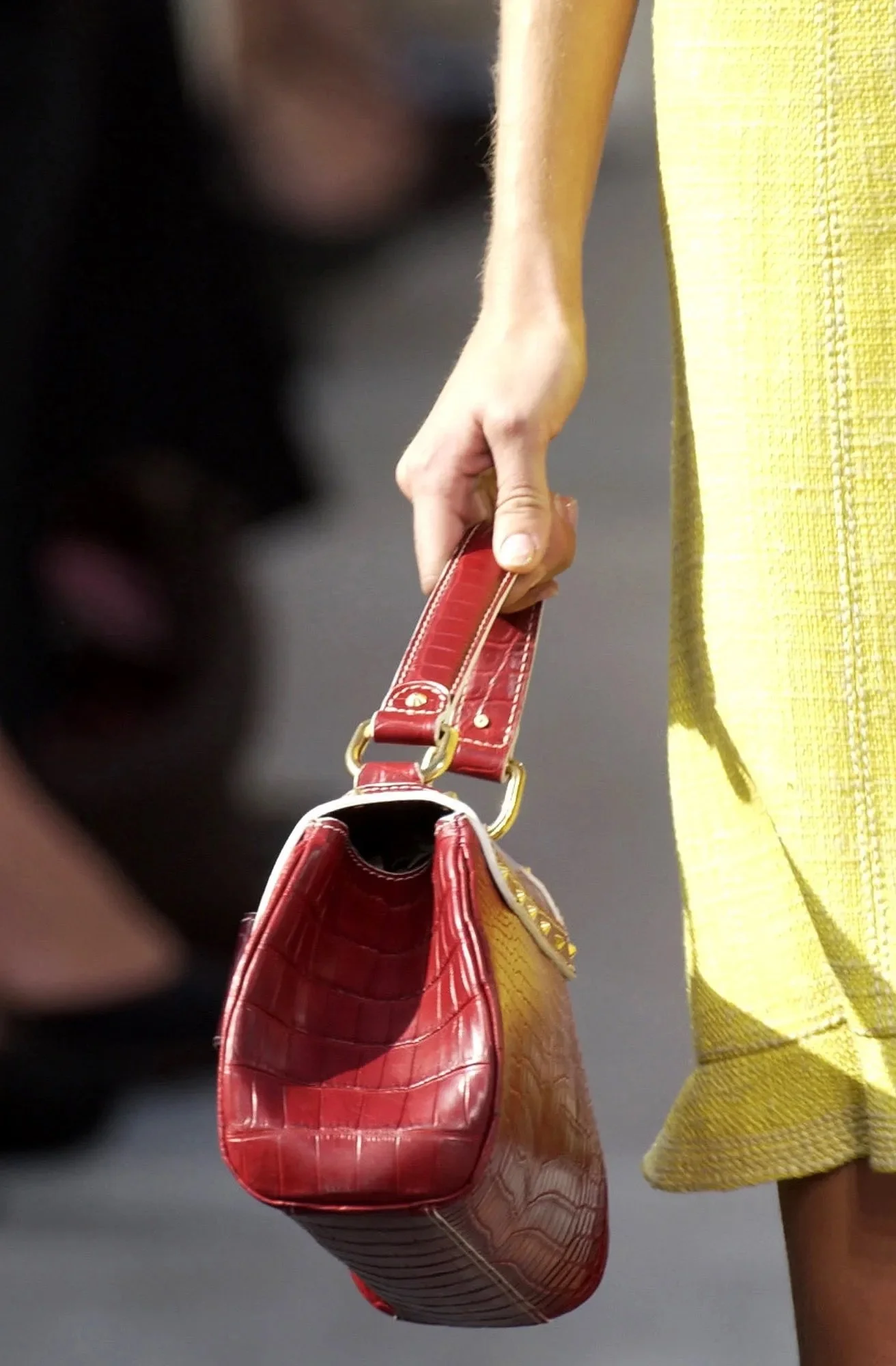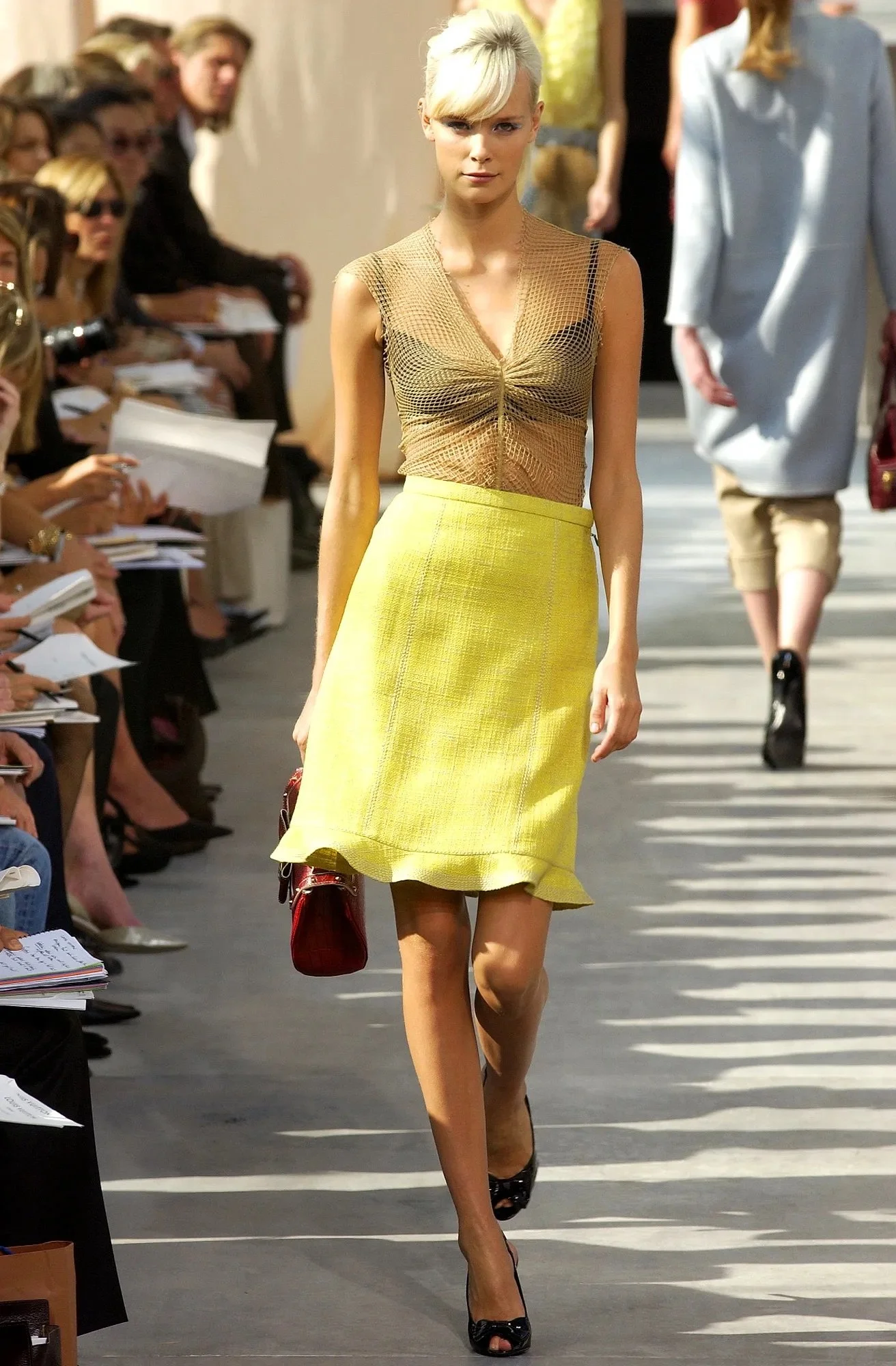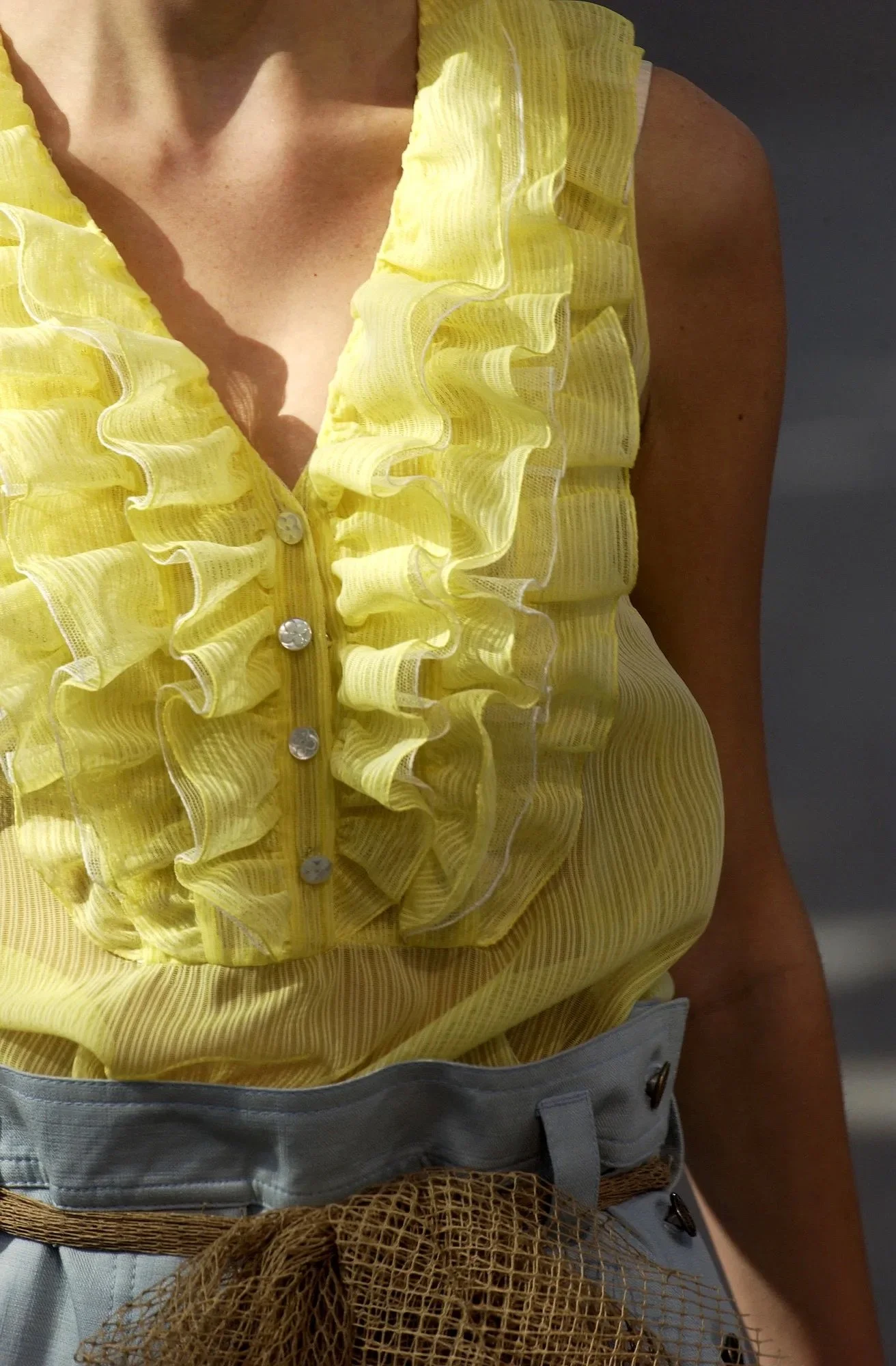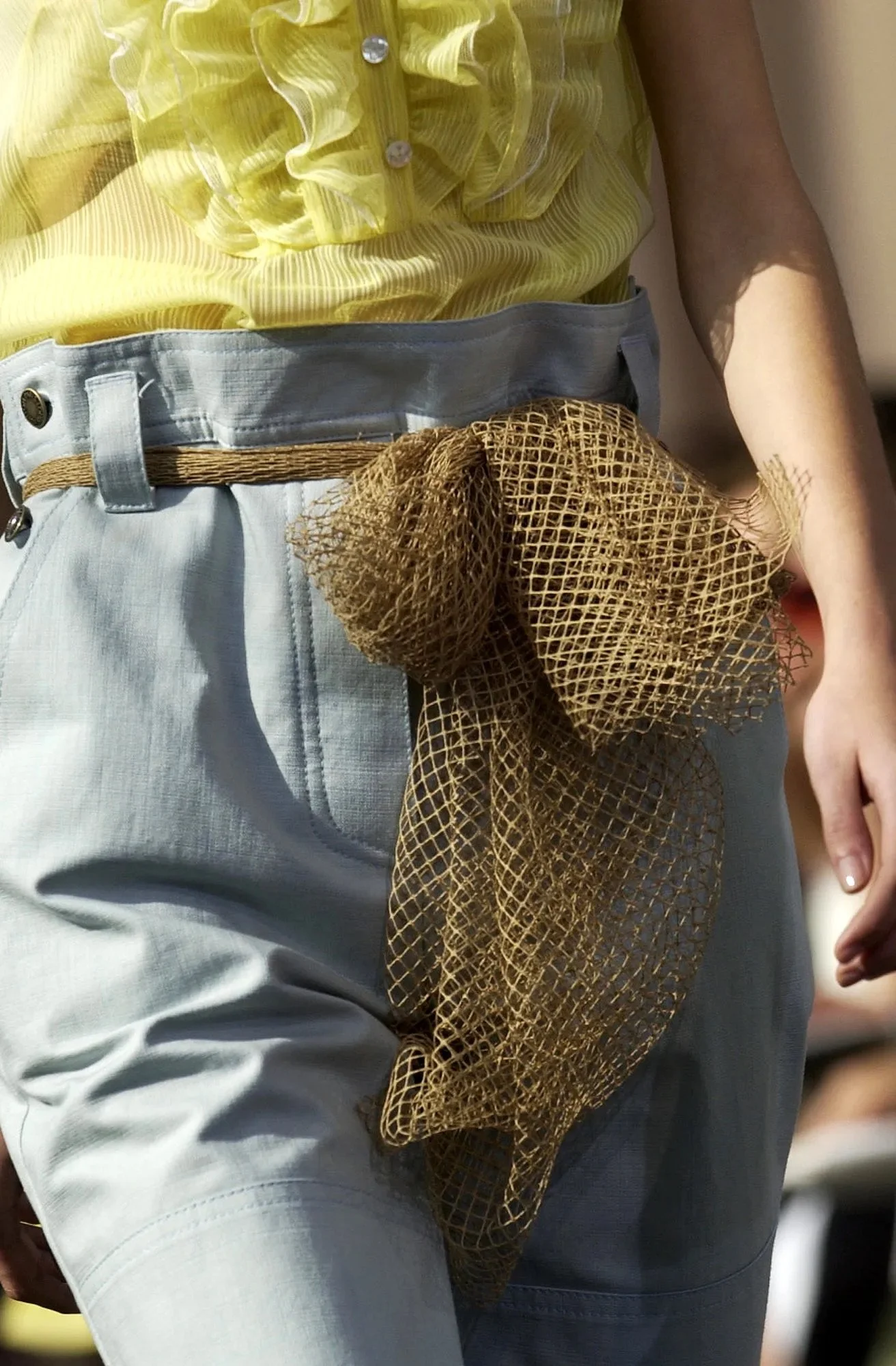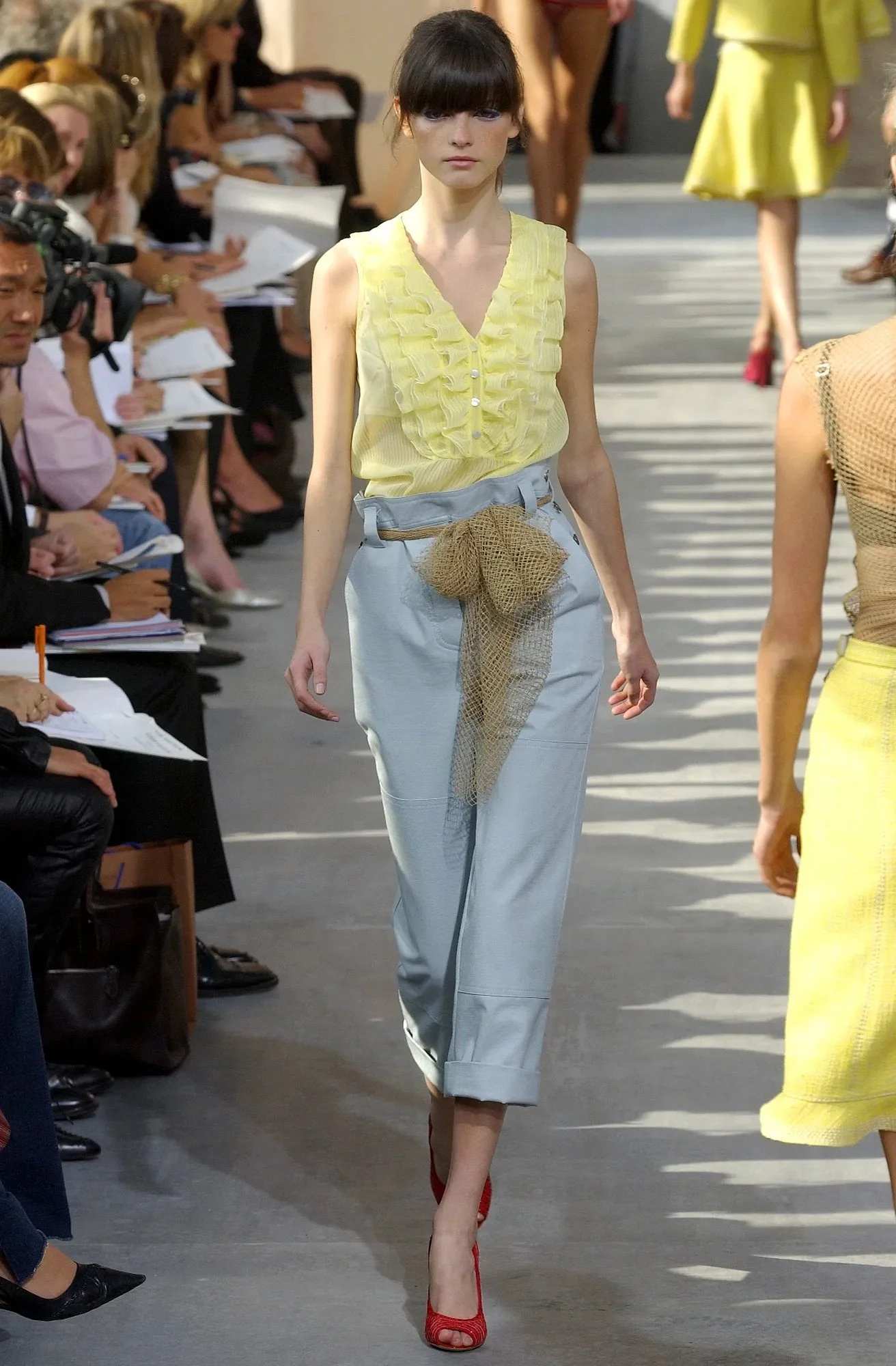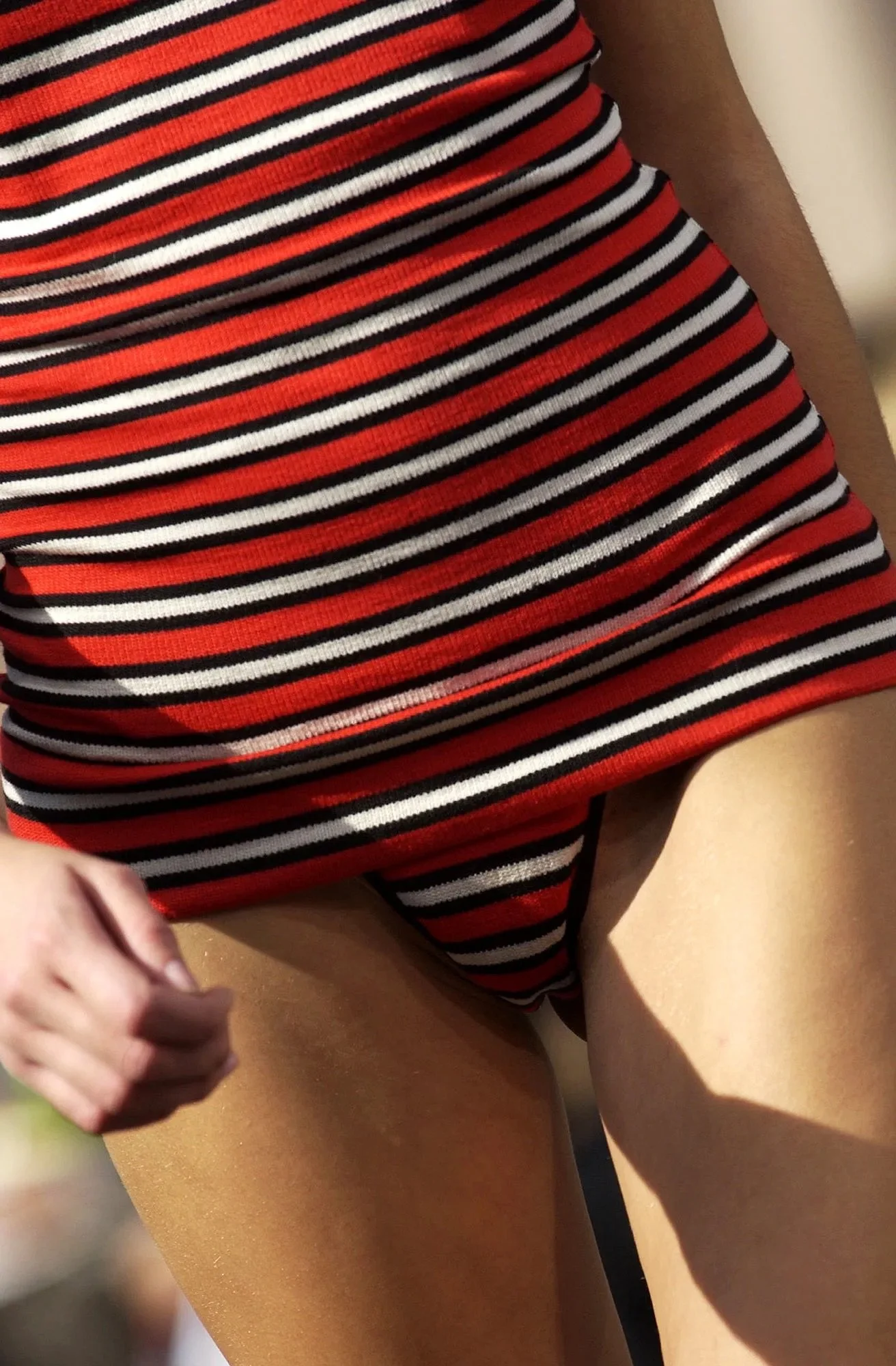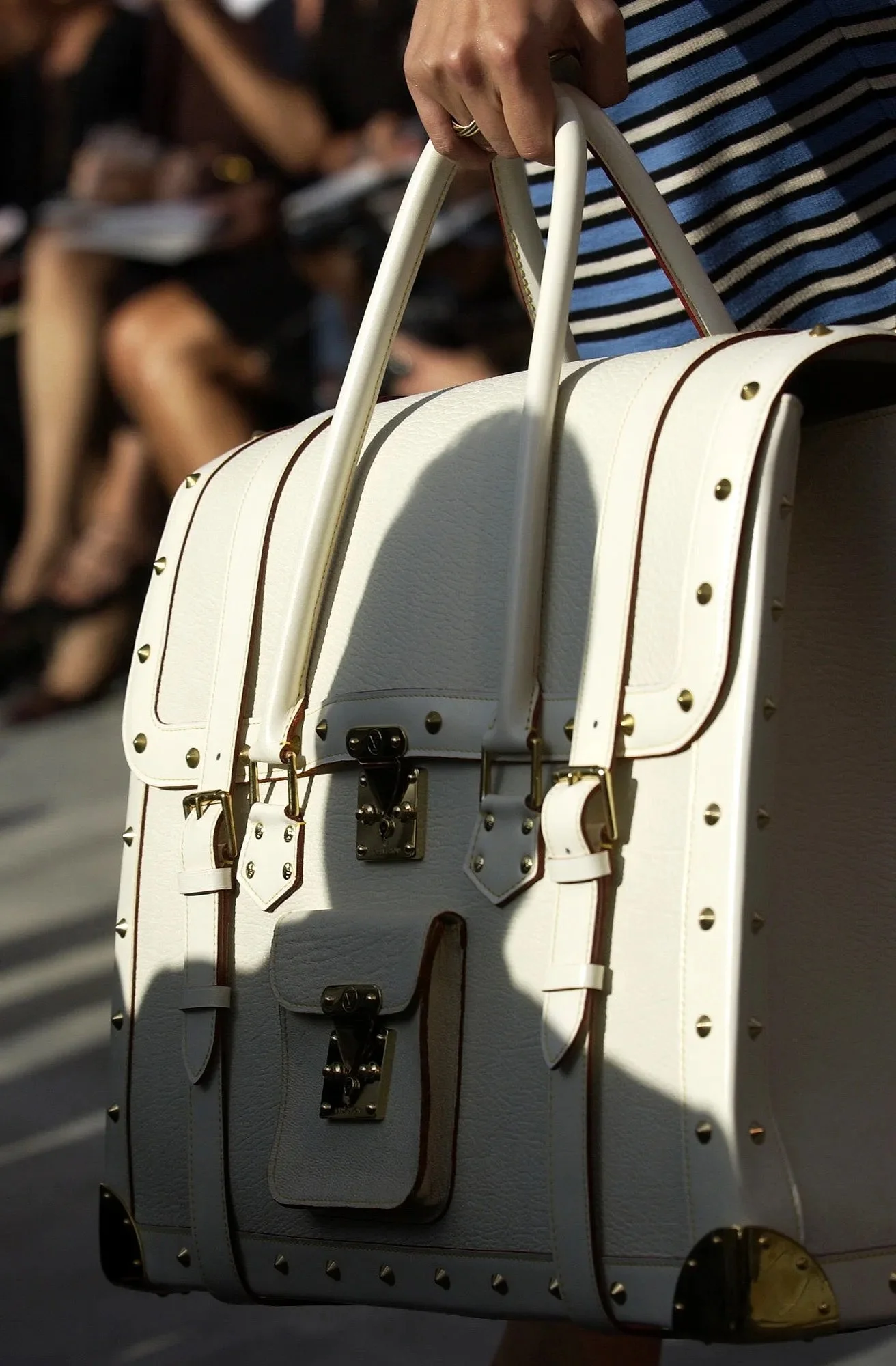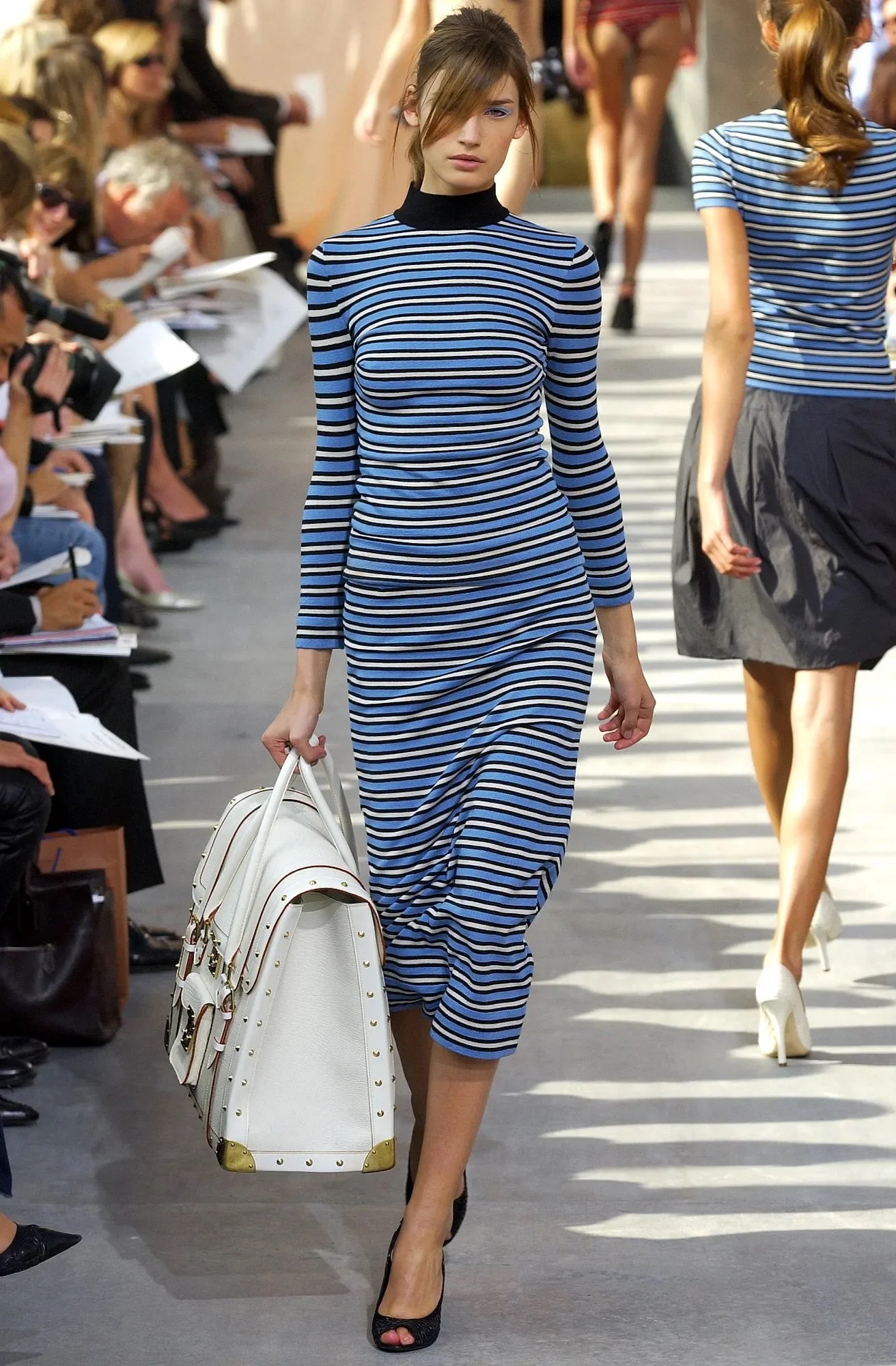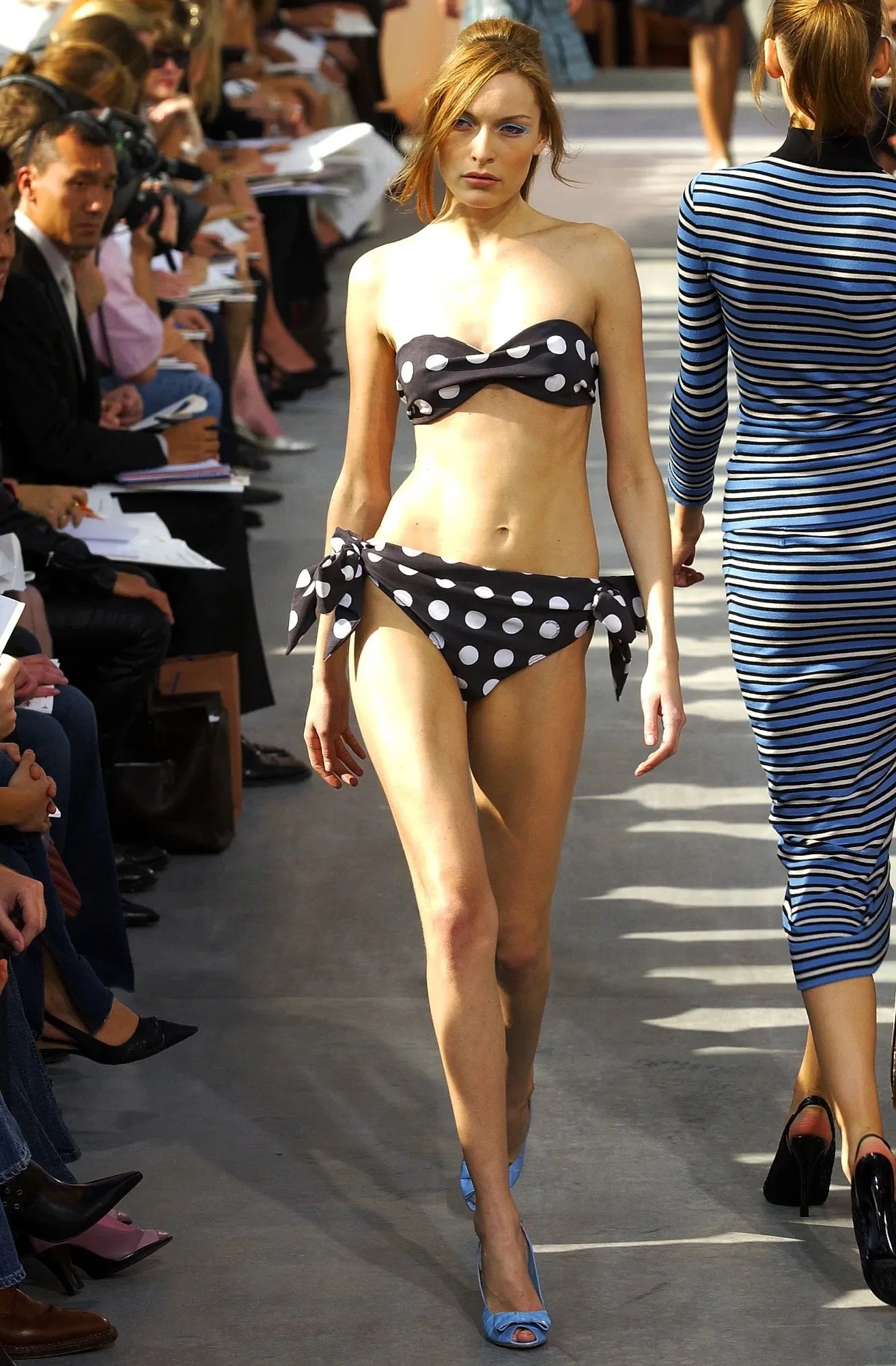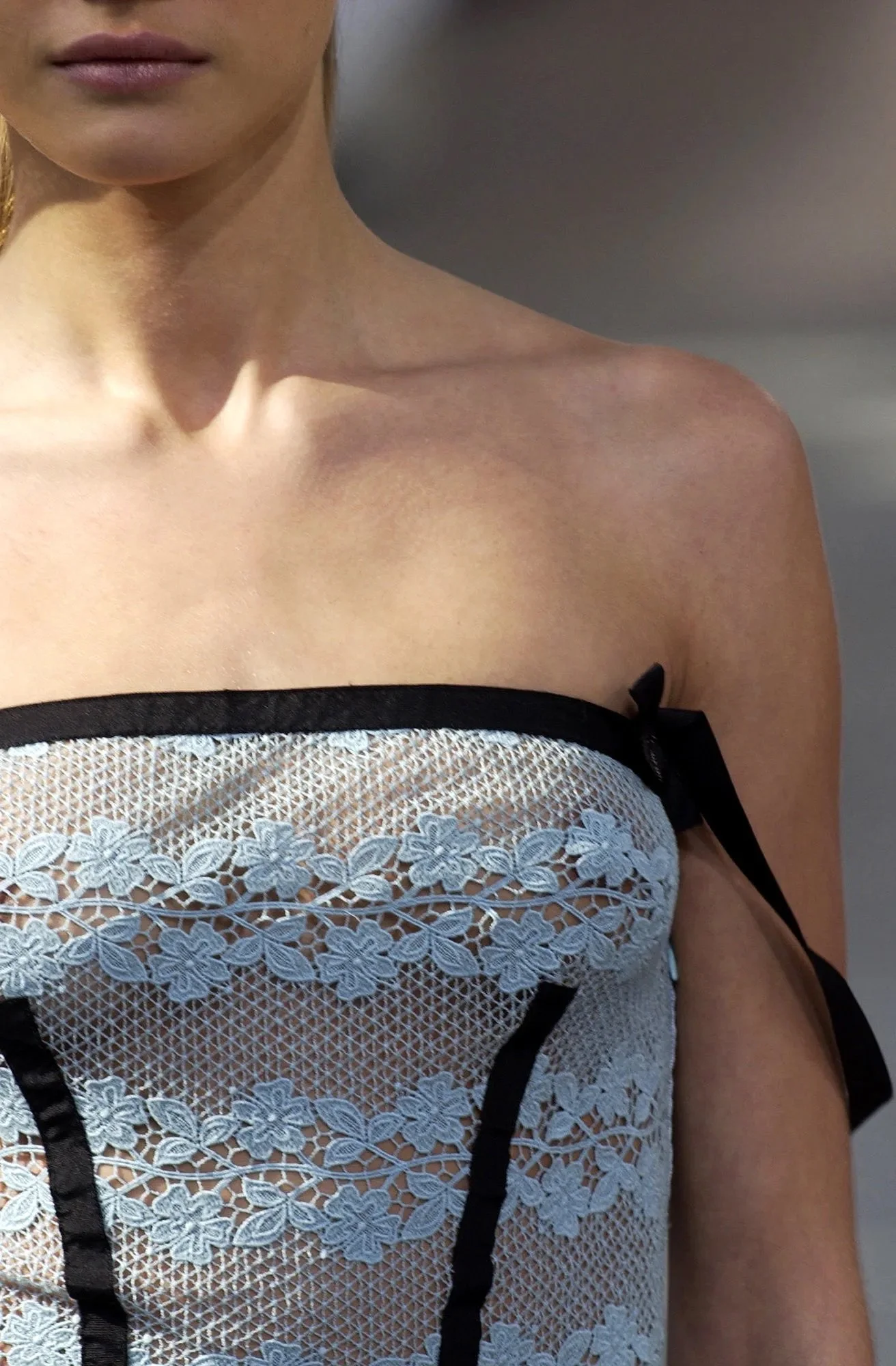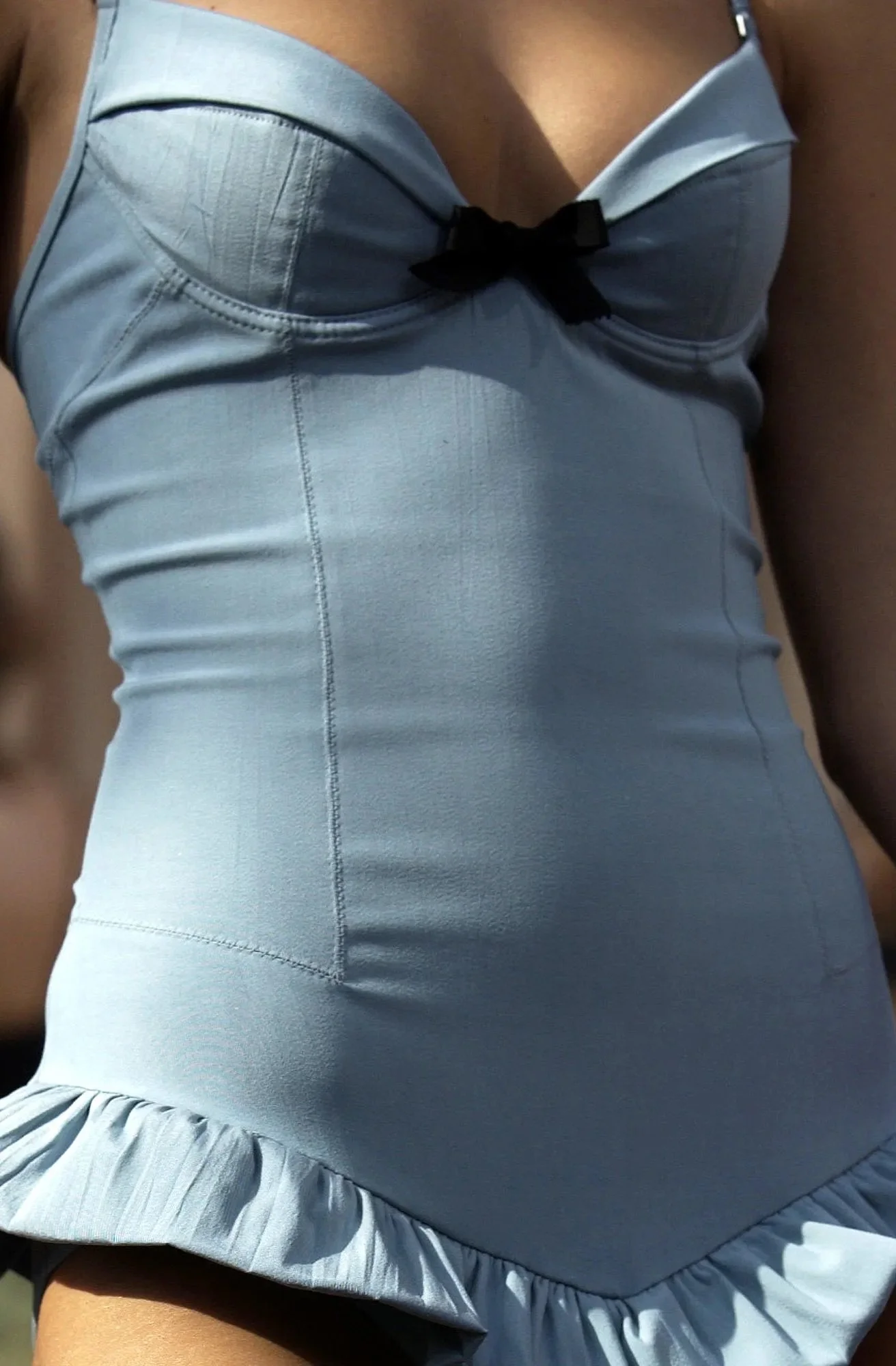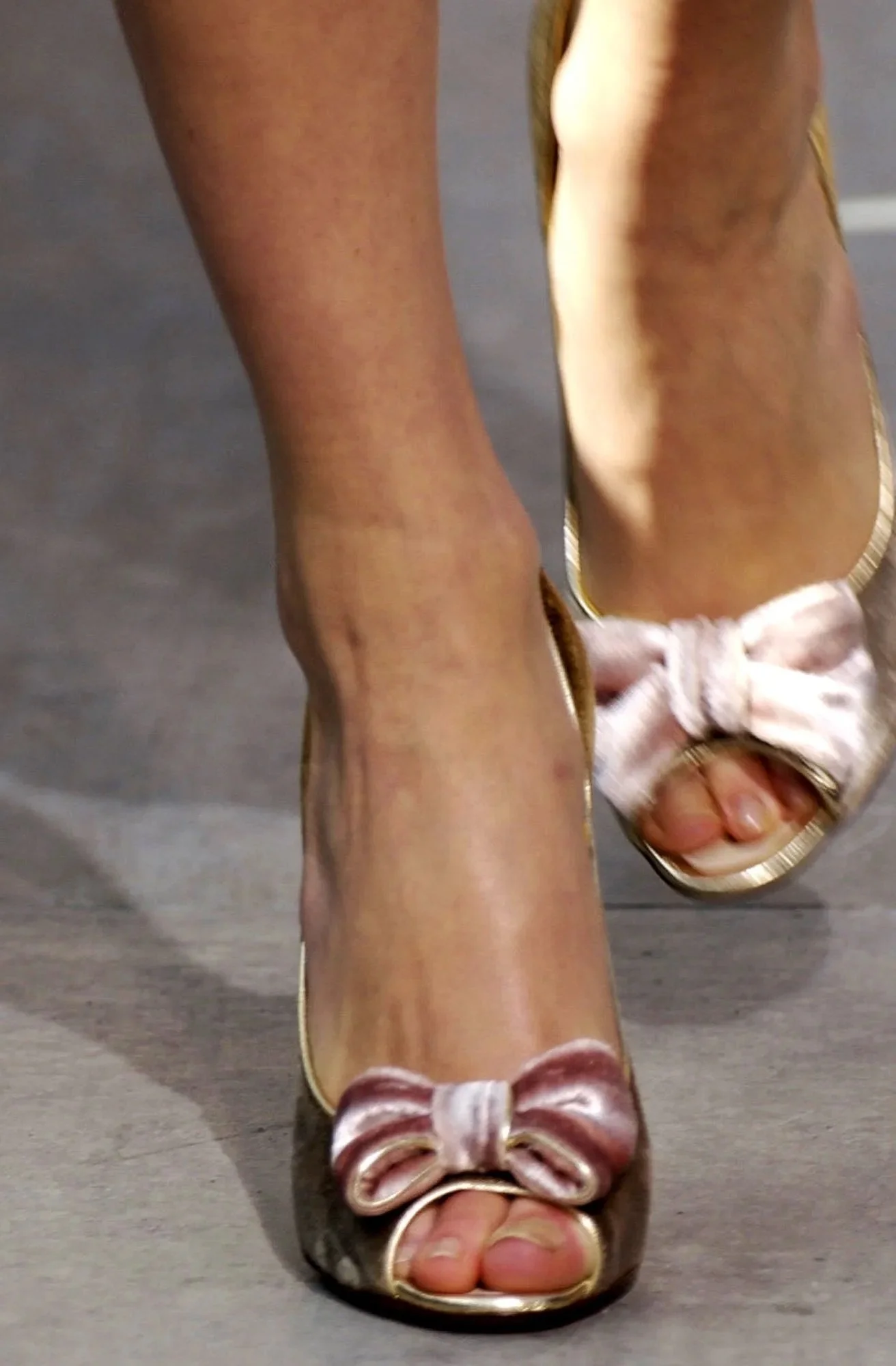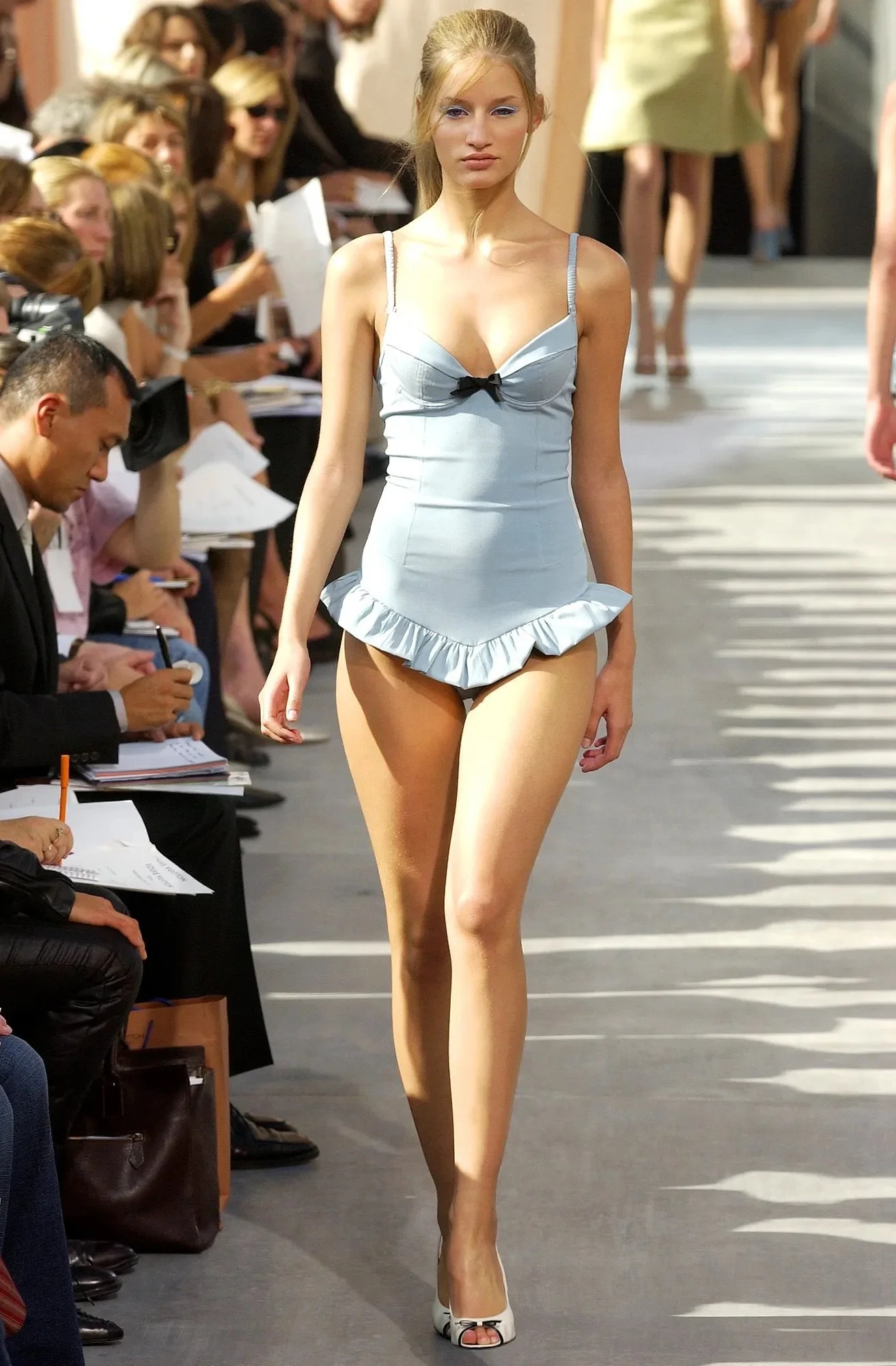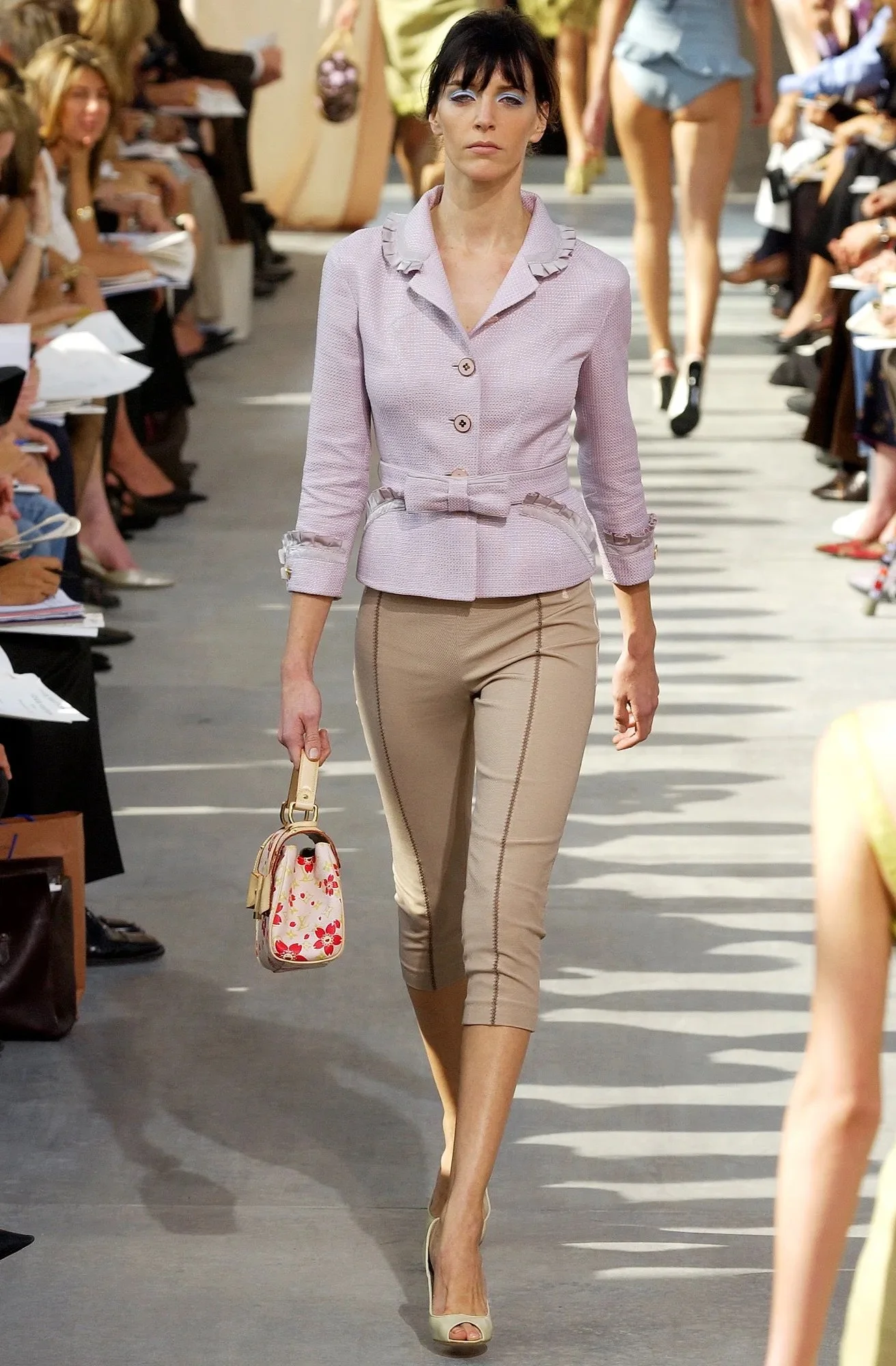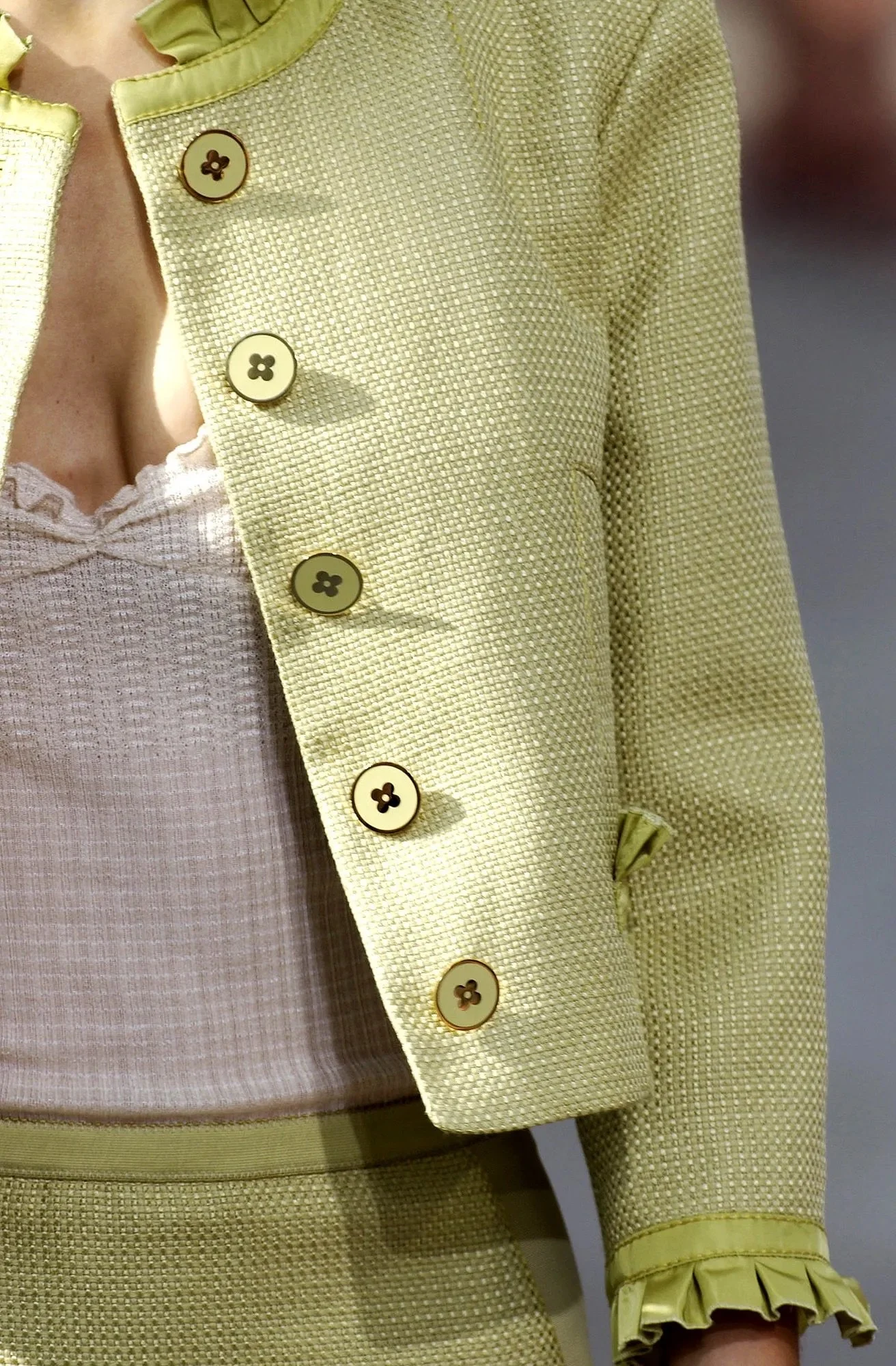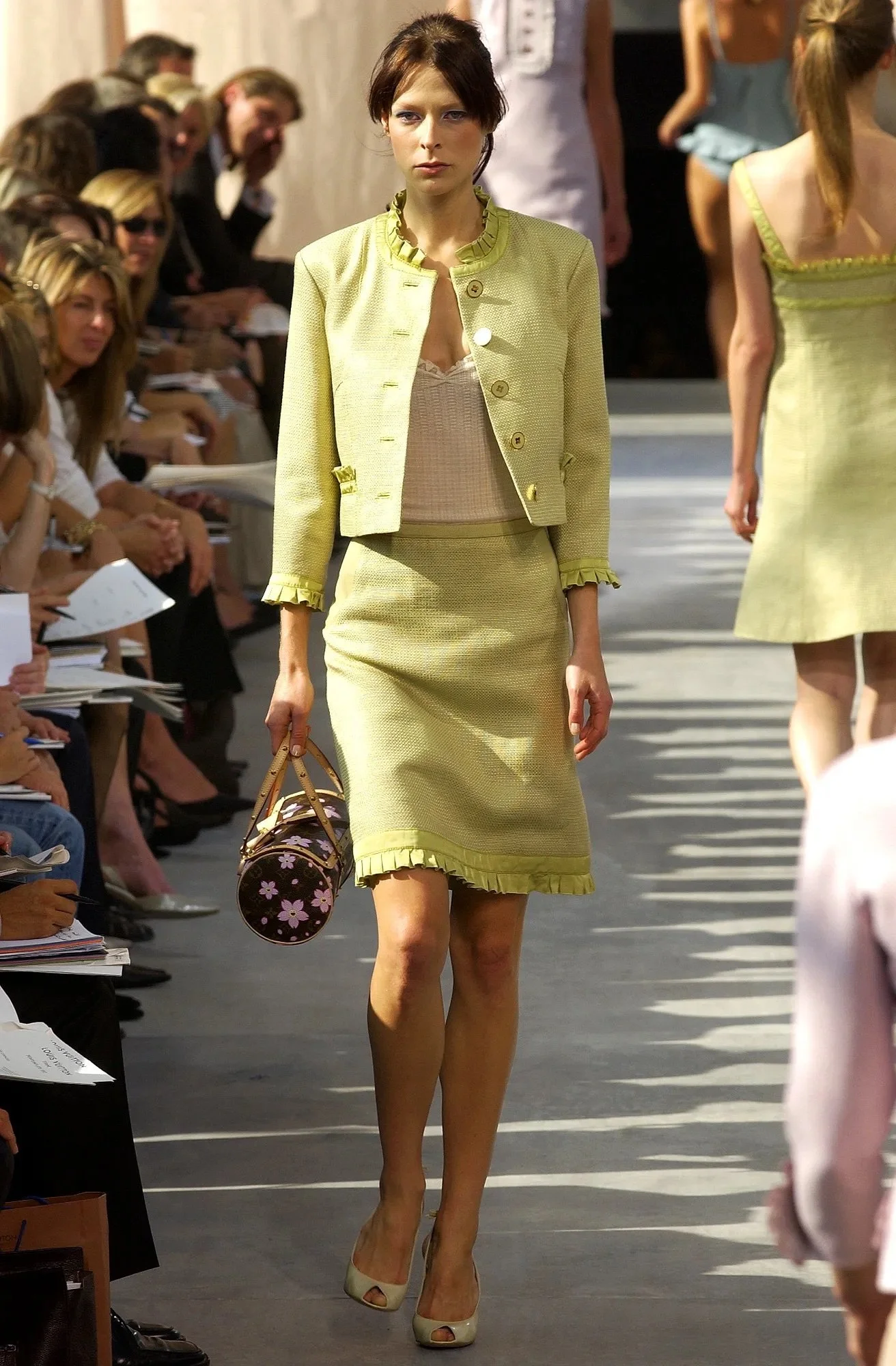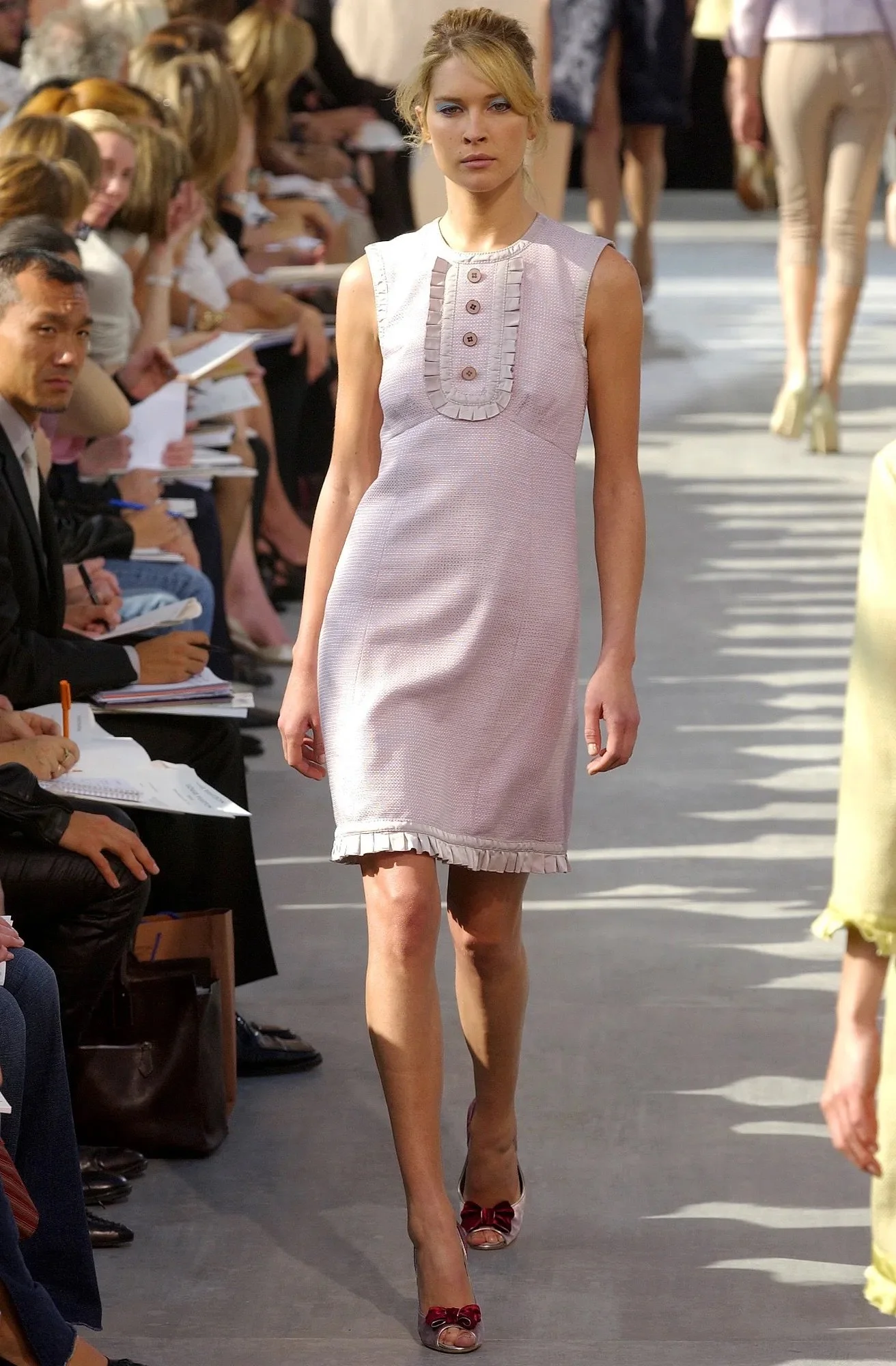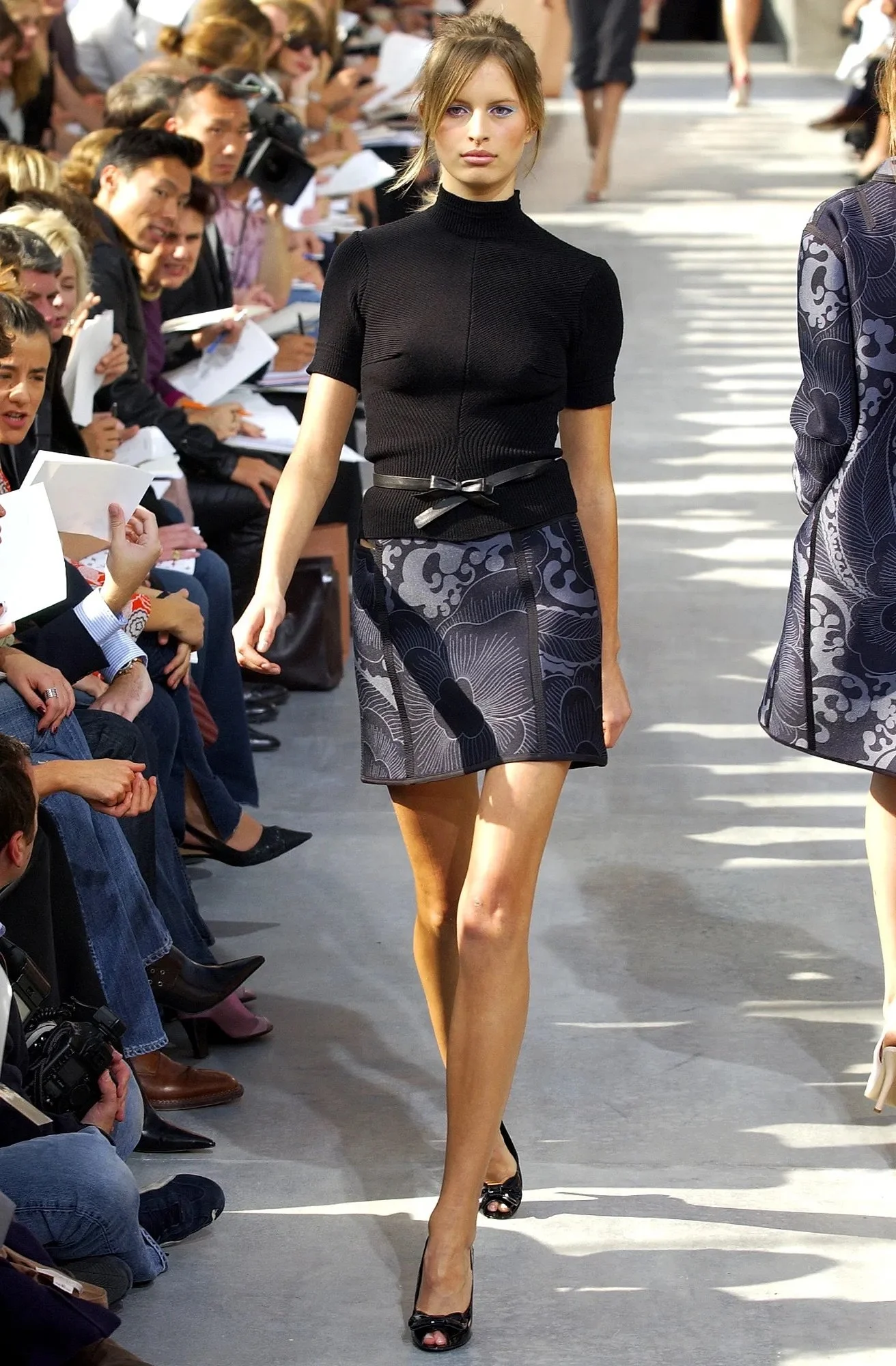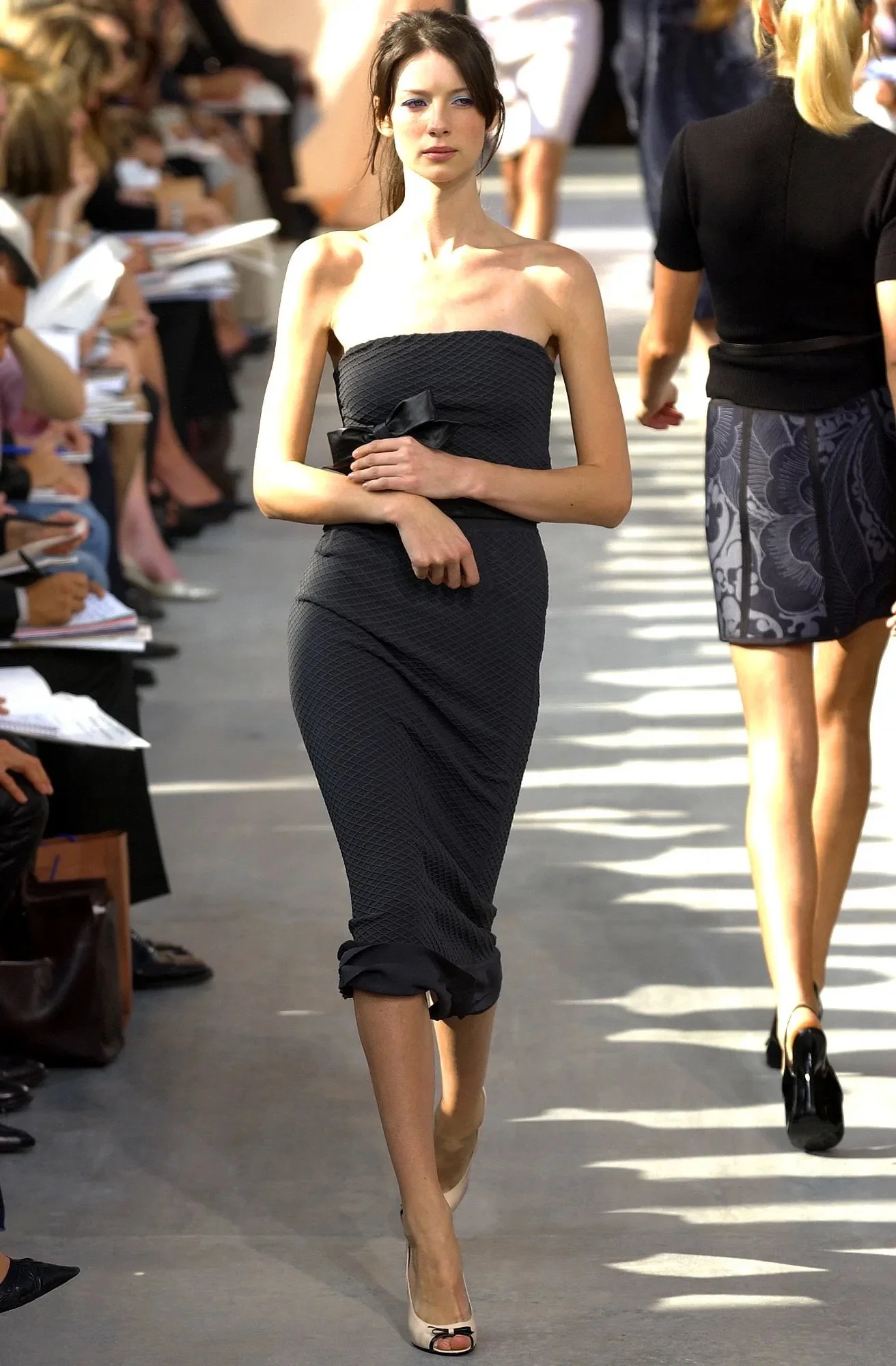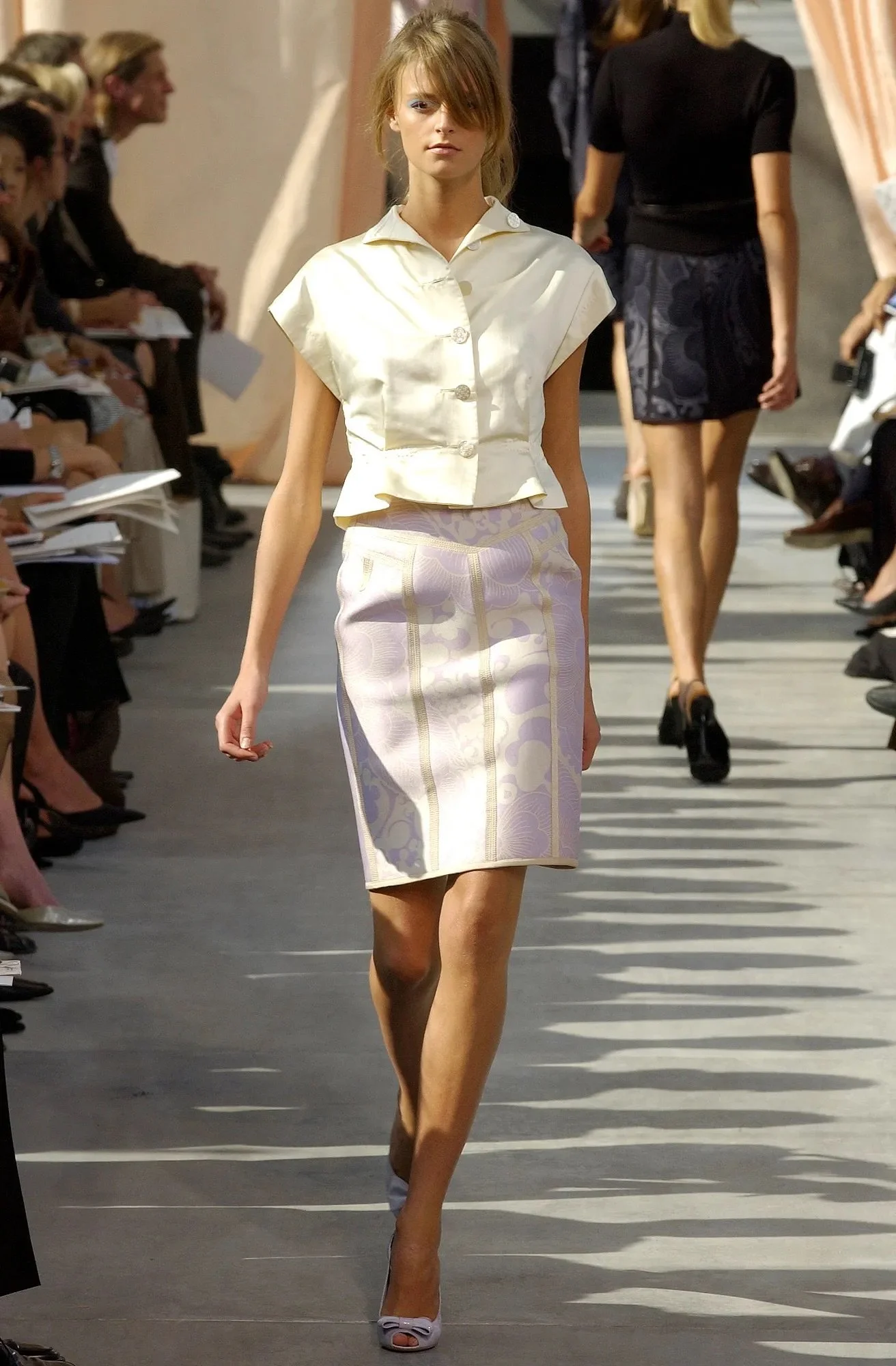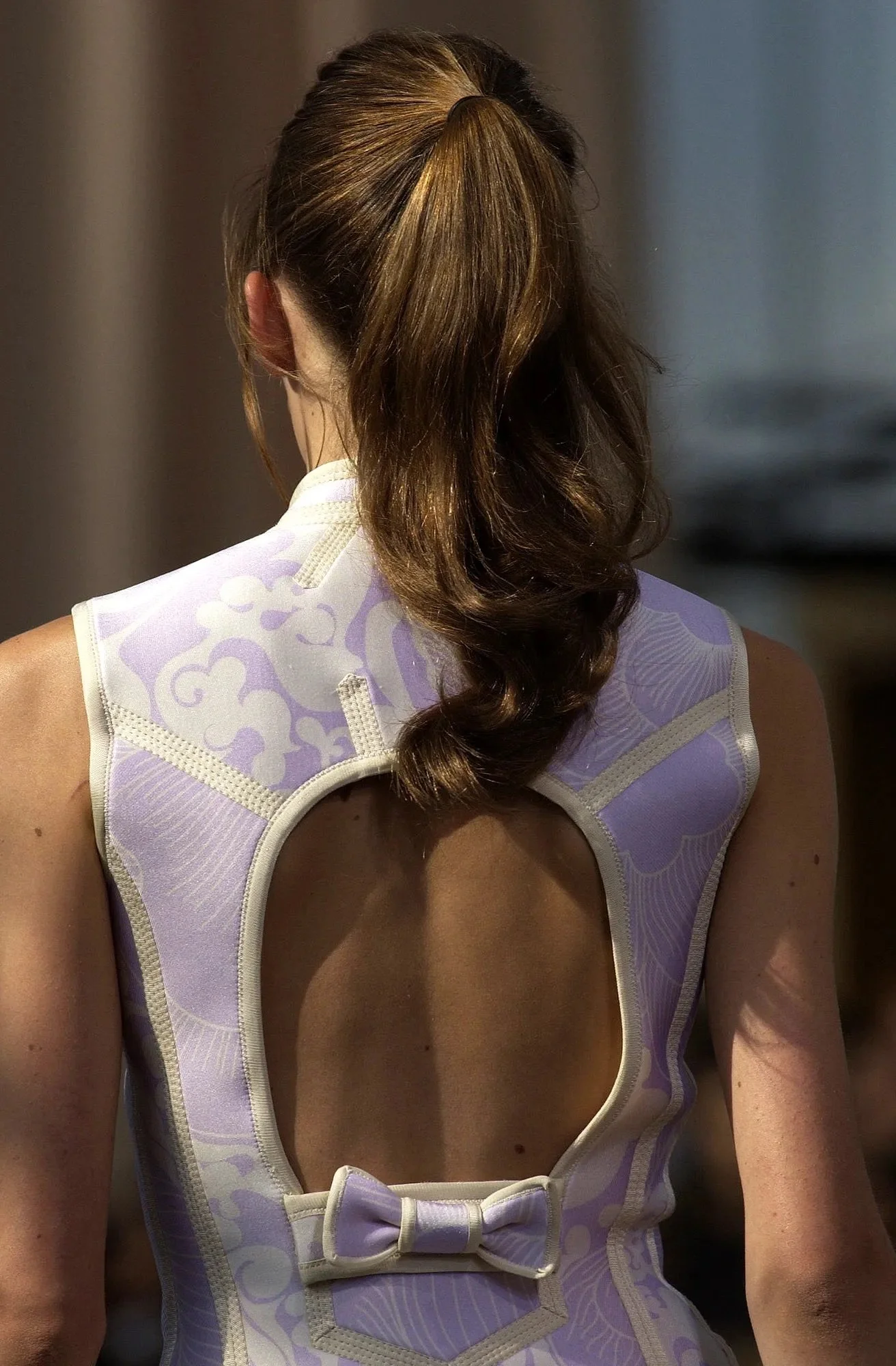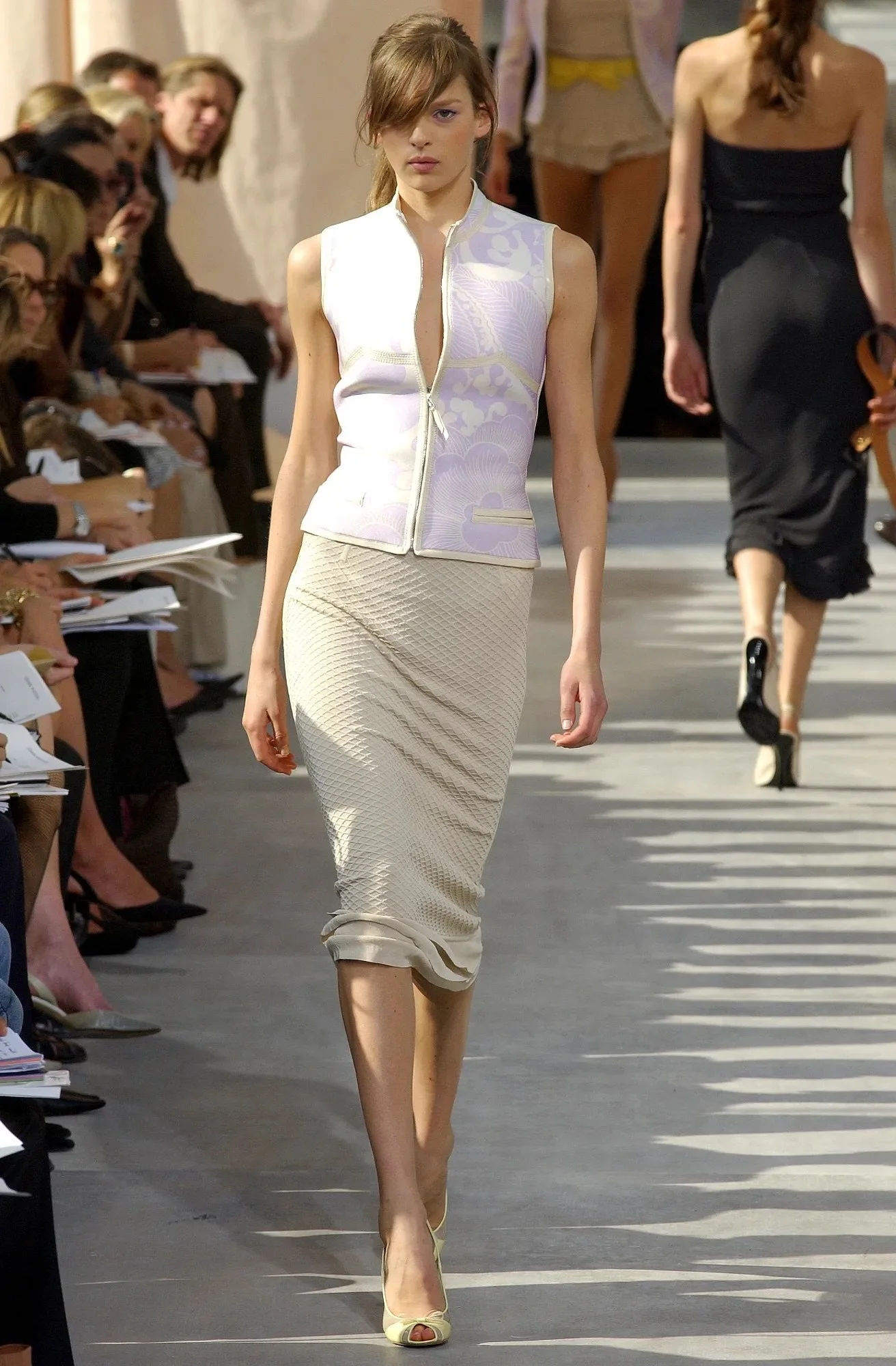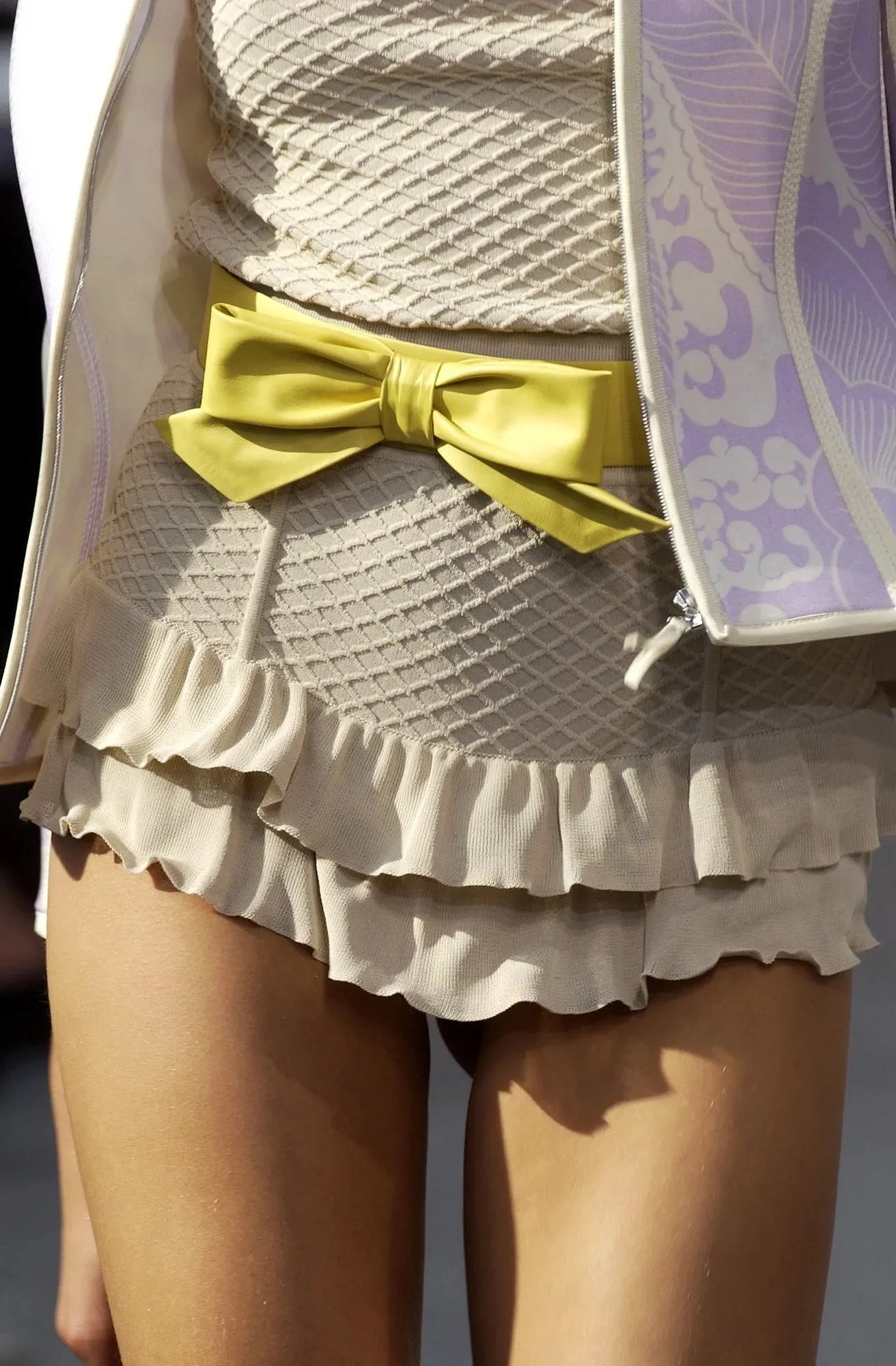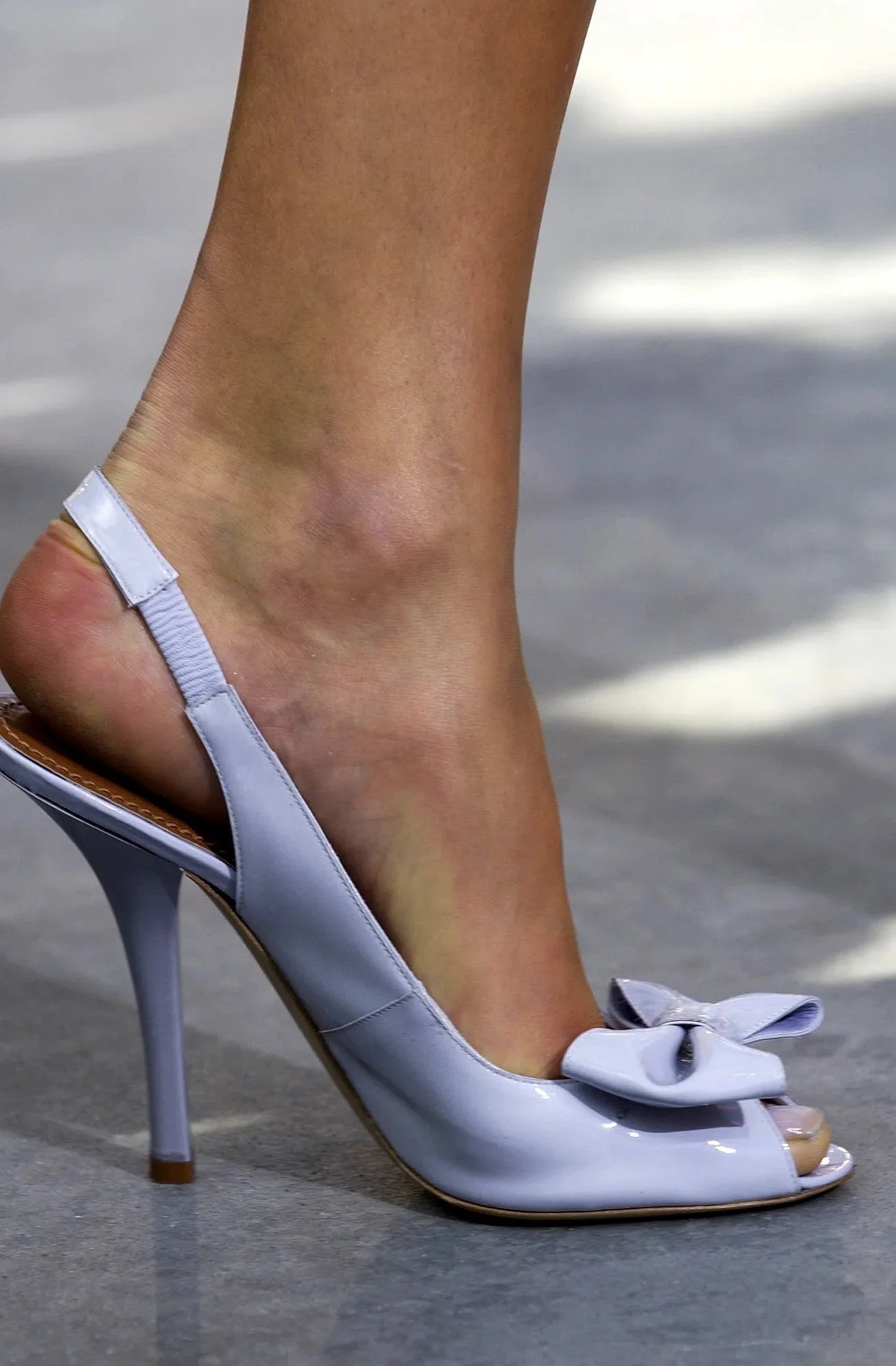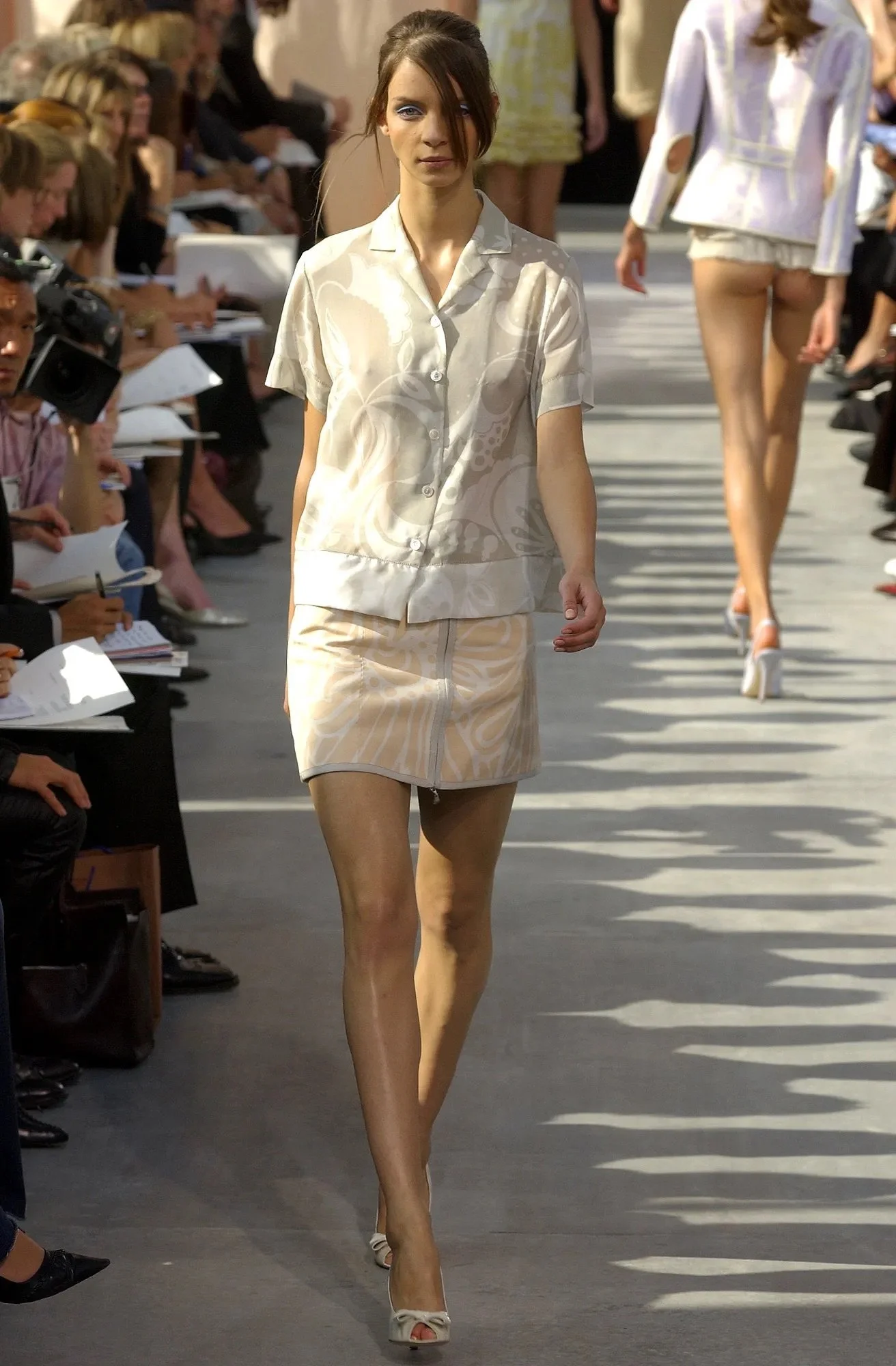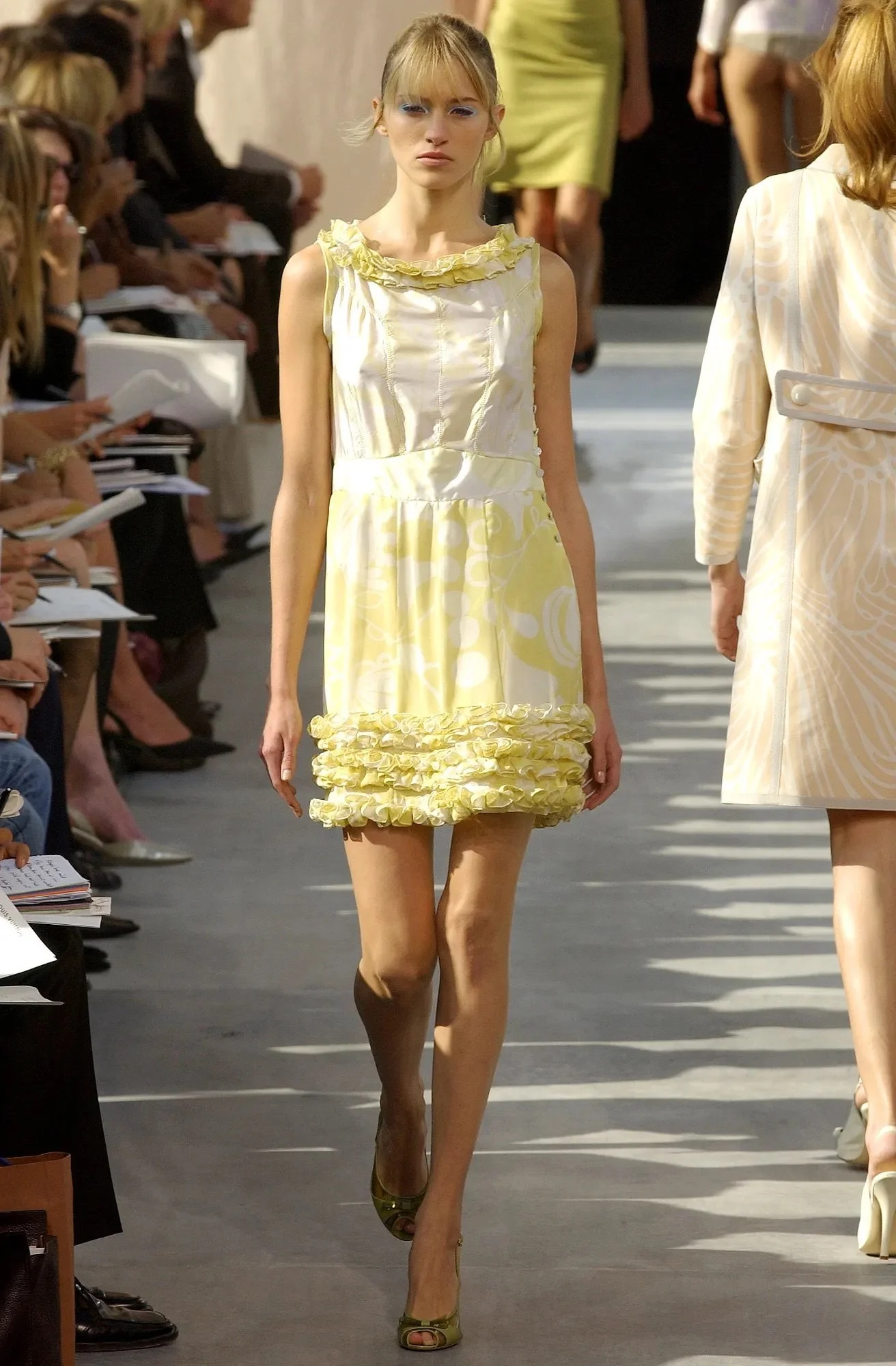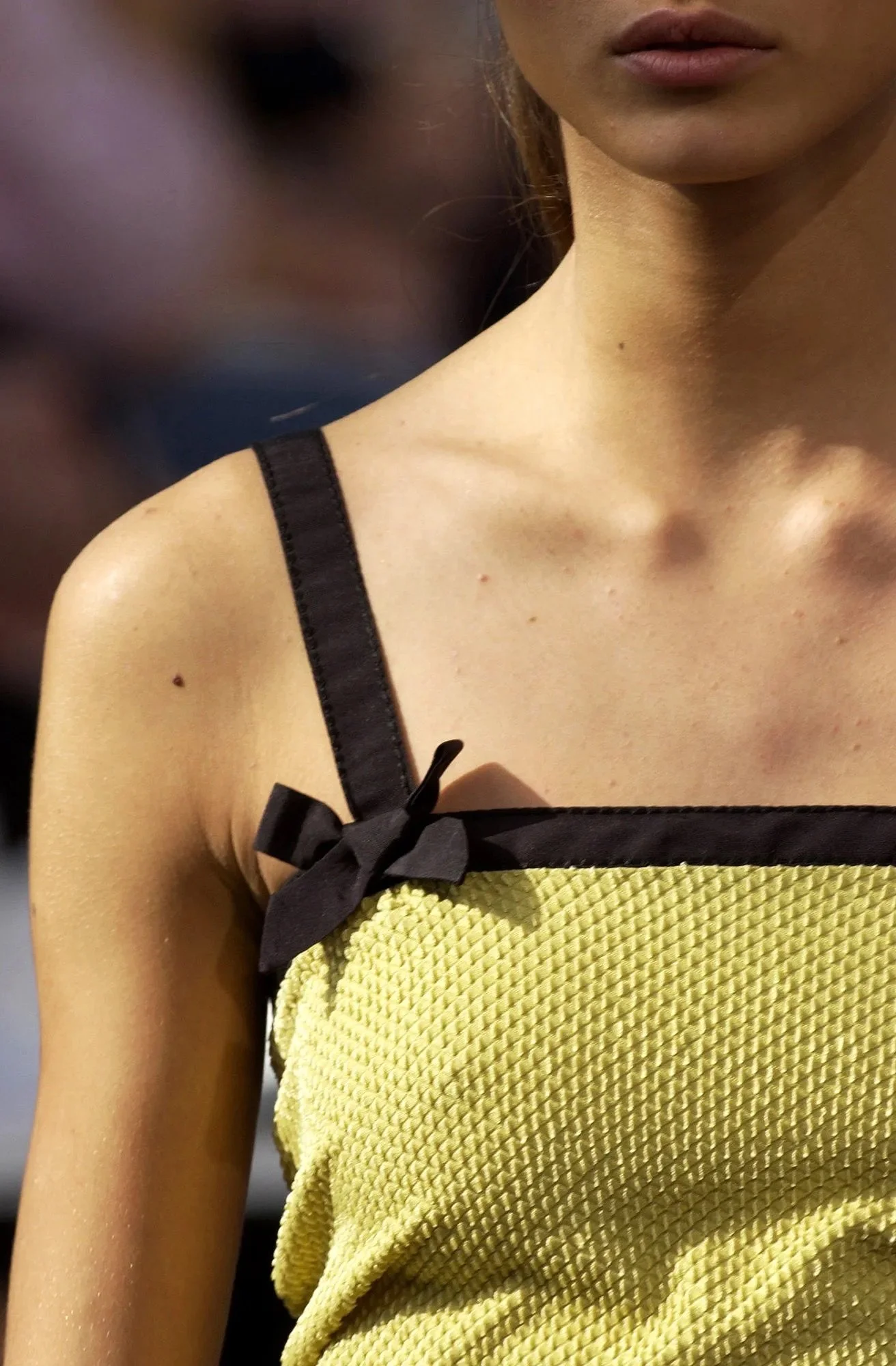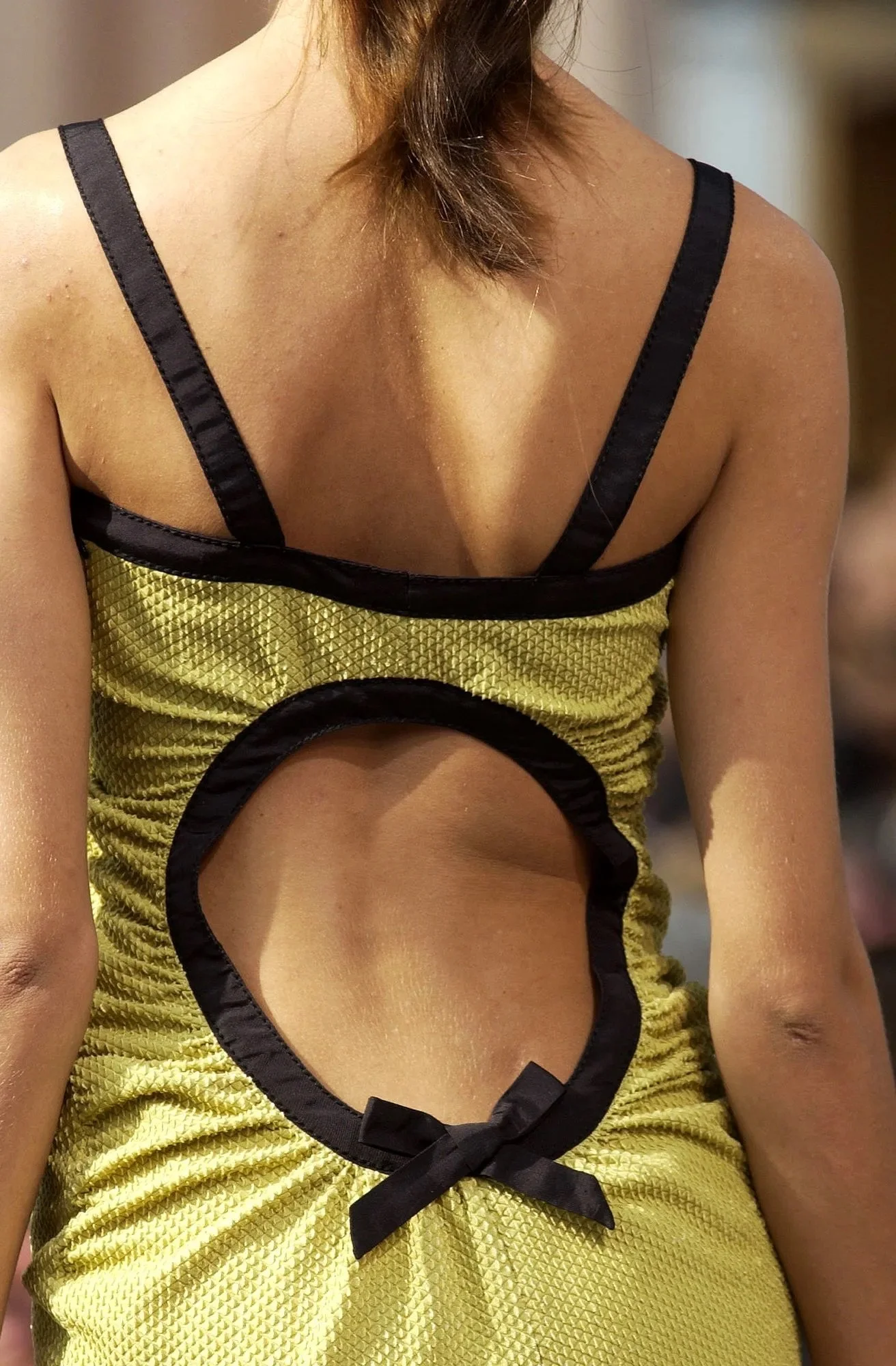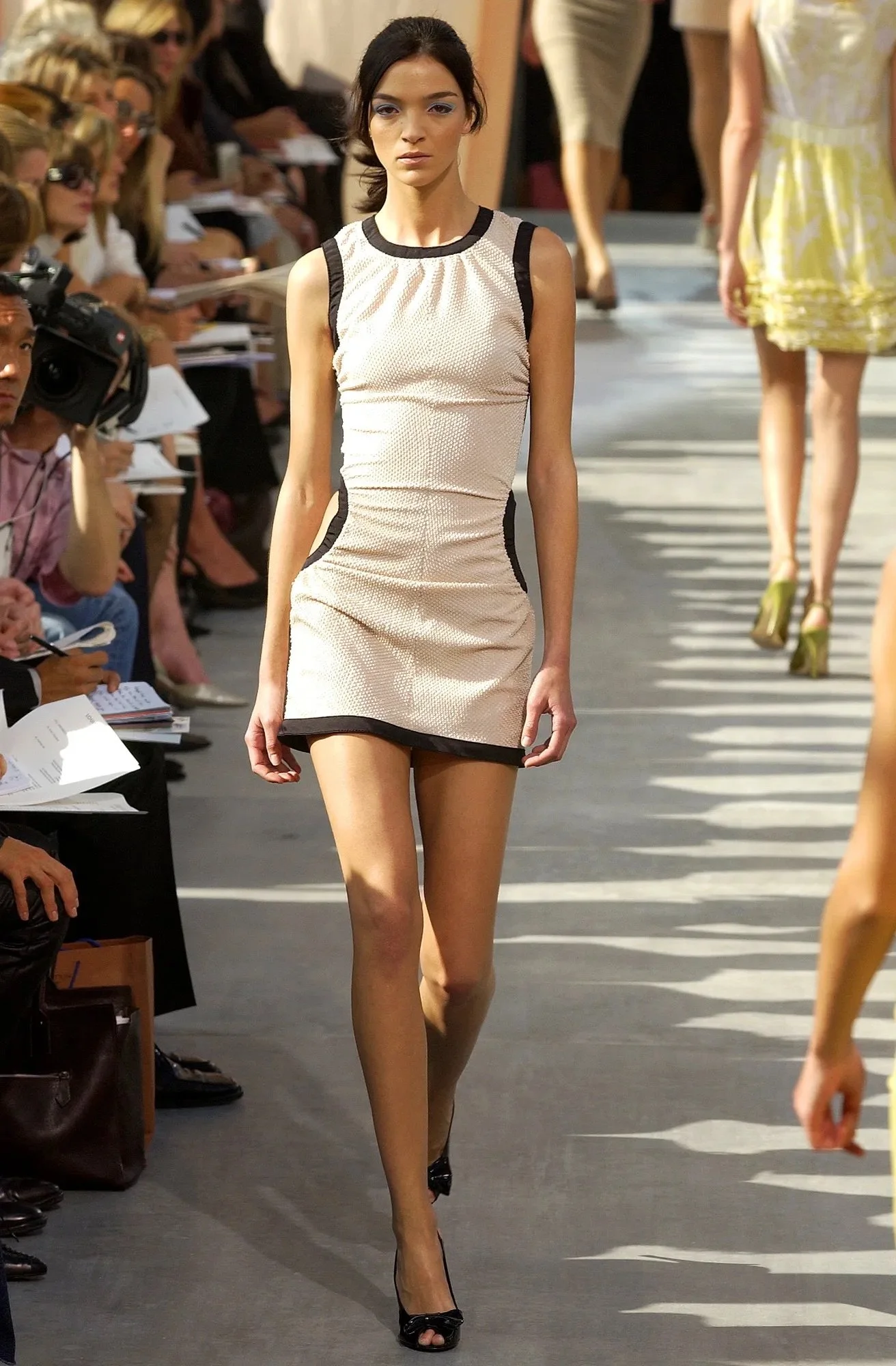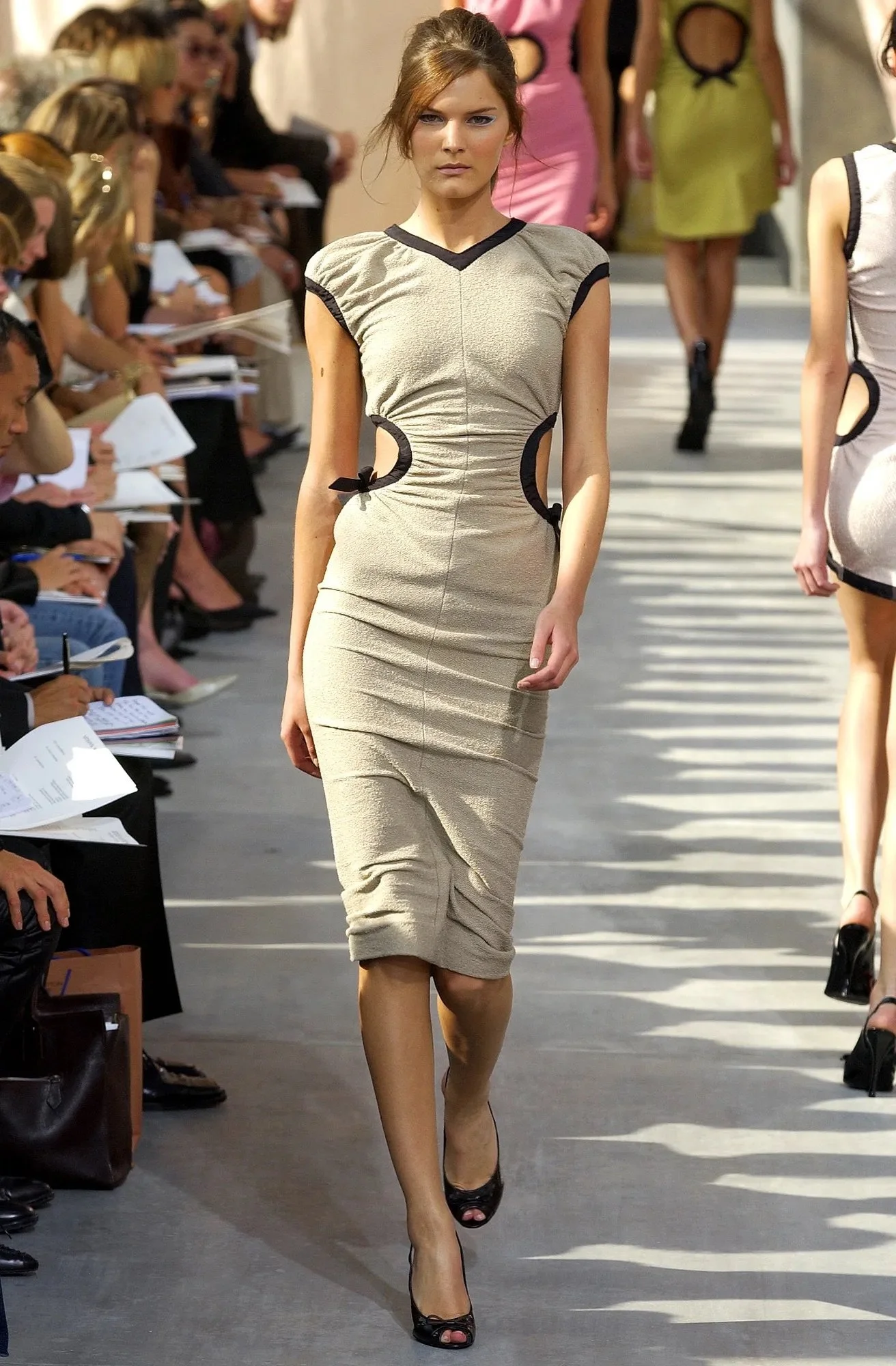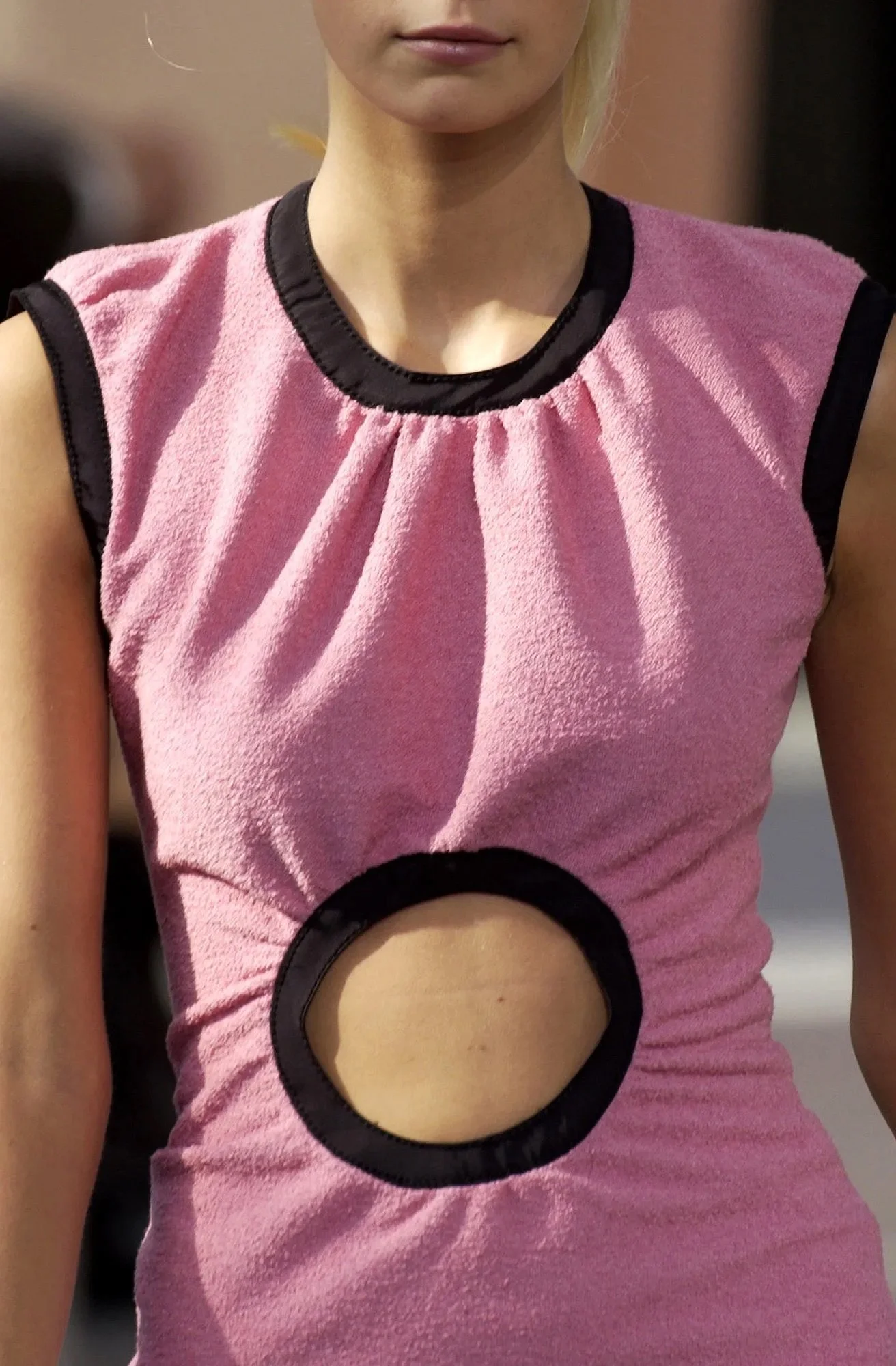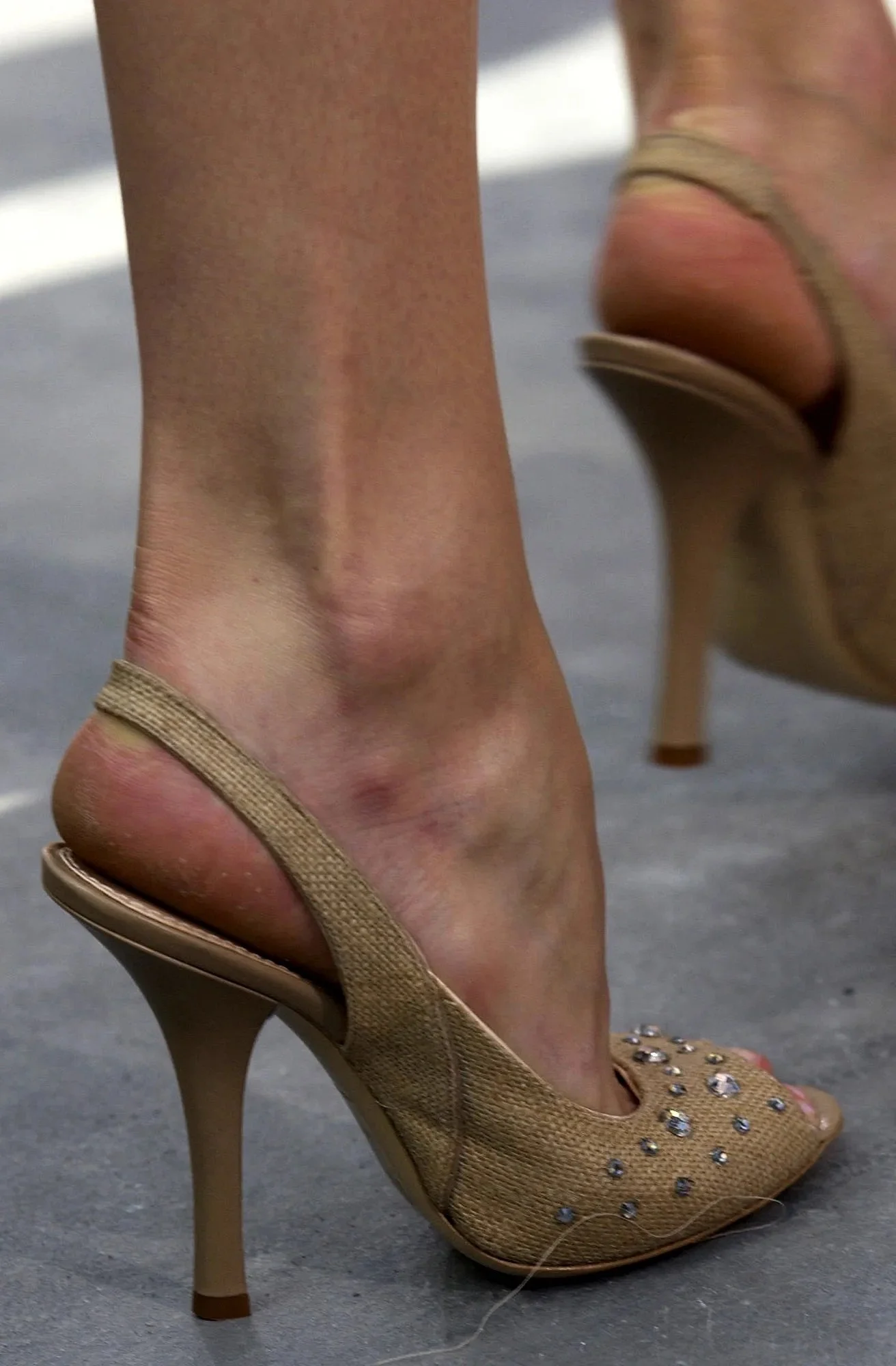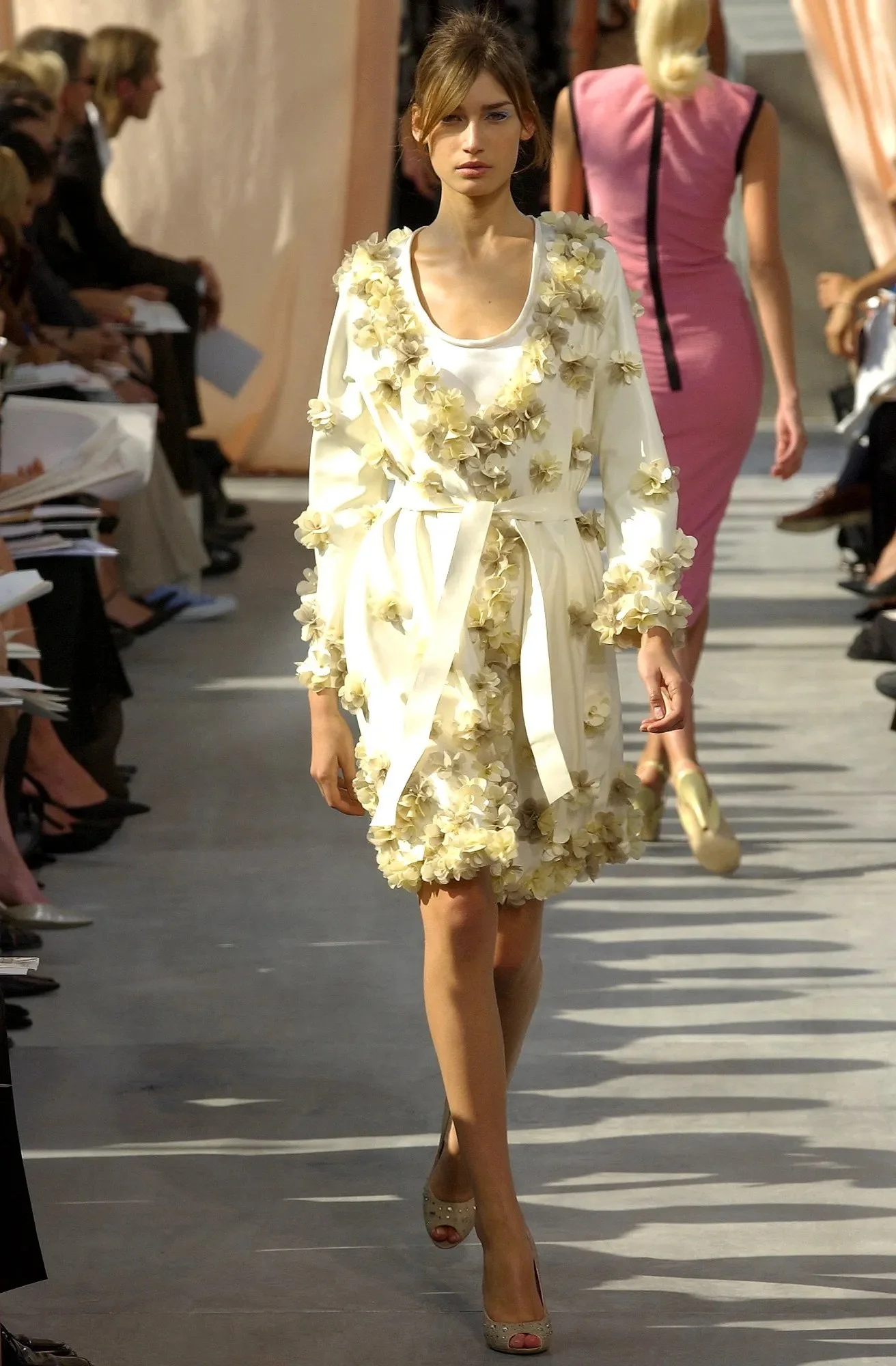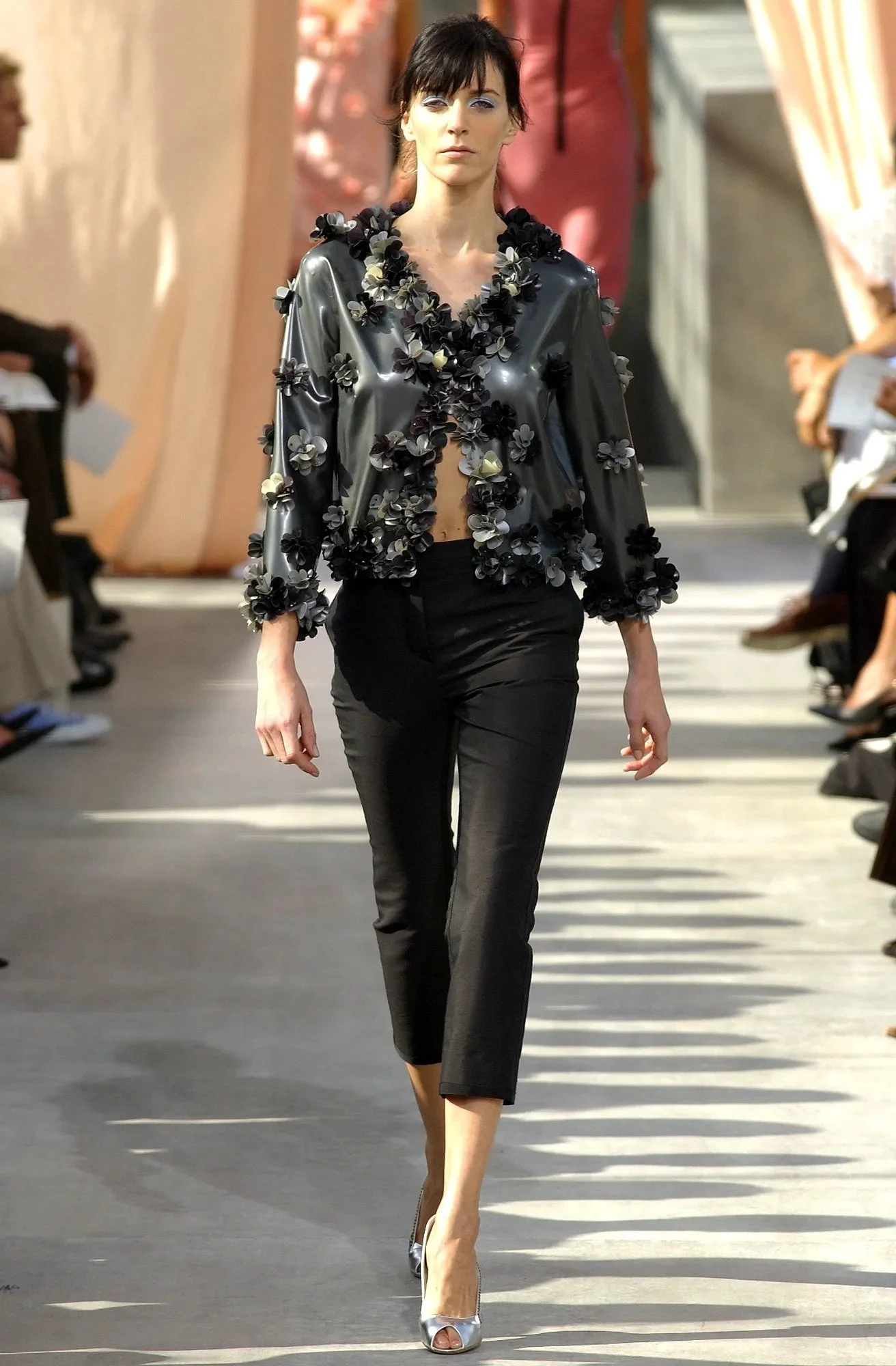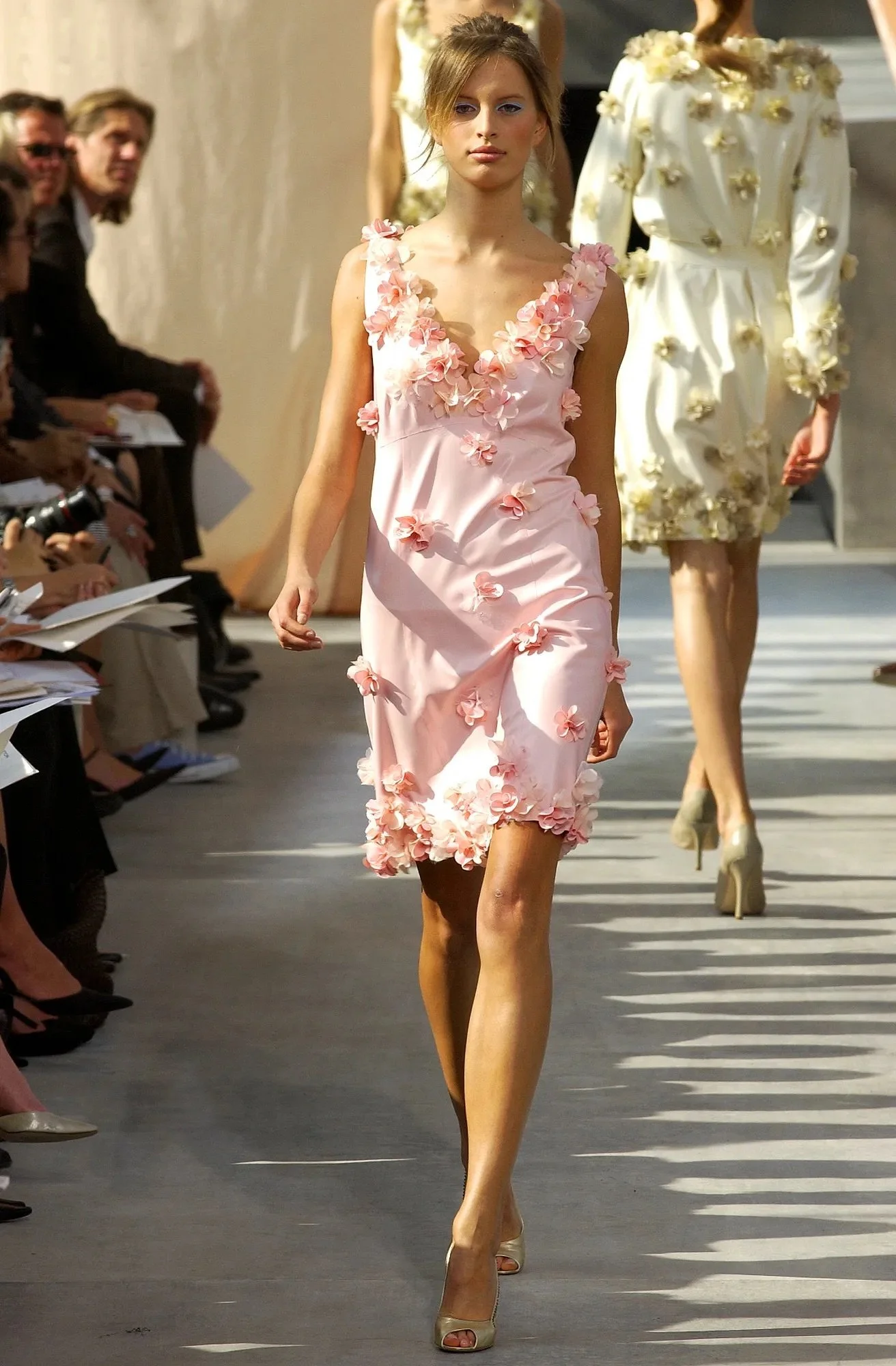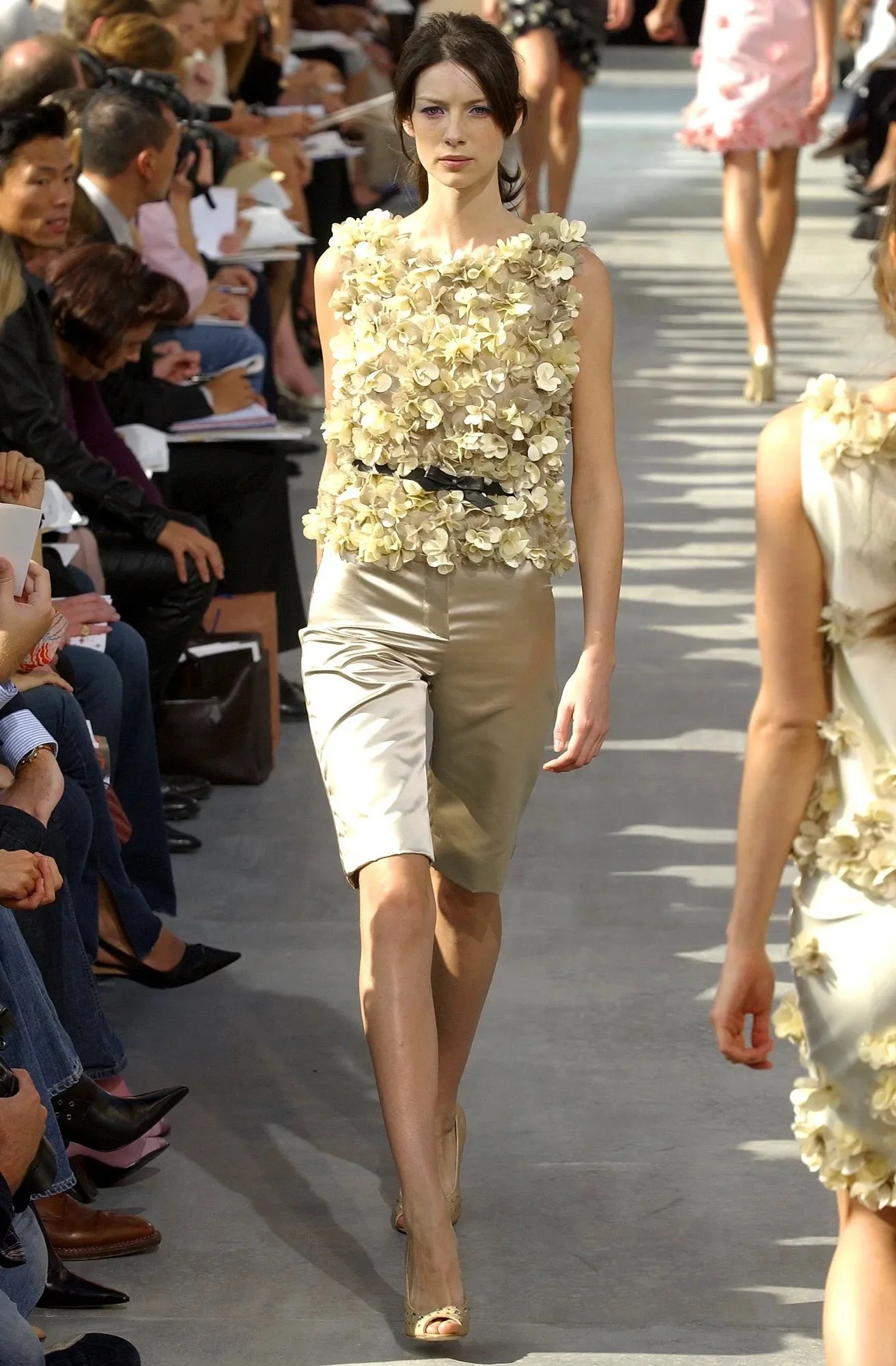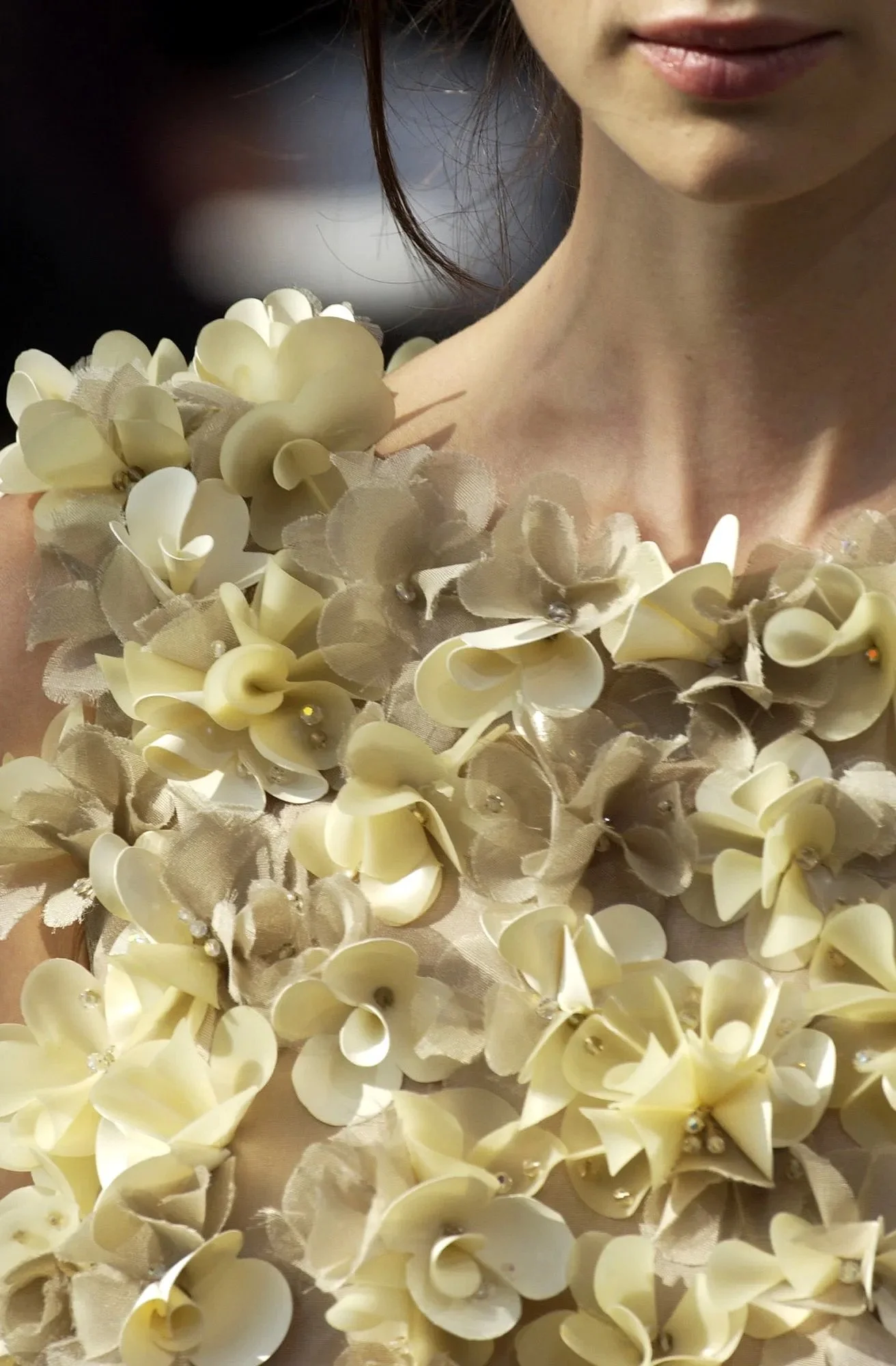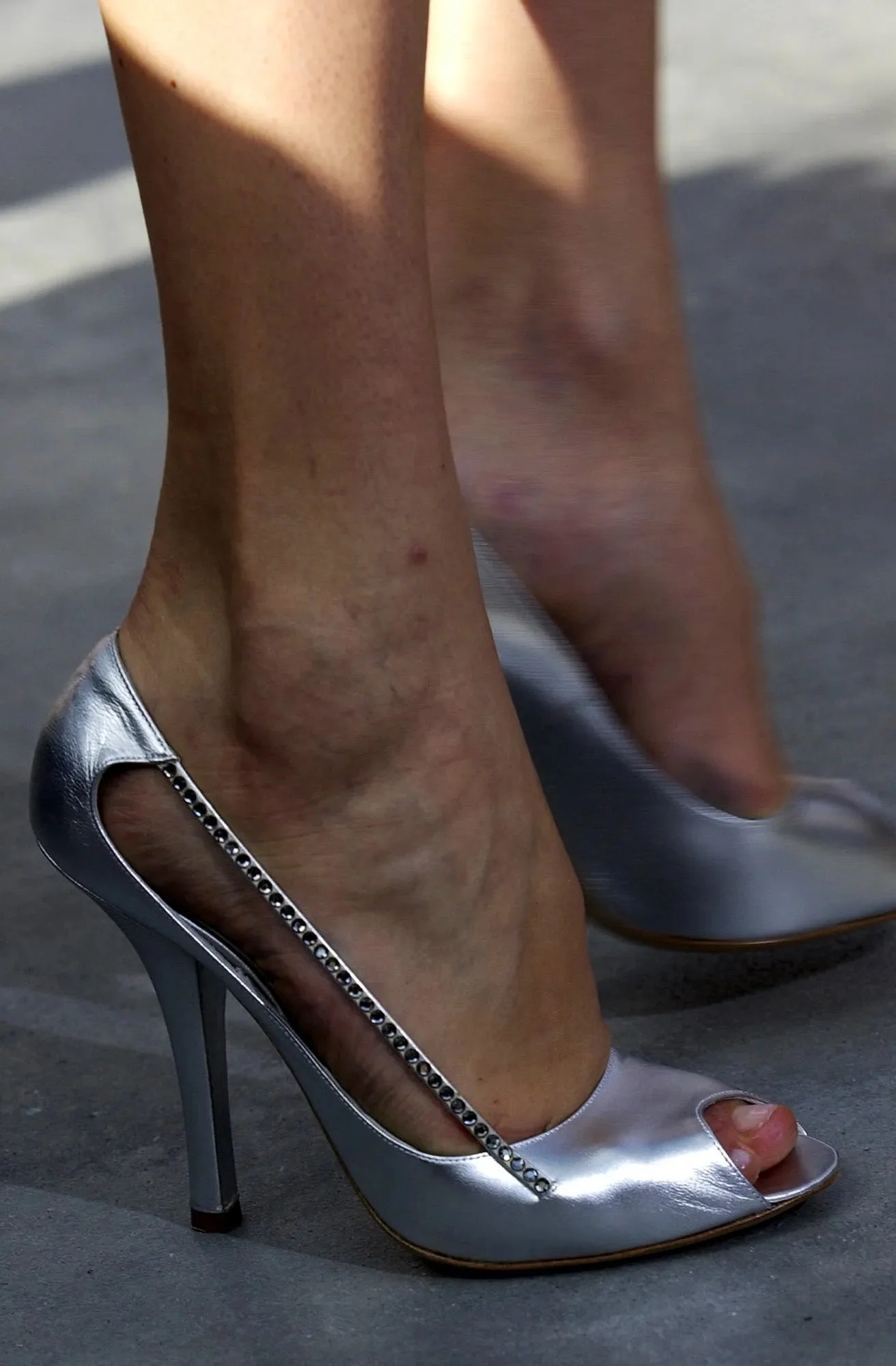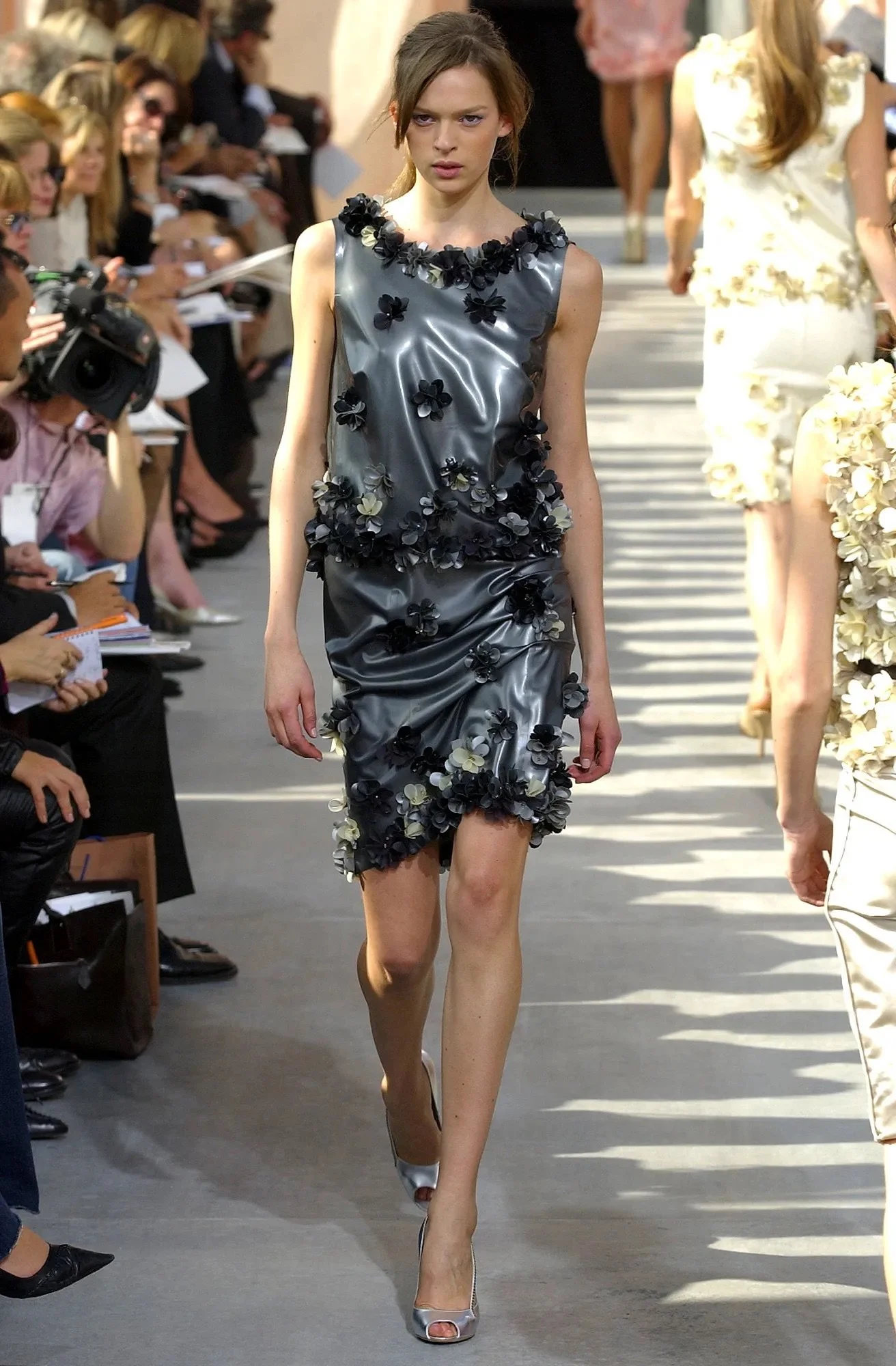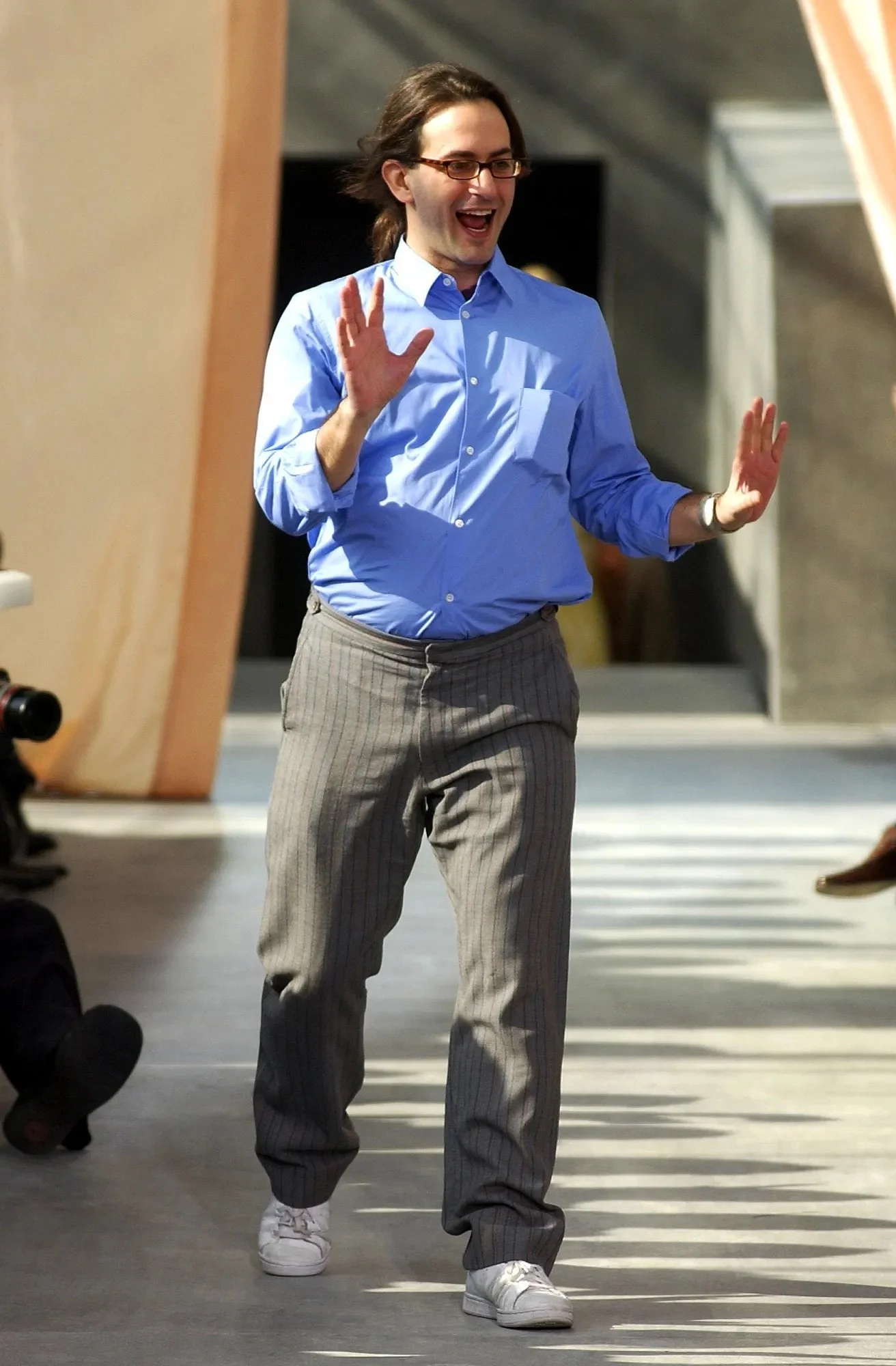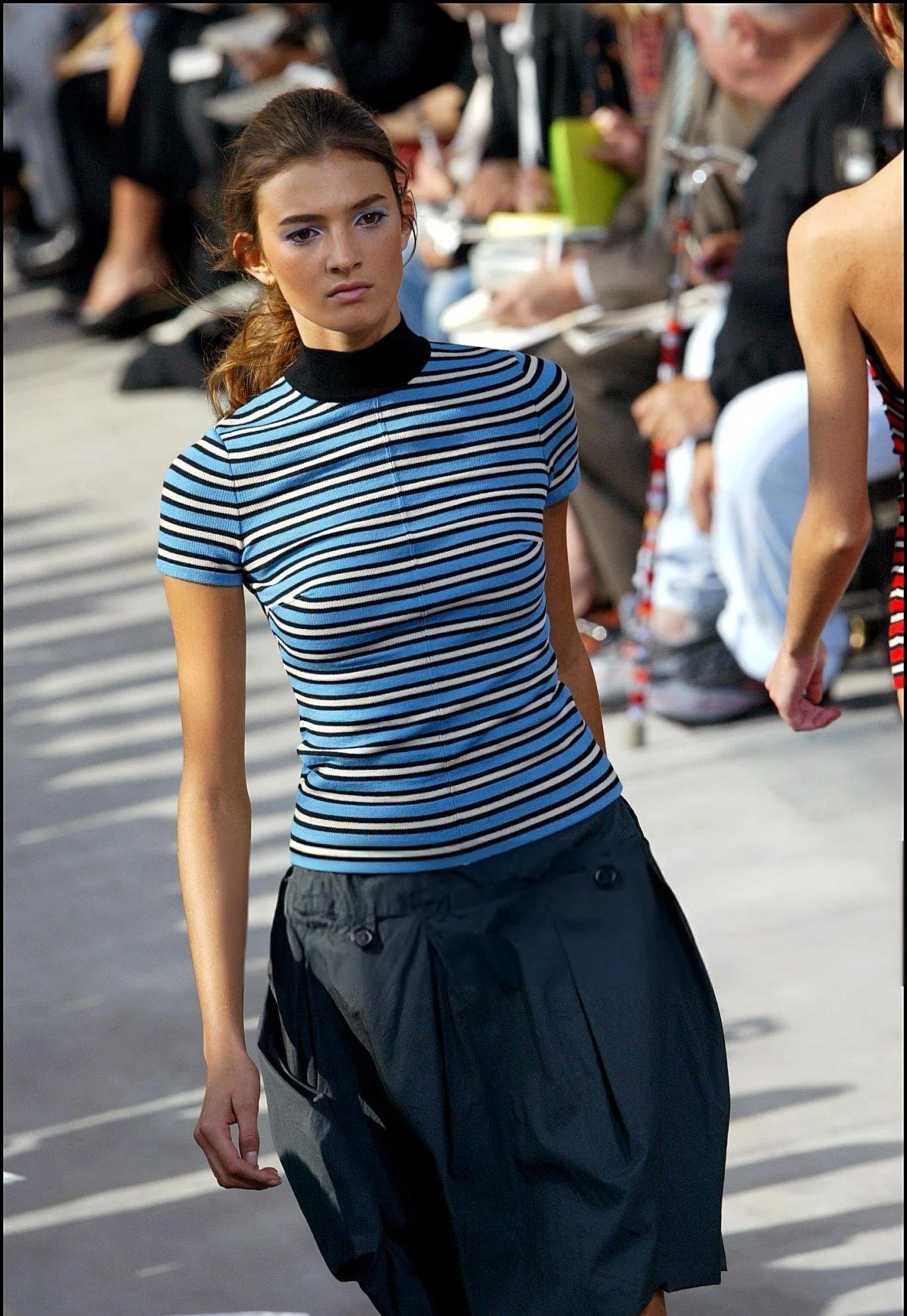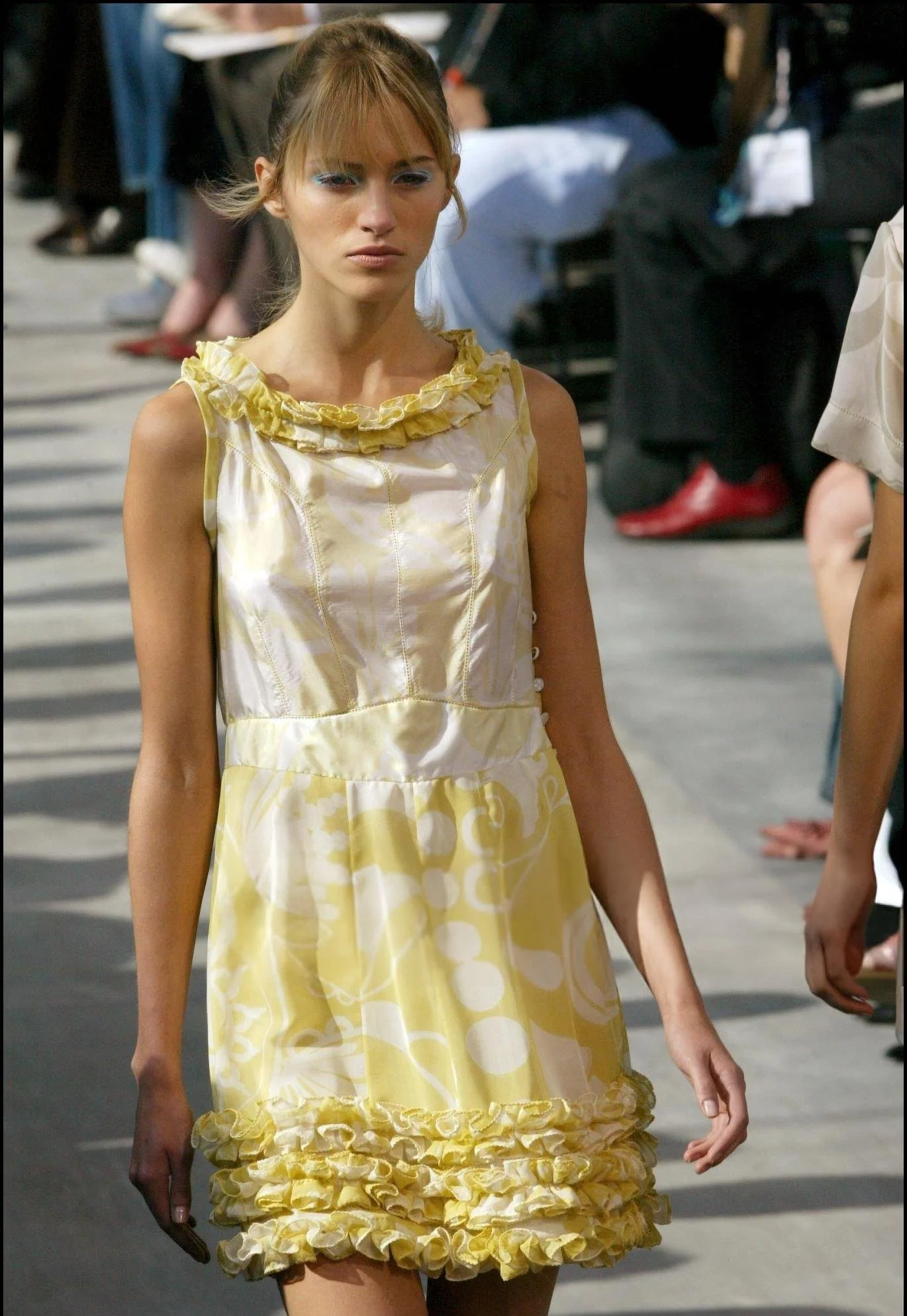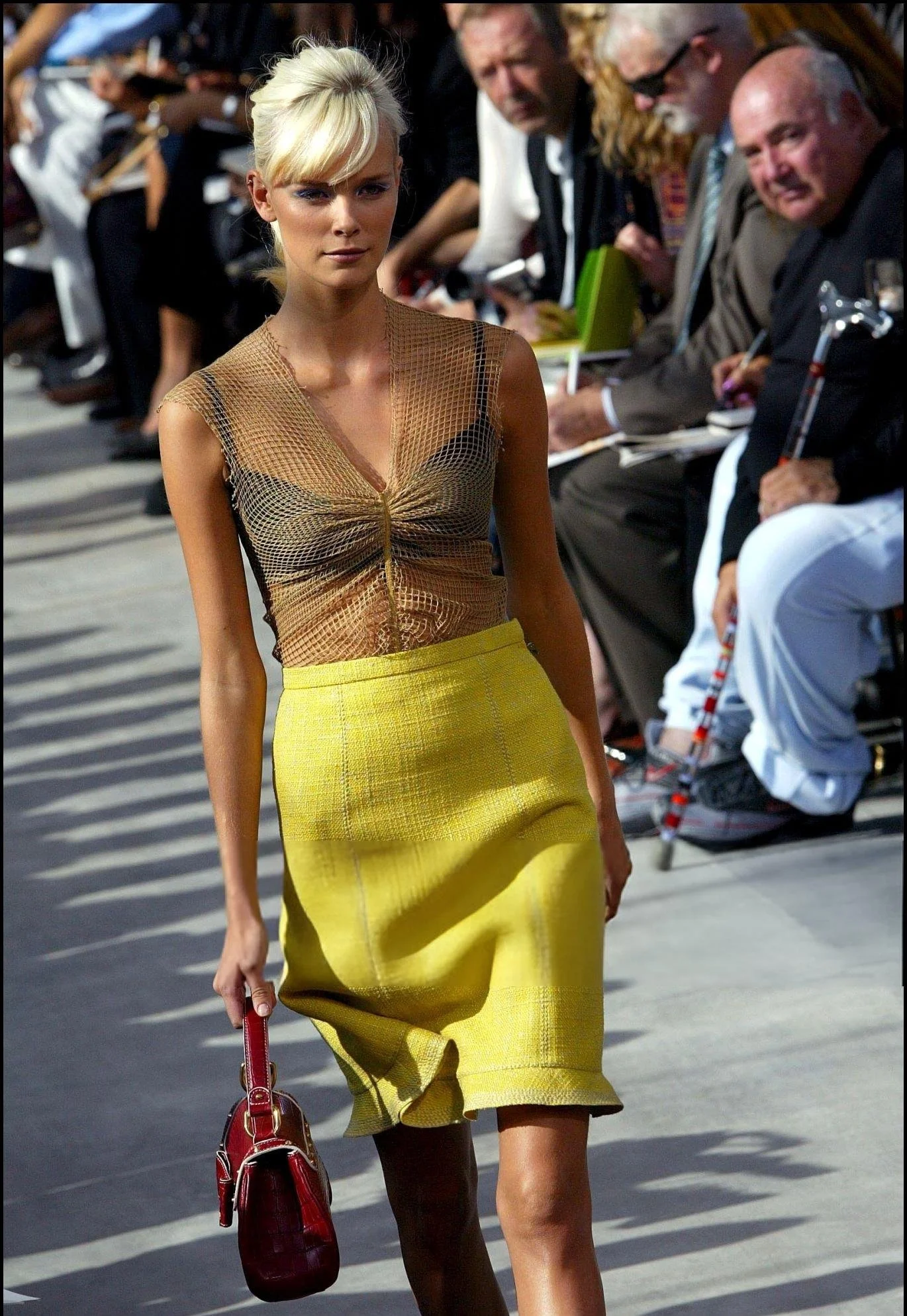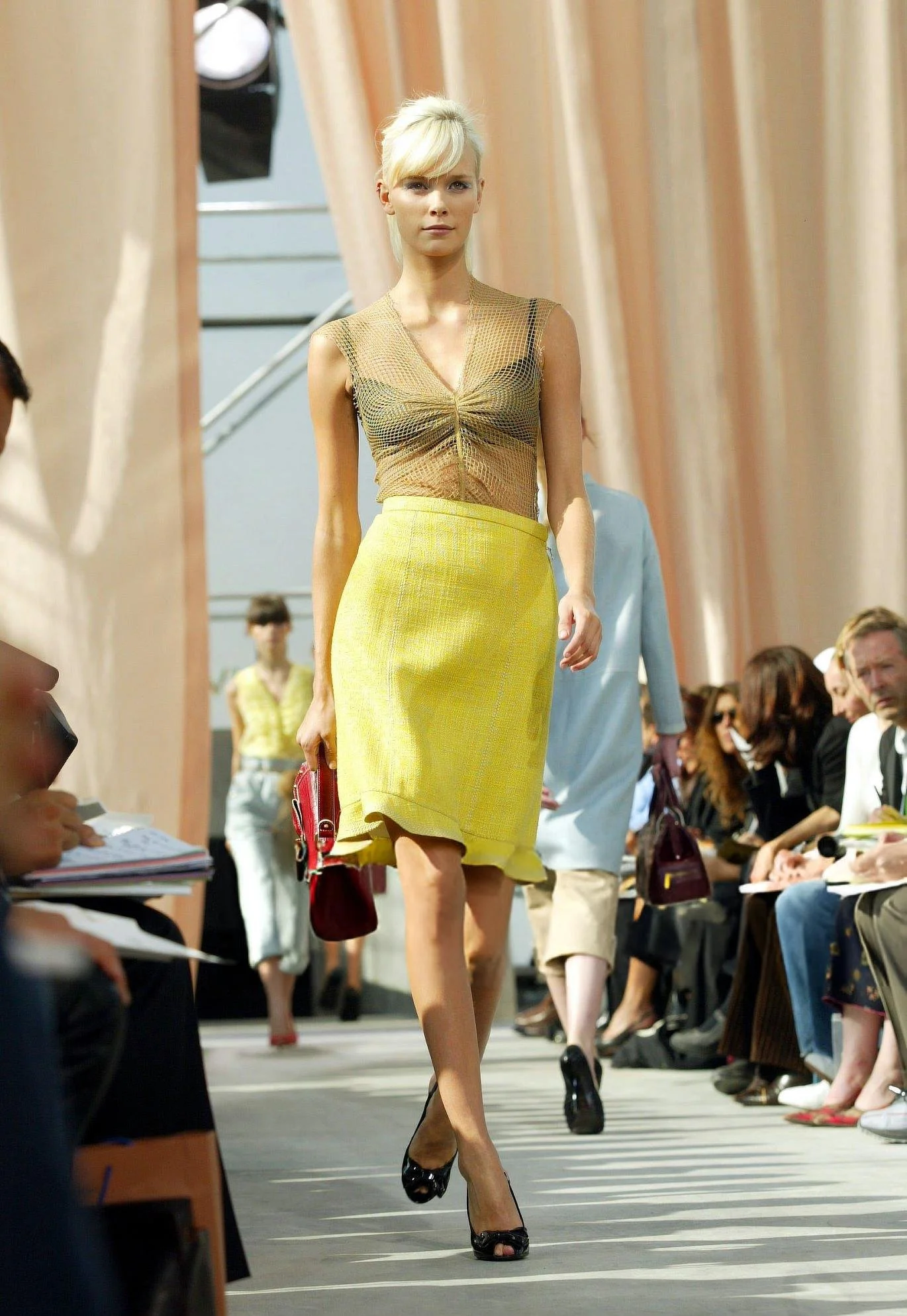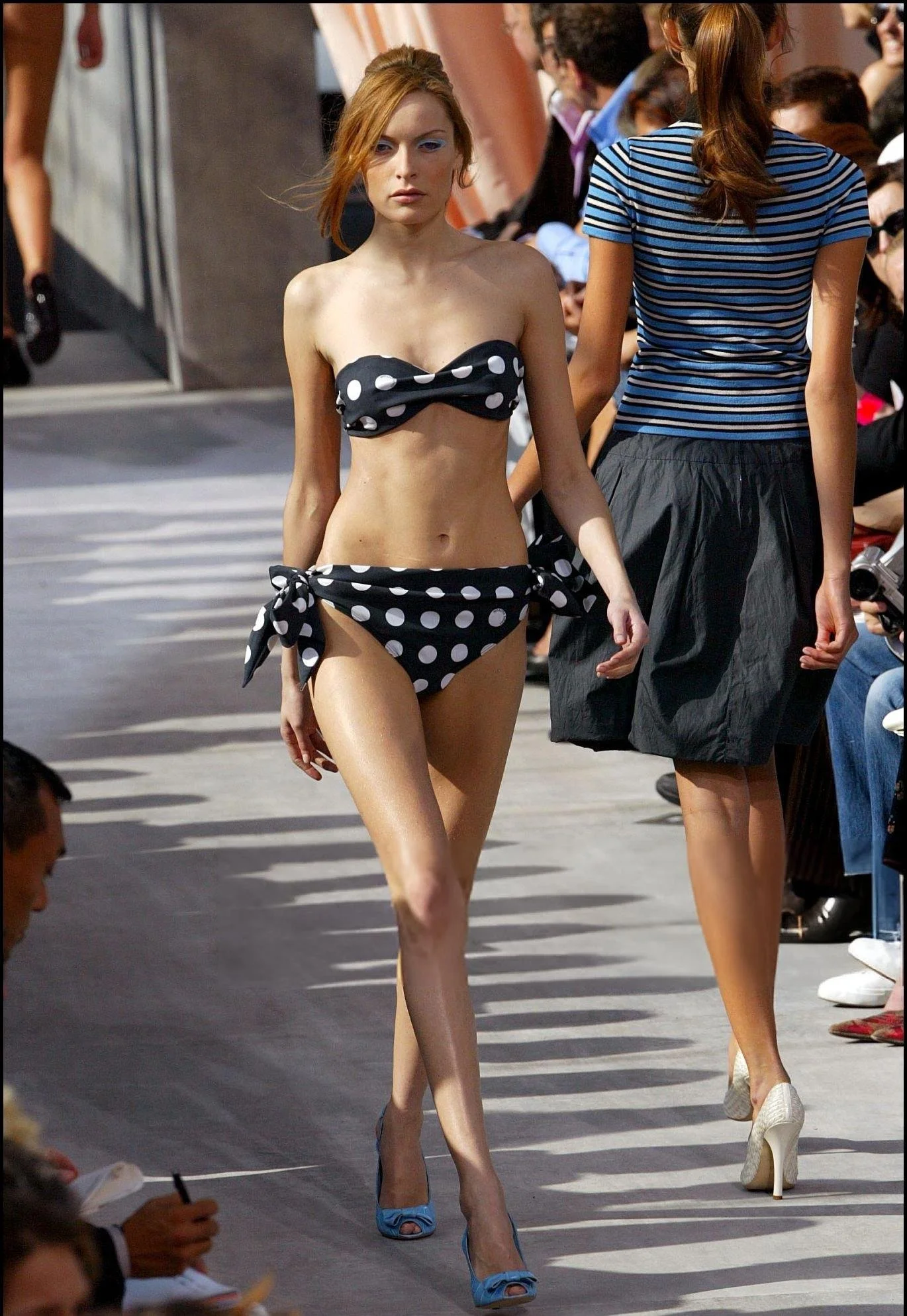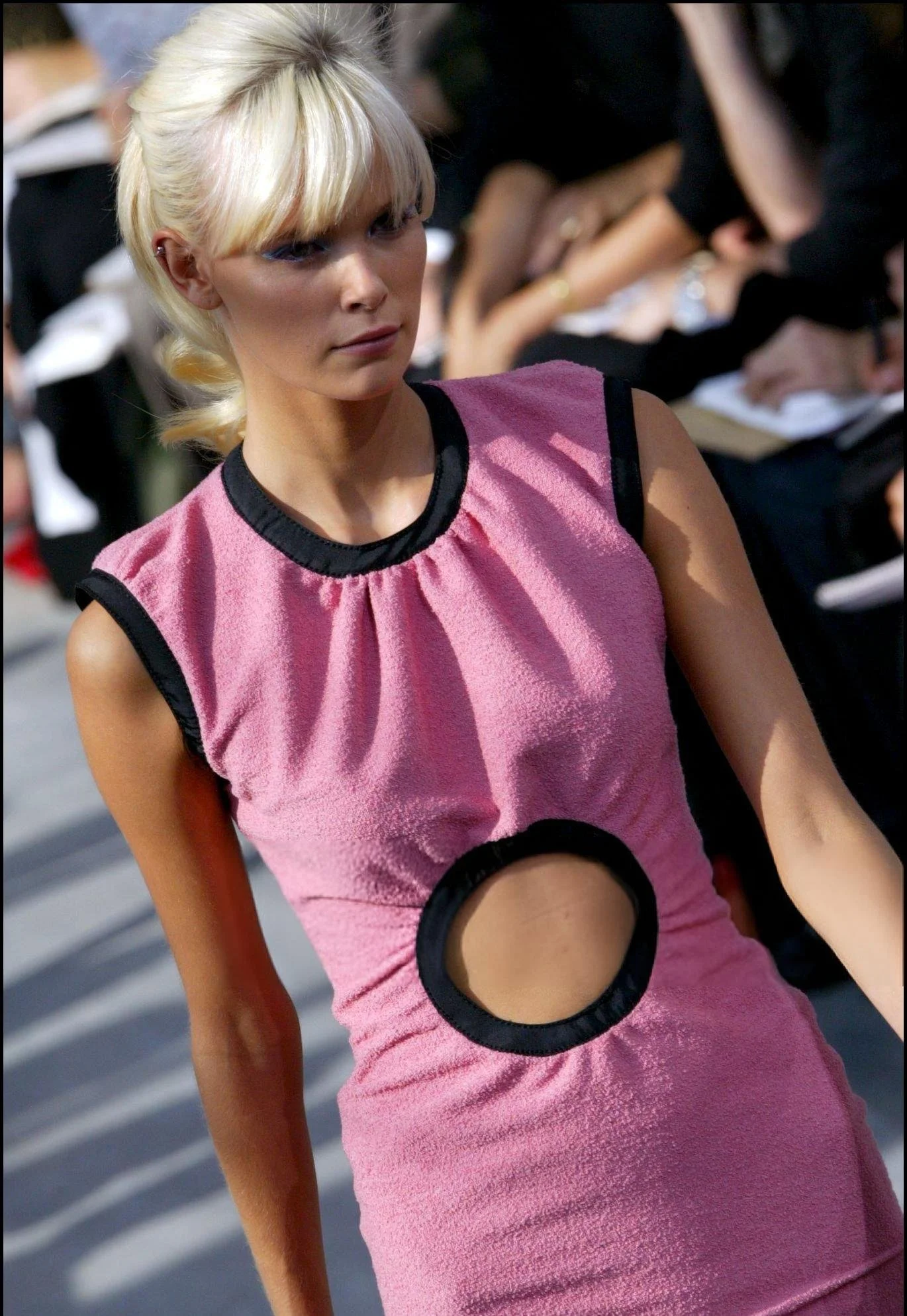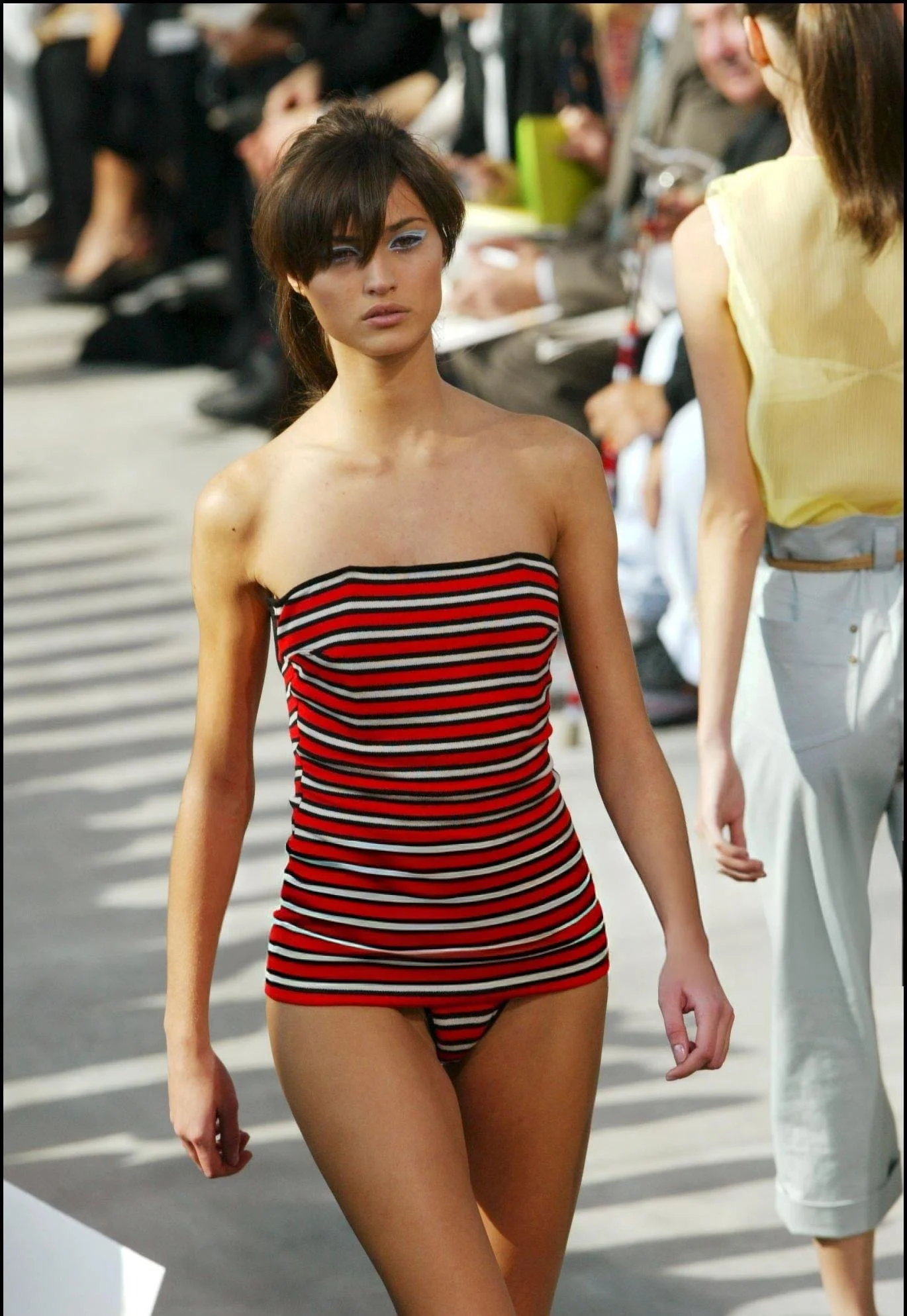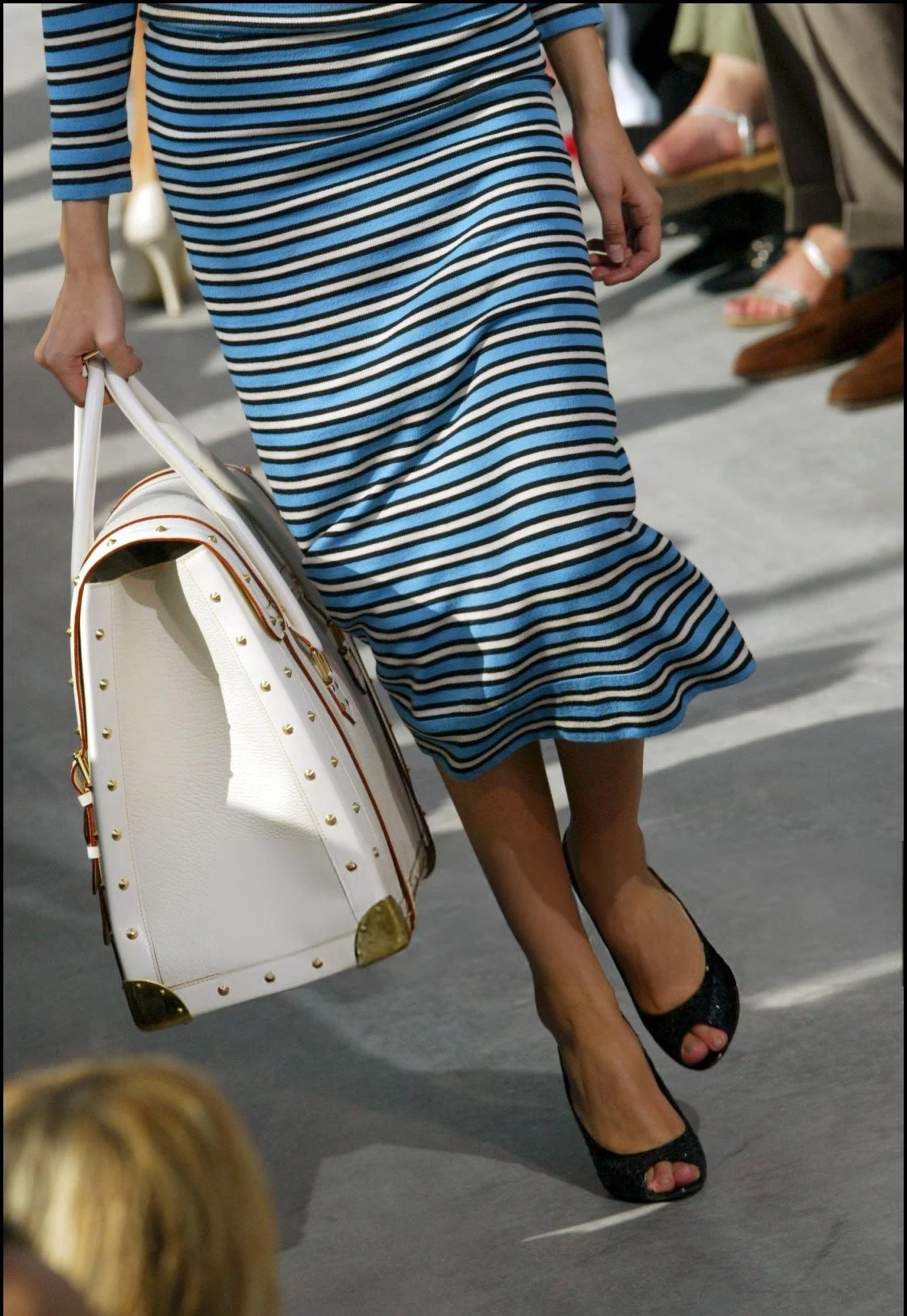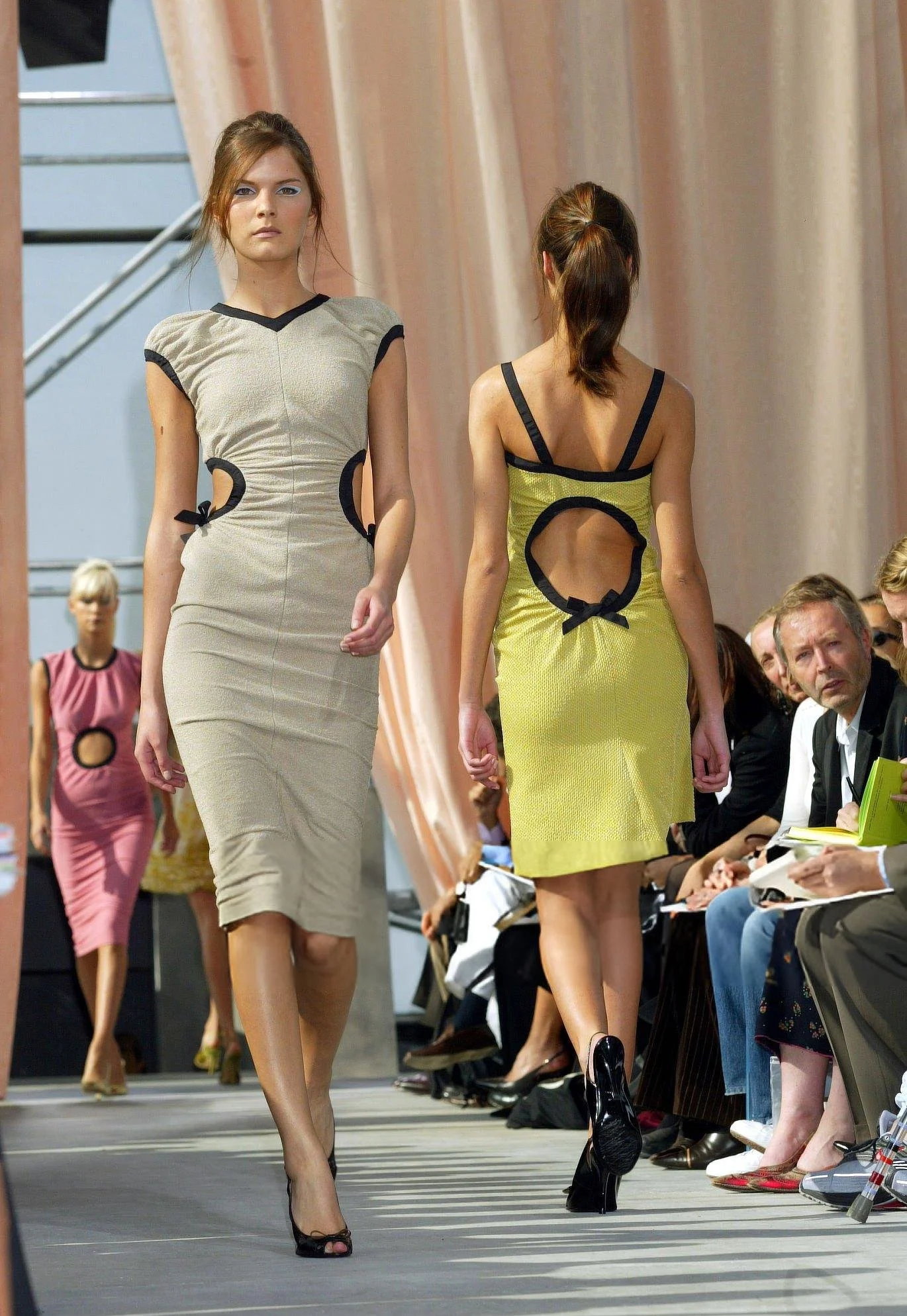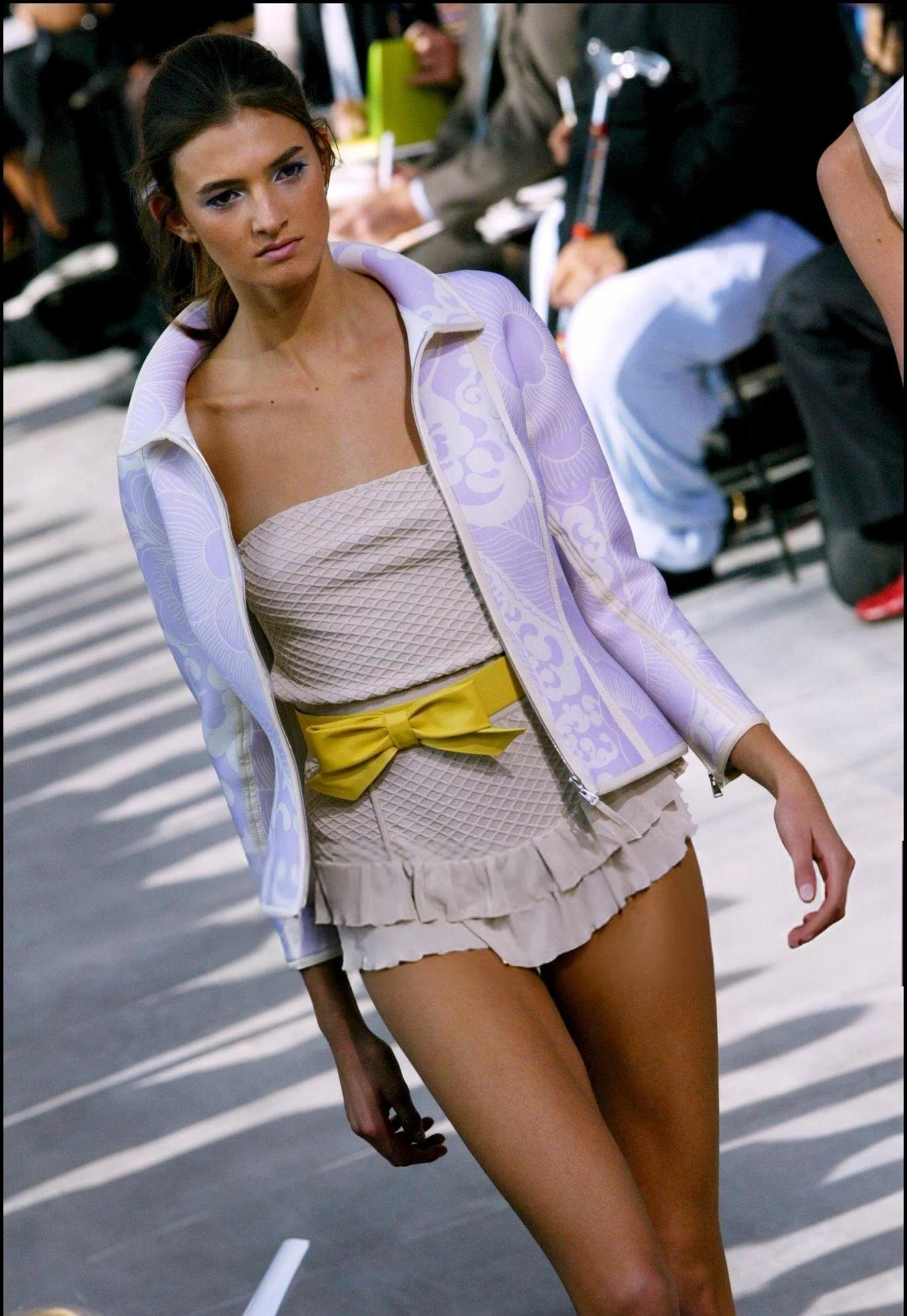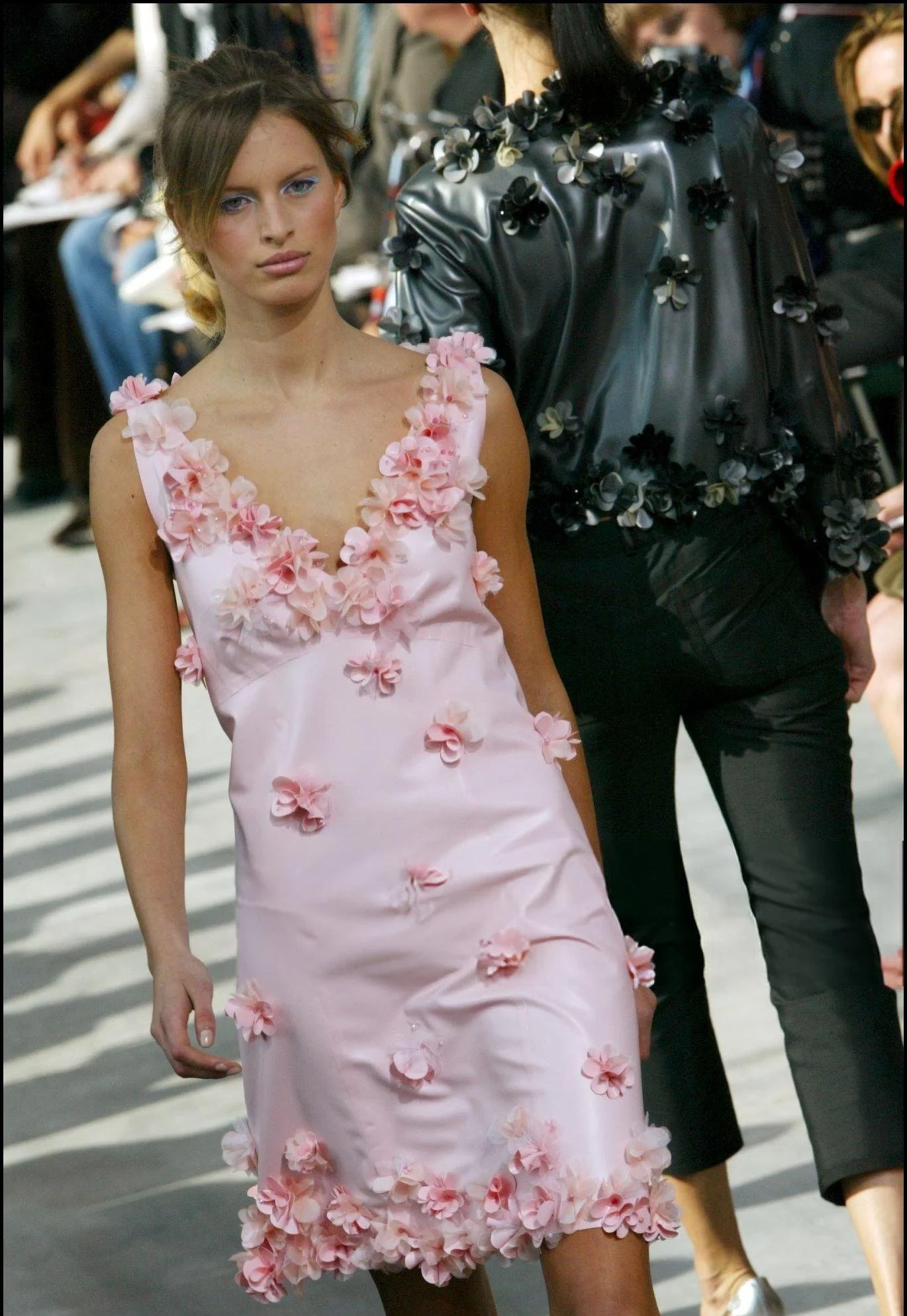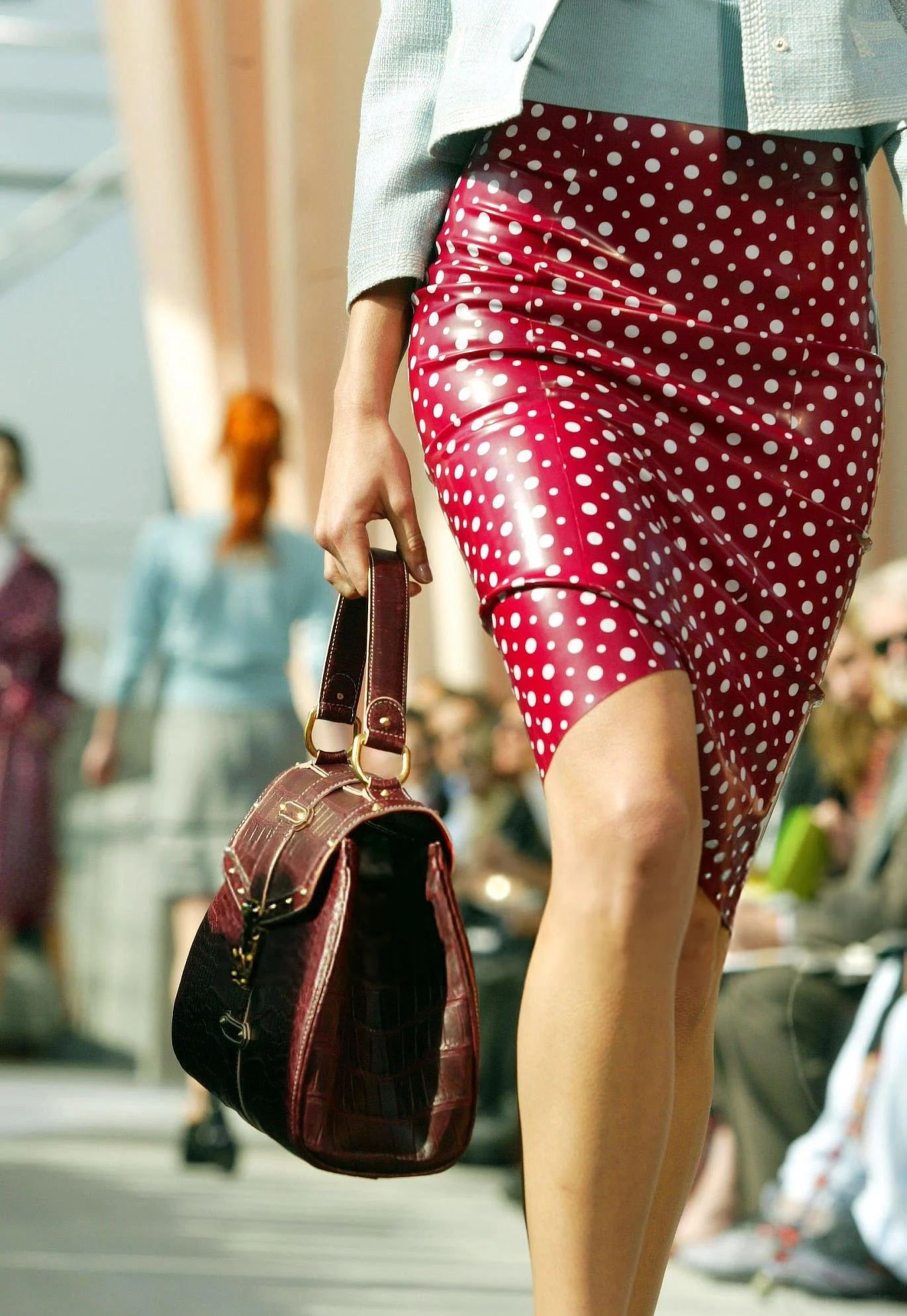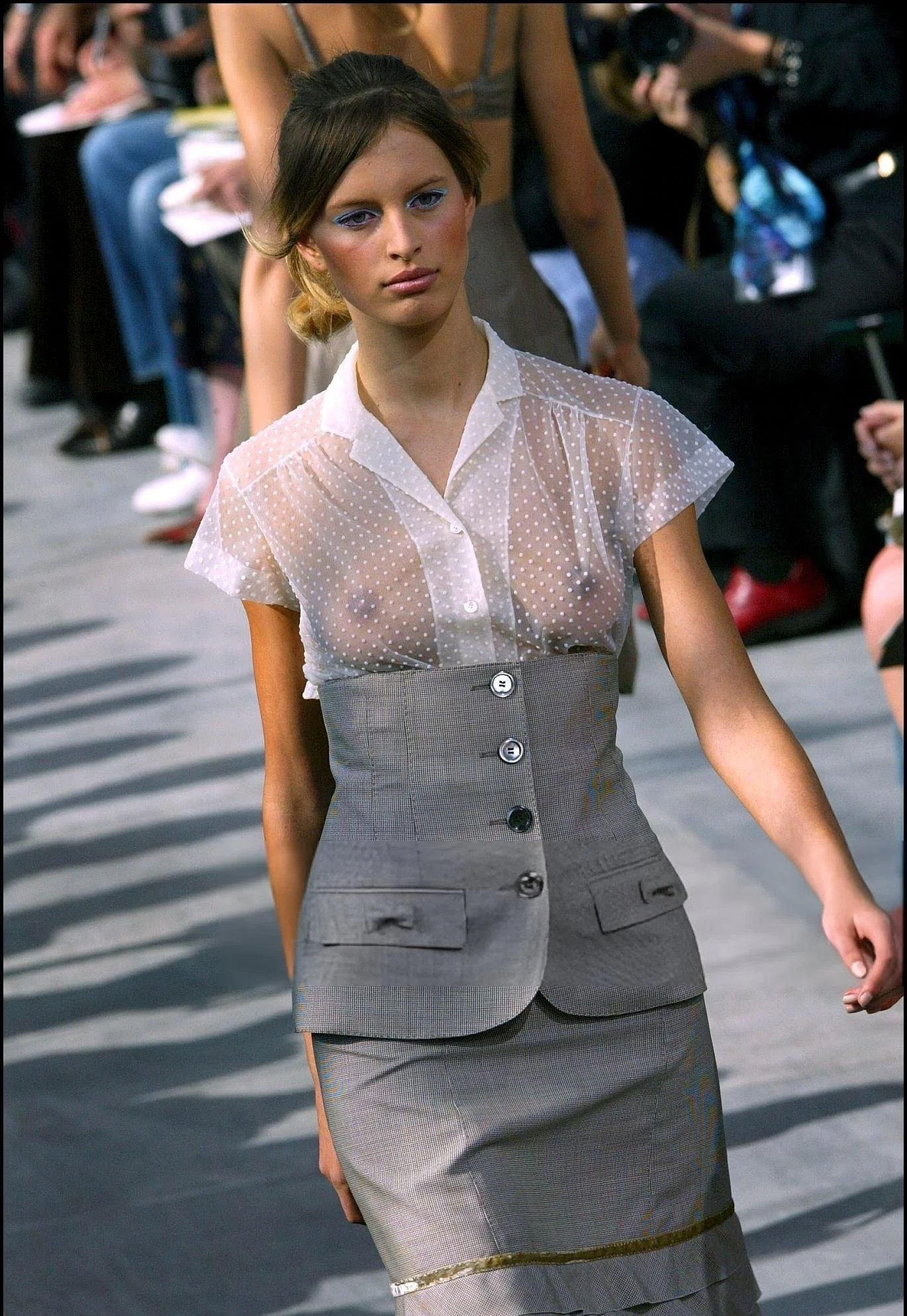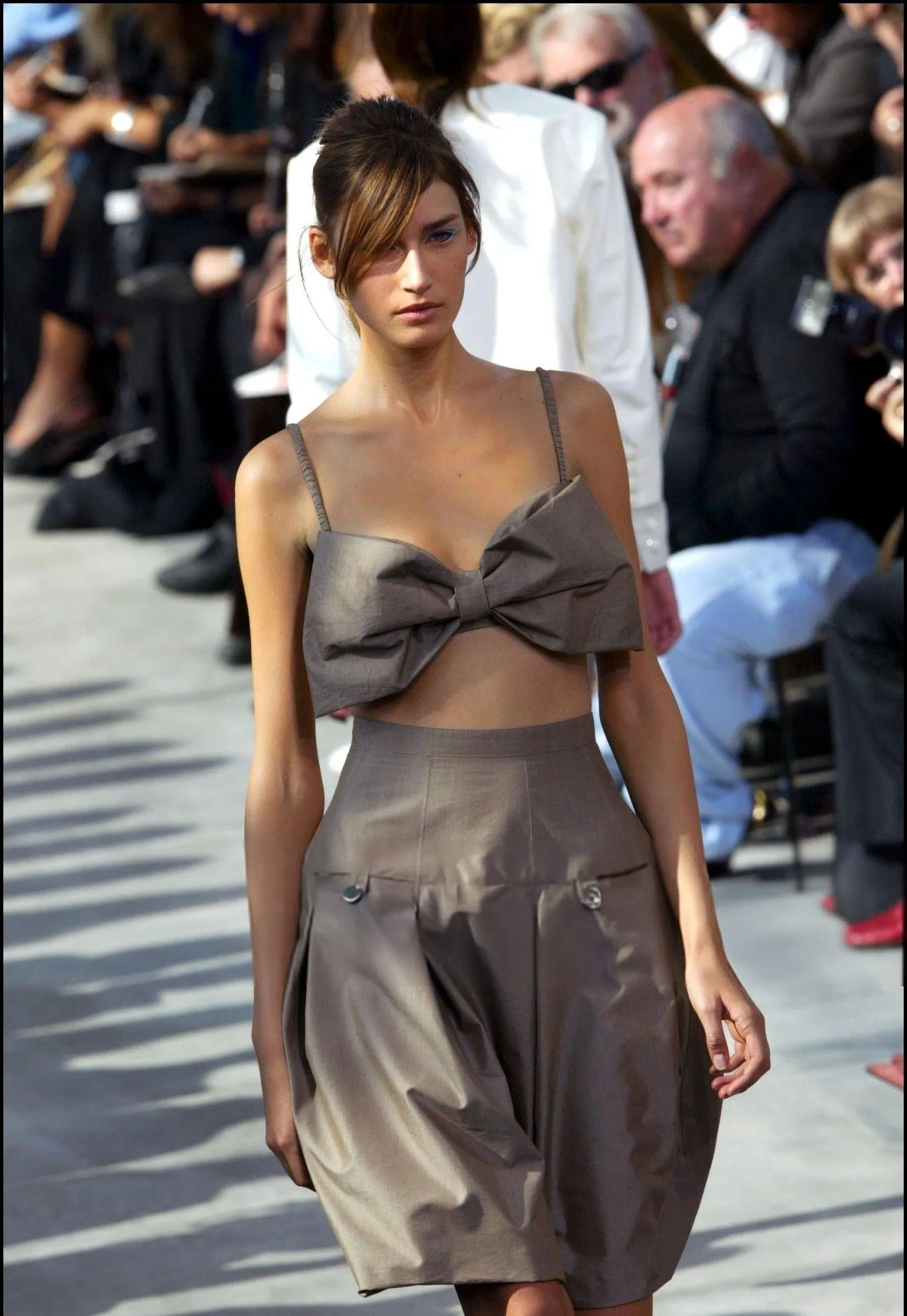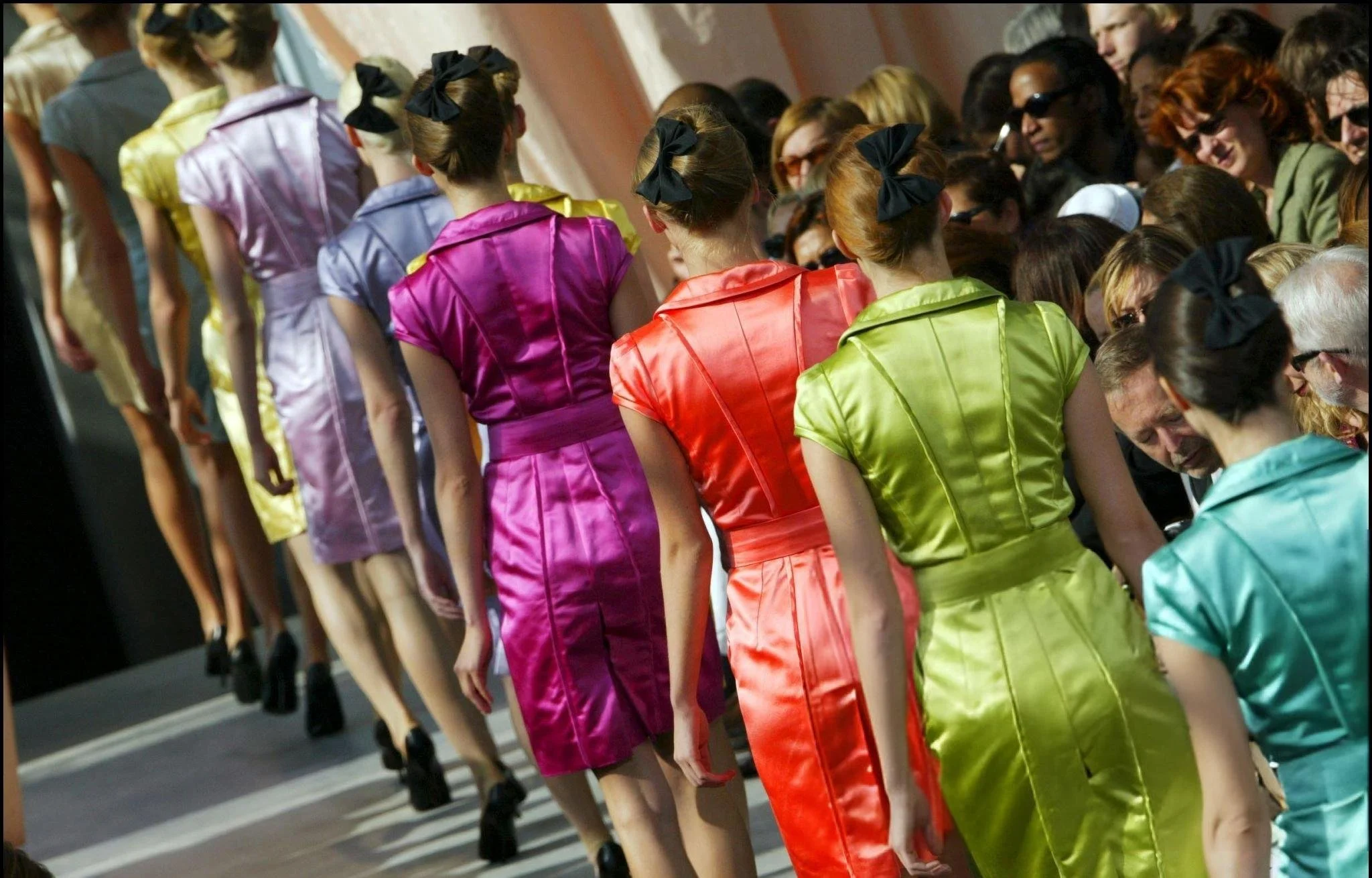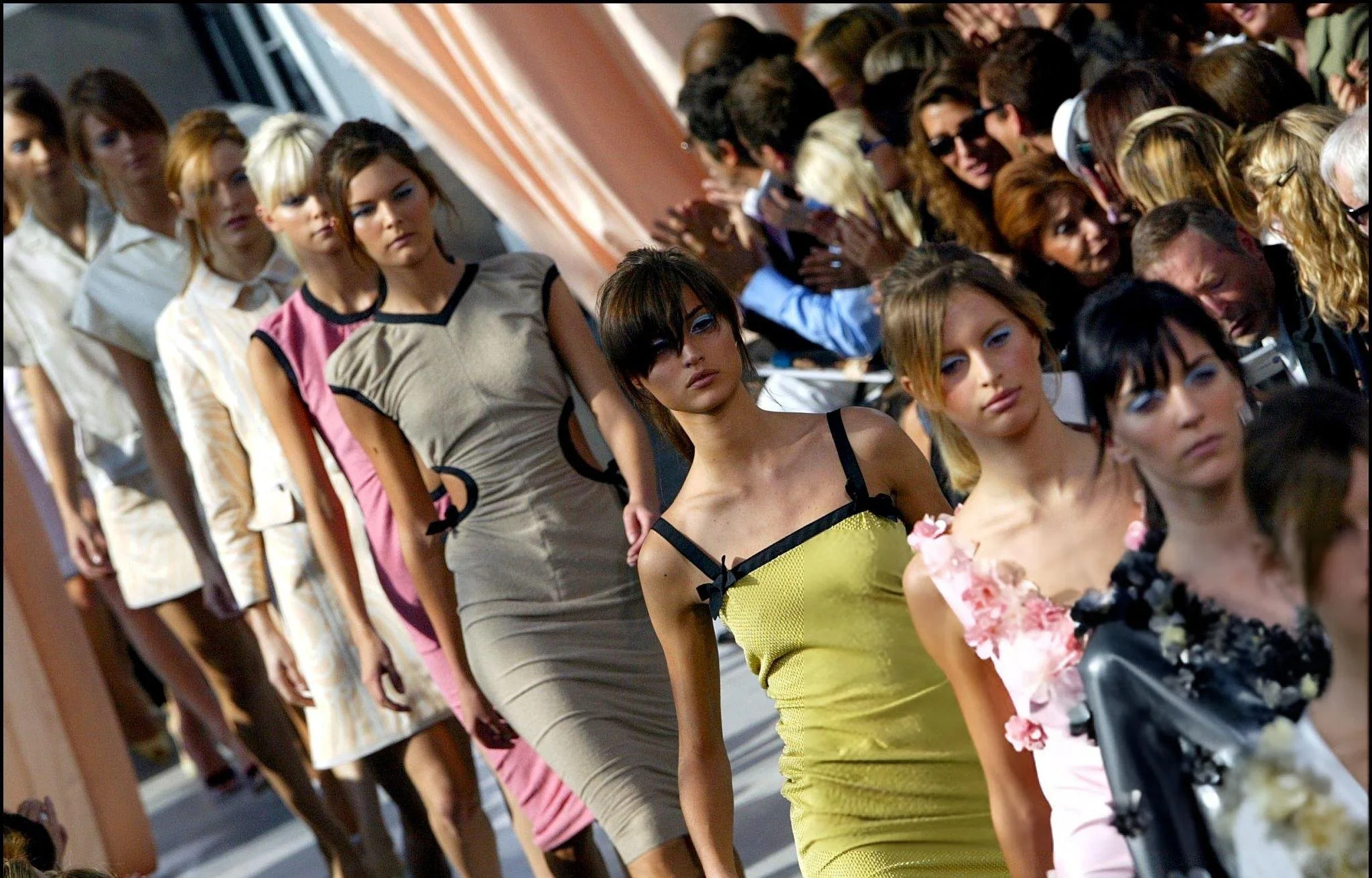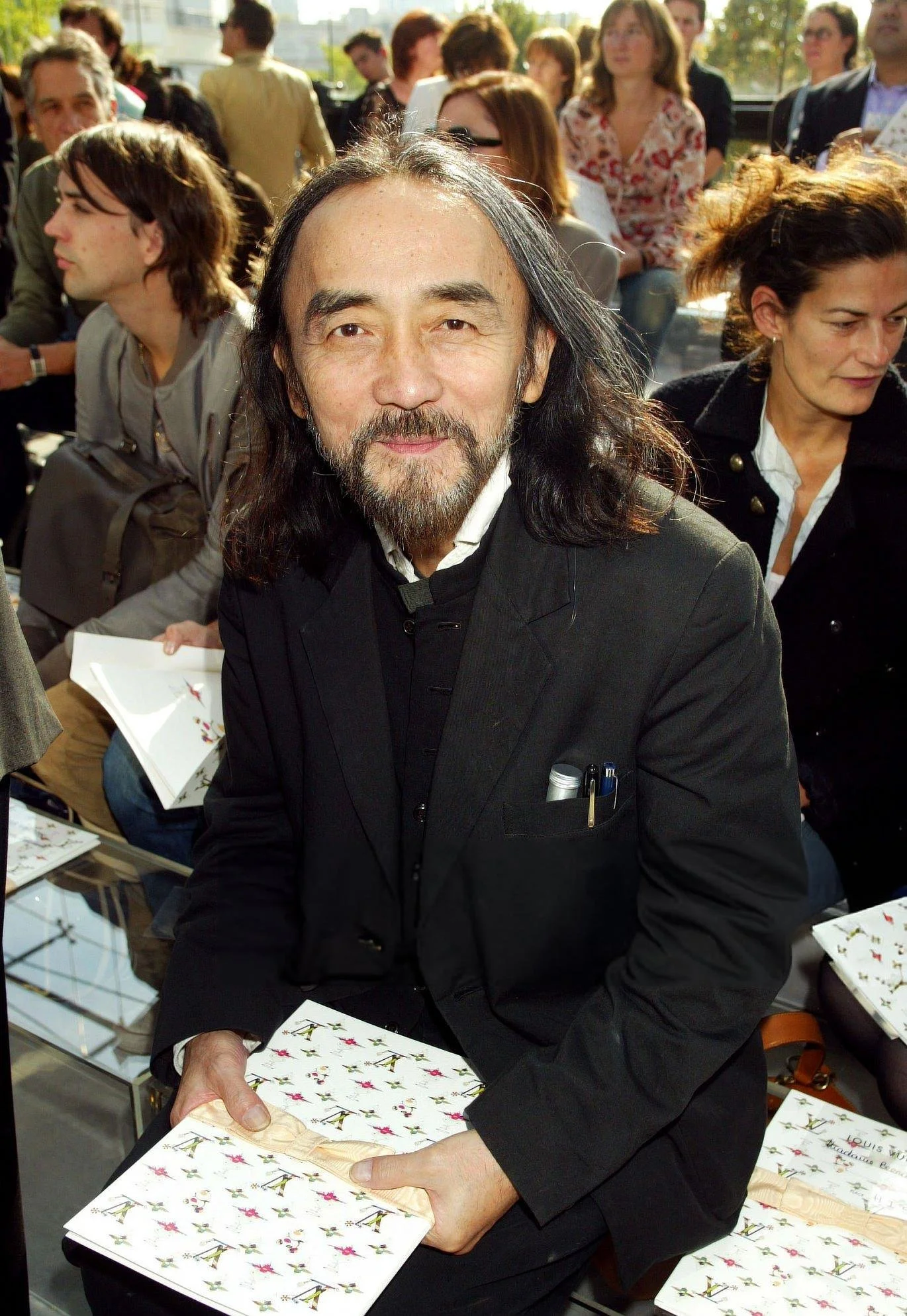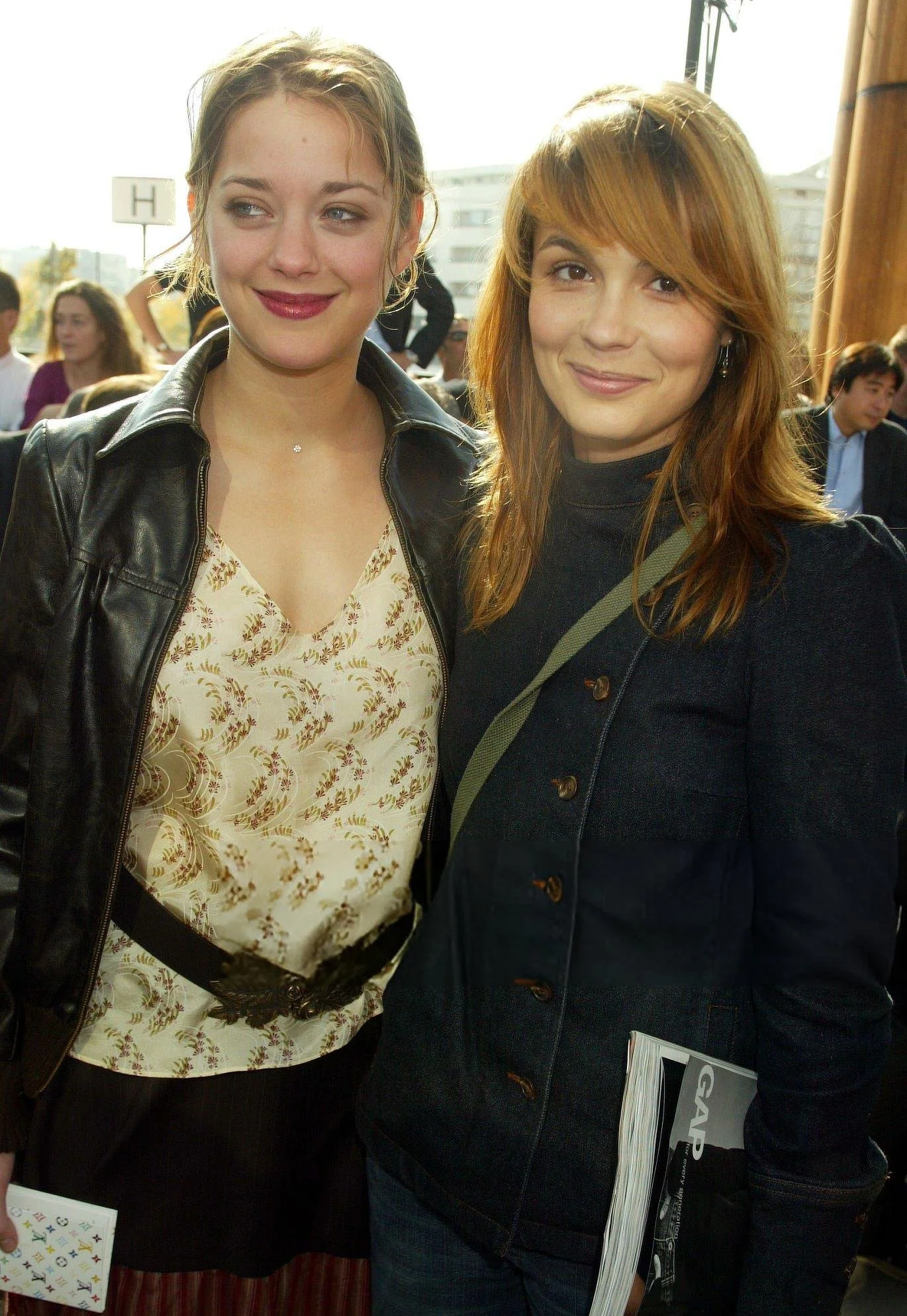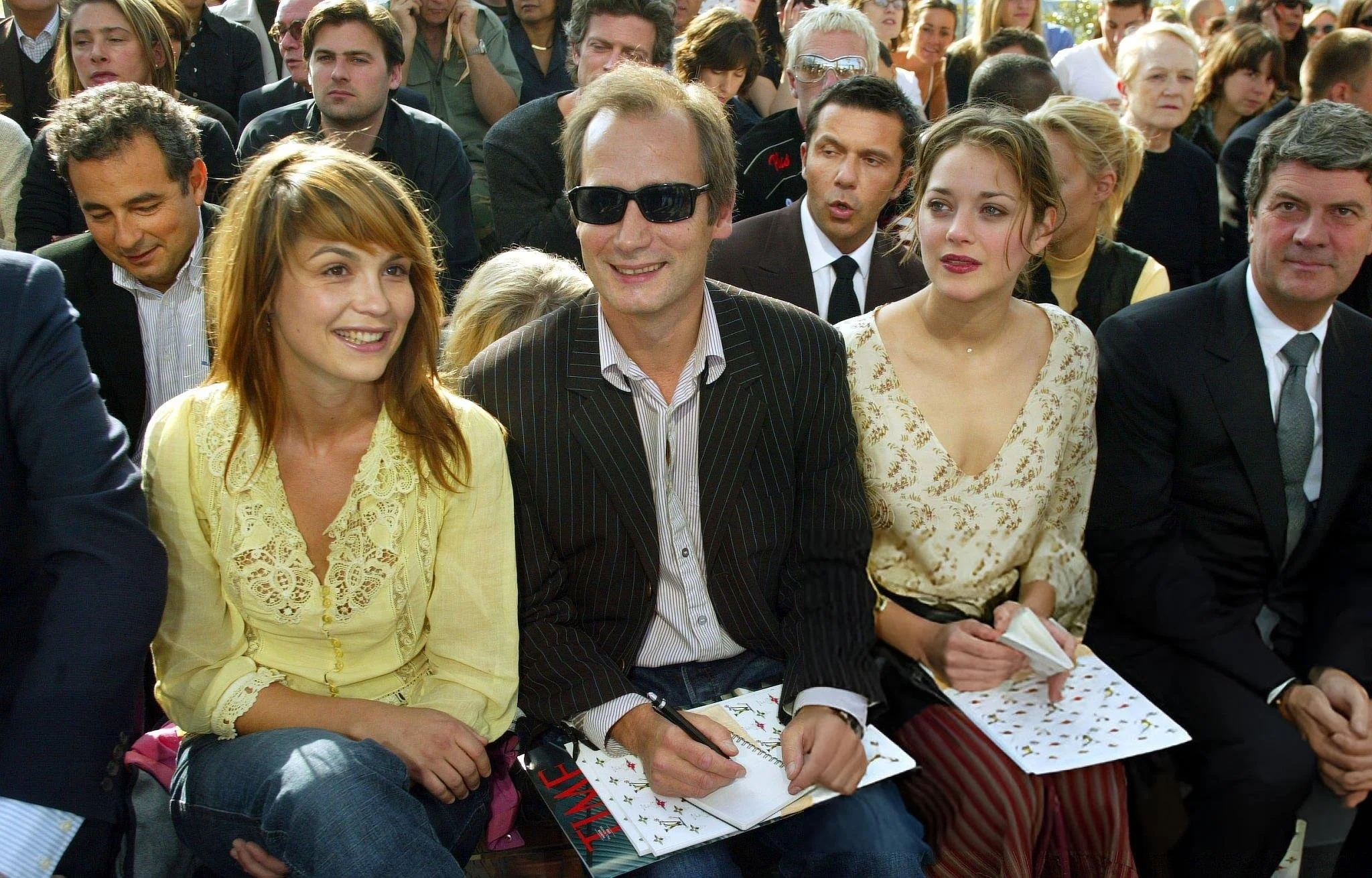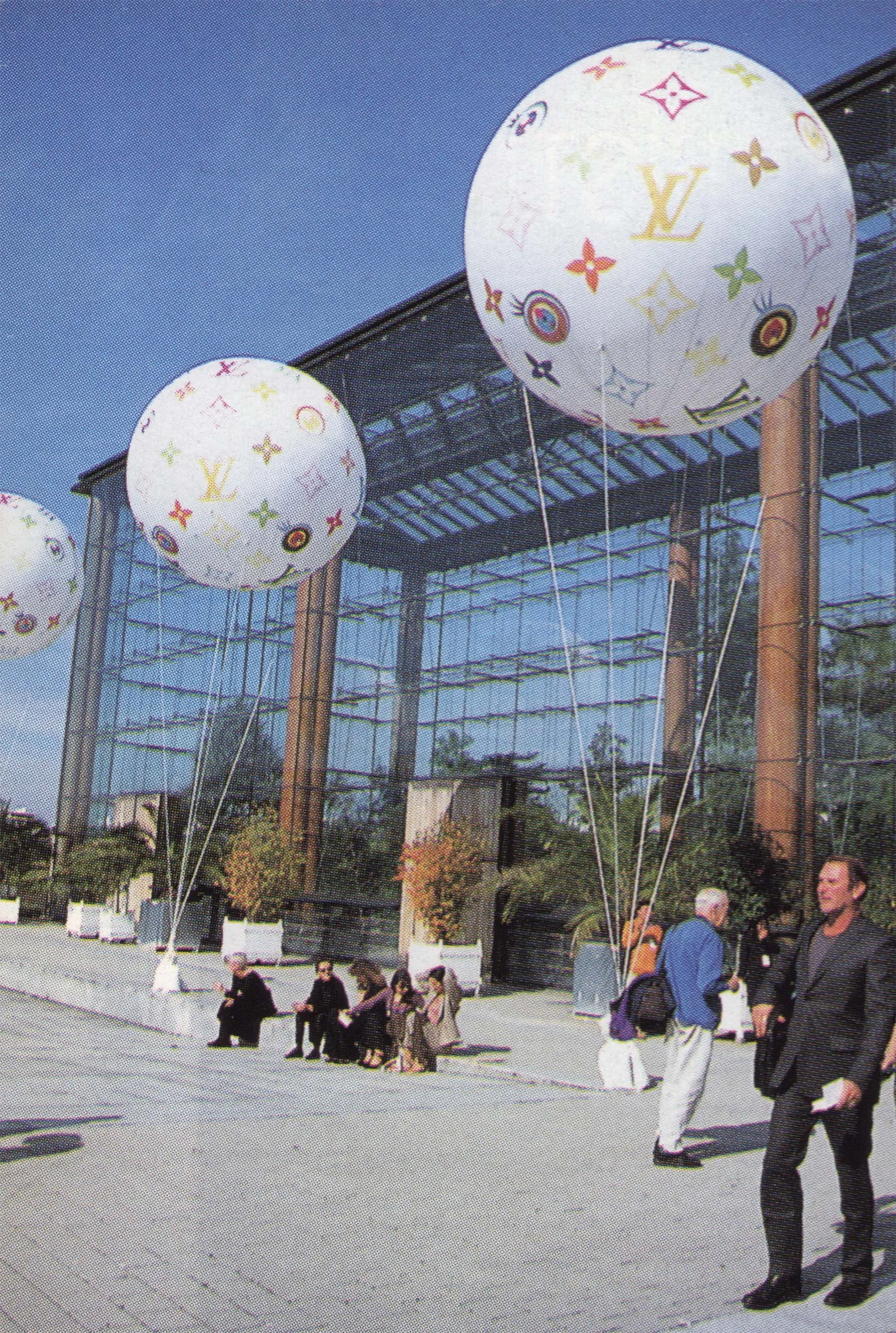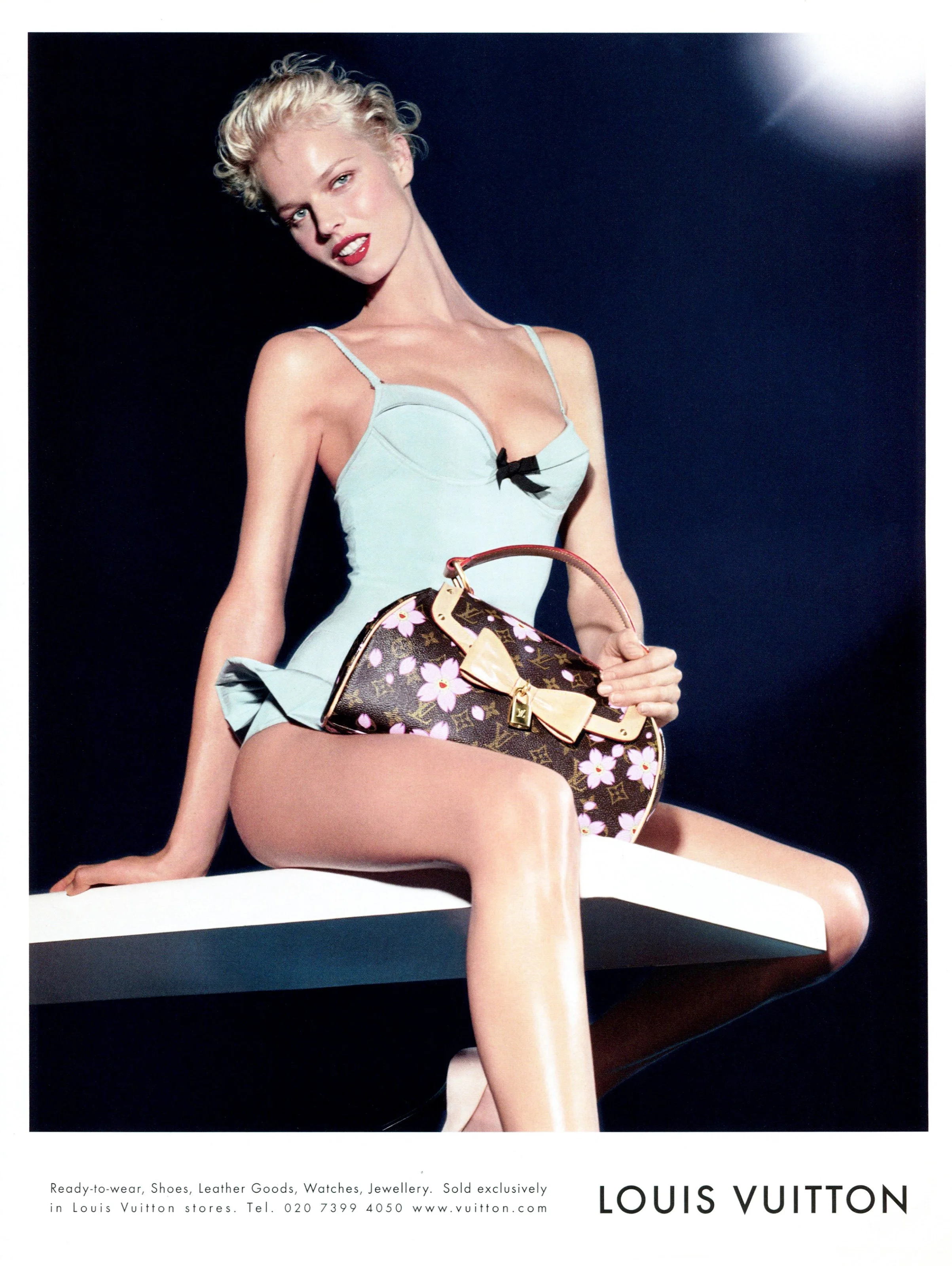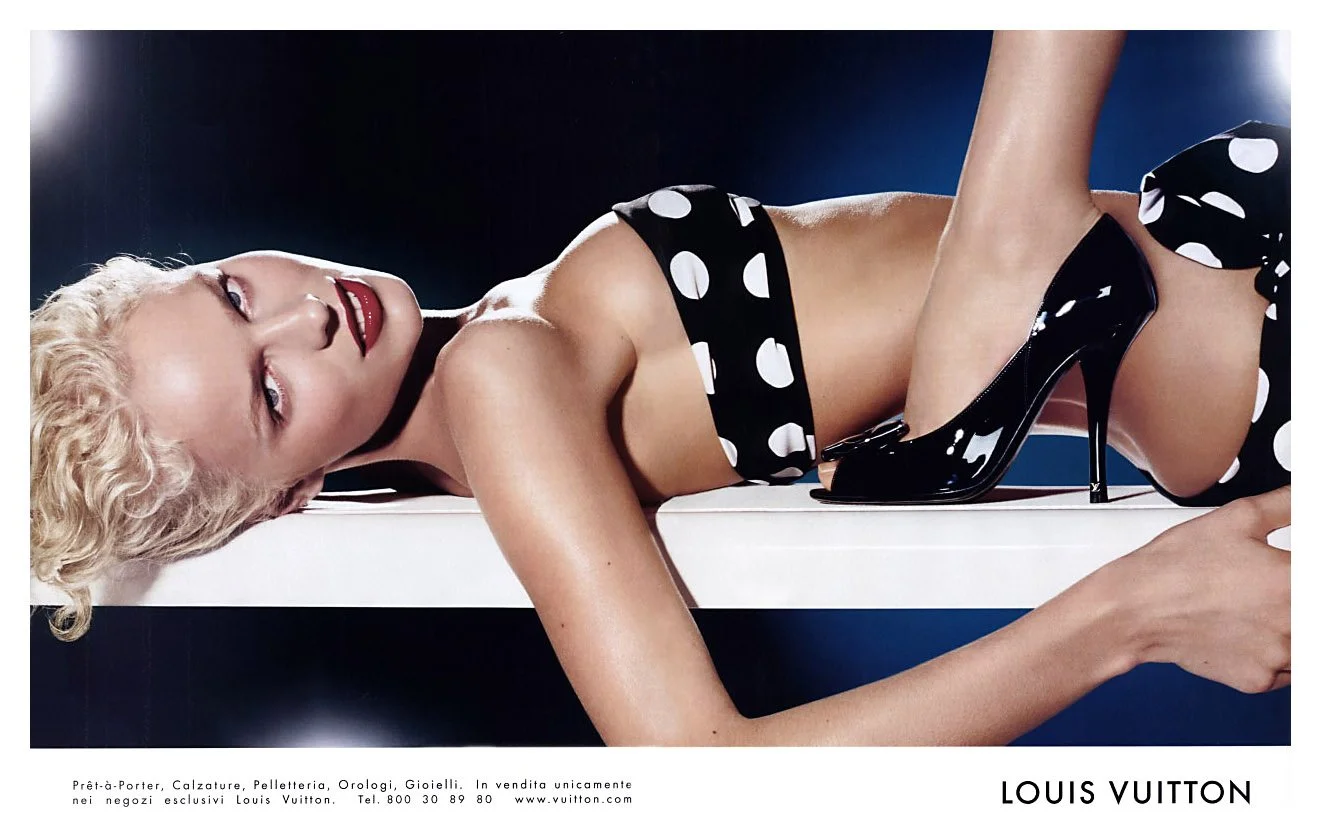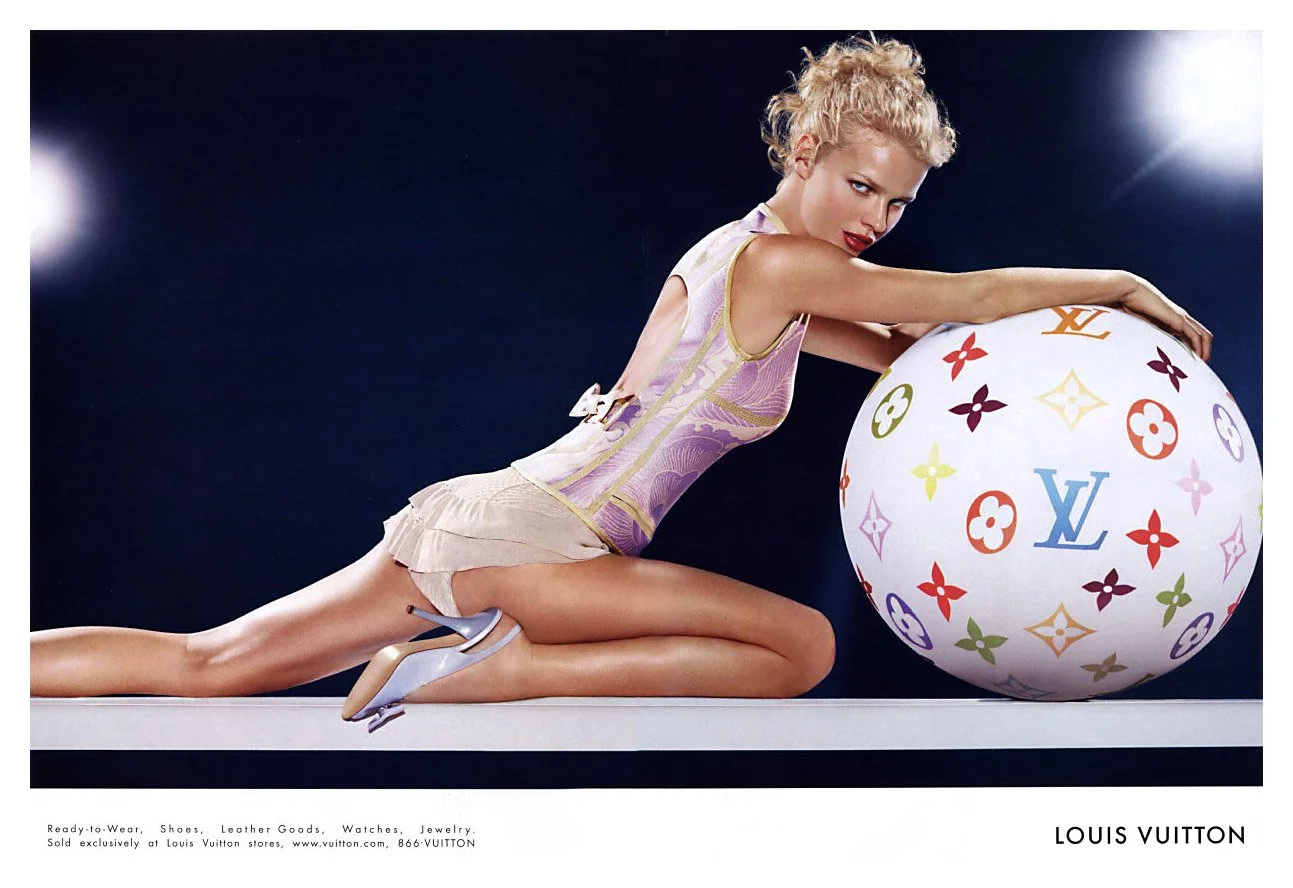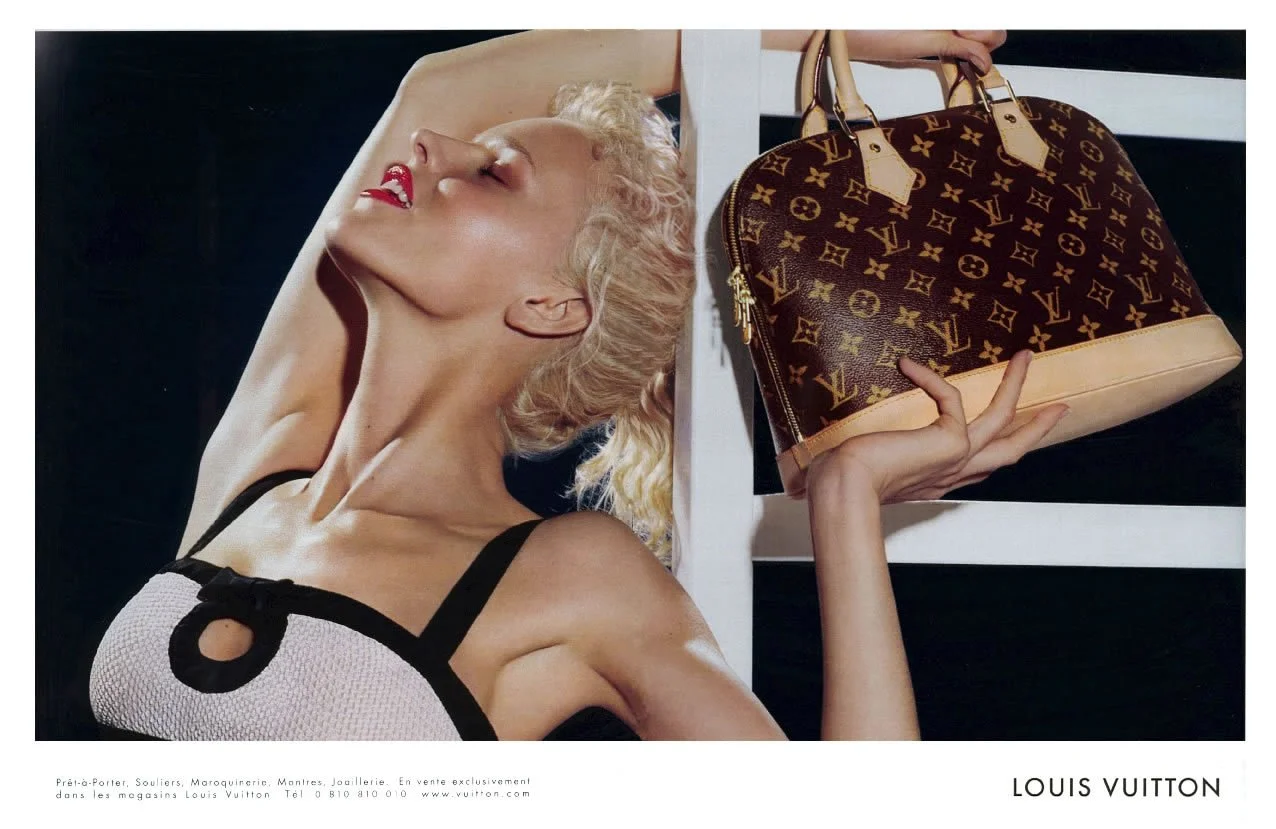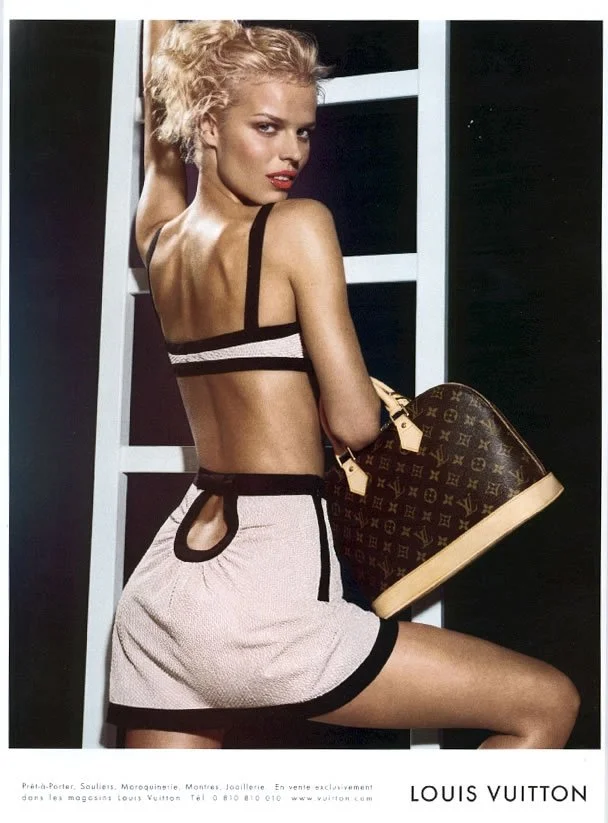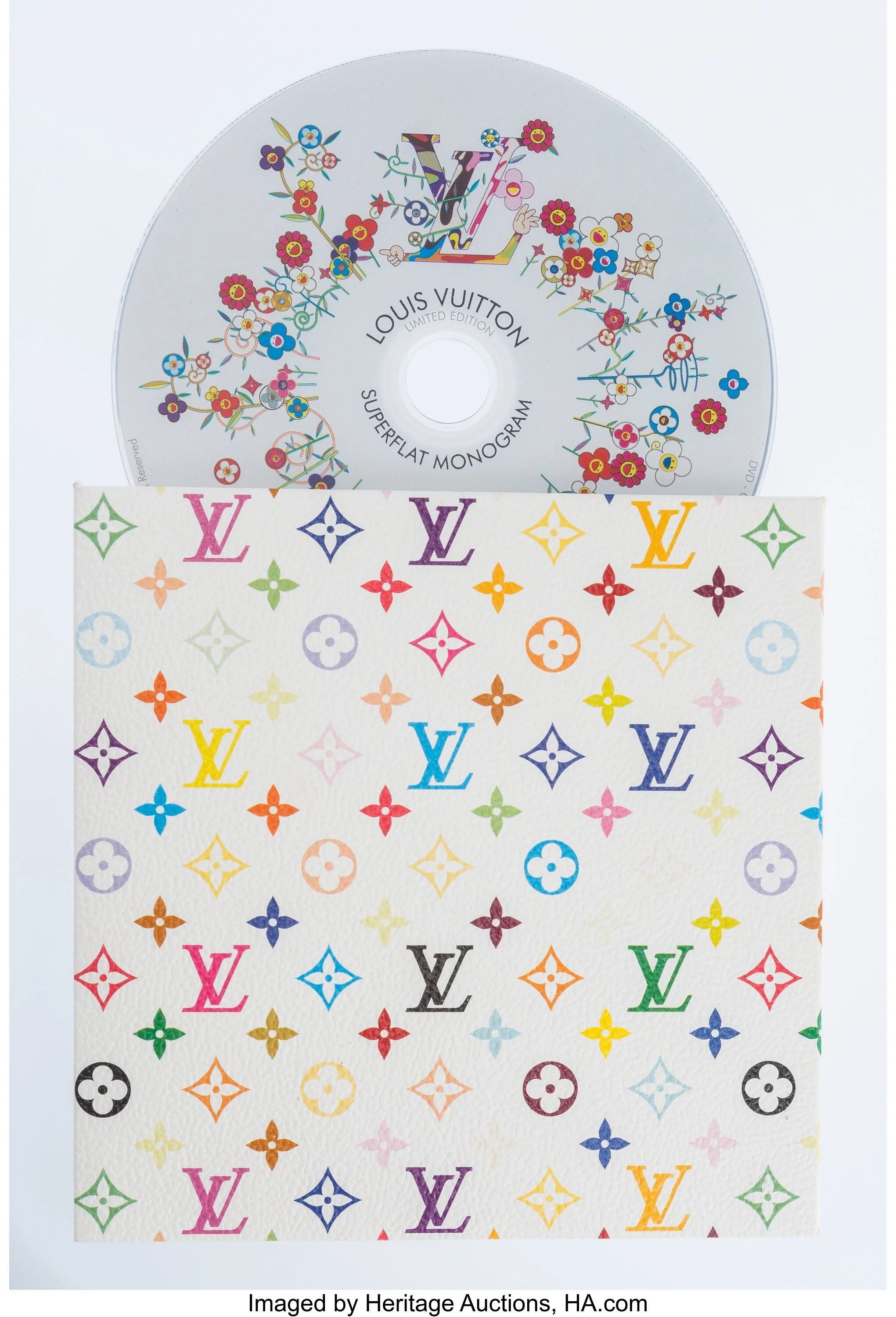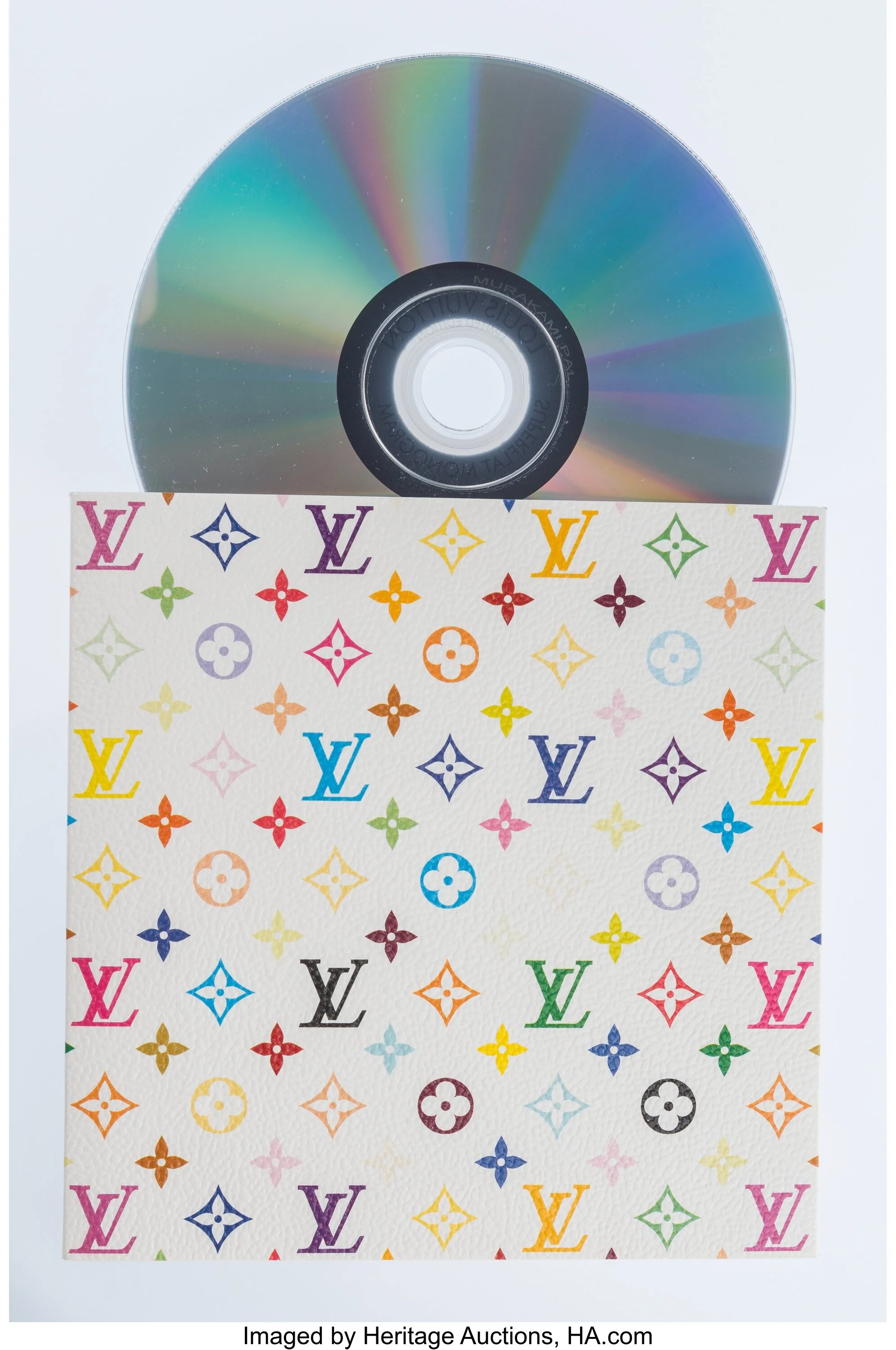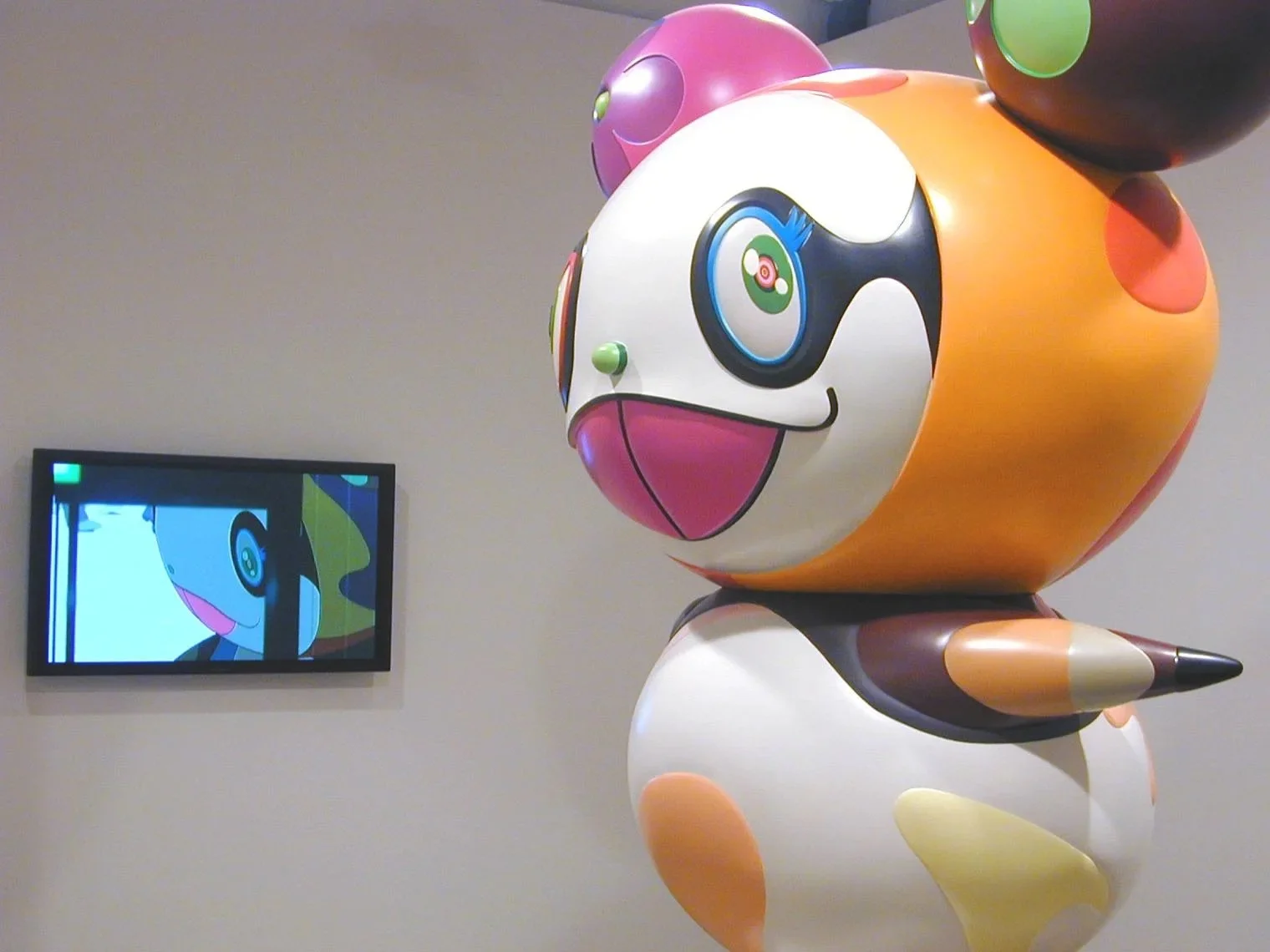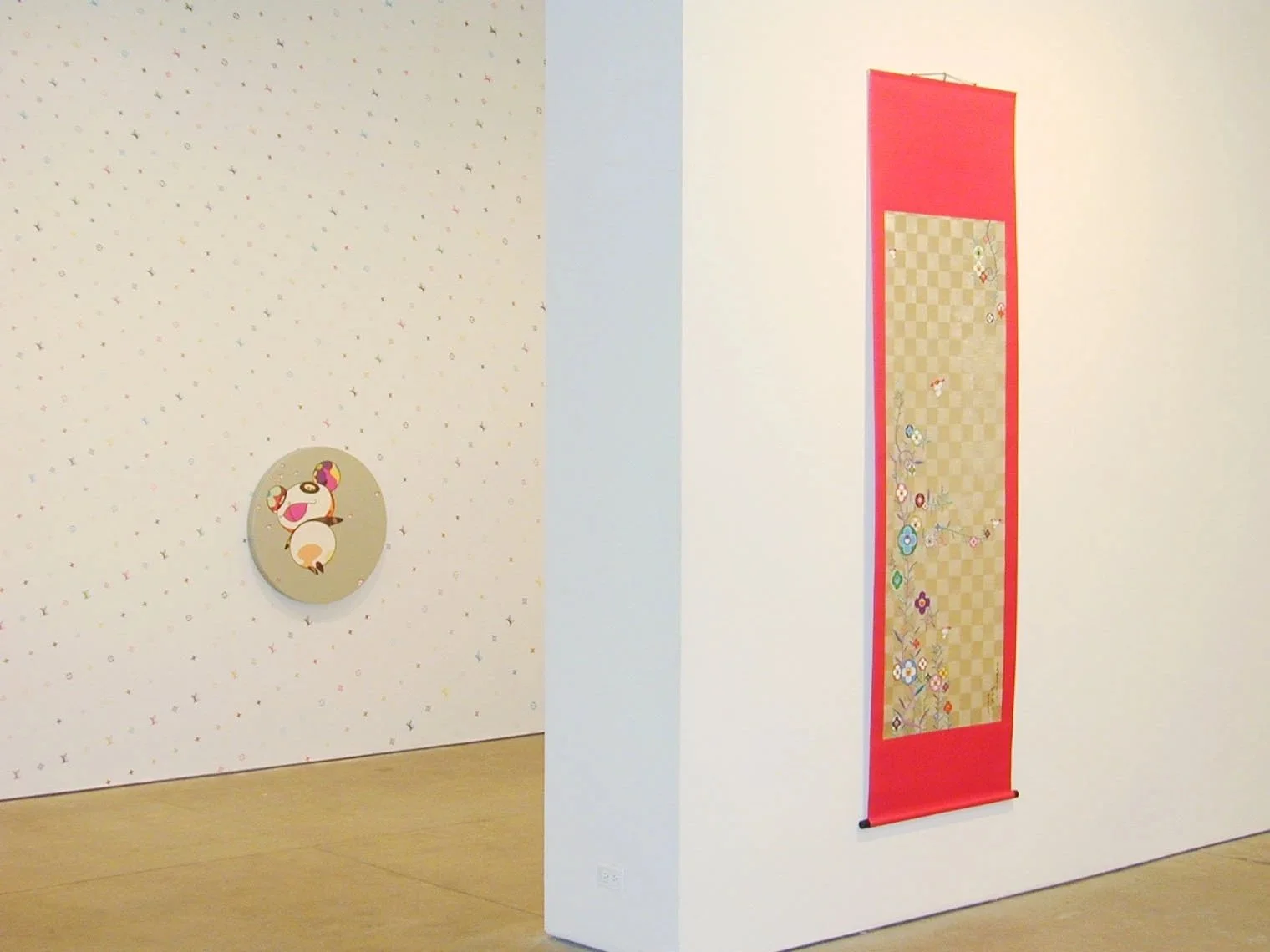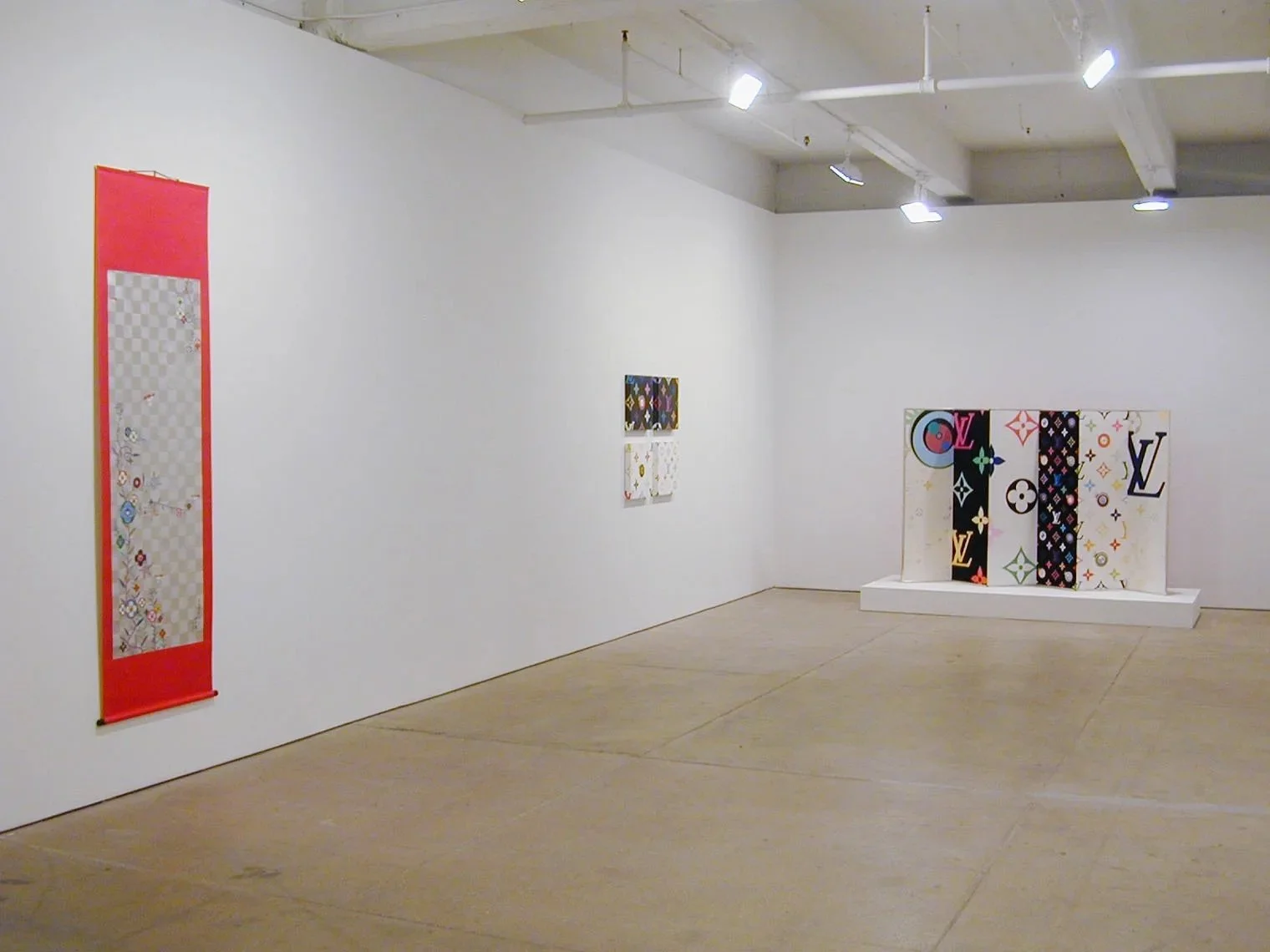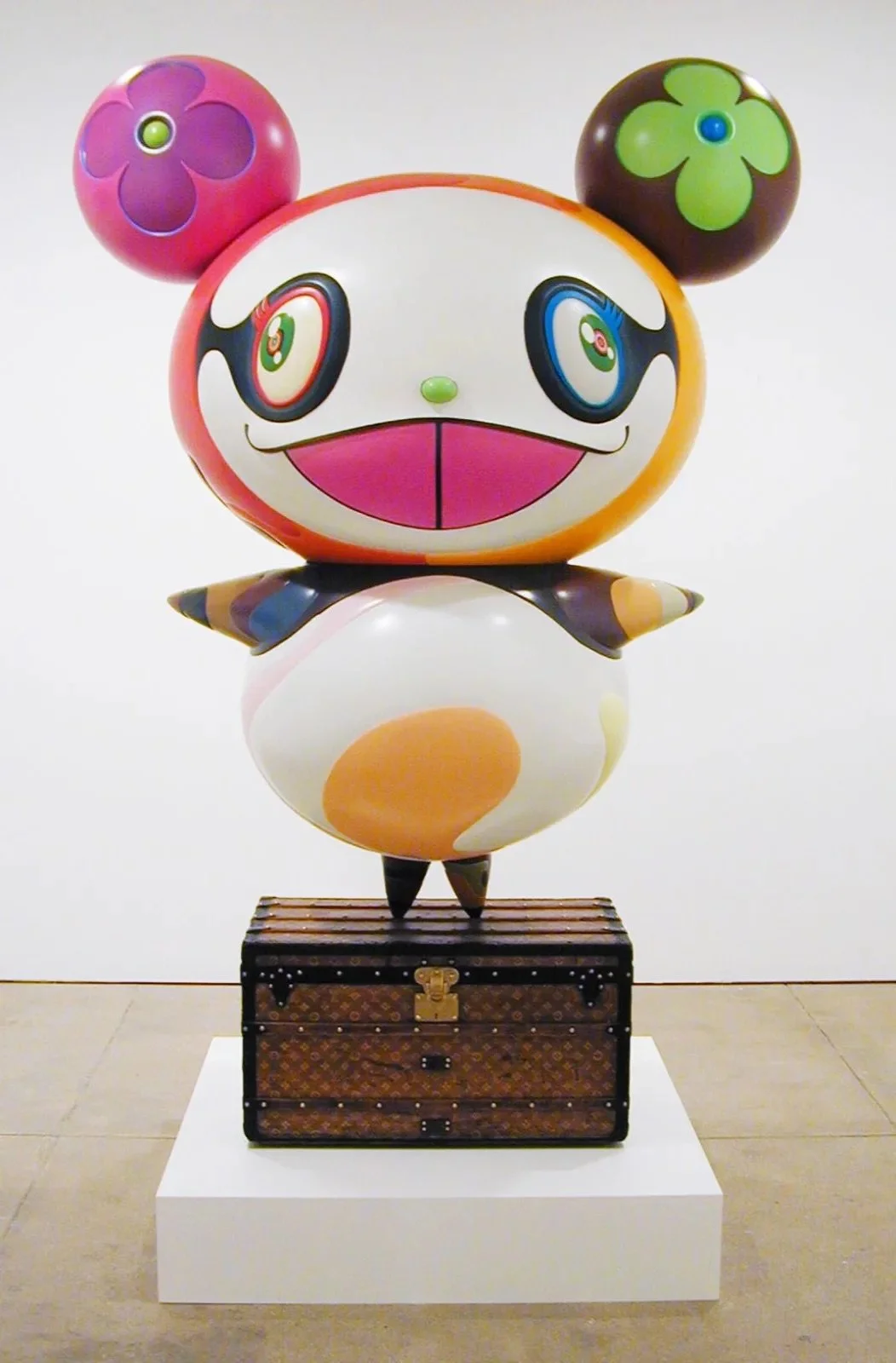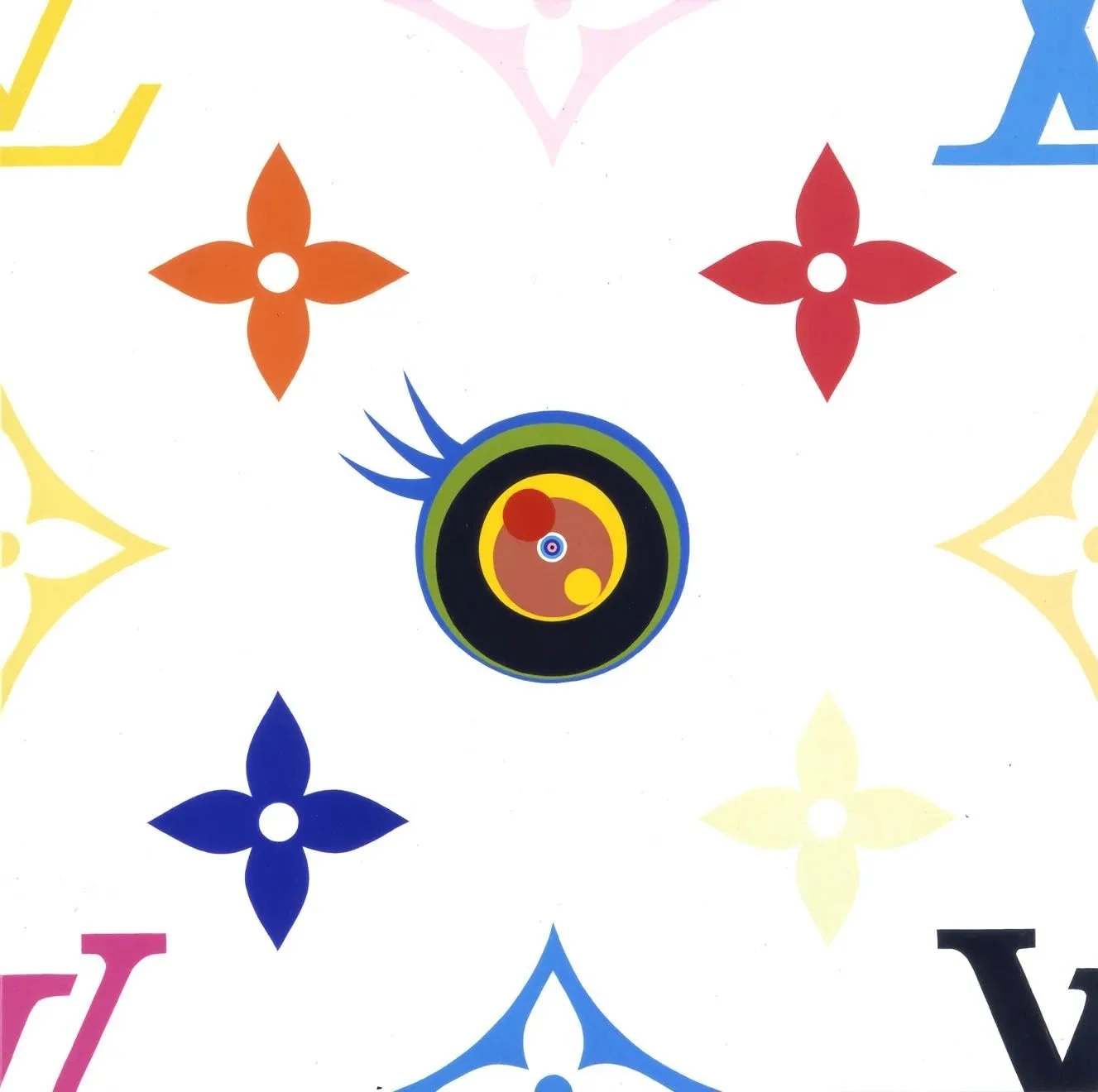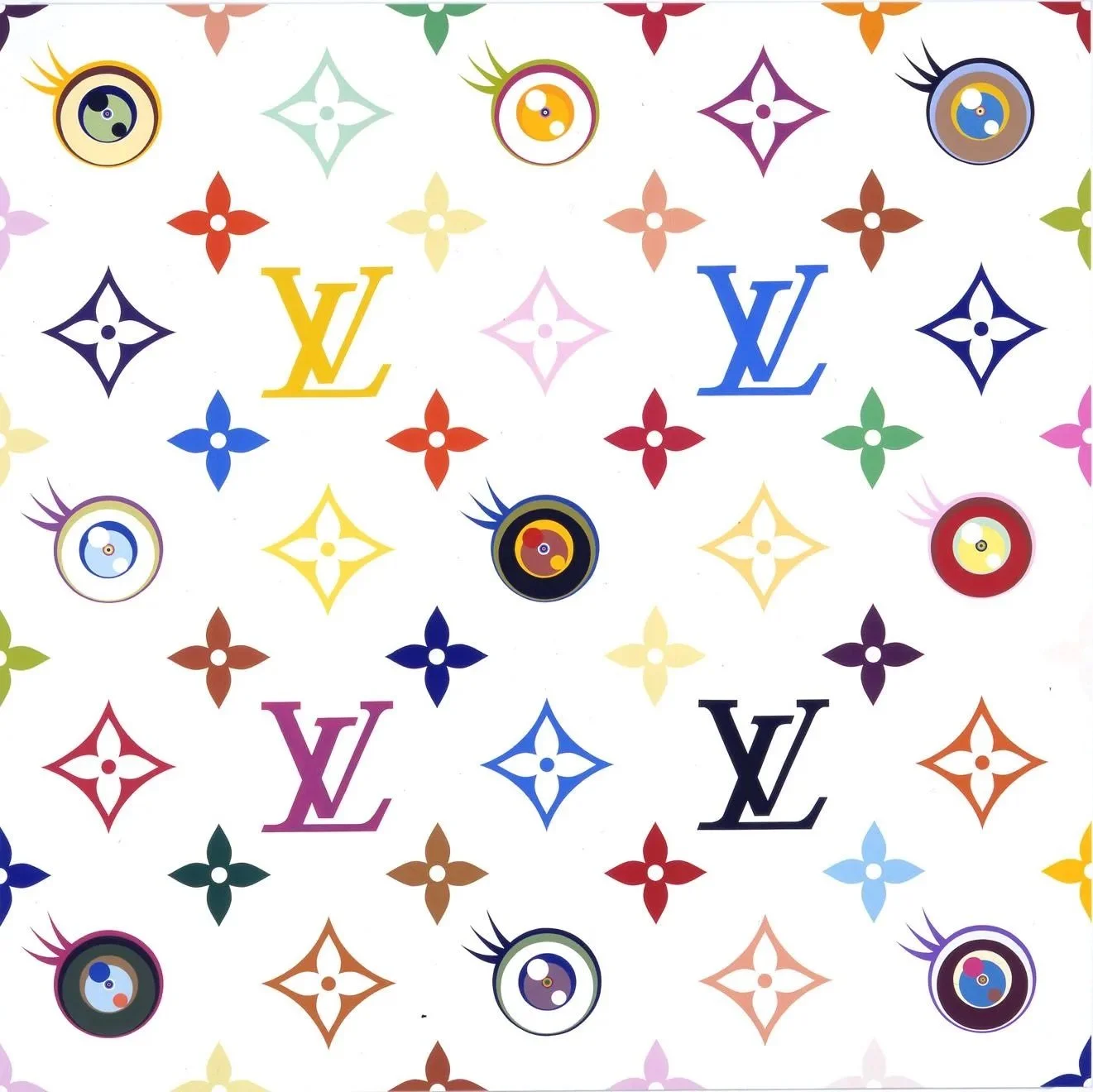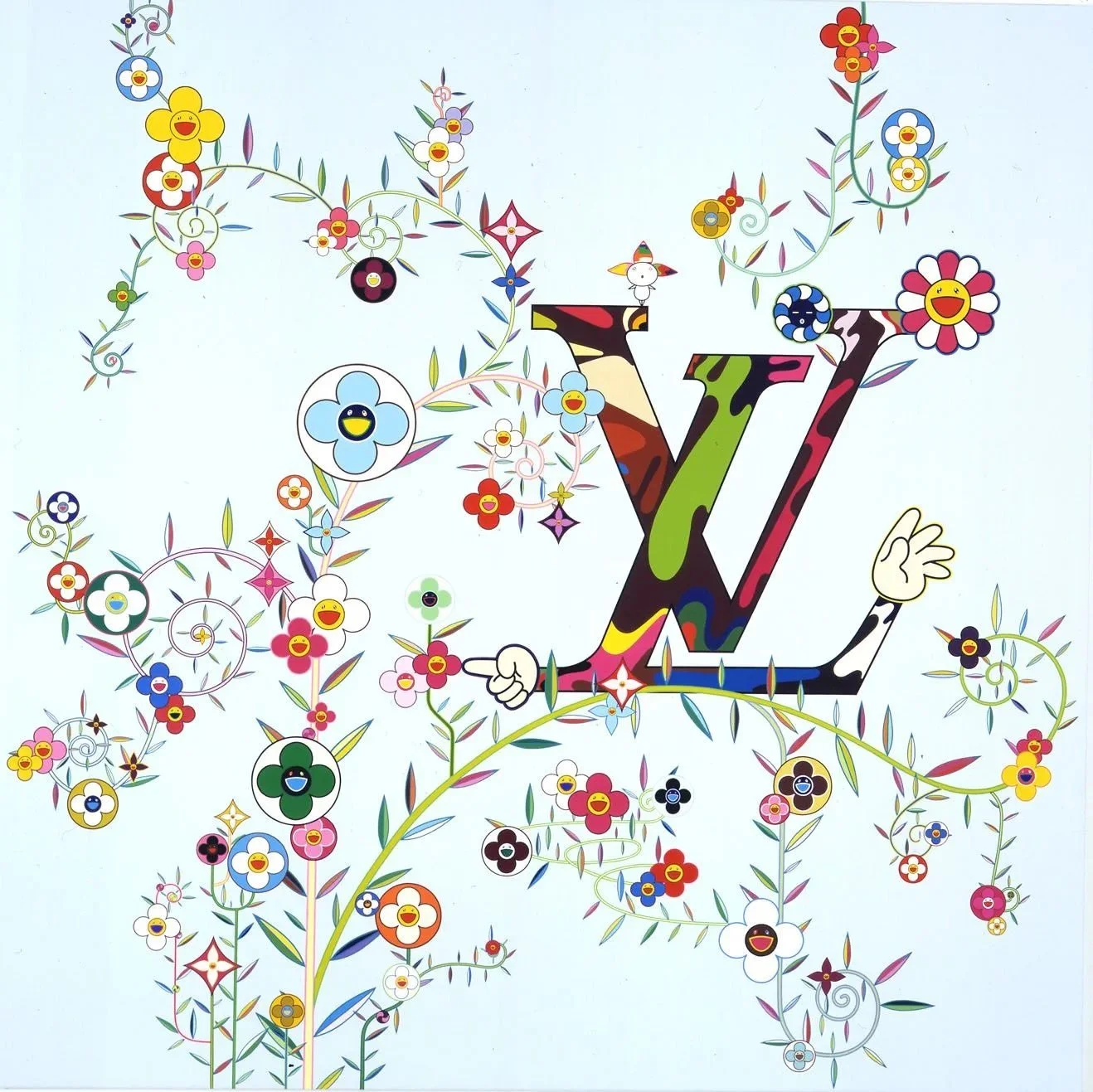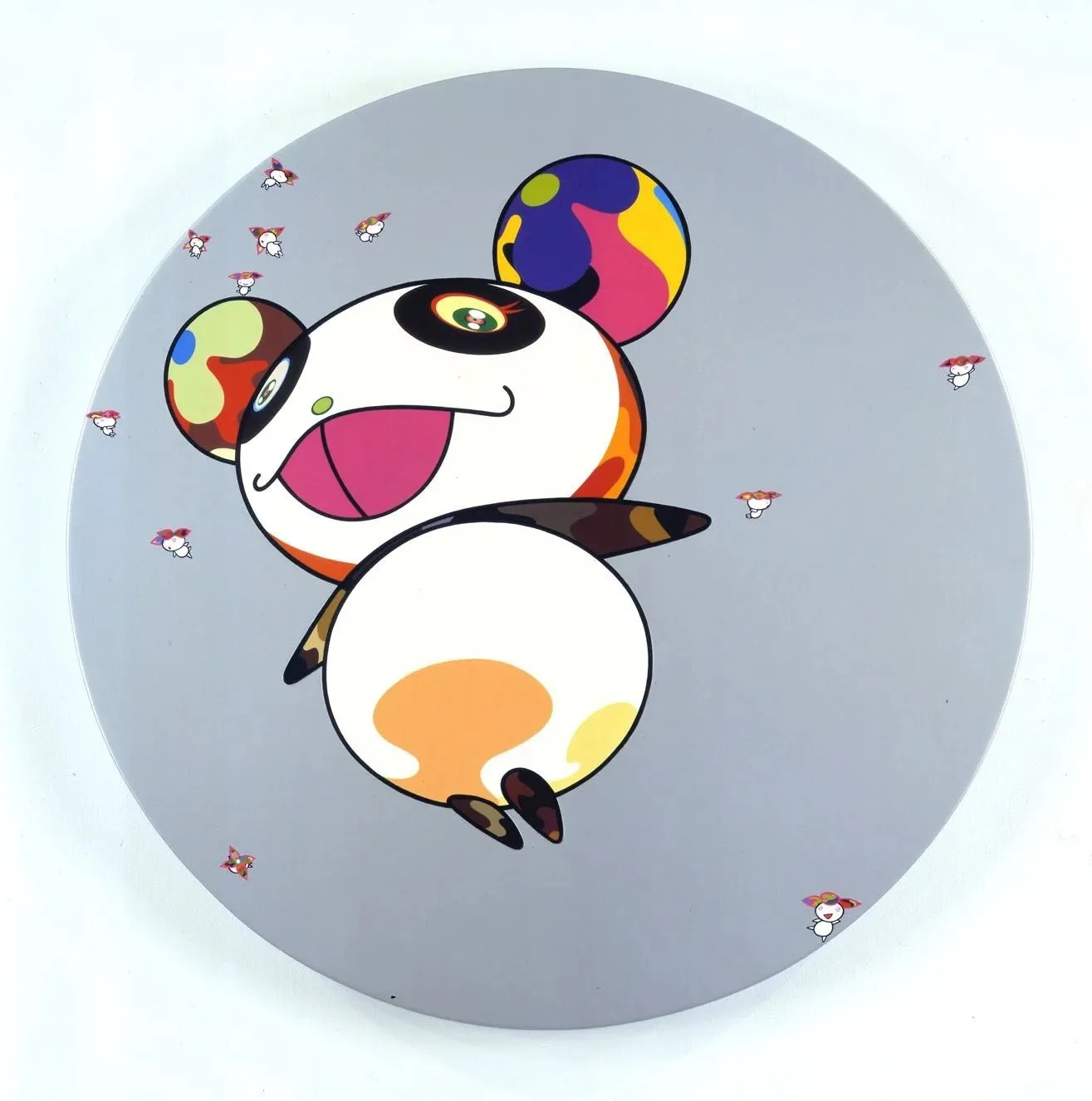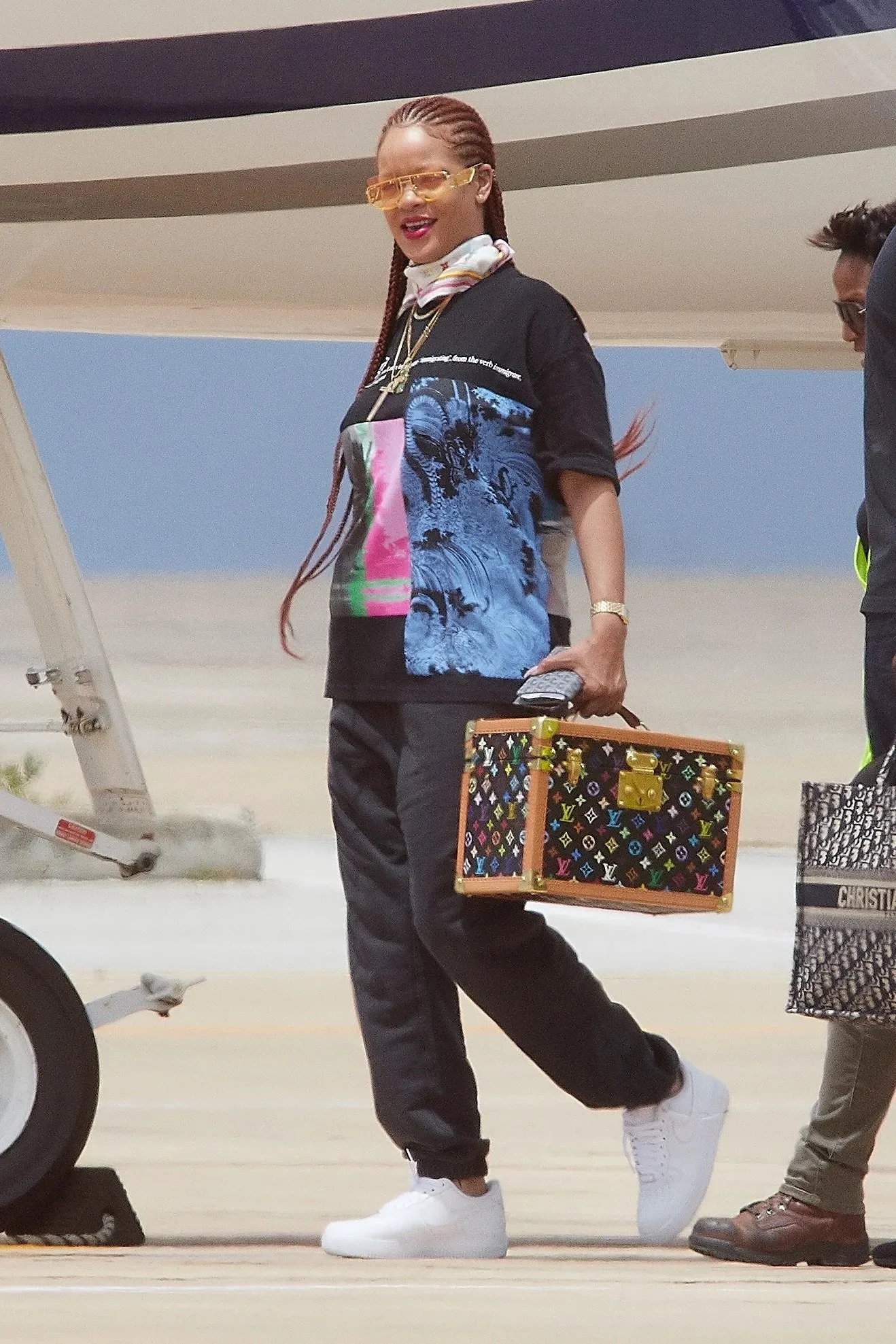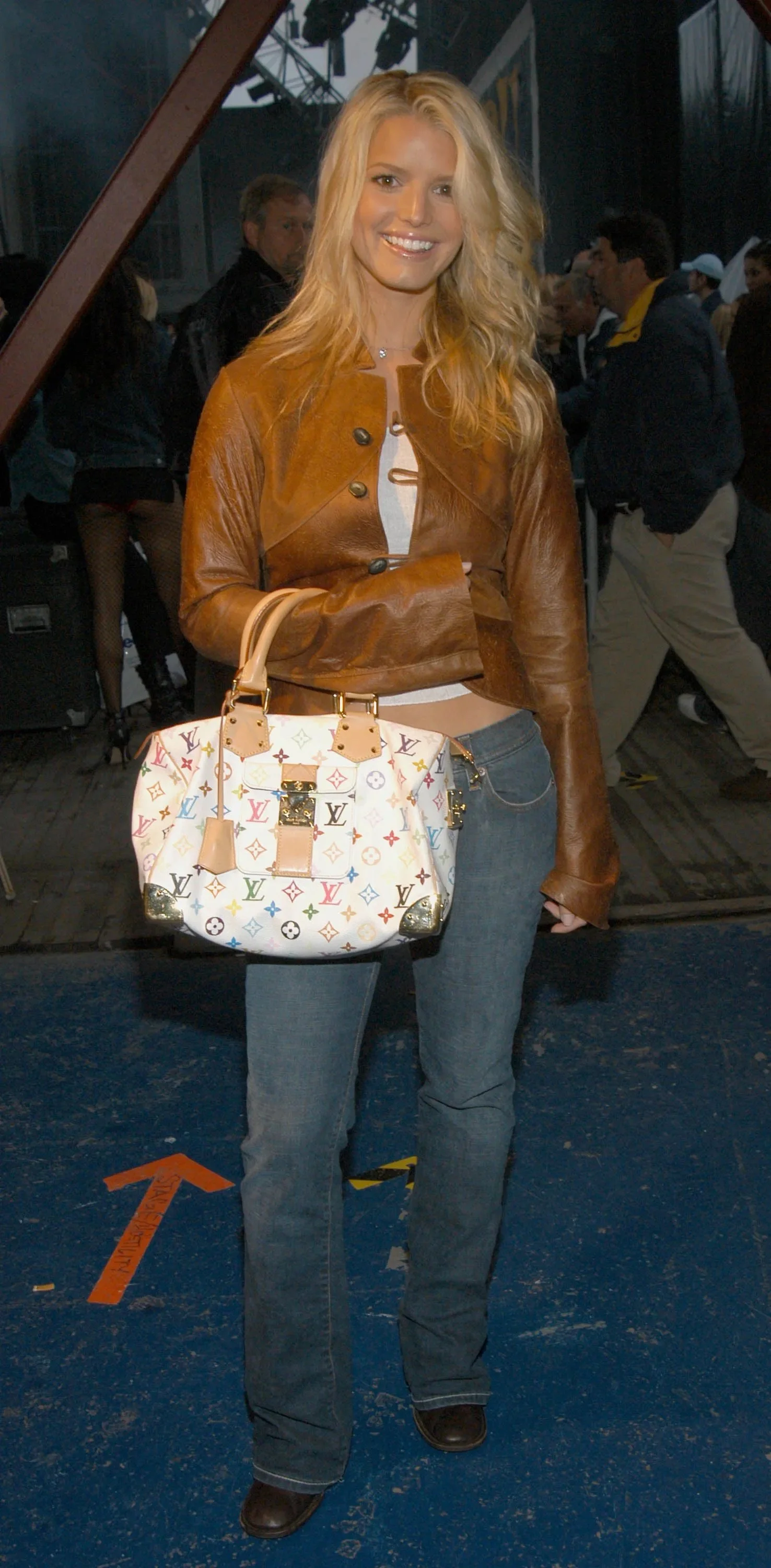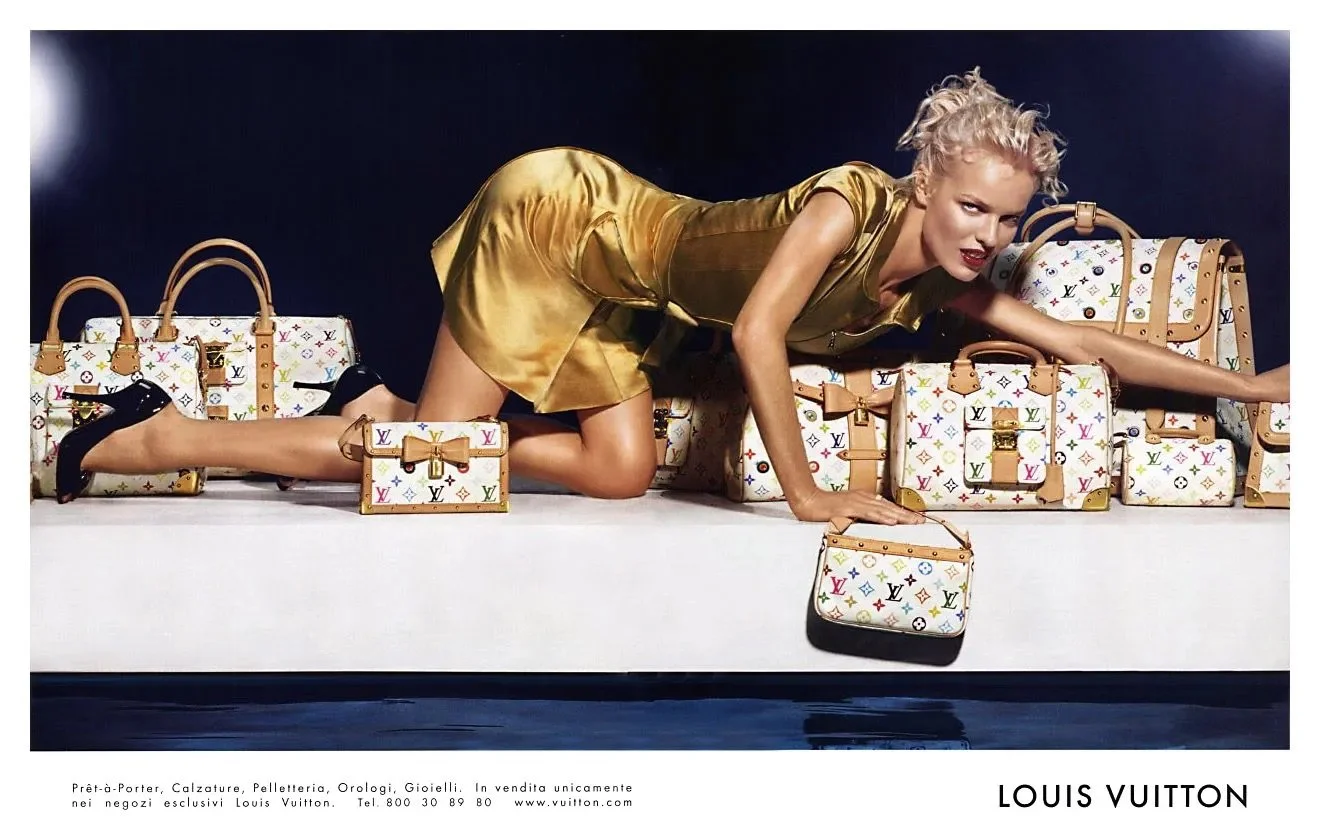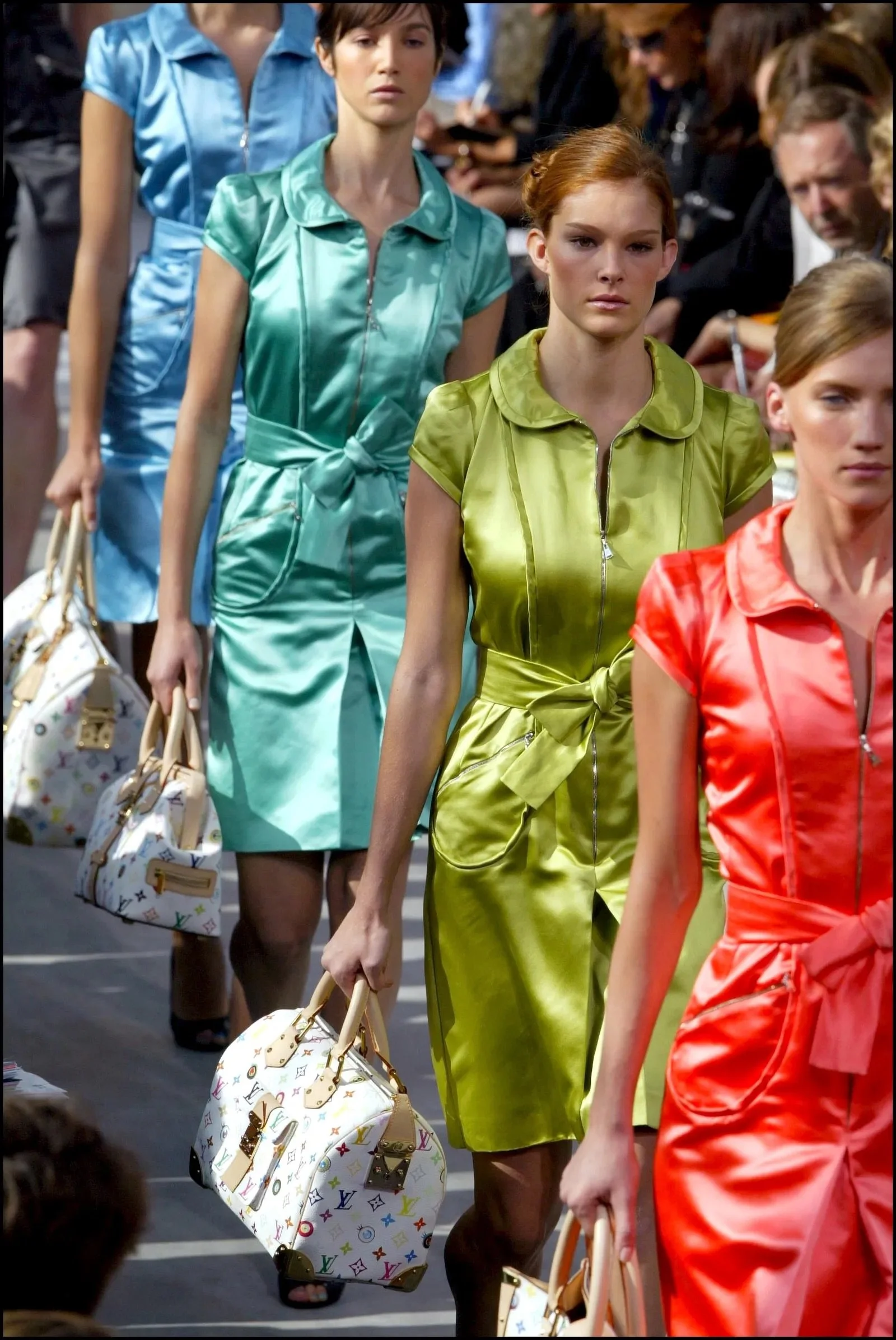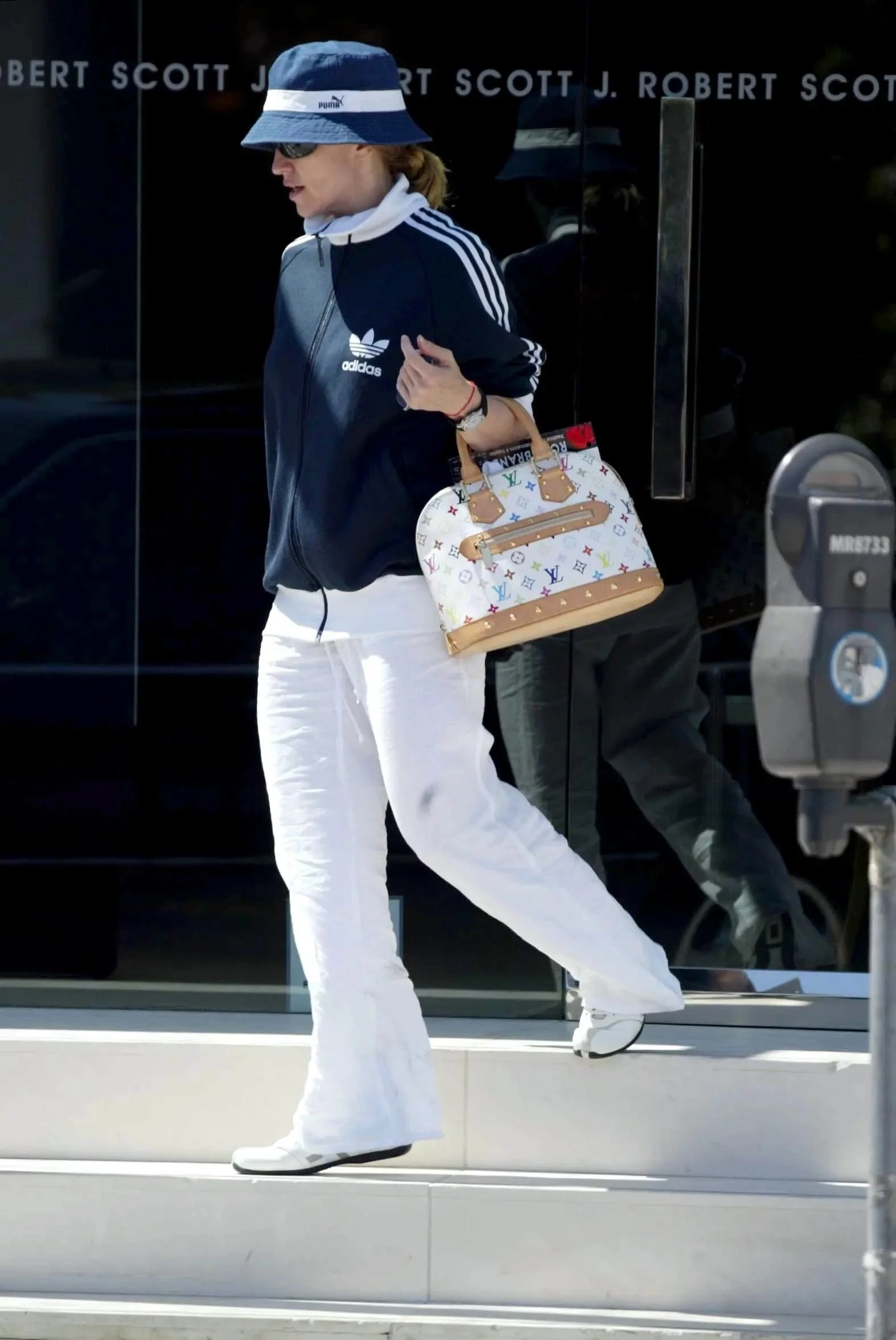Louis Vuitton
Spring/Summer 2003
Louis Vuitton Spring 2003 Ready-to-Wear
October 6, 2002
Written by Sarah Mower
Marc Jacobs' latest for Louis Vuitton is so very kawaii (that's Japanese for "cute") it's going to drive young women everywhere utterly nuts. Girl nation was thrown for a loop when the designer sent out a pastel-rainbow troupe of sweethearts in duchesse-satin zip-up dresses with Peter Pan collars. They tripped along carrying the latest monogram bags, perked up by computerized prints of little flowers and cartoon creatures, the work of the latest LV guest artist, Takashi Murakami.
The collection radiated a sunny '50s- and '60s-style optimism via little dresses, jackets, swingy skirts, knits and bathing suits finished with minute edgings of frills and tiny bows. There were strappy dresses with raised waists, some formfitting and others flared, done in a palette that ranged from the prettiest champagne through rose, lemon, pistachio and sky-blue. Even the swimsuits had that cute flip of a modesty flounce circa 1960.
In this, his third stellar collection of the season, Jacobs proved just how adept he is at merging happy retro memories and modern pop culture. His smartest crossover moves? Morphing rubber into cherry-red polka-dot pencil skirts, macs and suits decorated with 3-D flowers, and cutting ladylike jackets and coats out of printed neoprene. Add in jokey Minnie Mouse bows on peep-toe slingbacks and the result was a collection that will have lines forming around the block at Louis Vuitton stores from the first day of spring.
Louis Vuitton, Spring/Summer 2003,
October 7, 2002
Getty Images
Photography by Stephane Cardinale
People at the Louis Vuitton, Spring/Summer 2003,
October 7, 2002
Getty Images
Photography by Stephane Cardinale and Jean-Pierre Muller
The Collections / Paris : Around the world hits from Vuitton, Lanvin and Galliano
October 8, 2002
International Herald Tribune
Written by Suzy Menkes
Giant balloons in whimsical shapes and sweet colors floated across the blue Parisian sky to herald Louis Vuitton's homage to Japanese artist Takashi Murakami. This imaginative collaboration not only gave the house's traditional monogram a new and kooky look, but inspired a splendid collection from Marc Jacobs — and one that underscored the theme of the spring/summer 2003 shows: taking inspiration from other cultures, but bringing the clothes back to the beating fashion heart of Paris.
"It's about Paris — mon amour," said Jacobs backstage as he showed off the bags with animated cartoon images to Bernard Arnault and his wife Helene.
Out of this to-and-fro cultural movement came clothes with the cute, girly spirit that Jacobs and young Japanese women adore in equal measure: frilly cardigans, polka-dot skirt hems, dotted Swiss blouses — and more bows, on shoes, pockets, shoulders and waists than you would have found in Madame de Pompadour's closet.
The collection had that frisky rococo lightness, with its frilled high-waist skirts and succulent colors, not least for the slender, zippered satin dresses that opened the show in a rainbow of butter yellow through pink, mauve and sky blue. But the show was also modern in its use of neoprene fabrics from the ubiquitous scuba and surfboard influences.
Jacobs is doing a great job at Vuitton, never trying to hide the fact that the bags are the Sushi rice staple and the rest just delicious ingredients. So he works on the purses, bold totes and cutie-pie clutches, sometimes scattering flowers on the classic brown monogram. Yet the clothes were also first-rate, from the fitted leather jackets to the coat with a Japonisme print or even dresses made of rubber and appliquéd with flowers like bathing caps. It was the best example so far of picking a theme and watching it levitate, like those balloons. […]
WORLD COLLECTIONS 2003 SPRING & SUMMER: PARIS, MILANO, NEW YORK, LONDON
2003年春夏 パリ、ミラノ、ニューヨーク、ロンドン・コレクション。
February 2003
High Fashion No.289
Photography by Shin Shin and Masatoshi Uenaka
Report and text by Ikuko Fujii and Misako Tamagawa
ルイ・ヴィトン
マーク・ジェイコブス
今回の話題はなんといっても画家の村上隆とコラボレートした、カラフルな21世紀のモノグラム。モノグラムはジャポニスムが発端だったが、今回登場した和柄の花プリント、墨色や抹茶色、小豆色なども村上とのコラボレーションに影響されたマーク流ジャポニスムの表現。それらとマルチカラーやフリルやコサージュのドレス、リボンの装飾がスポーツウェアの素材と一体化して、’60年代のブリジット・バルドーがイメージという、パリのセクシーガールたちを作り上げた。
Louis Vuitton
Marc Jacobs
The talk of the town this season is the colorful 21st-century Monogram, created in collaboration with painter Takashi Murakami. The Monogram was originally inspired by Japonisme, and the Japanese floral prints, black ink, green tea, and azuki bean color are all expressions of Marc's Japonisme influenced by his collaboration with Murakami. These are combined with multi-colored, frilled, corsage-adorned dresses, and ribbon decorations, and sportswear materials to create sexy Parisian girls reminiscent of Brigitte Bardot in the 1960s.
Eye
March 2003
i-D No.229 THE BEACH ISSUE
Photography by Cyrus Marshall
Edited by Mark Hooper
FEMININE
After all the silly sportswear, serious sportswear, geishas and punks, there had to be something sincerely pretty. There was: 1950's femininity. Stuart Stockdale, fresh blood at Pringle (trying to do 'a Burberry'), paid homage to '50s Sweater Girls with sunray pleated skirts and argyle sweaters. However, it was mainly a polished New Yorker thang. Donna Karen's sharp shouldered suits, open-toed sandals and printed halter dresses (okay then, so they were a bit '40s, but you get the idea) were a lesson in feel-good old fashioned glamour. Zac Posen, determined to become New York fashion's Golden Child, sexed up his Hollywood Heyday aesthetics with shorter flirty lengths and buckled strapping, whilst Marc Jacobs fused '50s suburban American housewife with 'cool': prim bracelet-length sleeved jackets, nubbly Chanel- esque tweeds and sexy camisoles, all in a palette of frosted pink, coral, lemon and nude. For the lads, there were lean suits with skinny ties to wear with pretensions of being like a drunken Jackson Pollock in Greenwich Village. Jacobs explored this elegance further at Louis Vuitton in Paris with a parade of girls all wearing the same fitted satin dress but in a rainbow of different colours, their hair scraped back into a high flipped ponytail and eyes rimmed with blue shadow. But the show, inspired by clichés of femininity and literally covered with bows (a giant one for a bra, as a trim on high peep-toe stilettos, decorating the keyhole cut-outs on clingy dresses), was far from saccharine sweet. Polka dot printed pencil skirts and trench coats, and dresses and jackets decorated with flowers, were all sliced from rubber. Will somebody please pass the talcum powder?
MARC JACOBS
what inspired your show and why? We were inspired by many things (as always): among them lingerie, swimwear, the female body, Brigitte Bardot, French girls and the work of Takashi Murakami what are the key looks for Spring-Summer? I loved the duchess satin "coiffeur" dress, the scuba/swimwear and all of the bags what will you be wearing this season? What I wore all winter, minus the long underwear and anorak - basically, pants, T-shirt and sweater accessory of choice? Any of the bags we did with Takashi Murakami which word sums up your mood right now? Happy favourite summer song? Teenage Riot by Sonic Youth favourite beach? It's been so long since I've actually been to a beach (probably explaining the vicarious thrill of the summer collections!)
Louis Vuitton × Takashi Murakami
February 2003
High Fashion No.289
Photography by Shin Shin and Masatoshi Uenaka
Report and text by Ikuko Fujii and Misako Tamagawa
マルチカラーのモノグラムが誕生
「カワイイ」キャラクターとカラフルなモノグラムのアドバルーンが浮かんだコレクション会場にて行なわれたルイ・ヴィトンのショーを彩ったのは、マーク・ジェイコブスと村上隆のコラボレーションによる新作バッグ。スティーヴン・スプラウス、ジュリー・ヴァホーヴェンに続くプロジェクトは「子どものように無邪気でありながら、皮肉で陰のある村上の作風にひかれた」マークのラブコールによって実現。そして誕生したのが、カラフルな「ニュー・ムラカミ・マルチカラー・モノグラム」、そこに目のモチーフを加えた「アイ(Eye) ラブ・モノグラム」、桜の〝おはな〞を重ねたものの3種類。100年以上前に、ジャポニスムの影響から生まれたモノグラムは今また現代日本のポップカルチャーと出会い、進化した。
The Multicolored Monogram Is Born
Held at a venue with floating "kawaii" characters and colorful monogram advertising balloons, the Louis Vuitton show was dominated by new bags created as a collaboration between Marc Jacobs and Takashi Murakami. Following in the footsteps of Stephen Sprouse and Julie Verhoeven, this project came about after Marc, "attracted to Murakami's style, which is childlike and innocent, yet ironic and dark," sent a love call to the artist. Thus was born three types of monograms: the colorful “New Murakami Multicolored Monogram,” the “Eye Love Monogram,” to which an eye motif was added, and one with overlapping cherry blossom blooming. The monogram, which was born from the influence of Japonisme more than 100 years ago, has now evolved again in response to meeting contemporary Japanese pop culture.
Louis Vuitton, Spring/Summer 2003 Advertising Campaign
2003
Photography by Mert Alas and Marcus Piggott
Modelling by Eva Herzigova
Superflat Monogram Film
2003
Directed and produced by Takashi Murakami
Takashi Murakami: Superflat Monogram
April 11 - May 10, 2003
Marianne Boesky Gallery
Marianne Boesky Gallery is pleased to announce a new exhibition of works by Takashi Murakami.
Over the last five years, Takashi Murakami has emerged as the leading force in the encouragement, articulation and development of an only recently acknowledged contemporary Japanese art culture. As an artist, theorist, and curator, he has put forward an elaborately conceived view combining a thorough understanding of western modernism, traditional Japanese art history, and contemporary consumer culture.
This spring, Murakami unveils a new collaboration with Louis Vuitton and Marc Jacobs. He was invited to collaborate with the designer on a new line of handbags and merchandise, even going so far as to redesign and update their logo. The product launch in Louis Vuitton stores has already begun.
At the same time, for his third solo exhibition at Marianne Boesky Gallery, Murakami collaborates using his own designs and characters created for Louis Vuitton in another context. The paintings and sculptures will display the elaborate and colorful motifs emblazoned on these commercial products. The surfaces and attention to detail are signature to Murakami’s style of art making. Other than the content, these paintings still contain the elements of Murakami’s true painting—superflat, minimalism, abstraction, and representation. By boldly agreeing to do this project, Murakami moves beyond the art of merely appropriating pop culture imagery, to an all too questionable realm of art as commerce. As Murakami continually emphasizes, the boundaries between commercial works and fine art is malleable, and the patterns and decorations of both can be illuminating.
Murakami’s aesthetic agenda encompasses myriad activities. Along with the many exhibitions of his artwork (including solo exhibitions at the Fondation Cartier in Paris, Serpentine Gallery in London, Museum of Contemporary Art in Tokyo, Boston Museum of Fine Art), he has curated several important exhibitions, such as “SUPERFLAT” and “Coloriage”, which champion a specifically Japan-centric view of modern and contemporary visual culture. Murakami also has organized his own art festivals in Japan (called “Geisai”), and he continues to design and market consumer goods—t-shirts, watches, mousepads, postcards, etc.—disseminating his signature images to an increasingly wider cultural spectrum.
Murakami (Installation View)
Marianne Boesky Gallery, New York, 2003
Panda, 2003
Acrylic on fiberglass with antique Louis Vuitton trunk
100 1/2 x 65 x 43 inches
Edition of 3
SUPERFLAT Monogram, 2003
Acrylic on canvas mounted on wood
15 3/4 x 15 3/4 inches
40 x 40 cm
TM.0352
Eye Love SUPERFLAT, 2003
Acrylic on canvas mounted on wood
15 3/4 x 15 3/4 inches
40 x 40 cm
TM.0354
Eye Love SUPERFLAT, 2003
Acrylic on canvas mounted on wood
15 3/4 x 15 3/4 inches
40 x 40 cm
TM.0355
SUPERFLAT Monogram, 2003
Acrylic on canvas mounted on wood
39 3/8 x 39 3/8 inches
100 x 100 cm
TM.0363
SUPERFLAT Monogram, 2003
Acrylic on canvas mounted on wood
70 7/8 x 70 7/8 inches
180 x 180 cm
TM.0364
LV Monolith, 2003
Acrylic on canvas mounted on wood
59 x 59 inches
150 x 150 cm
TM.0377
Creature of the Sphere, 2003
Acrylic on canvas mounted on wood
27 1/2 inches diameter
70 cm diameter
TM.0378
Cherry Blossoms Blooming, 2003
Yuzen folding screen with platinum patina artist's frame
15 1/4 x 86 5/8 inches 38.74 x 220 cm
TM.0376
The Murakami Effect: Newness in Handbags Key to Luxury Growth
July 21, 2003
WWD
Written by WWD Staff
The season’s hottest handbag - the Vuitton Murakami - symbolizes the need for newness to generate growth for luxury companies.
Never mind the 35-hour work week in France. Louis Vuitton has one factory, the only one in the country it says is capable of printing 93 colors on canvas, working around the clock, seven days a week.
It’s all to meet lusty demand for its multicolor monogrammed handbags, the product of the blockbuster collaboration between Vuitton creative director Marc Jacobs and the Japanese artist, Takashi Murakami, often described as the Andy Warhol of his generation.
According to market sources, sales of the Murakami bags are likely to reach at least $345 million this year, roughly 10 percent of Vuitton’s total revenues. Dollar figures have been converted from the euro at current exchange. Luxury giant LVMH Moët Hennessy Louis Vuitton declined to provide any sales figures, but luxury analysts described those estimates as credible.
The phenomenon has helped Vuitton defy gravity at a tough time for luxury. But it also begs the question: What can be done for an encore?
“It makes it very scary for my team. I don’t know what I’ll do to top this,” Jacobs acknowledged in a recent interview. “When we saw the first prototypes, we were all very excited….But the reach of it, we had no idea. I love that we’re involved in the creation of something that almost seems historic.”
Historic, indeed, and emblematic of the accessory market’s growing hunger for new products and new ideas, luxury firms and retailers agree.
“We are addicted to newness. It’s the rhythm of the company,” said Sidney Toledano, president of Christian Dior, which recently rushed to the market, several months early, its Hardcore Dior, a handbag made of silk jersey and loaded with metal hardware. “In a crisis period, this is even more important.”
Even luxury analysts, who tend to crunch numbers more than mull the merits of the latest shoulder jewels, are watching carefully.
Antoine Colonna, analyst at Merrill Lynch here, said he considers “critical” the percentage of sales a luxury firm derives from new products, as it highlights “the ability of a company to innovate, particularly vis-à-vis its competition.”
“I think it is more important for a brand to have a good portion of its sales, around 15 percent, stemming from new products,” agreed Antoine Belge, analyst at HSBC in Paris. “Otherwise, the brand can start to be perceived as not dynamic and lacking innovation.”
He noted that Cartier, for example, blamed its declining momentum on the fact that new products represented only 5 percent of sales versus an ideal target of 15 percent. Likewise, “I see Hermès’ nomination of Jean Paul Gaultier [as its new women’s ready-to-wear designer] as an acknowledgement of a need to appear more trendy and innovative,” he added.
Retailers echo the sentiment.
“The newness factor is extremely important,” said Jaqui Lividini, senior vice president of fashion merchandising at Saks Fifth Avenue. “There’s a fashion customer who really wants that new hot bag.”
Saks doesn’t carry the Murakami bags, but feeds off the brand’s momentum. “There is also the core customer who just wants the Vuitton bag and it’s the name that she wants,” she said. “There’s status in the label and that’s enduring.”
Majed Al-Sabah, owner of the Villa Moda luxury emporium in Kuwait, said handbags represent almost three-quarters of his business — and the same old, same old won’t cut it with his clients.
“We have a reality that every client must own four to six new handbags a season and they must be changed every season to the new styles,” he said. “This is one of the reasons there’s no business for Hermès in this part of the world, since no one believes you can live with your handbag more than one season.”
That’s why Al-Sabah cautions against gimmicks like reintroducing or reinterpreting vintage pieces from past collections. “This will kill the industry if overused,” he warned. “What we need these days is creative retail environments.”
In interviews with luxury presidents about hot handbags, all put the accent on new products as a vital ingredient in driving business.
“It’s part of our way to always show new things to the customer,” said Chanel president Françoise Montenay. Apart from a limited number of classic handbags that are replenished continually, at least 80 percent of the Chanel offering in the category is new each season, she noted. Even staples, like quilted handbags with chain handles, are refreshed in new colors and materials.
“Because we are in fashion, and we have very faithful customers, they come back to us often,” she said. “And they know if they don’t buy it now, they won’t get it in three months.”
In fact, Chanel now introduces eight collections of ready-to-wear and accessories each year, underlining the importance of “newness” in today’s market. Montenay noted that even classic Chanel footwear styles, like the ballerina slipper, are redesigned every few years to reflect subtle changes in fashion.
Dior’s Toledano also mentioned the importance of permanent products, like its Lady Dior and Saddle bags, which are refreshed in new proportions, colors and materials regularly. “We just presented a new jeans version of the Lady Dior,” Toledano said. “But then you still have people willing to buy it in black.”
Still, new products represent about 20 to 30 percent of Dior’s handbag business.
“For me, luxury doesn’t only mean quality and tradition. It’s also the mood of the moment,” Toledano said. “Even in retail, you have to come up with new ideas.”
At Fendi, about 4 to 5 percent of sales in 2002 were generated by new products, according to chief executive Giancarlo Di Risio. But he said this number grew to 10 percent in the first months of this year, “and we expect a 20 percent growth in the second semester because we added new appealing products that created a lot of interest,” he said. “Consumers must always be stimulated, and it is very important to reawaken their interest.”
Among the new styles expected to garner interest this fall is the Chef bag, which Di Risio said “plays with volumes, softness and unexpected ruches, in different variations.”
Prada, where handbags and leather goods accounted for nearly a third of its sales last year, is banking on a structured rectangular handbag to drive sales this fall, according to a spokeswoman. The bag, which bowed on the Milan catwalk last March, comes in anything from crocodile to hammered leather, with interchangeable handles.
Meanwhile, Yves Carcelle, president of Louis Vuitton, characterized the Murakami craze as a “reinvention of the monogram” and “not a marketing coup.”
“For the first time in history, we authorized the monogram to change because it was a strong creative approach,” he said in an interview. “I’m sincerely proud that, thanks to Marc, we can associate our name with someone of [Murakami’s] talent.”
Vuitton shipped the first of its Murakami styles, including a limited-edition style with eyeballs mingling with Vuitton icons, for spring retailing. The multicolor monogram with a black background began arriving in stores last month and fall will see the arrival of new versions mixing the monogram with animal prints, and others interpreted in silk jacquard for evening.
Vuitton has a multiyear contract with Murakami and considers the multicolor monogram a permanent part of its line.
Carcelle said Vuitton’s new styles have a six- to seven-year life span and some styles, like its Keepall travel bag, introduced in 1924, remain top sellers.
“We have the right balance between eternal products and eternal values and very creative products each season,” he stressed.
When Jacobs arrived as Vuitton’s creative director in 1997, one of his first “bags of the season” was in pastel Monogram Vernis, a glossy patent leather with Vuitton icons in relief. Carcelle noted that two new colors last season, lavender and fuchsia, were sufficient news to lift overall Vernis sales 50 percent.
Carcelle said ventures like the Murakami collaboration “create an excitement about the brand.”
Louis Vuitton first discovered the power of a strong creative collaboration last spring, when Jacobs enlisted New York designer Stephen Sprouse to cover the sacrosanct LV monogram with his signature graffiti. Although produced in limited numbers, it created a buzz around Vuitton and unleashed a torrent of counterfeits and a trend in accessories still reverberating in the mass market.
And so, will the next excitement come from another artist?
“If we do three times the same, it becomes boring,” Carcelle said with a laugh and a sly smile. “The excitement can come from other things — for example, having Jennifer Lopez in our advertising campaign next season, which is a totally different excitement.”
He also noted that 2004 marks the 150th anniversary of Louis Vuitton, and cited the appearance of its brown monogrammed canvas on the men’s wear runway for spring 2004 last month as a significant statement.
For his part, Jacobs balked at the suggestion another collaboration might be looming.
“We made a creative decision to collaborate with artists on our bags,” he said. “But it doesn’t mean we always will….I hate the idea of something becoming a formula. If we do it again, it’s not because it’s a formula, but because it’s something I believe in.”
Top 10 Everything 2003
December 18, 2003
Time
Written by Kate Betts
1. Louis Vuitton's Murakami Bag
Marc Jacobs is no fool. Knowing that Japanese women are his most important customers at Louis Vuitton, he collaborated with Japanese artist Takashi Murakami on what may just be the best-selling handbag of all time: a tacky white Vuitton confection with bubblegum bright logos and funny characters splashed all over it. Even the $1,200 price tag didn't stop Madonna, Gwyneth and Renee from carrying it. And the sales for this bag alone bagged over $350 million for Louis Vuitton, proving that neither luxury nor status are dead.
Louis Vuitton is Discontinuing Its Iconic Murakami Monogram Bags
July 17, 2015
stylecaster
Written by Jasmine Garnsworthy
Louis Vuitton's losing the iconic Murakami logo.
Before everyone wanted to carry Mansur Gavriel’s minimalist bucket bag, Alexander Wang’s studded Rocco bag even hit stores, or Givenchy’s Antigona duffel became a street style phenomenon, the celebrity crowd was obsessed with Louis Vuitton’s Takashi Murakami-designed Mulicolore monogram collection. Now, the bag—synonymous with early-2000s style—is officially no longer.
According to WWD, an employee at the Louis Vuitton’s Saks New York store on Fifth Avenue said the collection will be “leaving stores at the end of July, forever.”
The bags first made a splash in 2003, just as Paris Hilton was hitting the peak of her pop culture career with “The Simple Life,” Jessica Simpson was the Kim Kardashian of the tabloids, and Mary-Kate and Ashley Olsen were bag ladies teenagers fond of bug-eyed sunglasses and Venti lattes.
Marc Jacobs, then the label’s creative director, called on pop artist Murakami to redesign Louis Vuitton’s Spring/Summer 2003 accessories range, and the result was a candy-colored explosion that included the rainbow-colored monogram, as well as collections emblazoned with bright cherry blossoms and Panda Geant characters—all a departure from the brand’s signature brown and tan palette.
Inevitably, the Murakami monogram collection spawned millions of knockoffs and had women everywhere clamoring to own a piece—especially given it its placement in the tabloids thanks to fans like Hilton, Simpson, Nicole Richie and other early-aughts starlets.
Right now you can still shop a small collection at Saks, and WWD reports the “multicolore monogram designs are not on display at Louis Vuitton’s 57th Street flagship location in Manhattan, but salespeople will present merchandise to shoppers upon request.”
Until they sell out, of course. After that, it’s straight to eBay.
Louis Vuitton to Discontinue Takashi Murakami Multicolore Monogram Collection
July 17, 2015
WWD
Written by Misty White Sidell
Louis Vuitton's Murakami collaboration — which first debuted at the brand’s spring 2003 fashion show — is presently being phased out of stores.
Louis Vuitton is discontinuing its Takashi Murakami-designed Multicolore monogram collection.
The artist collaboration — which debuted at the brand’s spring 2003 fashion show during Marc Jacobs’ stewardship of the French label — is presently being phased out of stores. A store associate at Louis Vuitton’s Saks Fifth Avenue shop-in-shop in New York City told WWD that the collection is “leaving stores at the end of July, forever.”
A vitrine devoted to what remains of the collection’s 12-year history — a few handbag styles, a belt, and assorted small leather goods including wallets and a bracelet — stands near the salon’s entrance.
Multicolore monogram designs are not on display at Louis Vuitton’s 57th Street flagship location in Manhattan, but salespeople will present merchandise to shoppers upon request — until the collection’s official departure from stores. Procedures at other stores could not be learned.
Representatives for Louis Vuitton, which is now helmed by Nicolas Ghesquière, declined to comment on the collection’s termination, noting that the brand prefers to “look forward.”
Louis Vuitton’s Multicolore monogram collection is the longest lasting of the label’s many collaborations with Murakami — who also re-envisioned the brand’s classic monogram with pink cherry blossom and camouflage motifs.
But it was the multicolored monogram, particularly the collection’s take on Vuitton’s Speedy style, that was most beloved by early-Aughts celebrities. Stars including Anna Kournikova and Paris Hilton were snapped by paparazzi wearing the design, and Jessica Simpson brought the purse on a camping trip to Yosemite in an episode of her MTV reality show “Newlyweds.” The style was an “It” bag in 2003 through 2004.
During his 16-year tenure at the label, Jacobs also collaborated with artists Richard Prince, Yayoi Kusama and Stephen Sprouse. The last remaining collaboration from his time at the label to still be produced is Vuitton’s tie-up with Jacobs’ friend and fan Sofia Coppola. The “SC” collection will continue with a new range of color ways this coming fall.
This Was The Defining Fashion Collaboration Of The Noughties
November 11, 2020
British Vogue
Written by Alice Newbold
You might fondly remember the Louis Vuitton x Murakami Speedy bag as one of the handbag highlights of the early aughts. The artist Takashi Murakami’s take on the brand’s monogram canvas city holdall was the It-bag of choice for Paris Hilton, Lindsay Lohan and Jessica Simpson circa 2003. The latter celeb even took her rare Speedy on a camping trip to Yosemite in her MTV reality show, Newlyweds. Fast forward to 2020, and modern-day fashionistas who are obsessed with that era’s style – including Kendall Jenner and Bella Hadid – are the ones carrying Murakami’s splashy Speedy.
The collaboration, which premiered on the spring/summer 2003 runway, was not limited to the compact bowling bags. Creative director Marc Jacobs, who was at the helm of the French house from 1997 to 2013, invited Murakami to makeover Louis Vuitton’s signature monogram collection with his distinctive colour-pop palette. From the elegant Alma to the distinctive Papillon, logoed LV bags were made riotous with injections of hot pink, turquoise, yellow and kelly green.
Monogramouflage and Cherry Blossom collections followed, as Murakami lent his cartoon-like artwork to Louis Vuitton accessories (some even featured manga-inspired characters nestled between LV stamps). With a wave of a monogrammed paint brush, the artist, who is famed for mixing high art with popular culture tropes, revitalised the heritage brand’s classic accessories and catapulted Louis Vuitton to mainstream media attention.
“Our collaboration has produced a lot of works, and has been a huge influence and inspiration to many,” Marc Jacobs said in 2009, when the Bilbao Guggenheim staged an exhibition of Louis Vuitton x Murakami designs. “It has been, and continues to be, a monumental marriage of art and commerce. The ultimate crossover – one for both the fashion and art history books.”
Indeed, the collaboration was so popular that it was only phased out of stores in the summer of 2015, under the stewardship of current creative director Nicolas Ghesquière. During the 12-year Louis Vuitton x Murakami tie-up, the Multicolore monogram line was the most popular and each style has become a status symbol in its own right. The rarity of the pieces continues to drive up the price tags of the bags on second-hand platforms and consignment sites – particularly in 2020, when there is a lot of interest in the major commercial bag successes of the ’90s and ’00s. “We are always on the hunt for these one-of-a-kind items or pieces that will stand the test of time,” Rewind Vintage Affairs founder and CEO, Claudia Ricco, recently told British Vogue of the lucrative resale market for limited-edition lines.
This now-iconic meeting of brand and artist was not a new concept for the house. In the ’20s, the grandson of its founder Gaston-Louis Vuitton, who would later take the reins of the company, was a keen collector of artworks. His invitation to artists to deck out Louis Vuitton store windows sowed the seeds for the vast array of special projects Vuitton has conducted with creatives ever since. Prior to Murakami, Marc Jacobs commissioned Stephen Sprouse to graffiti over Louis Vuitton bags with his signature scrawl. It was a bold move for a brand that had originally held its logo as sacrosanct, but ultimately paid off and paved the way for others to reimagine the LV lettering.
Following Murakami, Louis Vuitton gave free reign to American painter Richard Prince and Japanese artist Yayoi Kusama to transform its leather goods in innovative ways that would cut through the mass market. James Turrell, Olafur Eliasson, Damien Hirst and Daniel Buren also put their stamp on the house’s insignia via in-store and runway artworks. And the current ArtyCapucine collection sees the work of six contemporary artists – Beatriz Milhazes, Henry Taylor, Liu Wei, Josh Smith, Jean-Michel Othoniel and Zhao Zhao – emblazoned on the front of the brand’s ladylike Capucine bags.
The affectionately-called ArtyCaps build on the special relationship between Louis Vuitton and the arts. Almost a century down the line, its commitment to innovation and raising up the work of creatives via its global platform is not to be underestimated. As Jacobs said, it’s monumental. And, as Ricco attests, these unique collections will never go out of style.
Contemporary Art in Japan and Cuteness in Japanese Popular Culture
August 2005
University of the Arts London
Written by Paul J. C. Sutcliffe
Returning to Murakami's smiling flowers, these entered mass consciousness when the results of his collaboration with Louis Vuitton went on sale in February 2003. Murakami's new design for the bags range from a simple rendering of the familiar logo in bright colors, to cartoons of smiling blossoms, eyes and pandas that look as if they have been painted over the classic monogram. Outside the venue at the Louis Vuitton catwalk show in Paris, where the bags were unveiled, huge balloons of the artist's characters crowded the skyline.
The illustrations also feature cherry blossoms, a traditional symbol of Japan, and perhaps a reference to the first Louis Vuitton flower and circle design introduced in 1896, which was inspired by Japonisme, the post-Impressionists' re-interpreting of the Japanese aesthetic in the decorative arts, which was popular in Paris at the beginning of the 20th century. Lise Skov argues that in the concept of Japonisme there is an idea of a binary opposition, Japonisme as ‘exotica’ and ‘postmodernism's promise of a collapse of cultural hierarchies.’ (Skov 1996, 139) The point is, not to recover the origin, or nature of postmodernism, but focus on ‘the synchronism of a number of occurrences which can be loosely grouped around the concept.’ (Skov 1996, 140)
While the increasing popularity of manga and anime might perhaps represent a new Japonisme, a new confidence for Japan, Murakami worries if the collaboration might be too much for his own home market. Louis Vuitton, one of the best selling designer labels in Japan, is a high status brand, with an exclusivity not seen in normal consumer goods, often with limits on the number of items a customer is allowed to buy at any one time, for example. ‘The people at Japanese Louis Vuitton and I were wondering, if it has been touched by a Japanese creator, can it keep its value for the Japanese people?’ he says. (Porter 2002, 8)
The new bag designs highlight a change in Murakami's position since his early works. The Randoseru Project 1991 was a set of randoseru (children's leather backpacks) produced under the artist's direction. One set of eight backpacks replicates the simple design in exotic animal skins including caiman, cobra, ostrich, hippopotamus and whale, a gesture that also connects these conceptual artworks to the elegant luxury leather goods marketed to those with increasing disposable income. Murakami traces the form of this ubiquitous grade school uniform accessory to Meiji-era military design, and links it to the lingering symbolism of the Imperial system and militarism in the national education program. He also alludes to the historic discrimination against Burakumin leatherworkers. Murakami himself suggests a change alluding to a shift from earlier more cultural concerns.
Now my concept is more pure: I want to make what I like to make. Right now the young female audience is the hardest to attract, and the challenge of my newest work is to get popular with that group. (Murakami quoted in Friis-Hansen 1999, 31)
An Invitation magazine cover shows the widespread coverage the Louis Vuitton collaboration received in Japan. Murakami's designs on haute couture bags, his entering into high fashion design blurs the distinction between an artistic statement on the lines of a multiple edition readymade on the one hand, pure commodity object on the other. Following the success of the collection with Louis Vuitton, Murakami, in a collaboration with animator Hosoda Mamoru and producer Takashiro Tsuyoshi, also created a Louis Vuitton animation, which Hosoda refers to as a promotional video, (Nagae 2003, 43-45) but Louis Vuitton CEO Yves Carcelle refers to as more of an independent artistic work, funded by Louis Vuitton as a contribution to contemporary art. Again the status is confused. Takashiro refers to the cuteness of the characters in the animation, and Hosoda, while acknowledging cuteness has recently spread all over the world, expresses doubts over the girl, the main character, who should have been older, more sophisticated. There is an otaku element, a reference to Miyazaki's anime Nausica of the Valley of the Wind 1984, in that the girl is possibly not wearing underwear. According to Murakami, when the panda eats the girl in the film, and she enters the fantasy world, and flies around, it is not Alice's wonderland, but rather represents contemporary Japan, and a certain sense of weightlessness, which is a feature of current Japan. (Nagae 2003, 43-45)
The final destination of pop art, pop imagery and pop representational techniques lies not inside the gallery but rather in that return to the original material, that turning back towards the source which characterised so much of pop art's output in its 'classic' phases. Its final destination lies...in the generation, regeneration not of Art with a capital 'A' but of popular culture with a small 'p.c.' (Hebdige 1988, 87)
When an edition of Kitty Goods magazine mimics Murakami's design, the kitsch/avant-garde debate comes full-circle. Murakami takes this one step further still withhis exhibition in New York 2003, which featured works based on his Louis Vuitton designs, made into canvases.
The possibility of a way for art to maintain an element of critique is significantly held out by Baudrillard, who finds ‘Warhol's position particularly interesting, when he holds up the mirror of a utopia based on sheer banality.’ (Baudrillard 2001, 148)
Warhol interests me because he develops a media orientated, mechanical strategy. It's consistent with the strategy of the system, but faster than the system itself. It doesn't dispute the system, but it pushes it to the point of absurdity, by overdoing its transparency. (Baudrillard 2001, 148)
In Baudrillard's ‘Absolute Merchandise’, for the exhibition ‘Andy Warhol: Paintings 1960-1986’ in 1995 at The Museum of Fine Arts (Baudrillard 1995, 18-21), he states:
Faced with the modern challenge of merchandise, art can find no salvation in a critical posture of denial (which would reduce it to ‘art for art's sake’, risibly and ineffectually holding up a mirror to capitalism and the inexorable advance of commerce). Its salvation lies in taking to extremes the formal, fetishistic abstraction of merchandise, the magical glamour of exchange value. Art must become more mercantile than merchandise itself: more remote from use value than ever before, art must take exchange value to extremes and thus transcend it. (Baudrillard 1995, 18)
Does Murakami in the Louis Vuitton project represent this spiral out of control, a postmodern art taking ‘the media modes and commodity forms of late capitalism to new critical extremes’? (Ivy 1989, 43) Even in late capitalist cultures like Japan, the possibility of a critical gap in this way might still exist.


